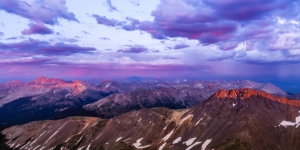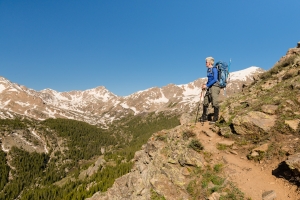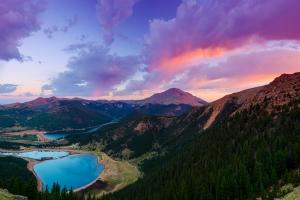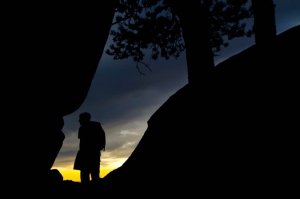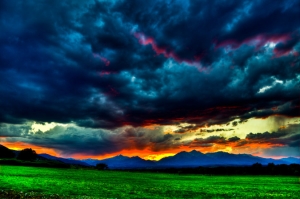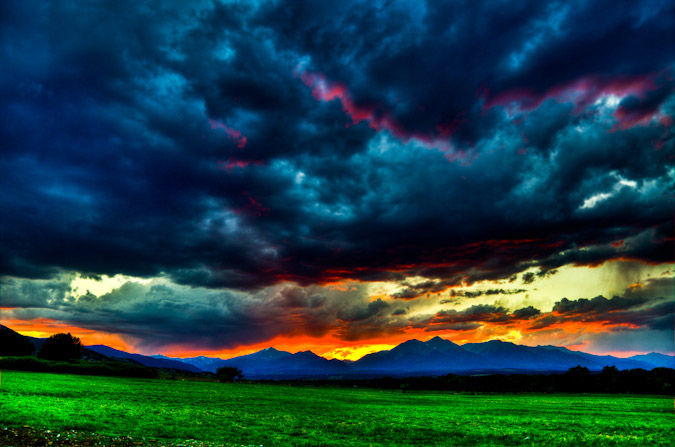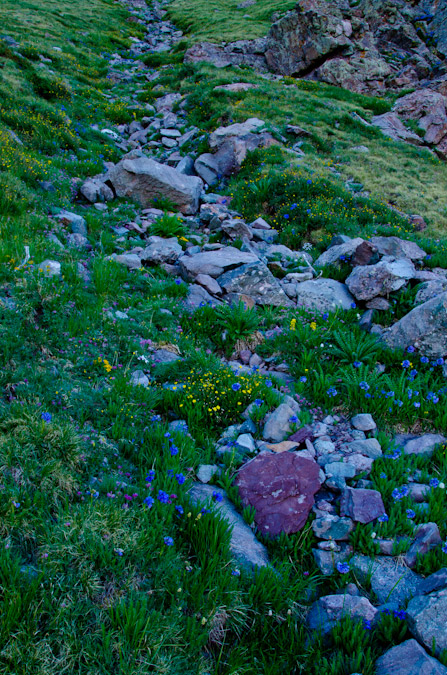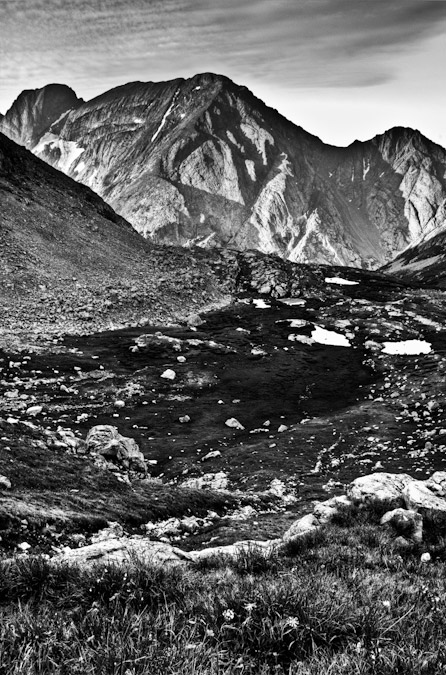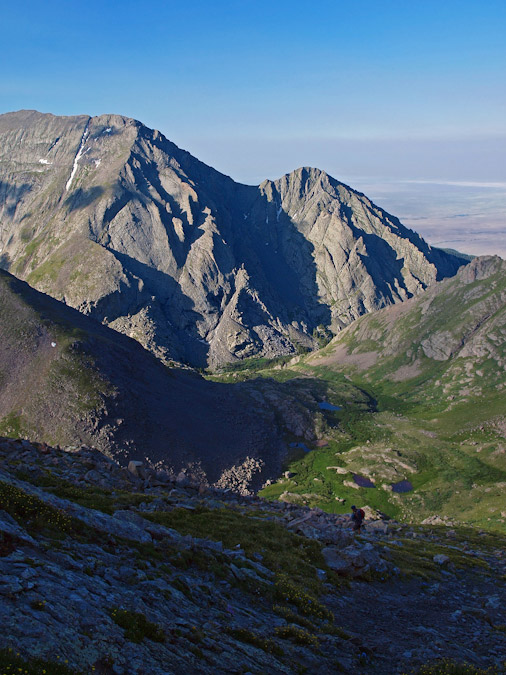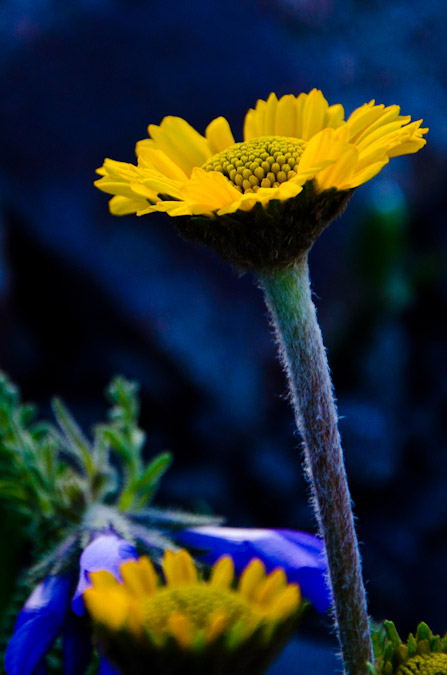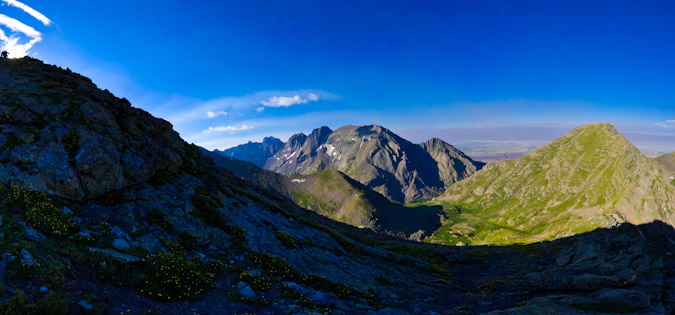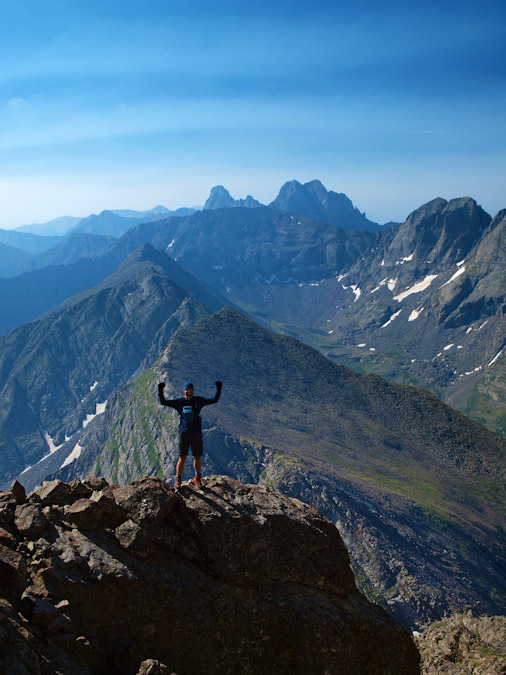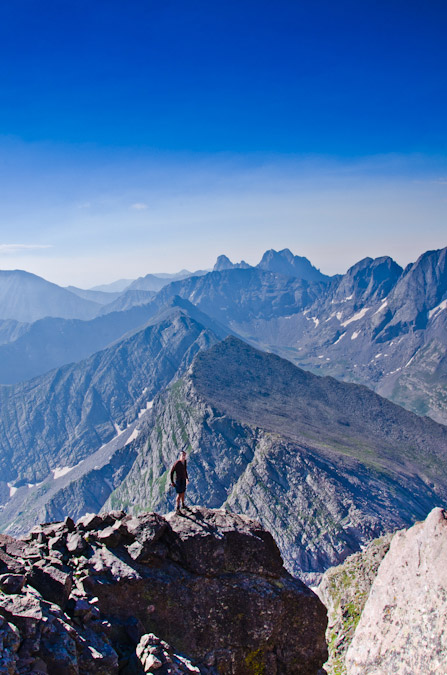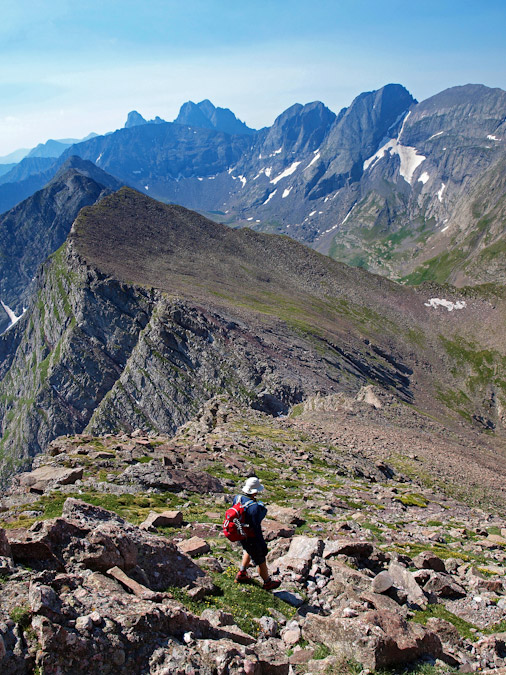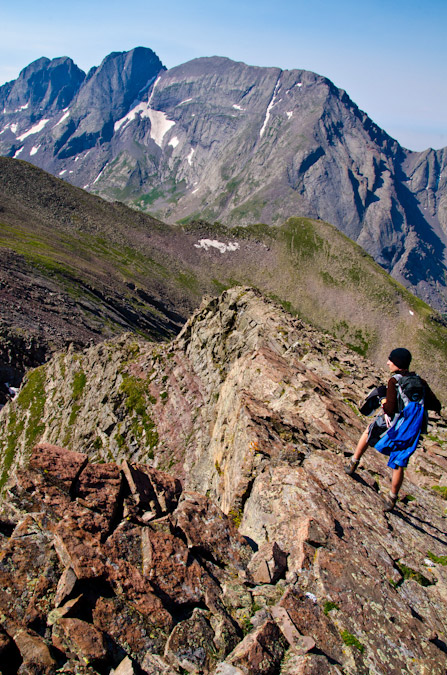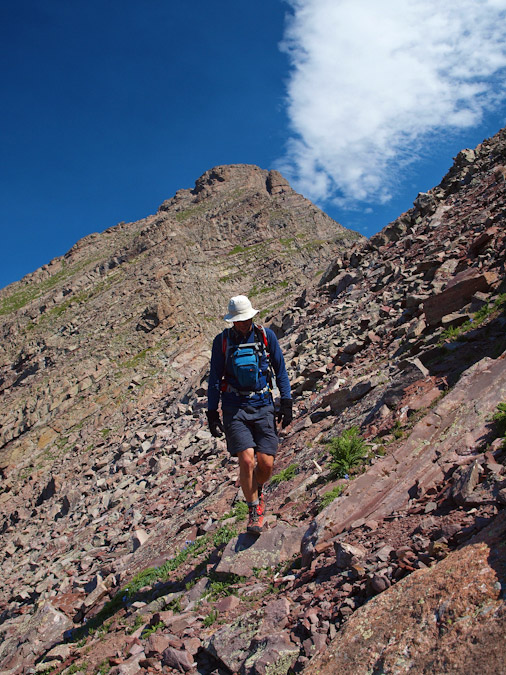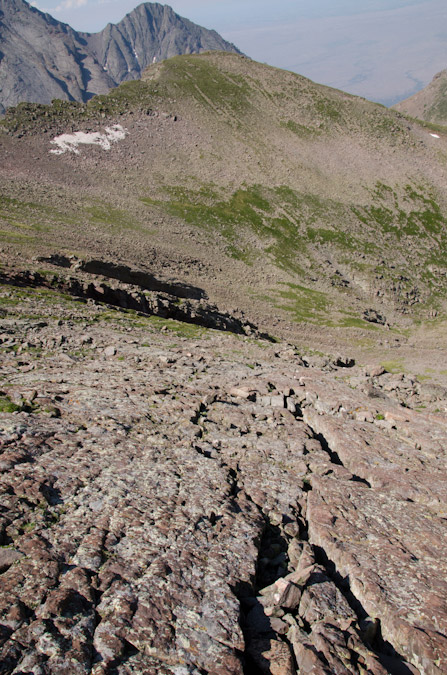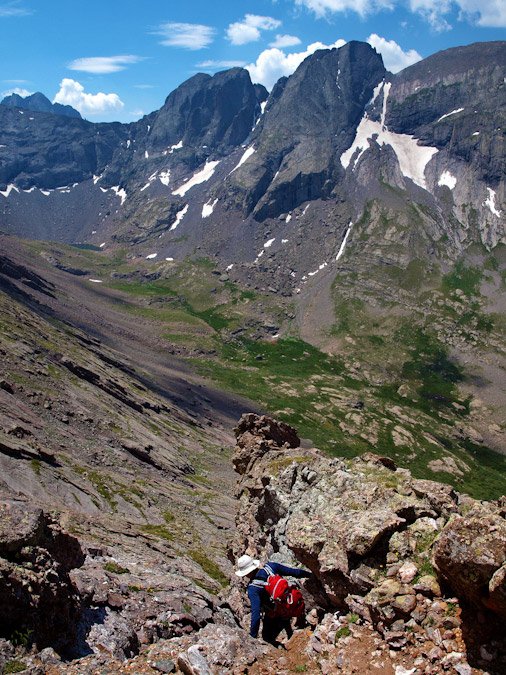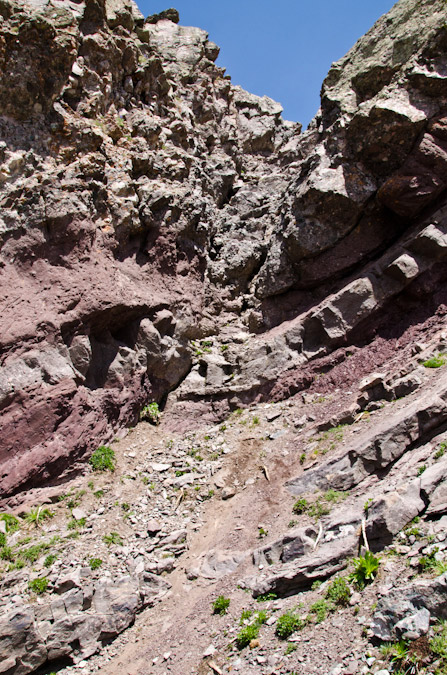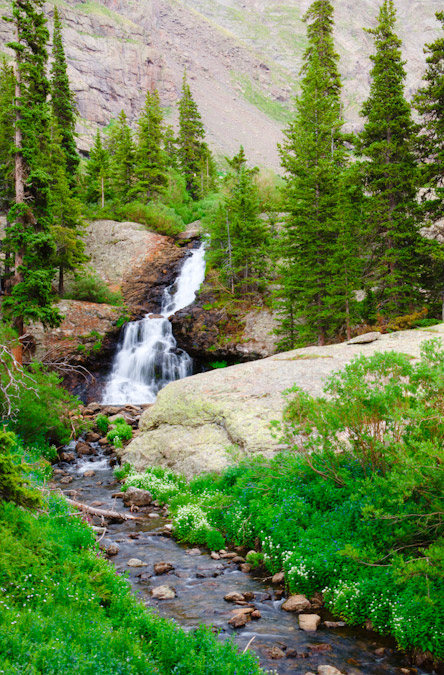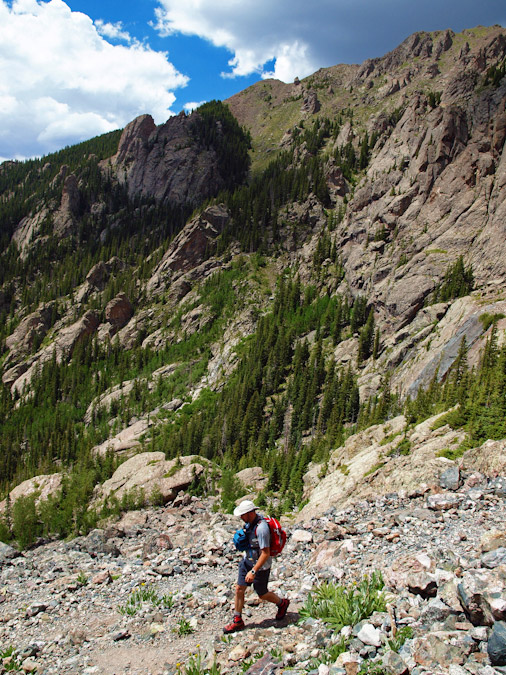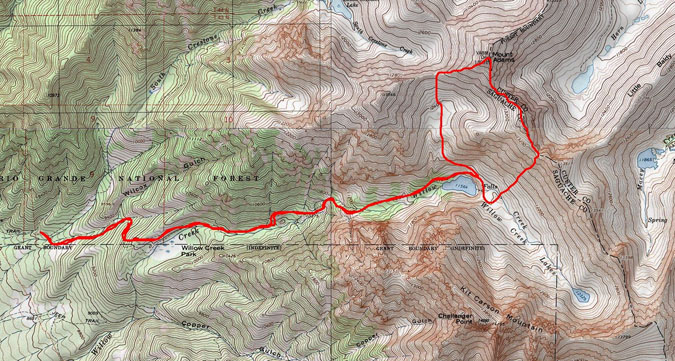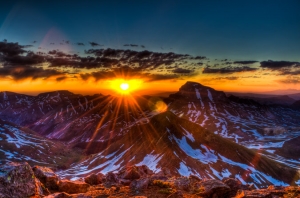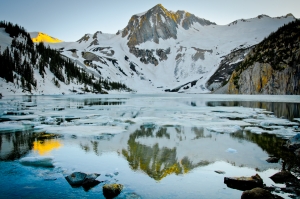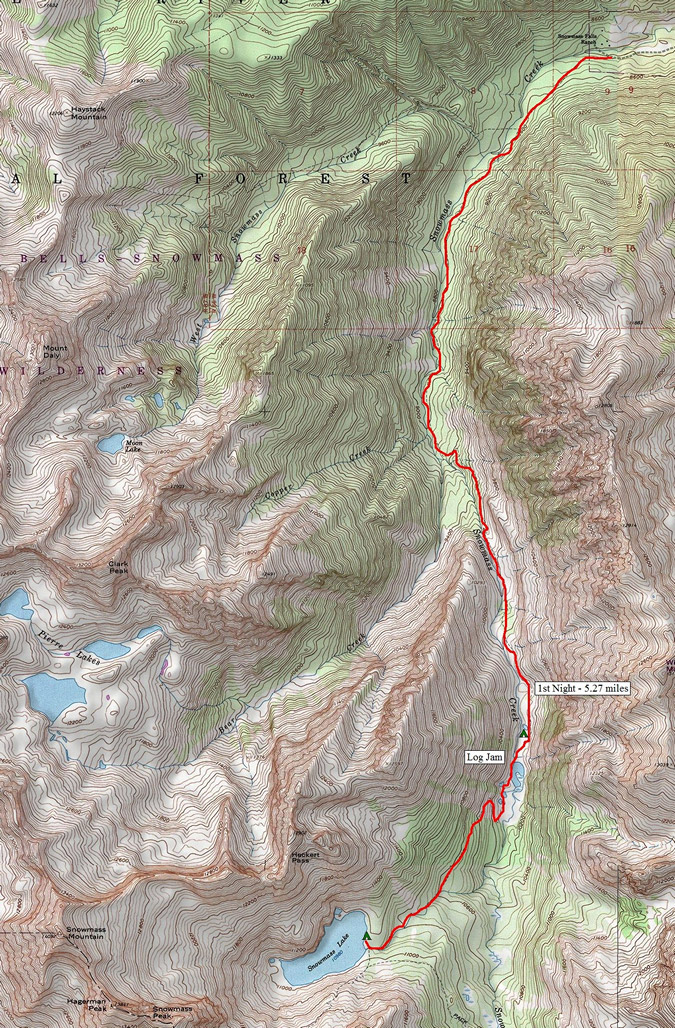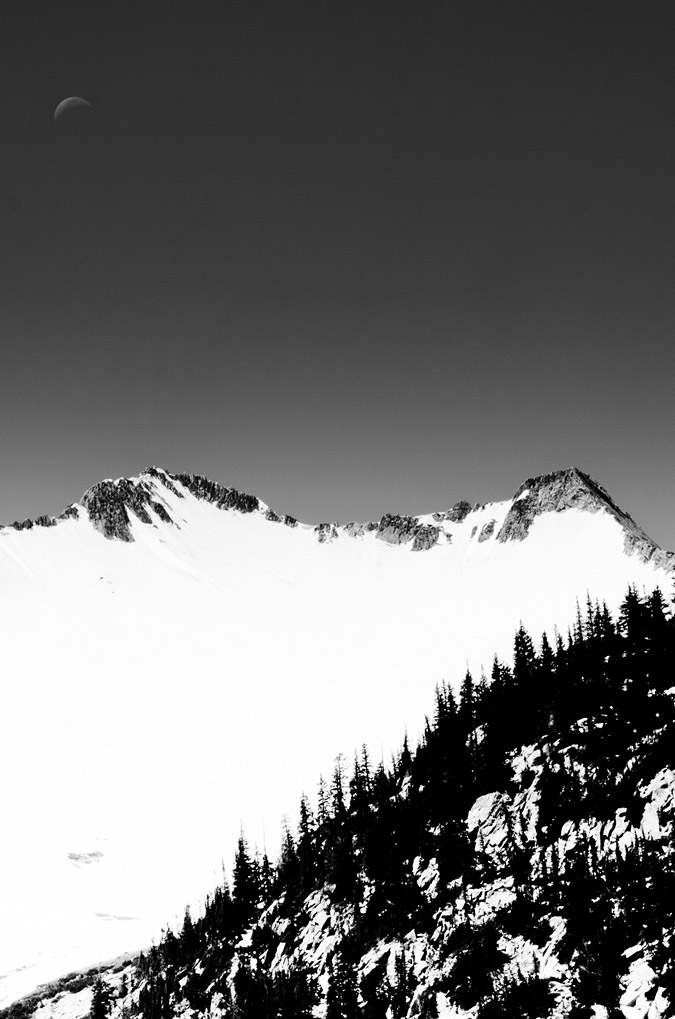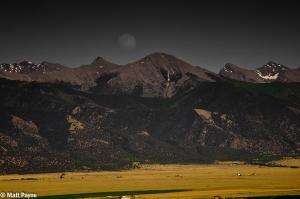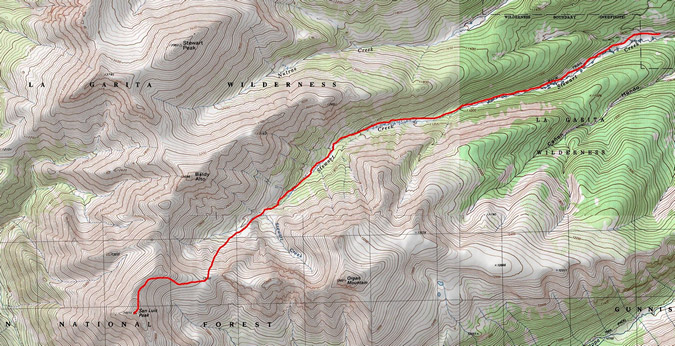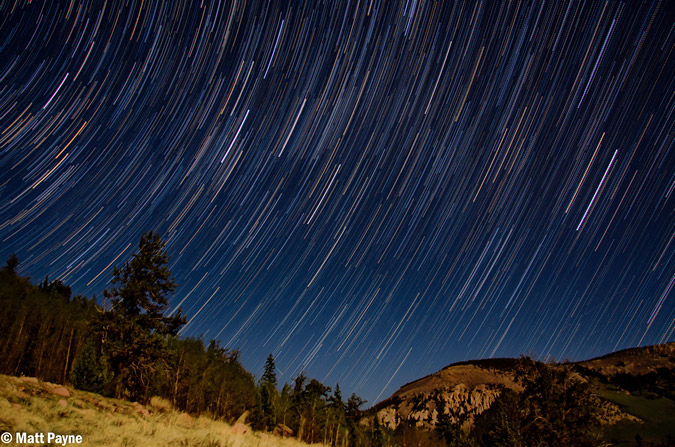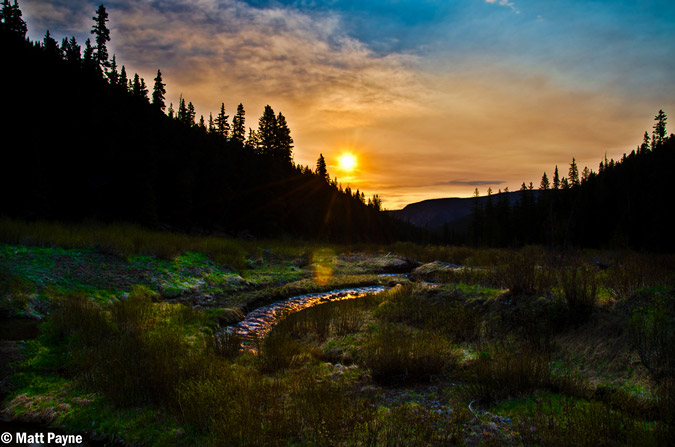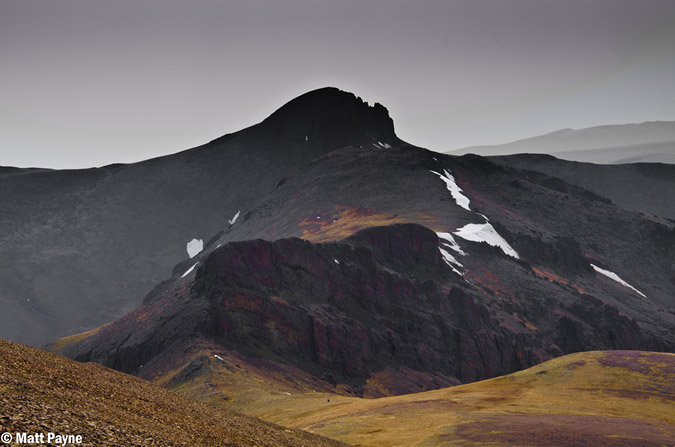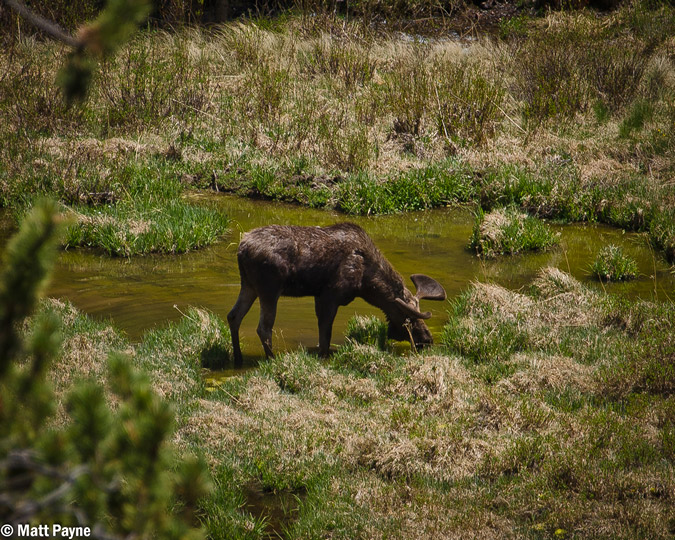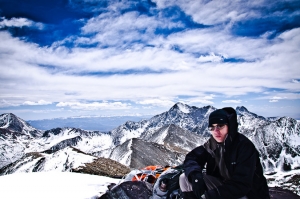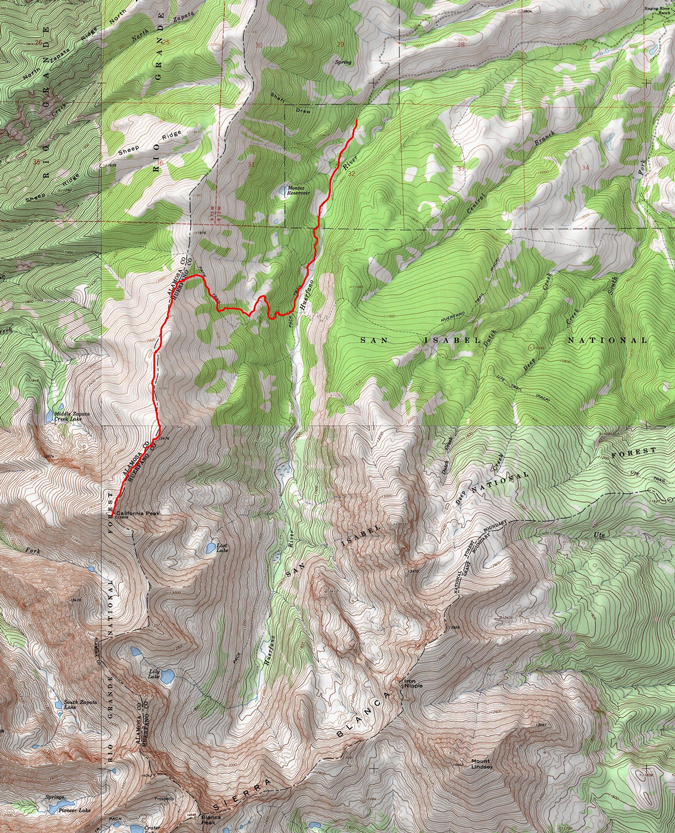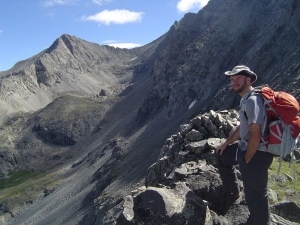Displaying items by tag: Hiking
Scaling Colorado's Highest 13er - Grizzly Peak at Sunset
Climbing mountains in solo-mode is therapy for me. While I have often espoused a deep belief that climbing mountains solo is a safety concern, there are times when the benefits outweigh the risks. I'm not sure that this particlar climb qualifies; however, I must admit, this was a truly wonderful experience that I will never regret. I decided somewhat at the last minute to take Friday off of work and climb a 13er. Having only 20 or so Centennials left to complete my quest of the highest 100 in Colorado, I have been getting more motivated to tackle the mountains left.
Grizzly Peak had always intrigued me. It is one of the few Centennials not visible from a paved road (I am fairly confident of this) and has a very remote status. Grizzly Peak is nestled deep in a valley just west of the summit of Independence Pass between Leadville and Aspen and is the most western Centennial in the Sawatch Range. There are tremendous views of the Elk Mountains from Grizzly Peak, including Pyramid Peak, the Maroon Bells, Snowmass Mountain and Capitol Peak. Grizzly Peak also carries with it the distinction of being the highest of 7 mountains in Colorado named Grizzly and the highest ranked 13er at 13,988 ft. (Sunlight Spire is higher, but is not ranked - for more on this issue see this article).
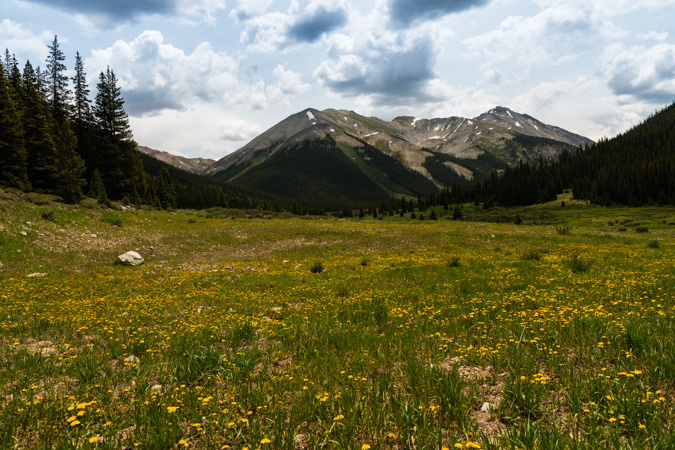
Since I would be climbing by myself, I knew I would have as much time as I needed to take photos and do some crazy photography projects from or near the summit. I chose the west route of Grizzly due to the very short length of the climb, which was very appealing for weather purposes. The plan was to drive the road to the base of the mountain Friday morning, climb the mountain, take photos of sunset from the top, and stay on the top as long as possible for a shot of the Milky Way and to do some star trails photography. According to Roach's 13er guidebook, the road is open all the way to the very base of the mountain, leaving only about 2 miles of hiking to the summit. When I reached Grizzly Reservoir, the road was closed at this point, which meant I had to add another 2 miles both ways to my hike. This was not a huge deal, but it certainly made me re-think my plan.
Being that I had nutty plans to do some extensive photography work from the summit, I packed quite heavily. I was carrying the following photography gear with me:
| Item | Weight (lbs) |
| Gitzo Carbon Fiber Tripod w/ Arca Swiss Ballhead | 6.4 |
| Nikon D800 DSLR w/ Arca Swiss Plate | 2.8 |
| Nikon 14-24 f/2.8 Lens | 2.0 |
| Nikon 24-70 f/2.8 Lens | 2.0 |
| Nikon 50mm f/1.4 D Lens | 0.5 |
| Nikon 300mm f/4 D Lens | 3.0 |
| 1.4x Teleconverter | 0.5 |
| Total | 17.2 |
I'm not especially proud of carrying all of this weight up a steep mountain, but I certainly don't regret doing it.
After I parked my Jeep near the Grizzly Reservoir campground, I head out with a pack full of camera gear and fresh legs at about 1 PM. This is not a very typical start time for me, and probably not highly recommended due to weather concerns, but I figured I would play it safe and keep an eye above for the hike in. For any photographers reading this, I decided to stick with the 24-70 f/2.8 as my walk-about lens, which worked out fairly well. The round-trip stats for this hike are 8 miles w/ 3,500 ft. of elevation gain.
The view from the road was fantastic. Lower, but very rugged 13ers adorned the valley and made for quite a nice sight on the hike in.
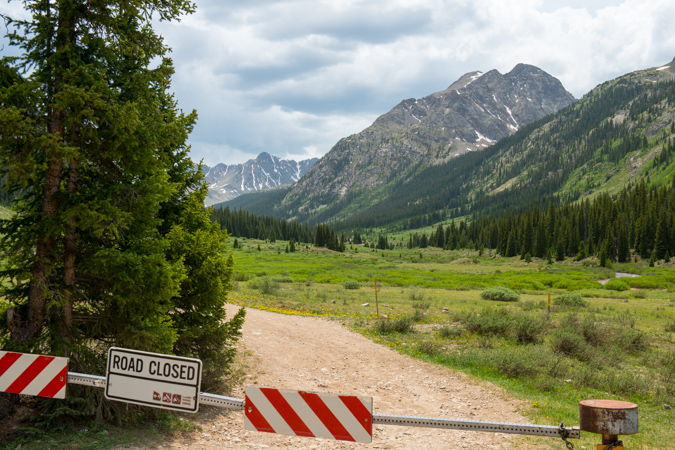
I certainly enjoyed the view but was keeping an eye on developing thunderstorms above.
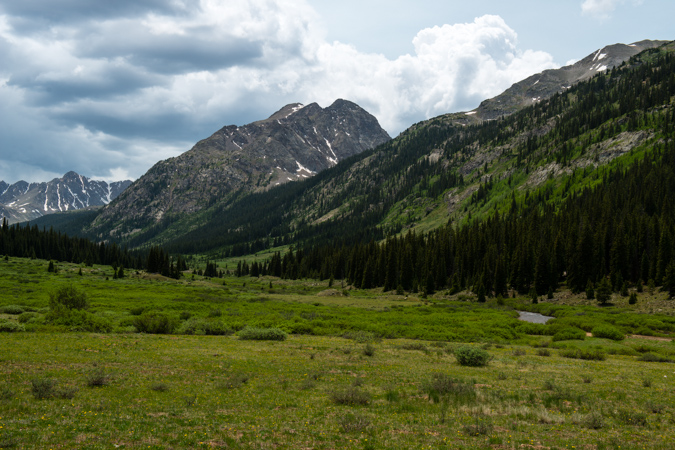
I'm usually not a fan of hiking on a road, but I could not really complain with the view I had, plus I had the Nerdist podcast to keep me entertained.
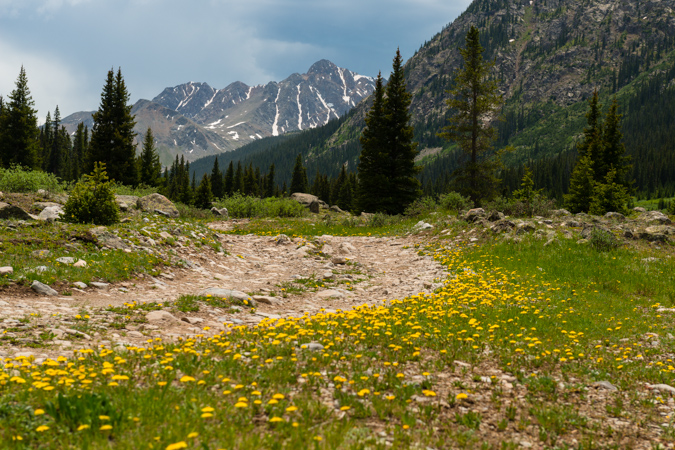
On the hike in, I was able to find some Columbine flowers growing in a small open field, making for a fun photography experiment. One thing I have been wanting to try to do is a technique called focus stacking, which allows a photographer to capture a very sharp photograph that is really the combination of multiple photographs taken at various focal points. I tried that out on these columbine flowers, which worked pretty well considering the wind was blowing (which makes focus stacking almost impossible).
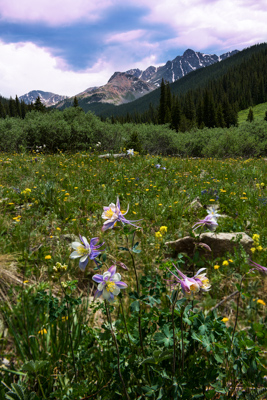
I was looking for a gully cut into the side of the mountain to my left (east), which would be my entrance point for the Grizzly Peak ascent. The mountain has no trail and is basically a steep slog up a very pretty, wild, but generally straight forward gully going up, up, up. Before reaching the gully, the rain started to come down a little, so I stopped to get a photo at this beaver pond before putting my camera away and heading up the gully.
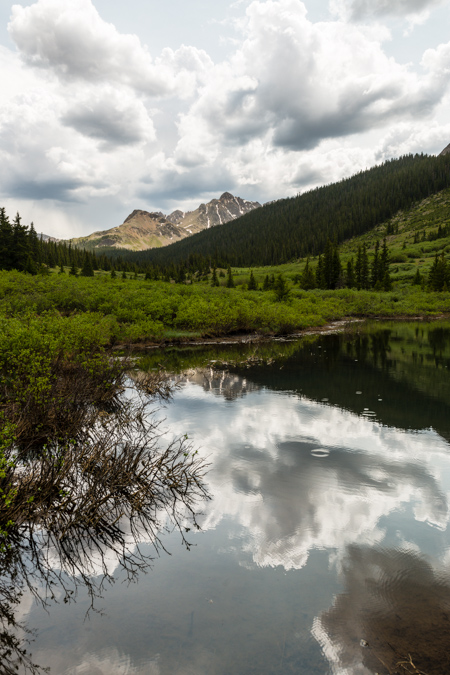
While small rain was coming down, I decided to keep my camera bag packed in my main pack to make it easier and to give me some peace of mind. As such, I was unable to take any photographs with my camera until the rain totally left and I was about a quarter of the way up Grizzly via the gully. I stopped to snap a set of photos to be later stitched into a panorama, looking west across the valley towards Truro and several un-named 13ers.
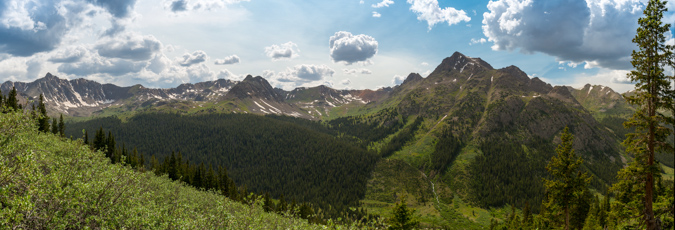
A look up at the terrain revealed just the sloggy mess I was climbing up. It was quite steep and somewhat difficult to navigate through all of the small pine trees, willow trees and rocks. I just had to pick my way up and take frequent rest breaks (I was carrying a lot of weight, haha). The Nerdist podcast of Rick Moranis made the slog a lot less painful, although my laughter probably drove wildlife away.
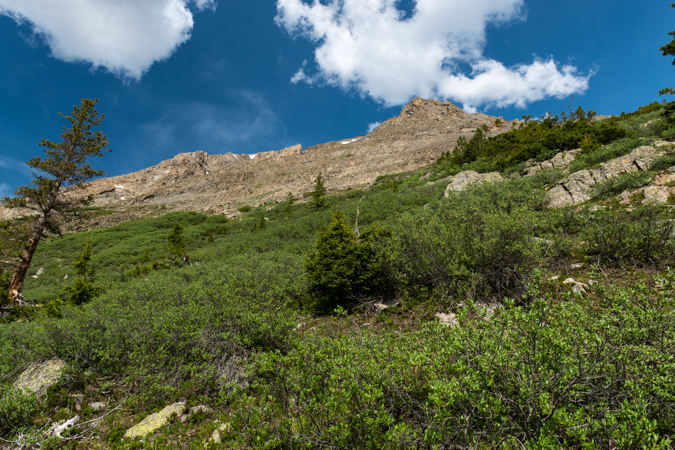
As I continued up Grizzly, the storms seemed to subside, and I was feeling a lot more comfortable about the hike up and eventual stay on the summit. A look back down the gully showed the way up and I could now see the road I hiked up from the North (right).
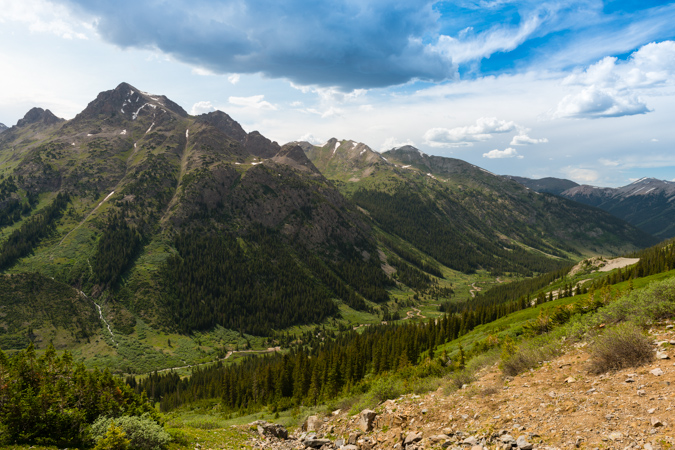
Once above treeline, the gully was pretty obvious in terms of where to go. It was mostly rock and dirt with wildflowers and boulders strewn about.
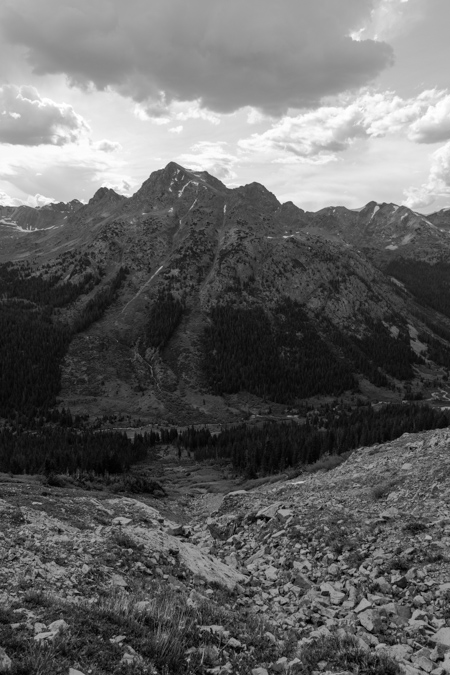
The views were pretty enjoyable in all directions. Despite some wind, I really could not complain.
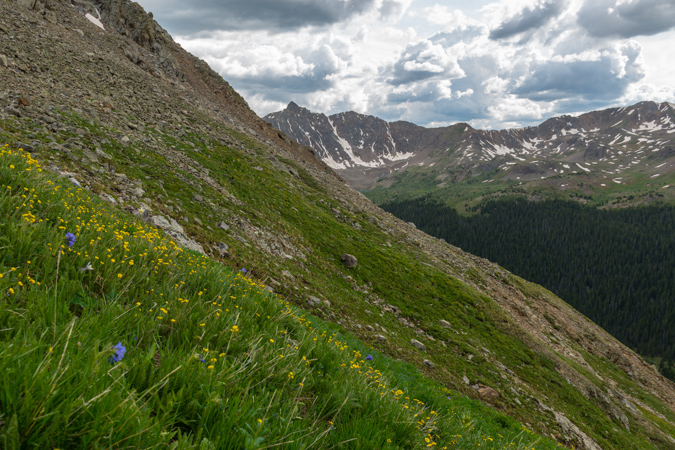
The 13ers to the west kept me looking back quite often, and the wildflowers were just too cool. They were all over the place, even above treeline, which is always awesome. I probably could have made it up the mountain in a lot less time, but I took the time to take some quality photos. This is another focus-stacked image making it so the very close flower in the foreground could be in focus as well as the distant peaks.
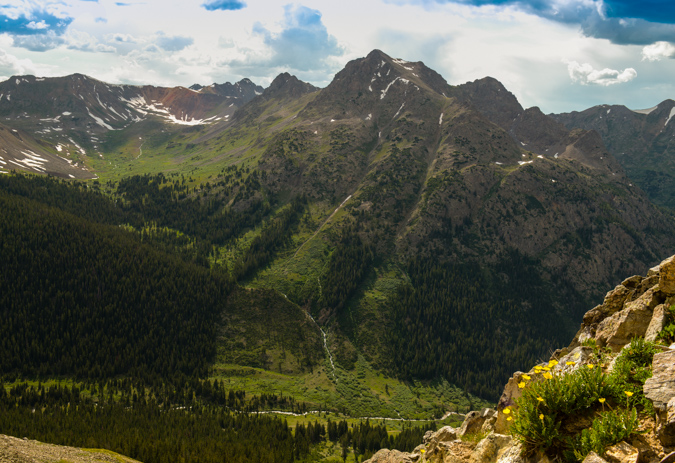
As I continued up, views of the Elk Mountains (specifically, Castle Peak) began to materialize above the horizon to the west beneath some virga coming from some small storm clouds.
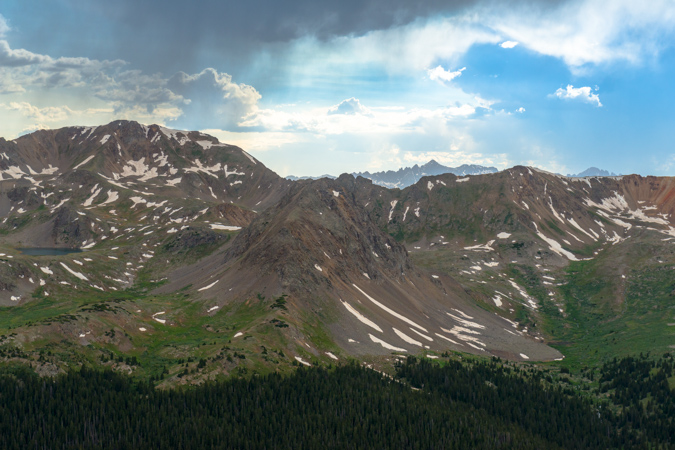
I was not worried about the weather yet - the clouds were pretty small and my new expansive views to the west indicated I should be in the clear for the remainder of the day. At this point, the climb became progressively more difficult for my weary legs. The weight of the photography equipment was really kicking my rear end and I had to take more and more breaks. The terrain was also much more difficult - not technically, but physically demanding. There were more boulder fields to contend with and the dreaded scree that takes you downhill one step for every two you take. As such, I decided to pack away my camera again so I could focus on the hike and make sure I did not fall. I finally was able to reach the saddle between Grizzly Peak and Garfield Peak as the light from the impending sunset was starting to generate some magic on the valleys below to the west and east. Seriously, if you've never done a sunset climb before, you need to - it is simply one of the most amazing experiences you can have in the high country.
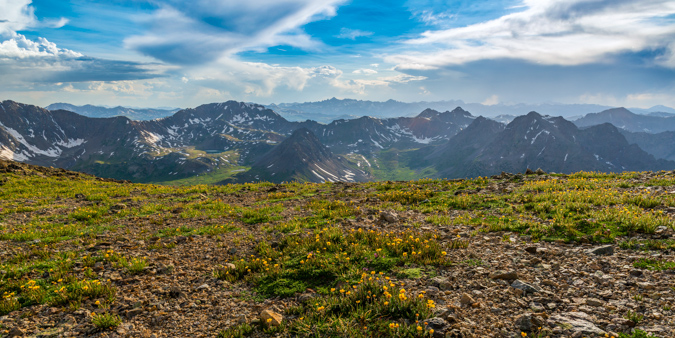
While the weather to the west was looking fabulous, the weather to the south and east was starting to look kind of nasty. I was not too concerned yet, but was keeping watch. One benefit of carrying a 5 lb tripod up a mountain is that you can do self-portraits. Here's one looking south and east towards Garfield Peak and Taylor Park (not visible).
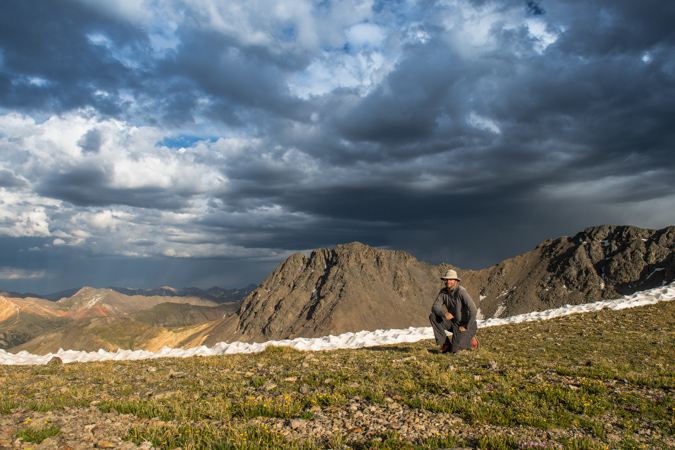
I also decided it might be fun to do a very large vertical panoramic showcasing the sky from the saddle, looking South-West-North. To the north (right) would be the summit of Grizzly Peak itself.
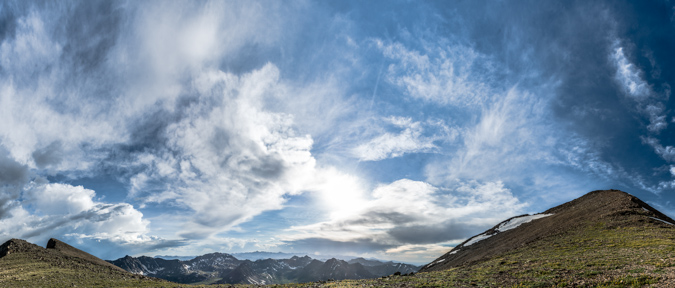
After about 20 more minutes of climbing, I was able to reach the summit of Grizzly Peak. I was greeted by an incredible view to the east and south, which included the Three Apostles and an amazing rainbow just shy of Taylor Park, where a huge thunderstorm was brewing.
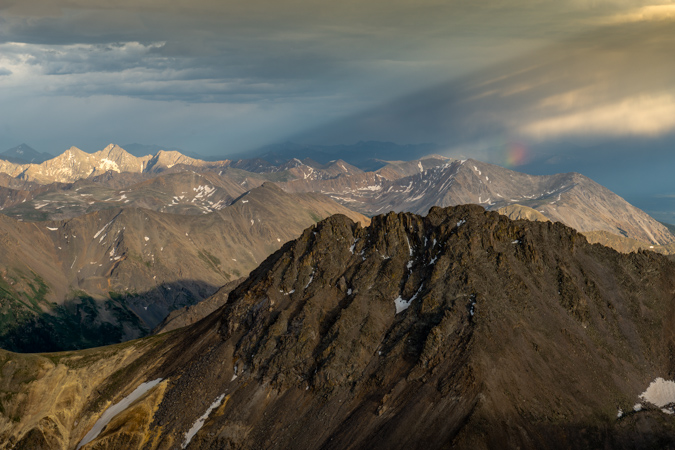
It was pretty awesome to be on top of the Continental Divide before sunset. The views were great, and that sweet rainbow stuck around for quite a long time to the northeast. The light from the sun was hitting the clouds over Taylor Park and causing some interesting streaks to appear. I signed the summit register, which was last signed by a guy I had read a trip report of from the day before. He had made a tribute to Steve Gladbach, a very accomplished and famous Colorado mountaineer who had just perished on Thunder Pyramid. I decided to also sign the book as "For Steve." I think Steve's passing weighed on every mountaineer's mind heavily, including mine. I never did get a chance to meet Steve, but we exchanged several cordial and thought-provoking messages over on 14ers.com regarding my morbid articles I write about the mountaineering deaths each year. Steve wrote a very eloquent and thoughtful post about death over there a few years ago and it always stuck in my mind. I even remember responding to his post saying that "heaven forbid you die in the mountains..." and yet - he eventually did. Steve had conquered the goals I have set for myself and I had always looked up to him, not only as an accomplished mountaineer but as a very amazing person. There are countless stories of his selfless acts and I felt a solo climb a nice tribute to his life.
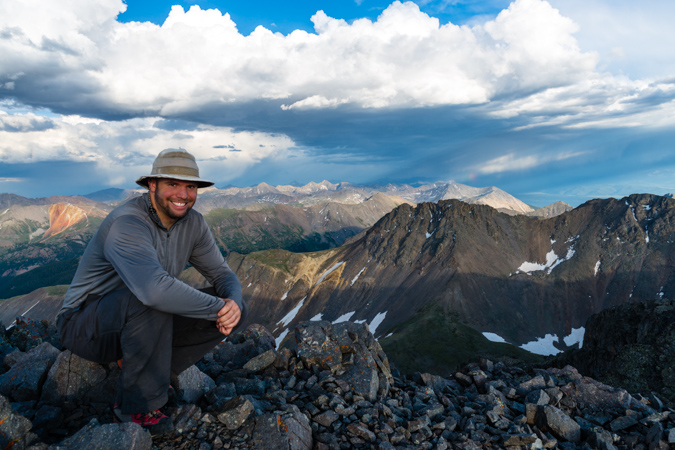
As I enjoyed the last few minutes of sunlight, I had to take advantage of my somewhat foolish decision to haul up my 300mm lens, which weighs 3 pounds on its own. I wanted to get some zoomed in shots of Ice Mountain, Pyramid Peak, the Maroon Bells and Snowmass Mountain using the 300 and a 1.4 Teleconverter, which gave me an effective focal length of 420mm.
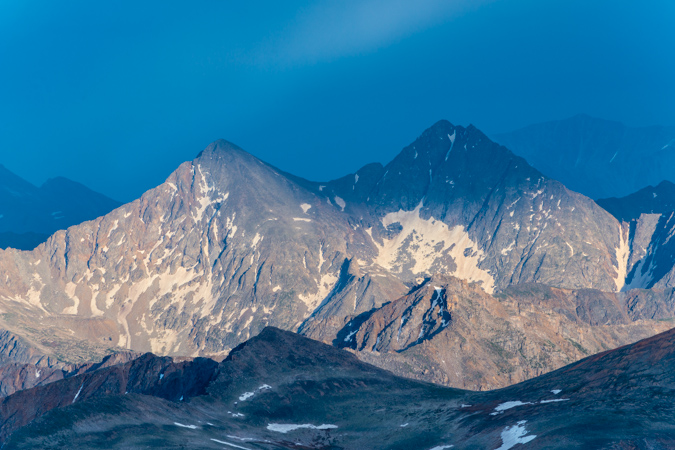
Castle and Conundrum were looking freaking awesome, with some crazy sunset light surrounding it. Thanks to Michael Colson for the correction!
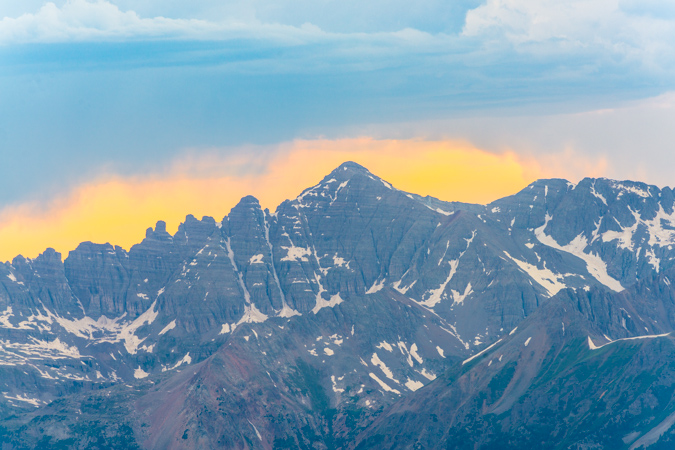
Snowmass Mountain was also looking wicked with the sunset light, giving the photo a very layered feel in black and white.
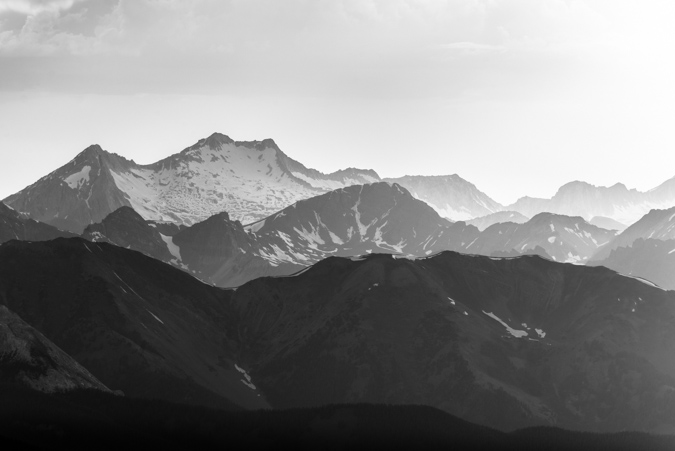
As the light continued to approach the magical photographic Golden Hour, I had some fun playing with different photos.
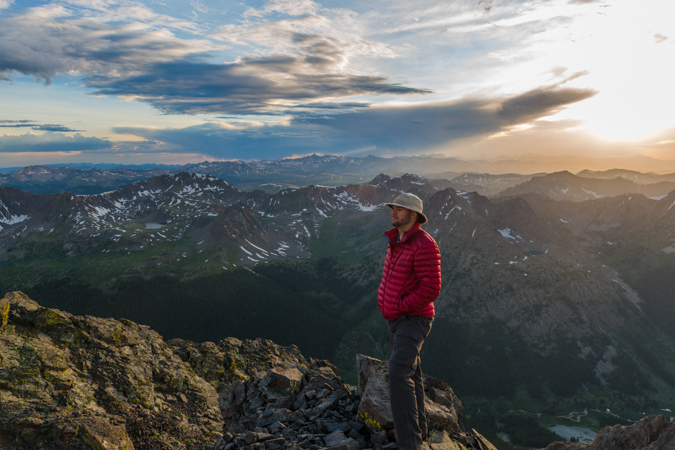
I also stitched together a massive 360 summit pano centered on the sun. This photo, being taken with the Nikon D800, is a massive file. If printed at native resolution (no loss of quality), it would span 30 feet wide. I'd love to see that. If I have time later, I'll work on an interactive 360 file so you can see this thing at a bigger resolution and zoom in.

The sun went behind some clouds but then created some nice god beams coming down near Mt. Sopris.
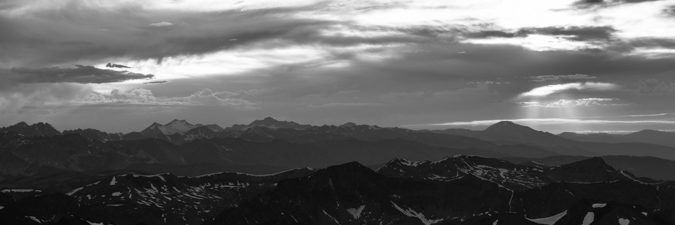
Then the sun reappeared and allowed me to snap off this photo which I think looks kind of like a Colorado flag.
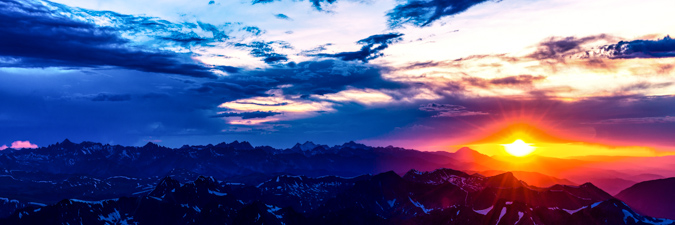
A look back to the east revealed some magic also. The light was very soft and colorful, showcasing the grand scale of La Plata Peak (left), Colorado's 5th highest mountain.
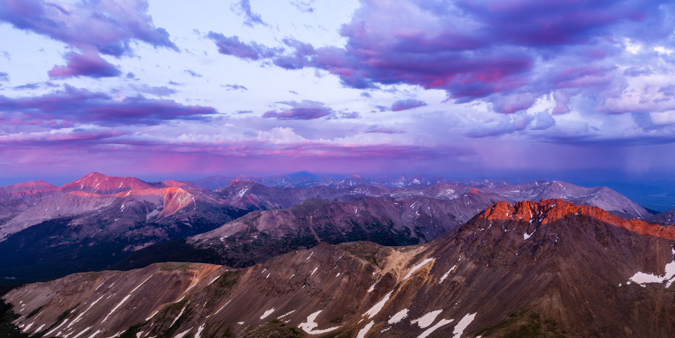
Sunset from the Continental Divide - an awesome experience. I took some artistic liberties on this next photo...
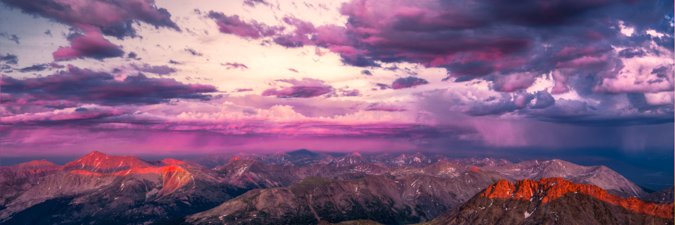
As the sun dipped below the horizon, and stood and watched the magic fade.
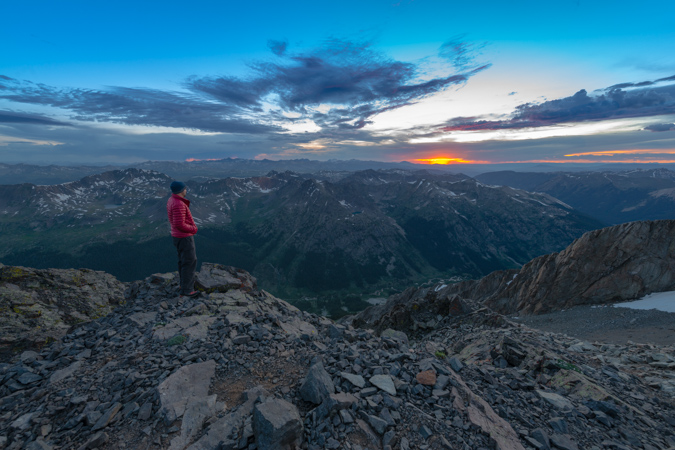
At this point, I had to make a decision. Watching the clouds to my east and south, I was getting a little nervous about the prospect of staying on top of the mountain to photograph the night sky. I was really motivated to do so, but I did not feel like it was a risk worth taking. While climbing down the mountain in the dark did not appeal to me, getting struck by lightning was even less appealing. I decided to pack up the gear and head down. The hike down was an adventure to say the least. It became quite dark very quickly, as there was no moon. I found myself in some sketchy spots where I had no recollection of that route from the hike in. I took my time and was very deliberate about each step. I was able to ride down a scree field a ways using some scree-skiing techniques and from there it was pretty much a boulder/snowfield/cliff/willow dodging fest. Downclimbing in the dark without a trail - not recommended - AT ALL. Hahahaha! It was certainly not the safest mountain climbing experience...
After reaching the road at 11 PM, I was rewarded with some insane views of the Milky Way. I set-up for some shots of the Milky Way and to my huge surprise, was able to also capture the Northern Lights! This next shot is a panoramic looking north-east-south. I just can't believe I got the Northern Lights - so awesome.
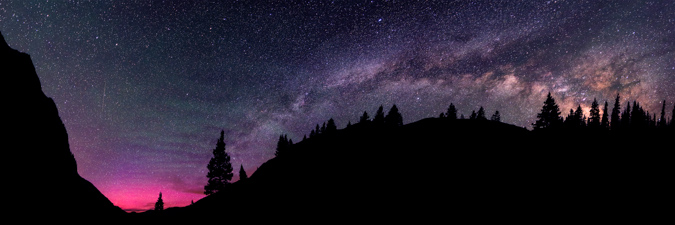
My final shot is me laying in the grass with my head-lamp, gazing into the night sky.
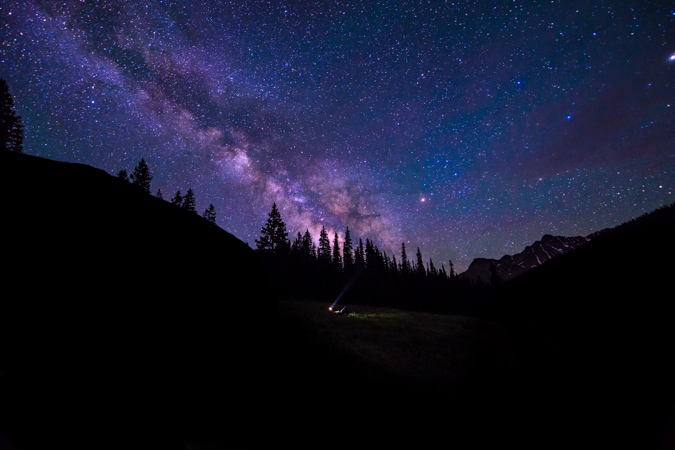
I slept under the stars at my Jeep back at the Reservoir after a long but enjoyable hike out in the dark and drove home to Colorado Springs early the next morning. What a great trip!
If you enjoyed my photos, please consider purchasing a print for your home or office. You can visit my gallery for a full showcase of my photography - if there are any photos from this trip you are specifically interested in, please do contact me.
Climbing Mount Massive - Enjoying Colorado's 2nd Highest Peak - Again
I had fully intended to climb the Centennial French Mountain this weekend, but plans change. My climbing partner Sarah and I left Colorado Springs at around 3:45 AM and reached the North Halfmoon Creek Trailhead at 6:15 or so. A pretty late start for this guy! In order to climb French Mountain, we would need to cross North Halfmoon Creek and head south. When we reached the creek, it was easily up to our waist and I had no intention of driving my Jeep through that deep of a creek crossing. A decision was quickly made to abandon our attempt on French Mountain and head up the scenic and steep Southwest Slopes route for Mount Massive. Since I had done this route back in October of 2009 (trip report here), I knew the way and was fine with repeating it, especially since my partner still needed to climb Massive. We parked the Jeep and packed up and readied ourselves for our first climb of the year. I was hopeful that I would make it to the top (you might think I'm joking) because the last mountain I had ascended was Pyramid Peak, which was my 14er finisher last year. I was also quite eager to test drive my new photography equipment, since I had not really had a chance to take it on a real climb yet. For this hike, I wielded my Nikon D800 and my Nikkor 24-70 f/2.8 lens, a heavy combination to be sure. Would the extra weight of a full-frame DSLR and the quite heavy yet amazing 24-70 be worth it? I was hoping so.
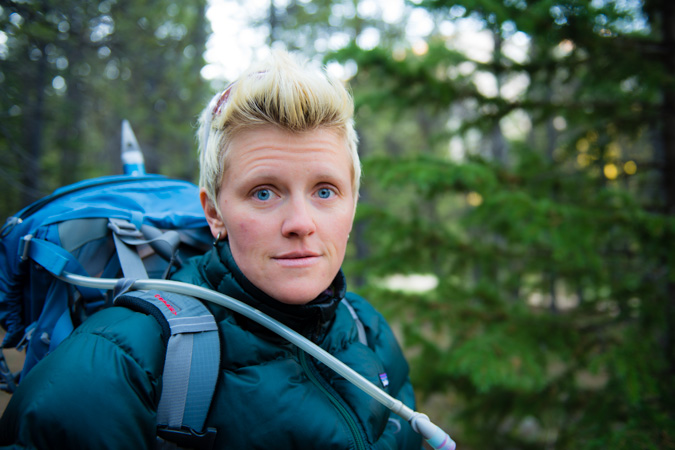
Sarah posed nicely for me so I could document the day's beginning and in turn she took a shot of me, looking weary.
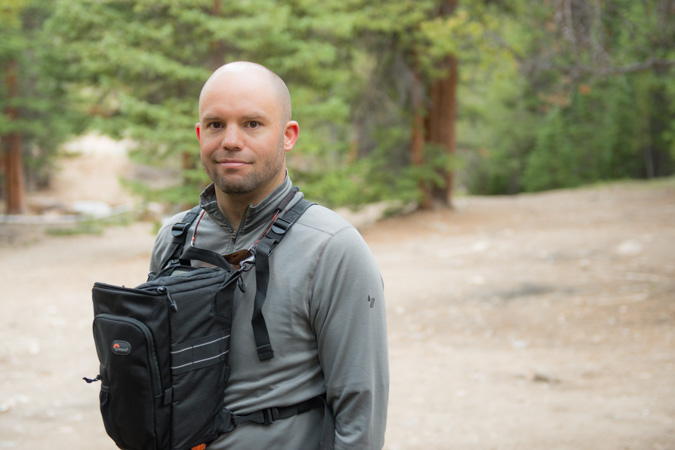
For the sake of ease, I decided to leave my tripod behind. The sucker weighs 5 pounds and I figured it would not be something I could use a whole lot on this hike. Good choice.
Sarah and I traveled up the basin towards Mount Oklahoma, which I climbed last year. I was beginning to get quite familiar with this area! Mount Oklahoma was looking quite nice and seemed to be holding quite a bit of snow as compared to last year, which was nice to see.
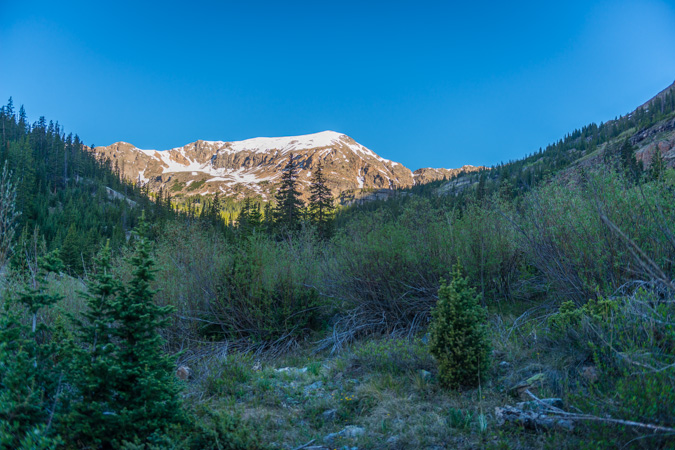
Mount Massive's south slopes are pretty darned steep but also a very pretty backdrop to the Colorado blue skies that we have been sorely missing due to all of the wildfires this year.
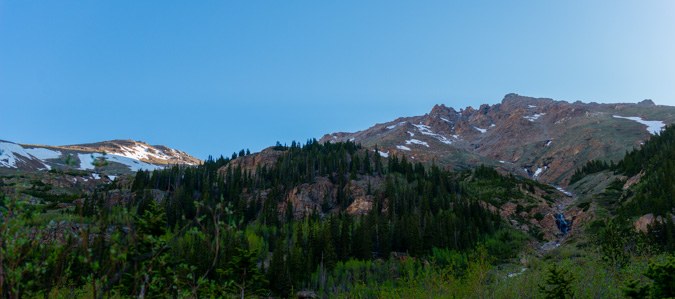
As we continued up the basin, we stopped periodically to look back up the basin that we would have gone up to climb French Mountain, pictured here.
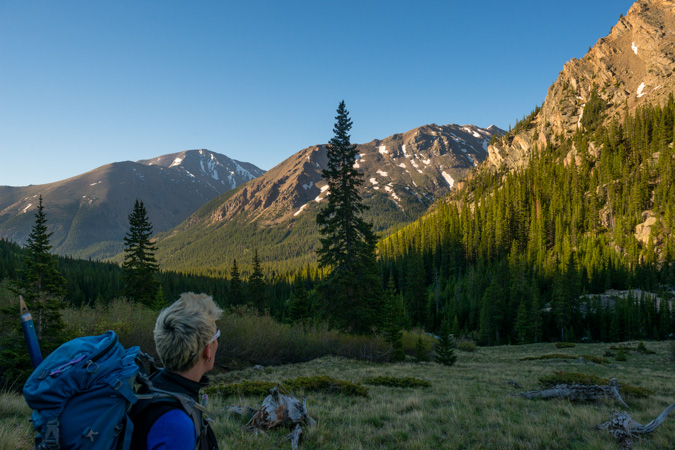
The trail going up towards Oklahoma and the turn-off for Mount Massive is very straight-forward and well- maintained. For a season starter, it was a nice change of pace.
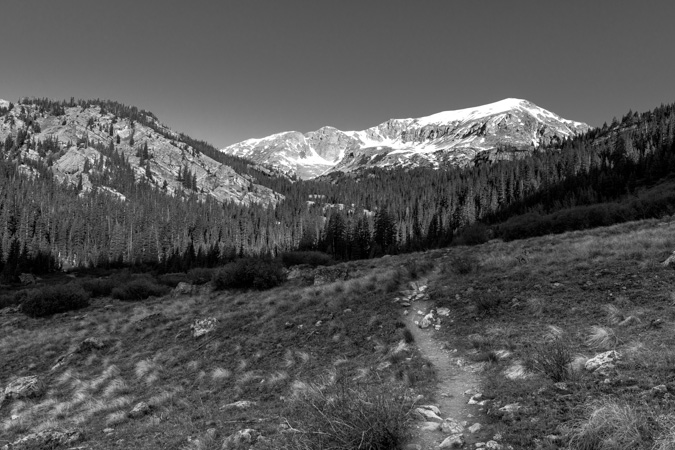
We finally reached the turn-off for Mount Massive, pictured here where Sarah is pointing up.
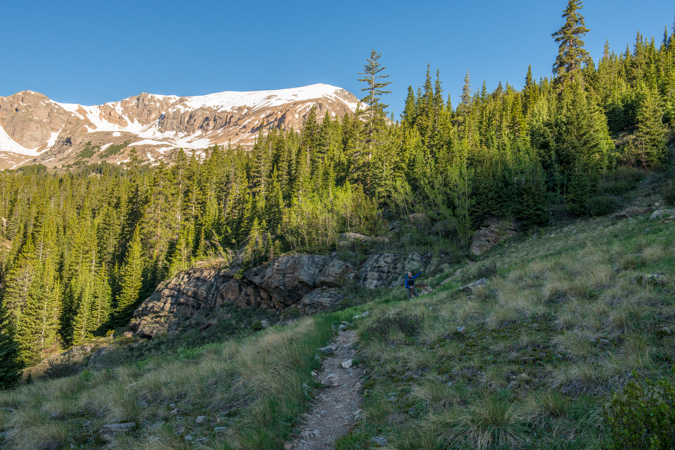
This trail gets you up Massive in a hurry, no doubt about it. It is fairly steep, but in very good condition almost the whole way up. I think that Colorado 14ers Initiative did some work on this trail some time back, and it certainly shows. The trail switches back up the side of Mount Massive several times and affords awesome views of the valley below and the awesome peaks across the way, including Colorado's highest, Mount Elbert.
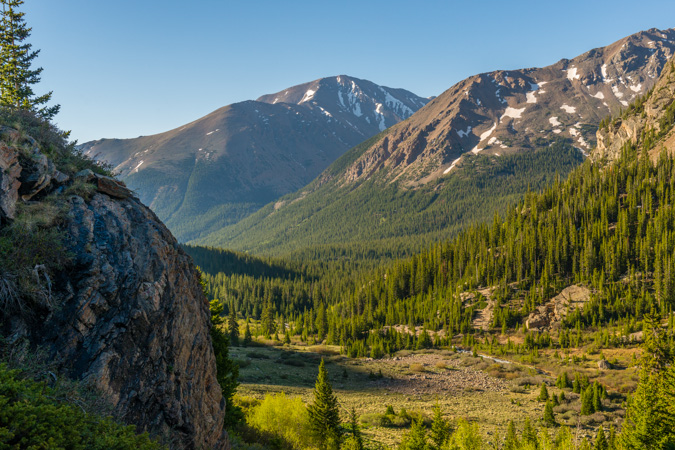
As we approached tree-line, we decided to stop for a snack and water break.
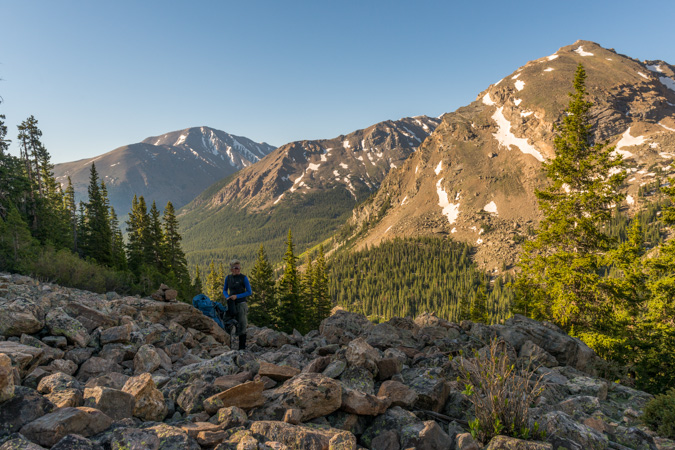
I have Sarah take a photo of me posing with my Rocky Mountain Field Institute (RMFI) water bottle. I'm a very proud member of the board of directors for RMFI. If you're not familiar with RMFI, you need to check them out! If you've ever climbed Humboldt, Crestone Peak or Crestone Needle, then you're familiar with the work they have done in the backcountry.
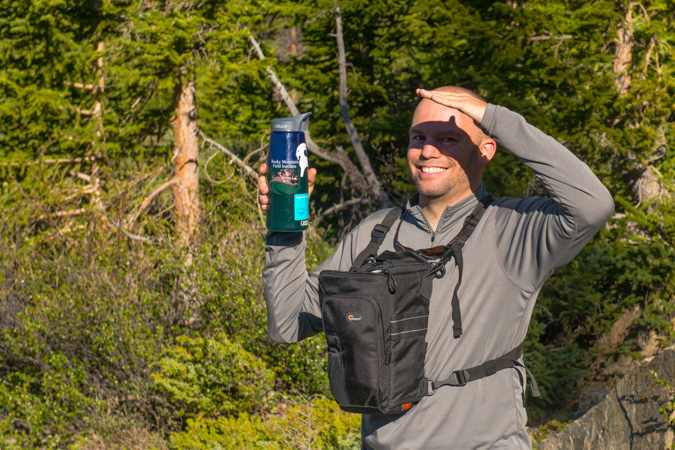
After re-fueling, we decide to keep on trucking. The trail winds steeply up the slopes and kept on delivering us with awesome views to our south of Deer Mountain and Mount Champion.
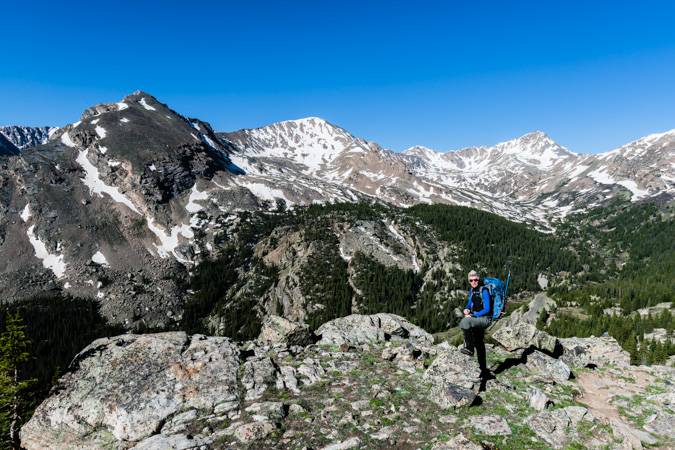
The whole valley below made for a very nice panoramic. From left to right - Mount Elbert, French Mountain, Unnammed pointy peak (but Sarah and I later dubbed this a very foul and childish name to keep up entertained), Mount Champion, Deer Mountain and Mount Oklahoma.

We took our time going up, being the first climb of the season. We enjoyed the views, the company, the conversation, the wilderness.
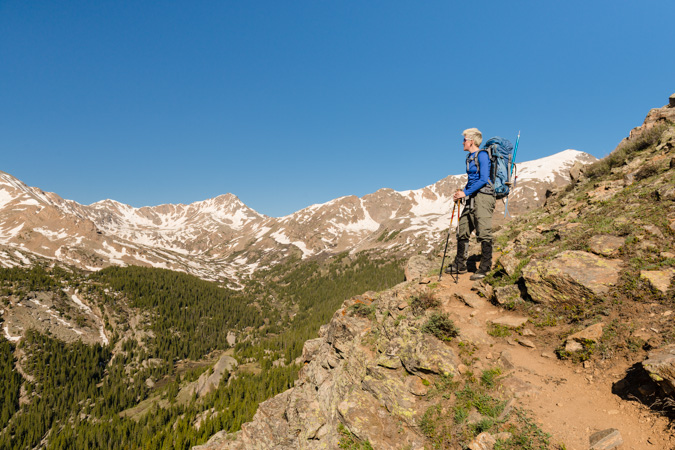
We were even able to locate some wildlife, albeit your normal fanfare of chipmunks and marmots.
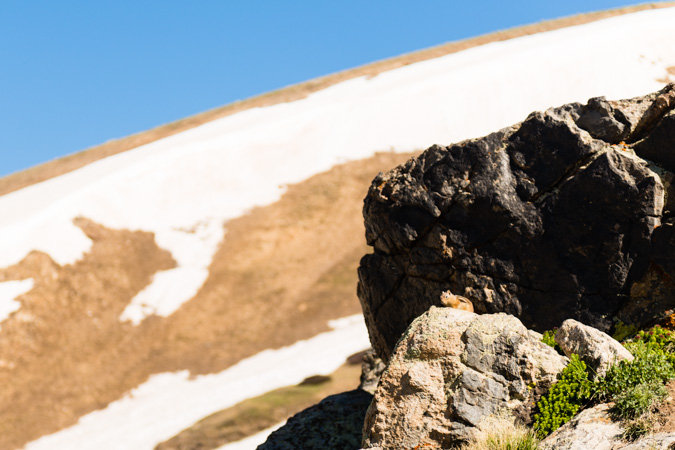
Getting a day to spend with Sarah was awesome. She's one of the most dynamic and fun people I've ever met. Our personalities go together quite nicely. It is also great to see her in high spirits when we're hiking.
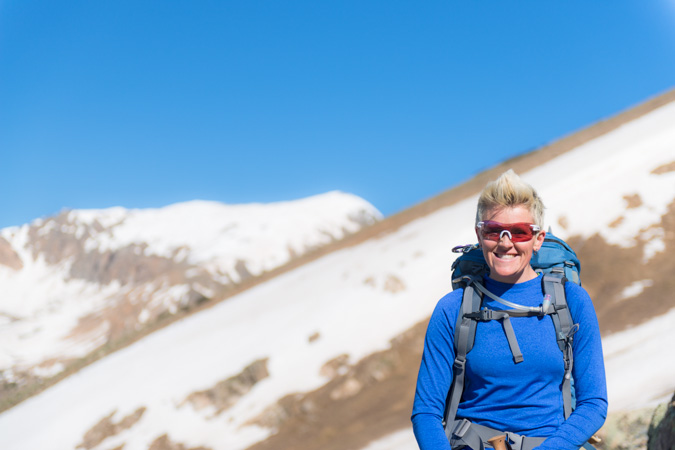
We took a lot of stops to soak in the Sawatch Range glory, and the weather was holding quite nicely.
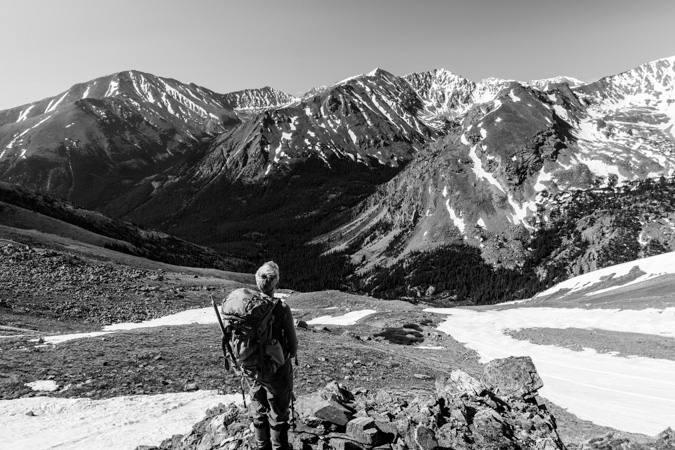
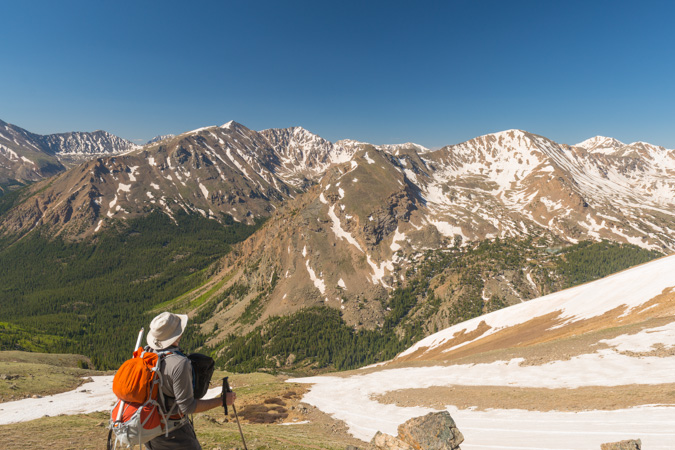
Here's that stealth marmot. I think he thought if he layed down I would not see him. Nice try pal.
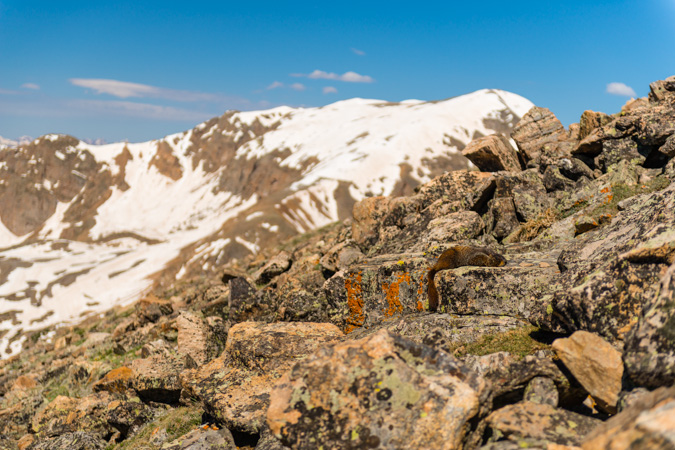
Finally the tips of the distant Elk Mountains were coming into view. They seemed like they were holding a lot of snow as well.
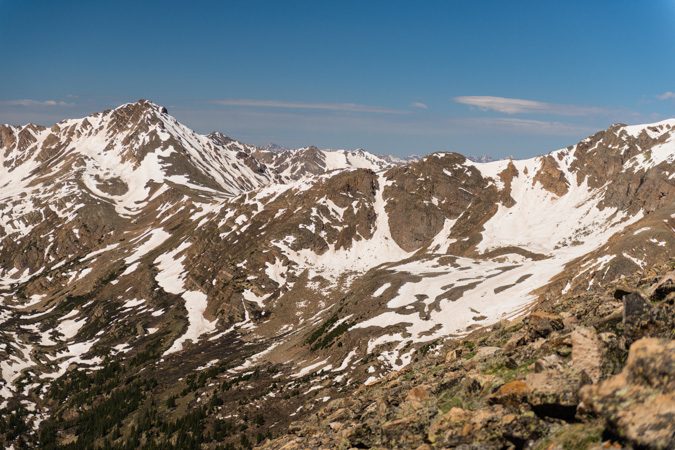
And looking back, Twin Lakes was starting to come into view.
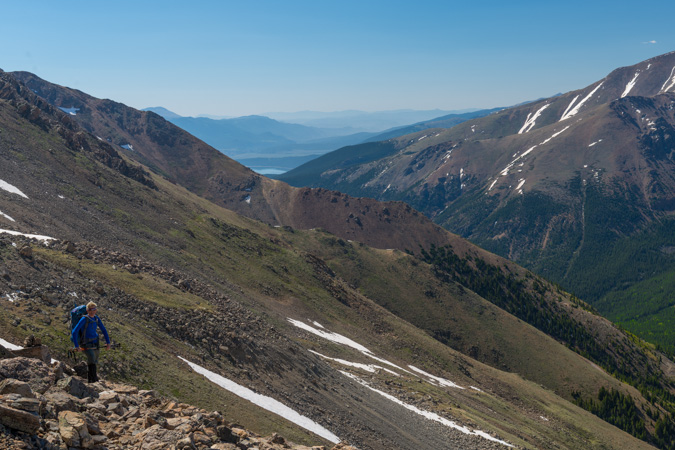
This is always my favorite part of hiking. Above tree-line, no wind, sunny day. What more could you ask for than a day like that on the side of a 14er? Sarah seemed to be enjoying the views as much as me.
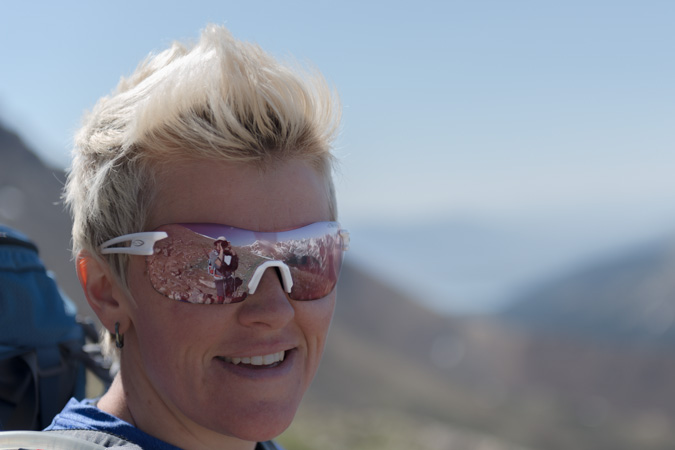
We stopped for a bit to enjoy the killer views of the Elk Mountains, which are some of my favorites. The tips of the Maroon Bells, Snowmass and Capital were poking above the top of Mount Oklahoma to the west.
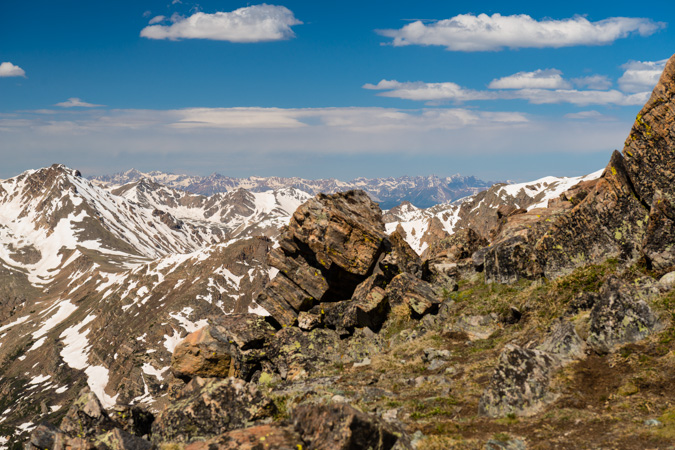
From here, the trail continues up the southwest slopes and crosses east at the ridge. The town of Leadville comes into view to the east.
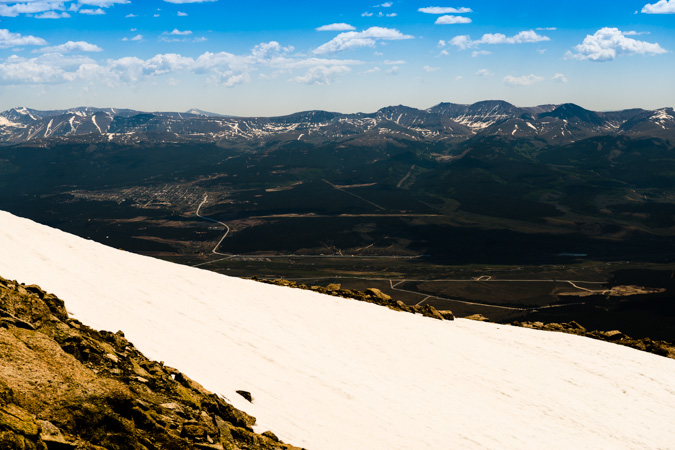
And of course the summit of Mount Massive to the north, with a lot of people coming down.
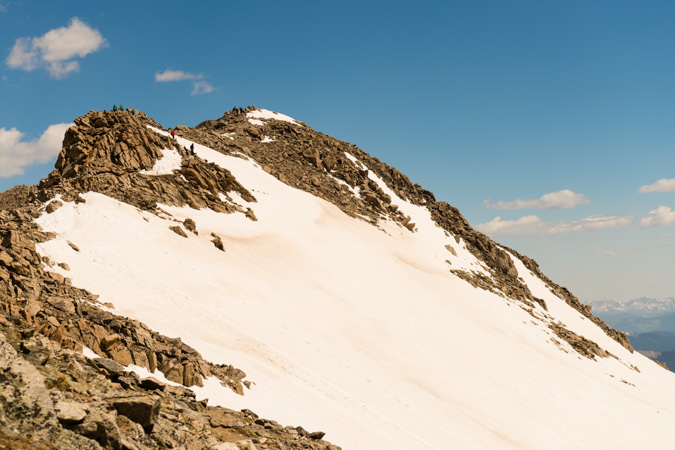
After a quick stroll over to the summit, victory was ours. We were able to almost completely avoid snow for the entirety of the hike up, minus a few snowfields below and some minor snow at ths summit. This was Sarah's 24th 14er and my 60th I think. It was awesome sharing the summit with Sarah again.
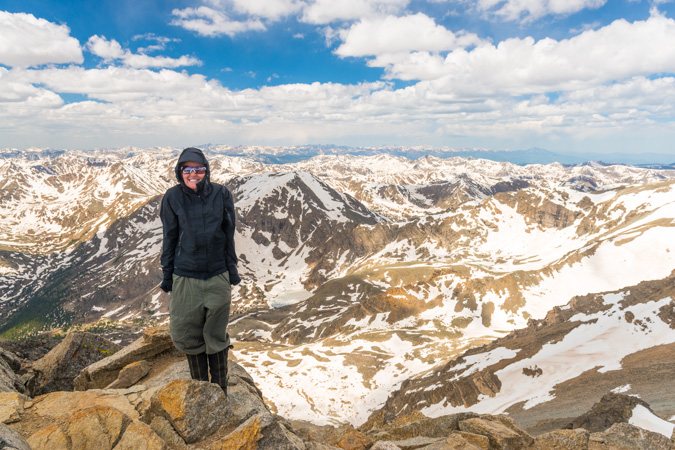
On the top, we ran into a group of gear testers from Osprey packs. We were immediately filled with envy that their job was to test the comfort of packs while hiking 14ers.
From the summit, I decided to try out some long exposure photos using a 9-stop ND filter, specifically, the Hoya ND400 77mm filter. Esentially, an ND filter is a black peice of glass that goes over you lens, which allows your shutter to stay open for a long exposure in daylight conditions. This allows you to capture photos of the clouds moving, and other awesome effects. Since I was shooting for a 30-second exposure, I would need my camera to be sturdy. To acheive this, I fashioned a flat suface out of rocks to rest my camera on.
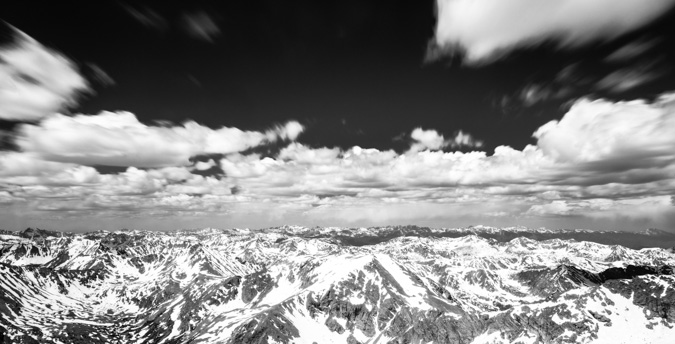
I was also able to perform a hand-held panorama at 70mm looking west at the Elks.
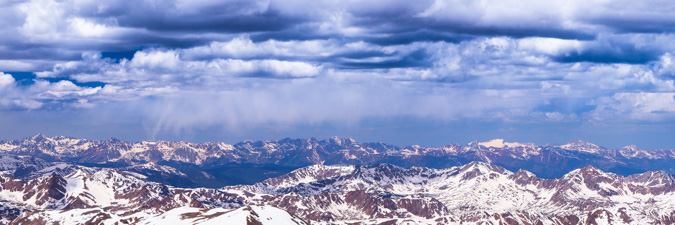
And here's a larger version looking south to north at 70mm:

And lastly, the 360 panoramic taken at 24mm:

I had Sarah snap off a few shots of me before we head back down.
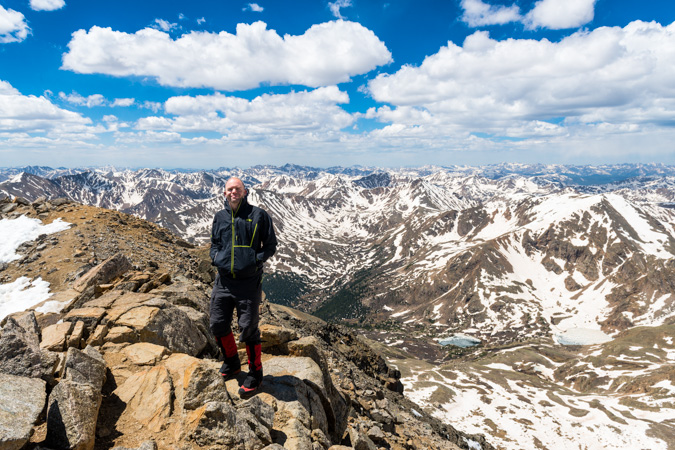
A solo gentleman joined us for the descent, mostly because he was looking for the trail, which he had lost on the way up the same route we came up. I could have sworn this guy was Taylor Lautner from the Twilight movies. A few notes about my camera and lens selection. I felt like the pairing did well. While they were heavy, it was easily mitigated by the front-loading Lowe Pro pack I used and the quality of the photos was superb. The Nikon 24-70 afforded just the right amount of flexibility in range, I rarely felt myself wishing for a longer lens. Had I saw some true wildlife, I would have loved to have my 300mm f/4 lens with me, but it would have added weight to an already heavy set-up.
After taking summit photos, we head back down pretty quickly. I wanted to travel quickly, so I put my camera bag in my main pack and did not take it back out for the rest of the hike down. Once back at the trailhead, we saw a Toyota FJ cross the stream. Go figure.
We drove back out towards Leadville and stopped to take a few photos of an amazing flower field in front of Mount Massive and an idyllic abandoned cabin. I hope you enjoy my parting shots:
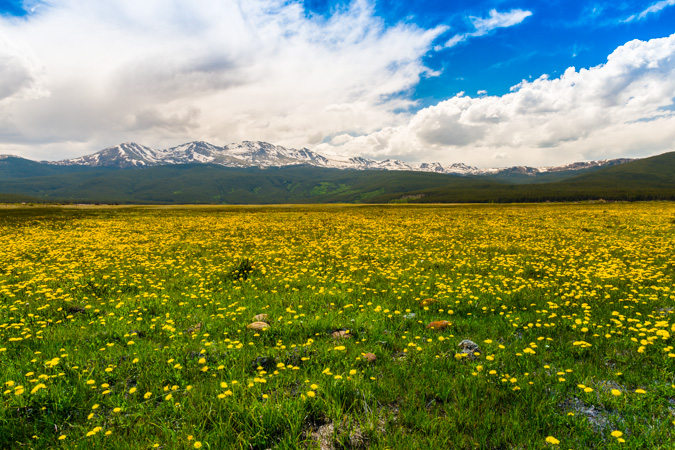
Panoramic version...
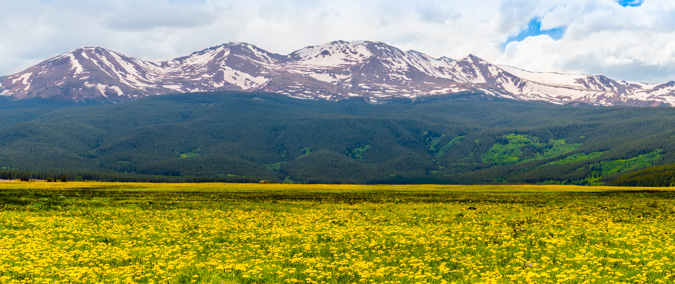
Abandoned cabin...
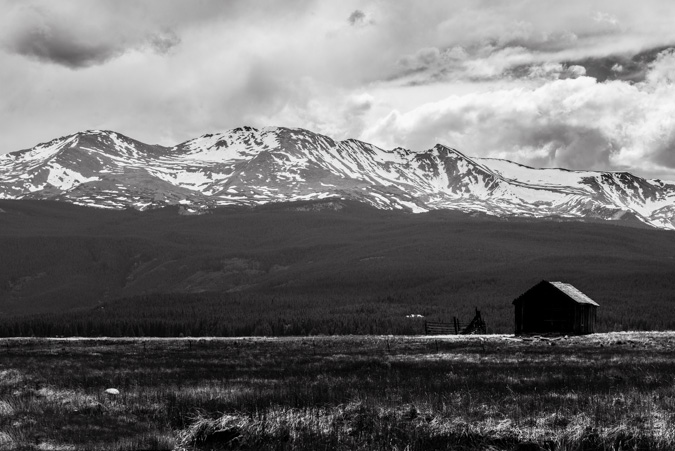
This concludes the first trip report of 2013. I apologize for the lack of updates lately. I have been quite busy working on my photography business, where I sell prints of my work. You can check it out by visiting www.mattpaynephotography.com
Exploring Almagre Mountain - Sunrise on Pikes Peak and the Waldo Canyon Fire
Originally, my friend Ethan and I had made plans to climb the Three Apostles - three great 13ers over near Leadville; however, the Waldo Canyon Fire started the weekend prior and by Tuesday had burned out of control - 346 homes were burned to the ground in Mountain Shadows and Highway 24 was closed. The main access to the mountains was Highway 24, so we were pretty much stuck on the Front Range. Additionally, the whole week had been an emotional rollercoaster for everyone - my parents evacuated their house and stayed with us for a couple of nights. Ethan covered the fire quite a bit with video and social media throughout the week (by the way, if you have a chance, you really should check out his incredible blog post about social media, traditional media and the Waldo Canyon Fire - a fabulous read). The Waldo Canyon Fire had presented Ethan and I another opportunity - to hike a closer-to-home peak with the hopes of getting a birds-eye-view of the fire's extent.
So - we set off early on Sunday morning to do just that - I picked Ethan up at 3:30 AM from his house and we head up Gold Camp Road to tackle Almagre Mountain - a 12,367 ft. gently-sloped peak just South of Pikes Peak. Indeed, most Colorado Springs residents will recognize Almagre as a very plain looking set of mountains above tree-line to the left (south) of Pikes Peak. I'd always wanted to climb Almagre, and Ethan had already done it twice, so it seemed a great fit for our objectives.
We opted for the western approach from near the gate that Colorado Springs Utilities (CSU) has erected to keep people out of the city's water supply, which seemed to us to be quite low. To reach this spot, we drove quite a ways up Gold Camp Road, about 2/3 of the way to Cripple Creek, and turned right on Forest Road 376 to the CSU dead-end.
We arrived at the gate at approximately 4:15 AM and began in a wild rush up the steep 4WD road by foot towards McReynolds Reservoir. The air was quite cold this early and this high up, a stark contrast to the record-setting 100+ degree heat we had been experiencing in the scorched and dry urban setting of Colorado Springs. Eventually, the road leveled off and opened up into a large meadow, giving us a clue to begin to head west on a very faint trail, which crossed the CSU fence-line and connected to a more solid trail leading up towards Almagre Mountain. After a couple of miles of fairly steep climbing, we reached a great stopping point, giving us a wonderful vantage of Pikes Peak and the various reservoirs below - Mason Reservoir and McReynolds Reservoir - also known as the Seven Lakes area.
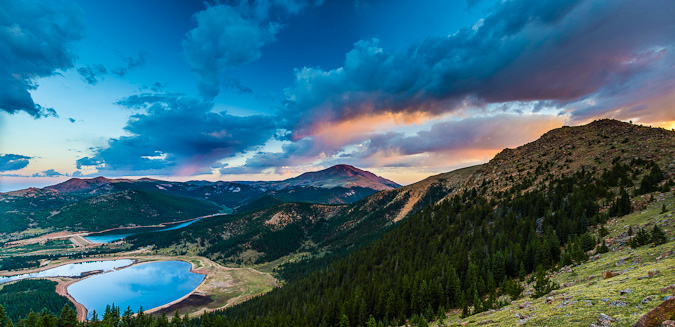
We stopped here to take in the great light hitting Pikes Peak, and I took advantage to take many photos from here as the sun continued to change the colors of the clouds and Pikes Peak.
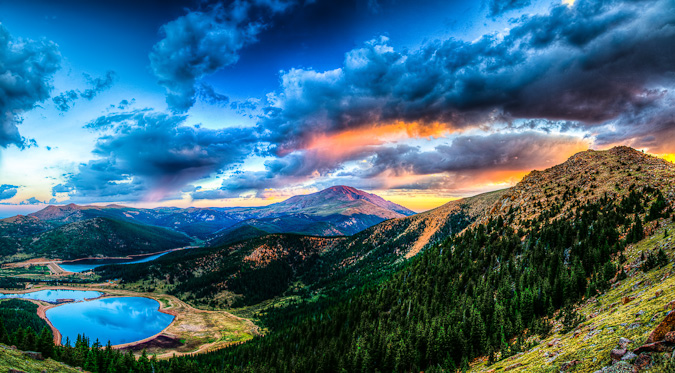
The lighting was fantastic, and it was such a rare view of Pikes Peak, I really loved it. This particular shot is also available on my photography website for sale.
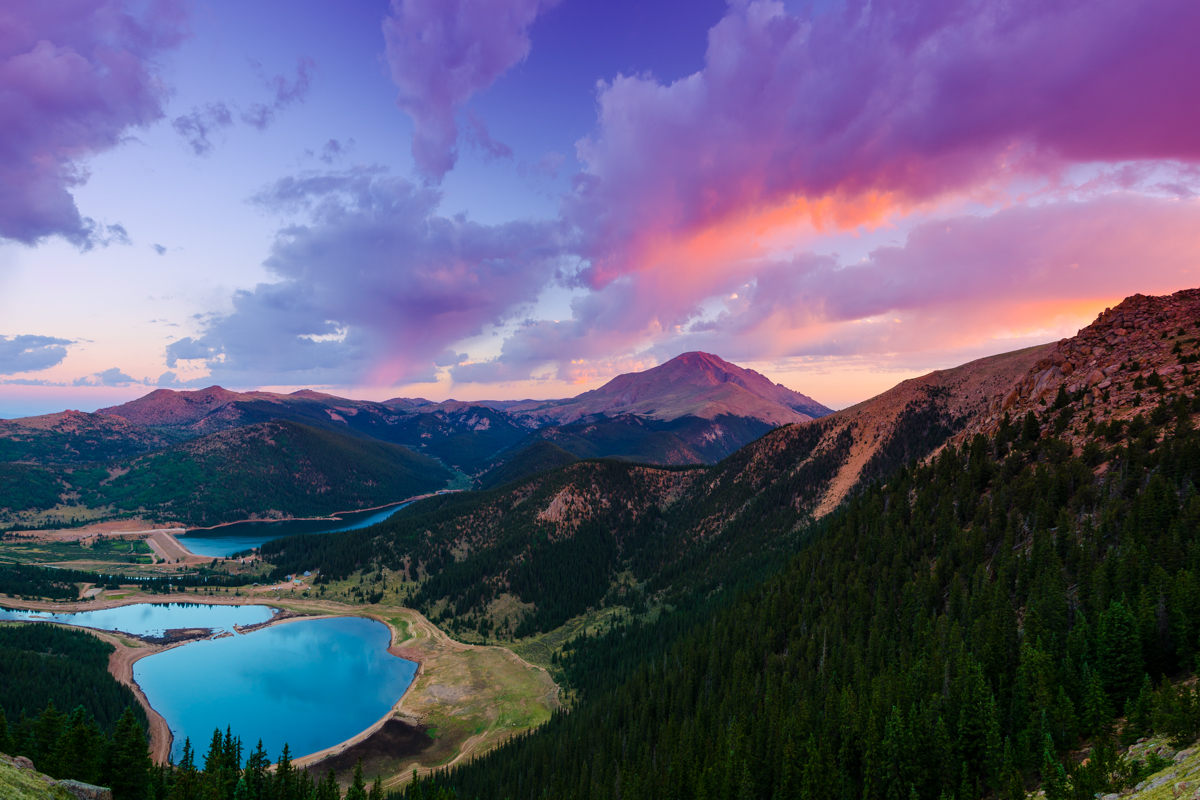
Eventually, Ethan and I packed up our tripods and continued up to the ridge for Almagre Mountain. Once on the ridge, we could see Stratton Reservoir, which looked more like Stratton pond. Additonally, we made lots of jokes about the "Weather Control Satellite" on top of Almagre Mountain South (which is really a microwave repeater). This was based on a very funny press conference earlier that week about the Waldo Canyon Fire where someone in the crowd actually seriously suggested that the government just use its weather control satellites to create rain to put out the fire. For more on the weather control satellite joke, check out this hilarious post.
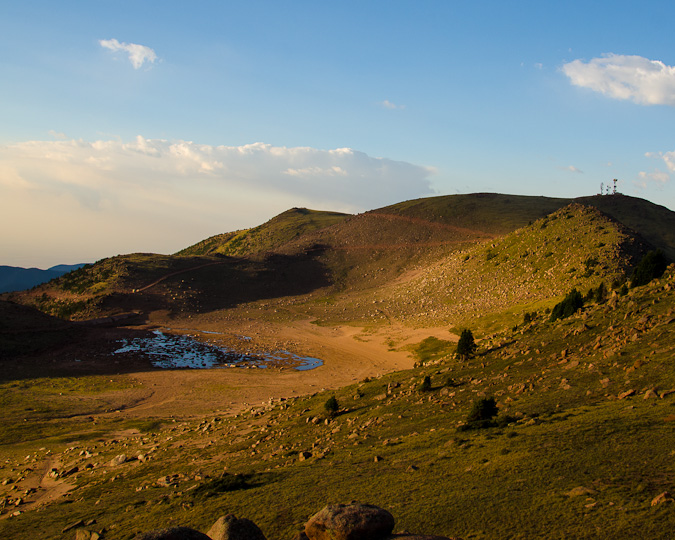
The terrain on the ridge was classic Pikes Peak granite - much of the same material found in the Lost Creek Wilderness Area.
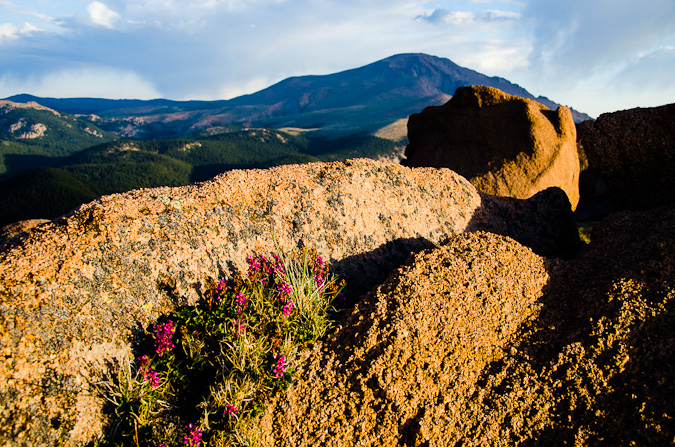
There were funky rock outcroppings all over the place. Nature sure does have a great sense of humor!
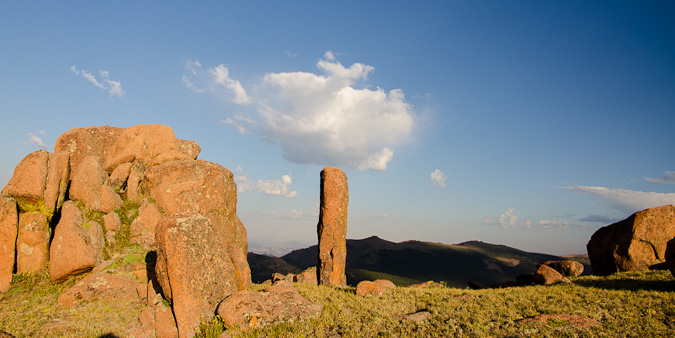
Ethan and I were both really loving the light and the color - somewhat tainted by the smoke from the huge fire that raged on to the north of us.
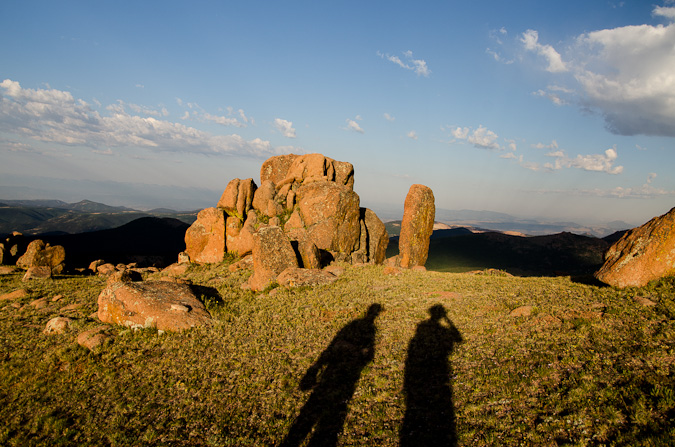
Ethan and I made several stops on the way up to take shots of the lakes and of Pikes Peak.
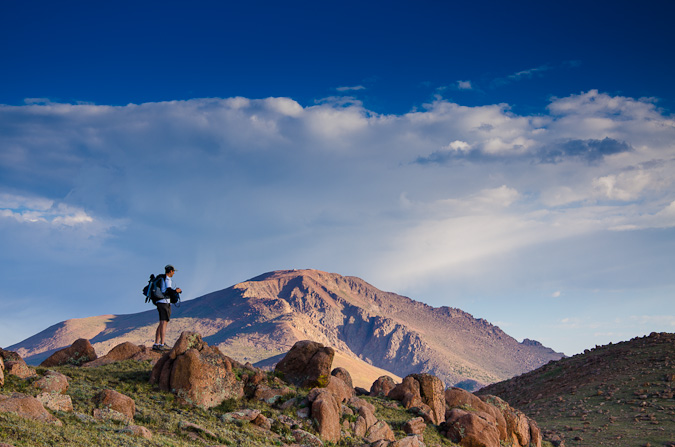
Before long, we had reached the summit without any problems. We had a great viewpoint of the fire burn area and the current burning zone. The smoke had settled into the valleys below us and made for quite the fantastic scene.
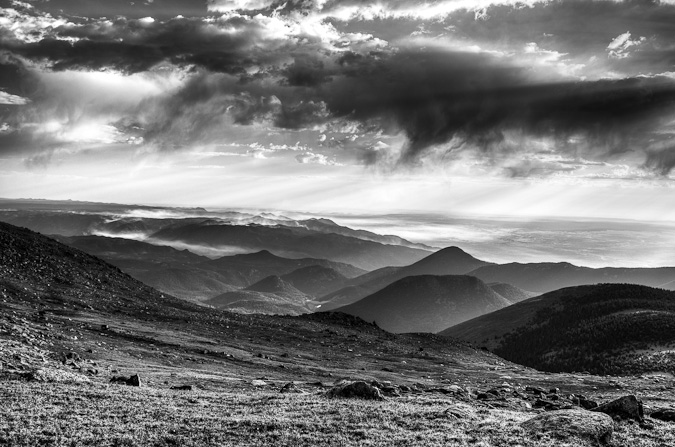
We both set-up tripods to take some time-lapse photos and video.
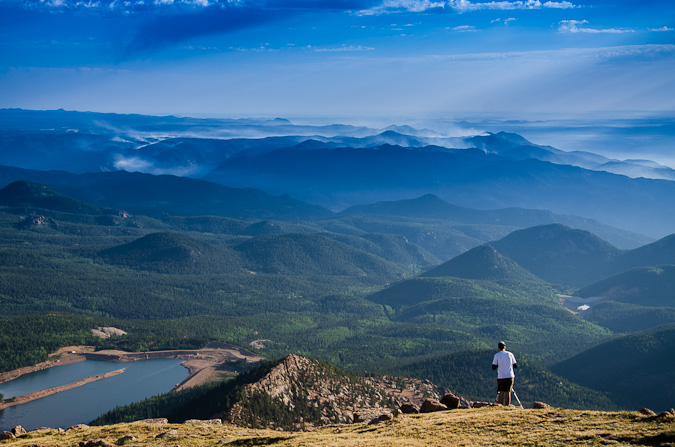
I was able to put together a 300 shot time-lapse video out of still images over a two-hour period from the summit. While it was pretty borning up there, I could not complain about the view.
I was able to get some pretty great zoomed-in shots of Rampart Range Reservoir about Highway 24, where the fire was most active at this point. A zoomed in view shows quite a bit of destruction in that area, but as bad Ias I had thought would / could happen.
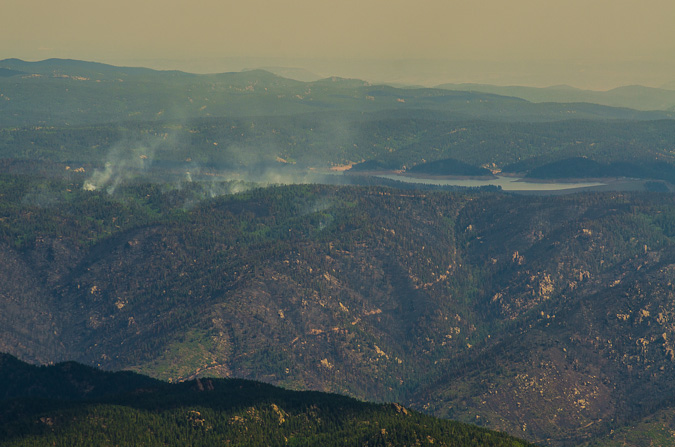
The 360 degree view was fantastic as well - with Pikes Peak anchoring the center of this peice.

I was even able to get a super zoomed in view of the Pikea Peak summit, where I could make out people and the Cog Railway.

We both decided that after spending two hours on the summit that it was time to head-out. So we did just that. Right beforehand I was able to get a sweet shot of Ethan way up on the summit taking shots.
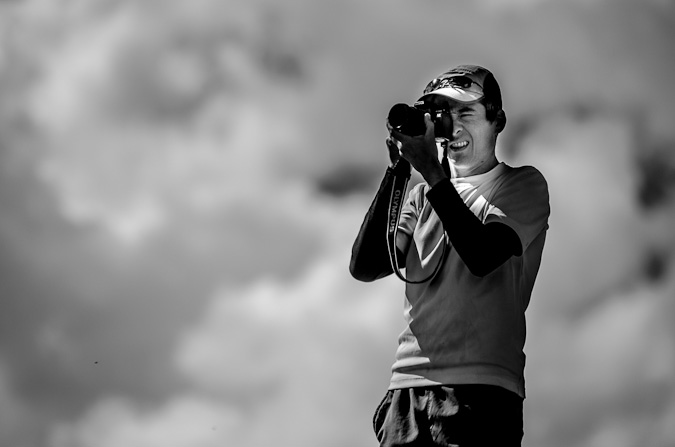
On the way back, I was able to get a better shot of Stratton Reservoir (with Mount Rosa in the background), now reduced to almost nothing.
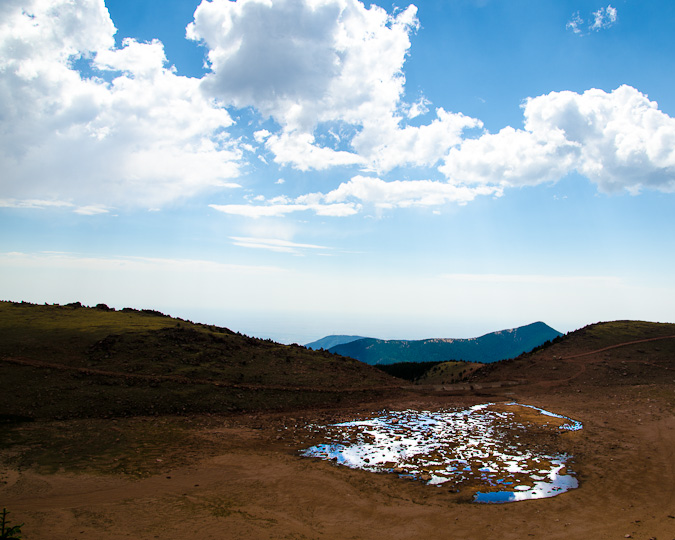
And of course, our down-climb would not be complete without another shot of the Weather Control Satellite...
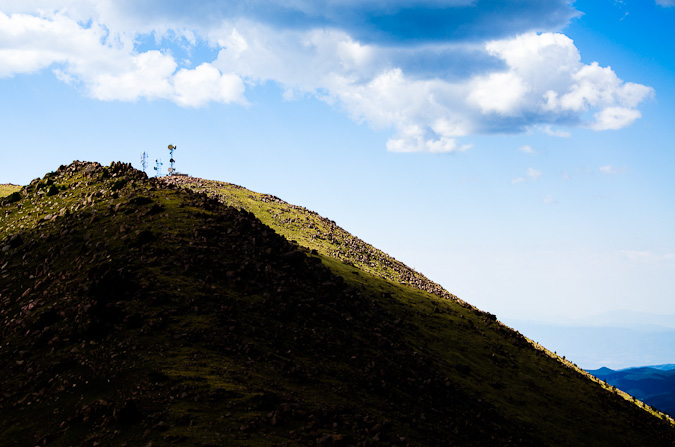
The hike back down to the car was quite uneventful. We noticed there were a lot of butterflys out and so we were able to follow one to this huge thistle plant, where countless other insects were hanging out, drinking nector from these hearty flowers.
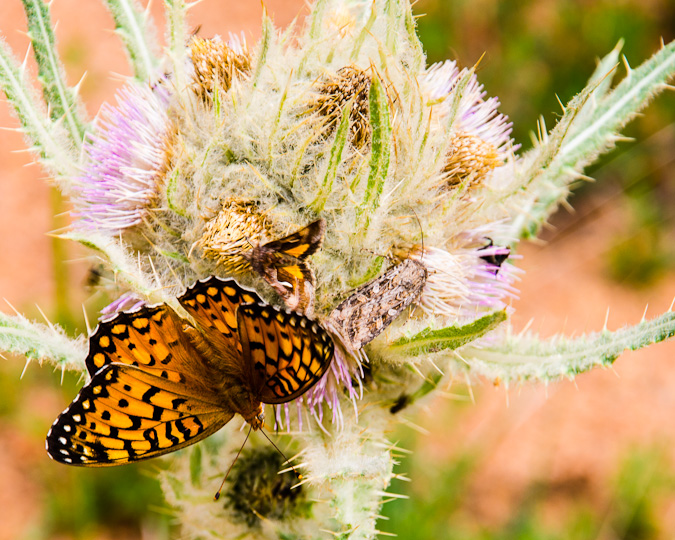
All in all, I would rate Almagre Mountain as very easy - a mountain for all ages and skill levels. The rare views of Pikes Peak alone were worth the drive and hike for me.
{fcomment}
Adventures on Cameron Cone - Views of Pikes Peak and Beyond
This Spring has been quite dry and I've been feeling the itch to get out and get up a summit. I mulled the idea of heading up to do Lackawanna (a high 13er near Independence Pass); however, I knew my time was limited and that I would need to stay closer to home. So, I put out a feeler to my climbing partner Ethan Beute to see if he would be interested in doing something easy close to home. We both settled on Cameron Cone, the easily recognized point often seen in front of Pikes Peak in many photos of Pikes from Colorado Springs. I'd had my radar on Cameron Cone forever it had seemed, so it was a great choice in that regard. At the last minute, I also invited one of my other hiking partners, Sarah Musick, and plans were in motion to meet at Ethan's at 5 AM and hit the Cone. Since both Ethan and I are avid photographers, we opted for the early start in the hopes of getting some decent shots of sunrise from the trail somewhere.
Cameron Cone is named after a famous soldier and newspaper publisher, Robert Alexander Cameron. When originally dedicated, the summit was called Cameron's Cone. The Cone towers 10,707 feet above the city of Colorado Springs and is the fourth highest ranked summit in El Paso County and 1,935th highest in the State of Colorado. For a whole listing of summits in El Paso County, check out this link.
There are several routes to reach the summit of Cameron Cone; however, we chose one of the more rigorous routes to gain the summit. Instead of driving to Crystal Park, as some would suggest, we opted for the long route from Barr Trail. Here is a map of our route, feel free to click on it to see a slightly larger version. All in all the hike was 7.0 miles and 4,175 ft. of elevation gain - a nice work out for sure!
We decided to park on Ruxton Ave. in Manitou Springs and walk the road to where it ends. We then chose to cut left just after the chain link fence to the left of the Barr Trail and then walk the Cog Railway about a hundred feet. From there, we went straight up the hillside to the south until we reached the Englemann Trail. We found this guide to be very useful for the trip, as you can see from this photo of Ethan and I taken by Sarah.
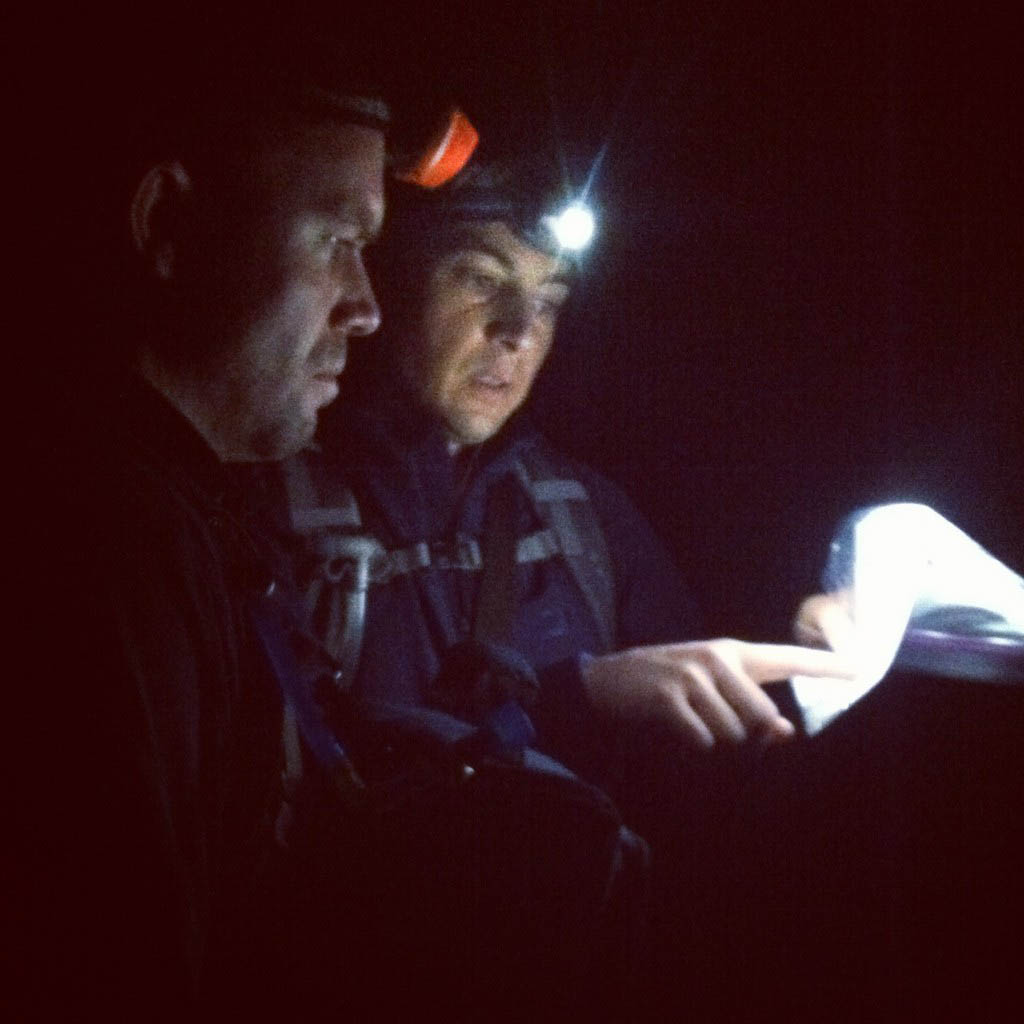
We found the route to be fairly straight-forward once on the trail; however, we did lose the trail in one spot lower in the Englemann canyon. A simple up-climb and we were able to re-locate the trail. I would mention that I did bring my GPS with me and I had entered the coordinates from the Summitpost route description into my GPS as waypoints which proved useful.
Before we knew it, the sun had begun to rise and we found a suitable place to stop. I set-up my new Gitzo carbon-fiber tripod and took a ton of shots with my Tokina 11-16 lens. I love this tripod! It was somewhat heavy, but well worth the haul. I was not terribly impressed with my sunrise photos, mostly because I think we were too low and some of the view was obscured by Eagle Mountain to the south and east. Nonetheless, here's a few of my shots.
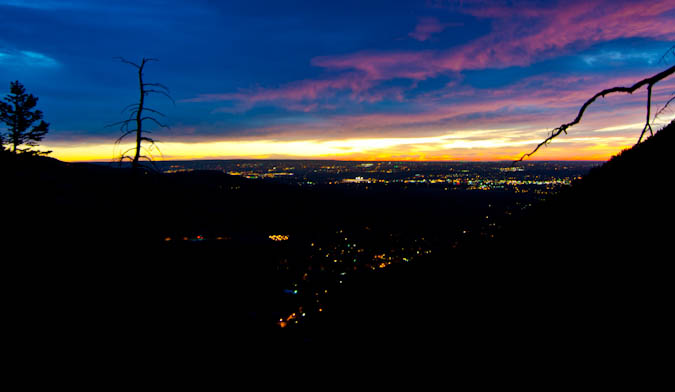
The city lights made for a very cool view.
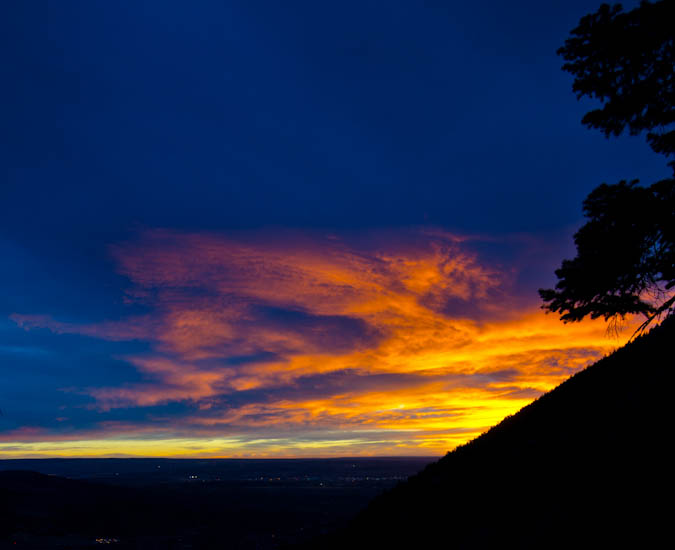
I also had a little bit of fun doing a very short time-lapse video of sunrise using my intervalometer on my Nikon D7000.
After stopping to take some shots of the sunrise, we continued on up the trail. The trail was fairly steep and kept our heart-rates going. Soon, the trail went around this huge rock feature and then dumped us out with a huge view of Pikes Peak and the Cog Railroad, which was pretty impressive.
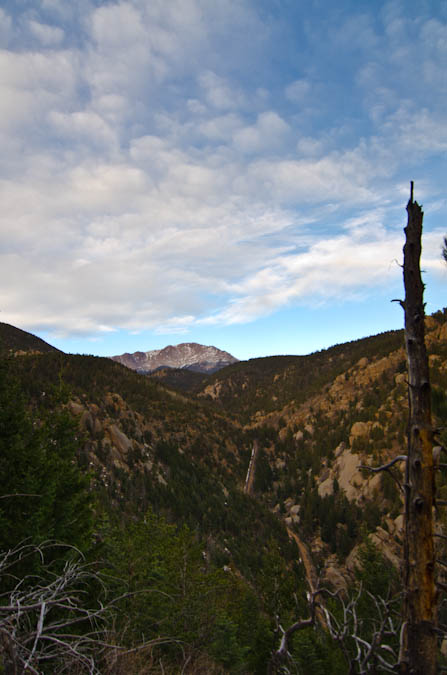
The rock near the trail was very classic Pikes Peak Granite, with features very similar to those of outcroppings found in Lost Creek Wilderness Area. A truly fun playground, as Sarah was able to demonstrate.
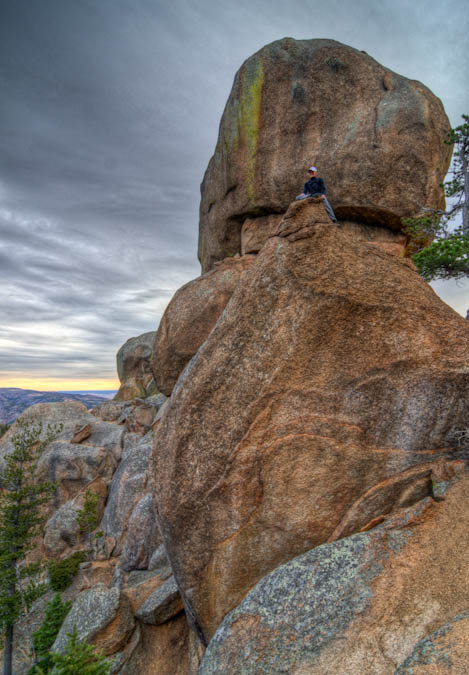
Ethan and I both enjoyed the view of Pikes Peak from this location.
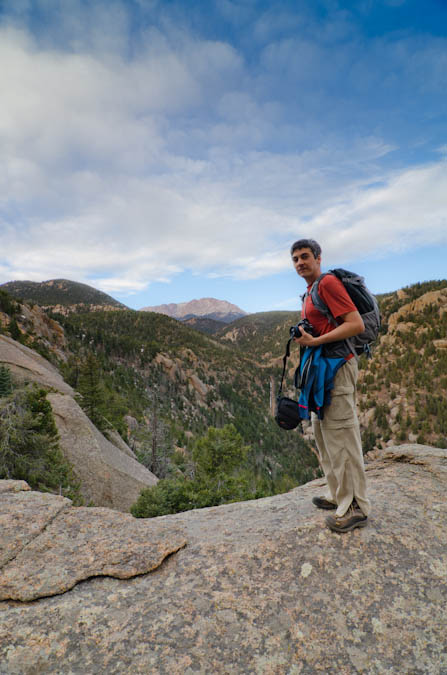
The terrain was like a playground of sorts, with all kind of really cool features.
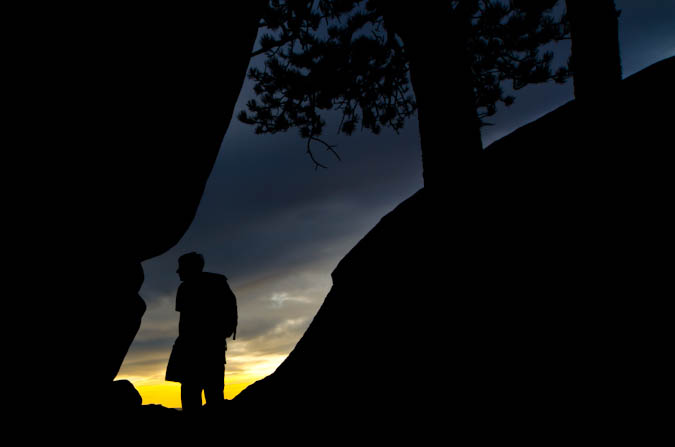
We took a few more pictures and then we were on our way up to the next section of the trail.
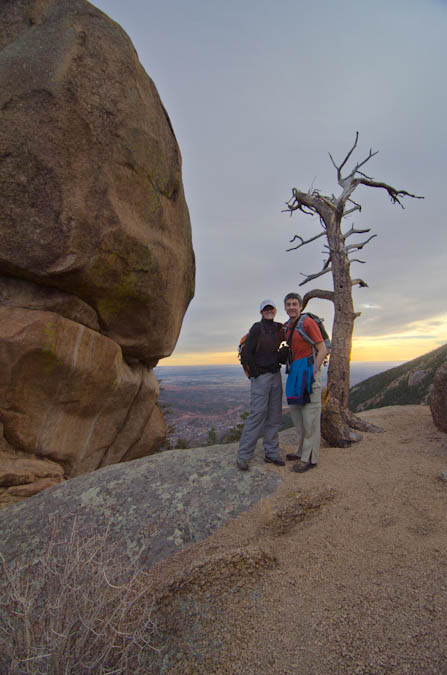
Soon, the trail opened-up again and dumped us out onto a very flat area which was the middle section of the hike. From here, we could see Cameron Cone finally - it seemed a lot futher away than I think we were anticipating. We could also see the Magog Ridge and Magog Rock. For the rest of the hike we all jokingly coined the phrase "Oh-my-Gog."
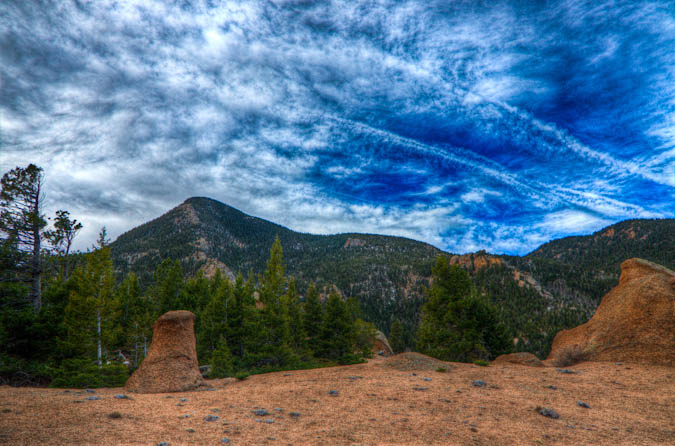
We went around the huge Magog Rock, which was one of the cooler features I'd seen. It had this smaller rock perched above it which made us all wonder how the heck something like that could even happen.
Ethan took many opportunities to take photos of it as well.
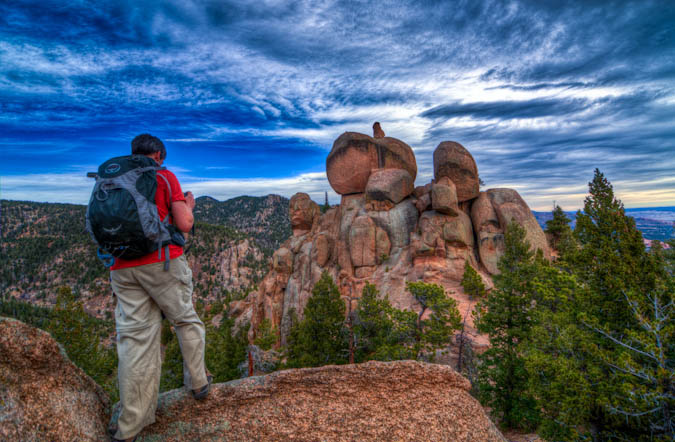
We followed a small road for a ways and then found the trail leading up to Cameron Cone, as advertised. Indeed, the trail was faint and sometimes hard to follow. We did find that there were small ribbons tied to trees at various intervals to help mark the way. We lost the trail a couple of times and found ourselves bushwacking through some steep and nasty terrain. Finally, we reached the ridge to the south of Cameron Cone and then ascended to the summit. It was pretty steep and I could understand if people turned back on this climb. It is much harder than it looks, for sure. Once we reached the top, we all enjoyed the view of Colorado Springs to the east and the unique view of Pikes Peak to the west. I busted out my tripod and set it up for some HDR work. Ethan caught me in the act, with Almagre in the background.
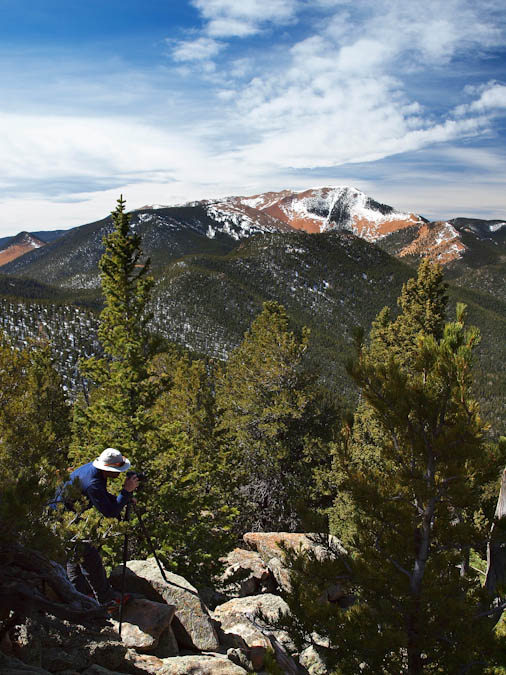
The sky was pretty cool for photography and some jet contrails added to the interest level.
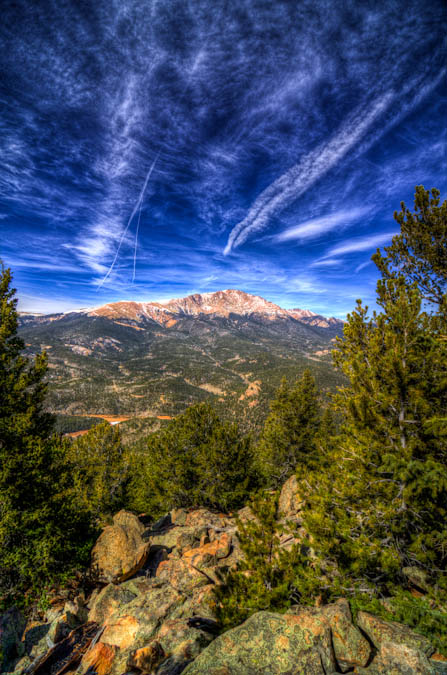
One other nice advantage to bringing a tripod is that it makes for easy group photos.
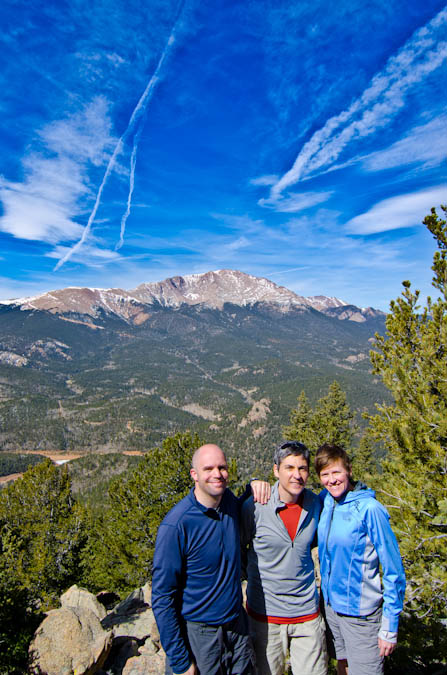
On the other side of the summit, the views of Colorado Springs, Waldo Canyon, Williams Canyon, Garden of the Gods and Colorado Springs were pretty impressive.
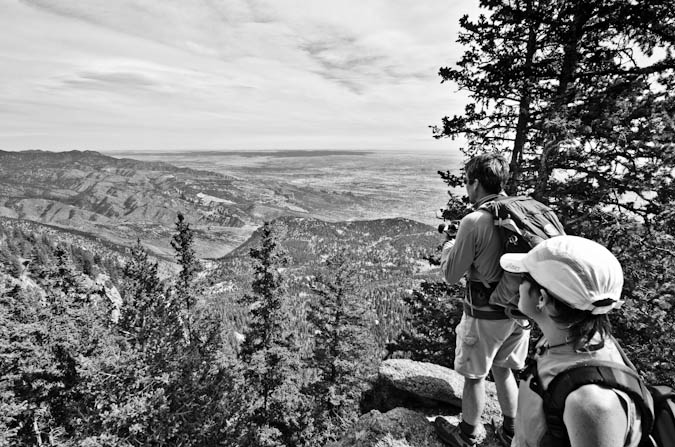
From here, I took a quick panoramic photo of the Colorado Springs area, looking northeast, east and southeast.
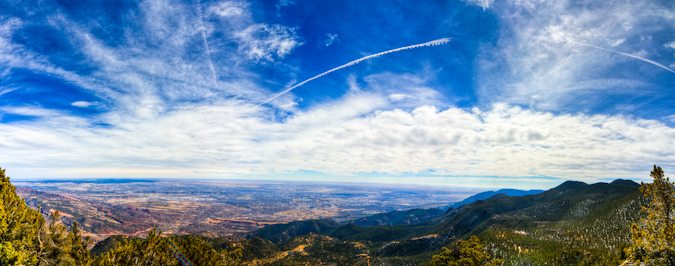
We spent about an hour on the summit and then head back down. The rest of the trip was pretty uneventful, albeit full of great conversation with some really great friends. I left with one parting shot of Pikes Peak.
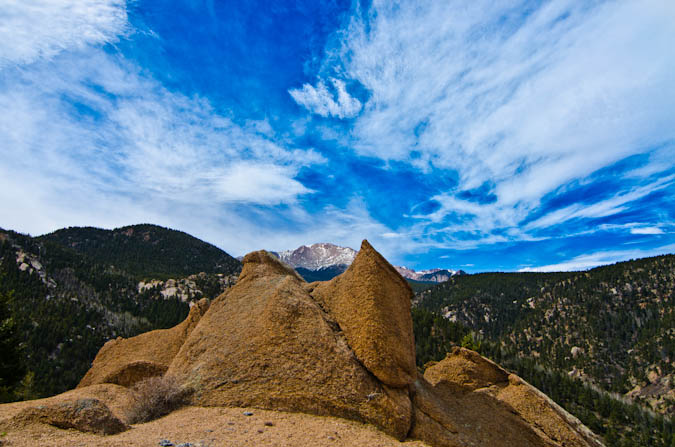
Overall, Cameron Cone is a great hike! It is tougher than it looks and demands some respect when climbed from Barr Trail. Also, good route-finding skills are also required.
The views of Pikes Peak on this trip are totally worth the hike and are quite unique. You won't be disappointed if you choose this mountain that is off the beaten path.
{fcomment}
A Mad Scramble in the Sangres - Mount Adams and UN 13,580
Mount Adams is one of the last mountains in the top 100 in the Sangre de Cristo Range that I've yet to climb. It has always drawn my attention on other hikes in the area, and I had hopes of climbing it this spring. Instead, I opted to climb California Peak with Ethan, which was a great hike. Originally, I had planned to climb Pyramid Peak this weekend; however, none of my climbing partners had crampons, so we decided to hit Mount Adams instead. I had always read great things about climbing Mount Adams, and Gerry Roach has the west ridge route marked as a classic climb. Since I have more or less always agreed with Roach's ratings for "classic climbs," I figured that it would be the best way to climb it. So, Ethan and I agreed to take the west ridge route instead of the standard route. Feel free to read more about Roach's 13'er guidebook HERE.
This was particularly exciting since I have wanted to go back to Willow Lake for awhile now. Willow Lake is truly a magical place, and should be designated as a wilderness area, in all honesty. The lake is pristine, with a giant waterfall at its head. Additionally, it is surrounded by some of the most rugged and aesthetically remarkable mountains in Colorado, including Kit Carson Peak, Challenger Point, Columbia Point, Crestone Peak and Crestone Needle, not to mention Mount Adams!
Mount Adams is the 66th highest ranked summit in Colorado, sitting at 13,931 ft. 69 more feet and it would be climbed much more frequently, not that Ethan and I are complaining that we didn't see another soul on the summit...
Looking at the maps while driving over, Ethan and I also thought it might be fun to tack on another peak or two while we were out, so we decided that once we reached the summit of Adams, we would evaluate the conditions and how we felt and then decide on the next steps.
The drive over to the town of Crestone was remarkably unremarkable except for two incredible details. First, the pizza at Amicas in Salida was incredible, as usual. Second, the sunset as we were leaving Salida was insane. We drove out of town, heading west into Poncha Springs, and decided we HAD to pull over and take photos of this rediculous sunset. For my photos, I opted to do a minor HDR treatment since the foreground was quite interesting -we had stopped just in front of a huge grassy area used for cattle to pasture on. The results were stunning, with the sunsetting directly behind Mount Shavano.
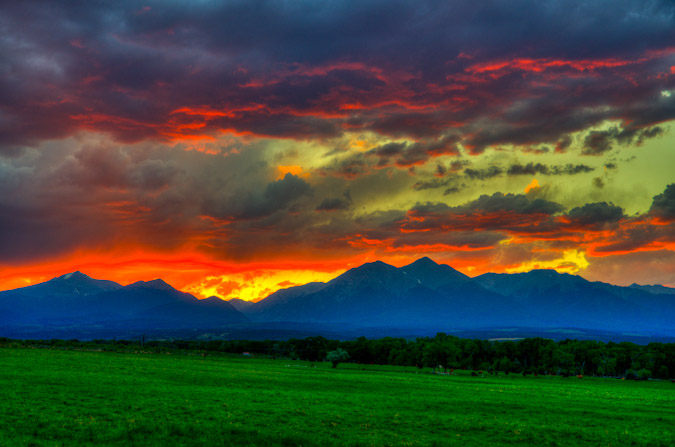
Here's a zoomed-out version of the same scene, which I personally prefer.
We arrived at the Willow Lake trailhead around 10 PM, set-up Ethan's tent, and hit the sack, with our alarm set for 2 AM. We wanted to ensure that we had enough time to reach the summit of Adams before the weather hit. As soon as the alarm went off, we packed up quickly and hit the trail. The hike was an interesting one since there was a full moon and because we did not get a ton of sleep. Nevertheless, we hiked quickly and reached the base of Willow Lake within 2.5 hours.
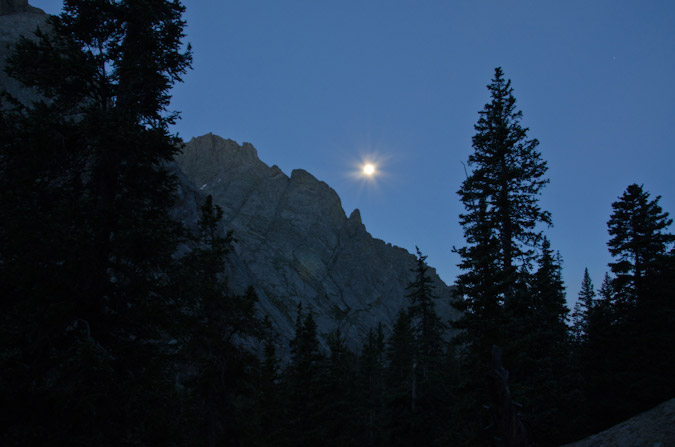
The full moon made for some pretty fun photography opportunities, although photographing the moon is always a big challenge unless you have a really nice zoom lens. Most photos you will see of the moon and of a scene are two images layered as one, since it is literally impossible to photograph the moon and your foreground without either overexposing the moon (like above) or underexposing your foreground. Anyways, seeing Willow Lake again was great. We rested there for a good 30 minutes and took some photos. The waterfall was just as awesome as I had remembered it to be.
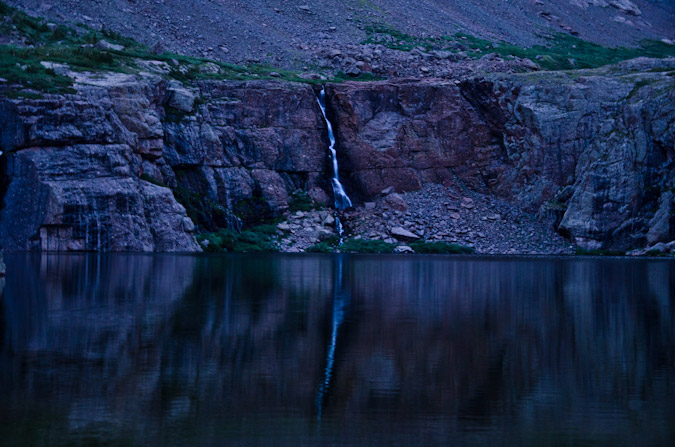
We saw lots of tents on the way up, probably 15 total. Lots of people were up here to climb the 14ers. We were the only group doing Mount Adams though. We gained the trail to the left of the lake and began to ascend above the lake in quick order, stopping every once in awhile to get some photos.
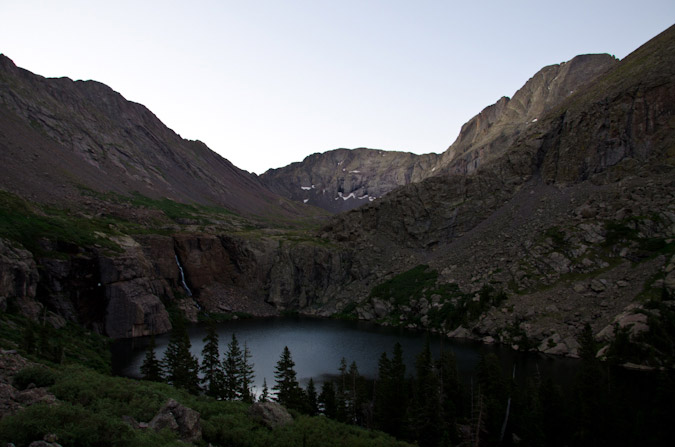
Before we knew it, we had gone too far and were nearly at the head of the lake near the waterfall. While we knew we were somewhat off-route, we decided to get into a good position to get photos of the sunrise and the full moon over Willow Lake.
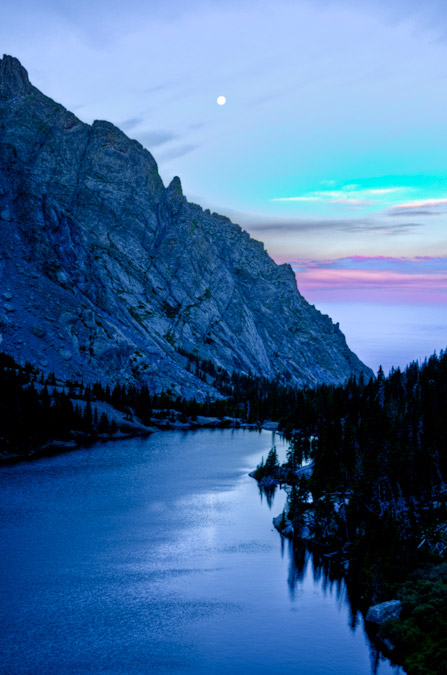
We then turned sharply south to gain elevation into the small basin beneath Mount Adams. Since there is no trail up there, we just followed beneath the termination of a large cliff wall that led into the area, looking back from time to time to catch the sunlight on Kit Carson Peak.
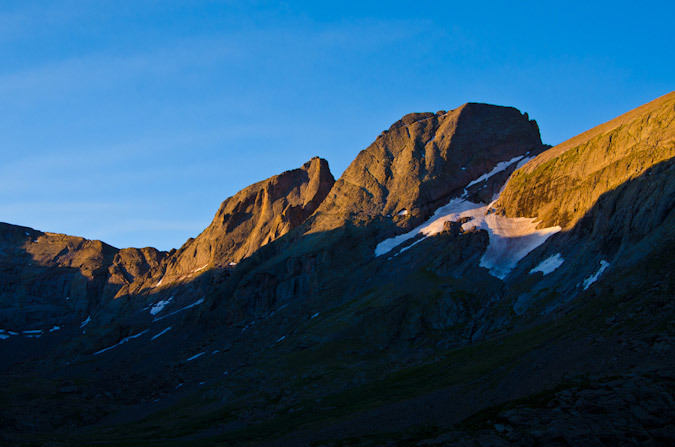
I've always like the geology of this area, which is comprised of clastic sedimentary rocks, which appear as large pebbles that are cemented together. These rocks sometimes erode, to leave behind some really interesting features. For more information on Crestone Conglomerate, check out this interesting website.
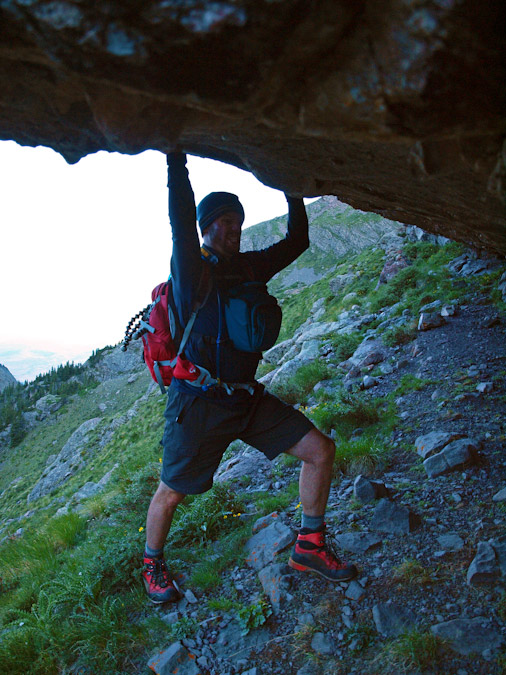
As we gained the basin, we could not help but notice the amazing hues cast onto Willow Lake by the sun hitting the southern aspects of Challenger Point.
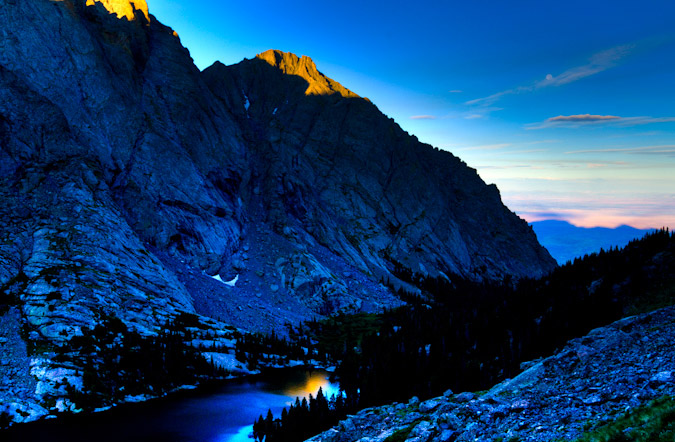
Indeed, the alpenglow on KIt Carson Peak and Challenger Point were quite impressive, and coupled with the moon and the lake it made for a perfect scene to hone my HDR skills. If you've ever wondered how to do HDR, you can do like I did, and read about it a ton, or watch this perfectly succinct tutorial from Trey Ratcliff.
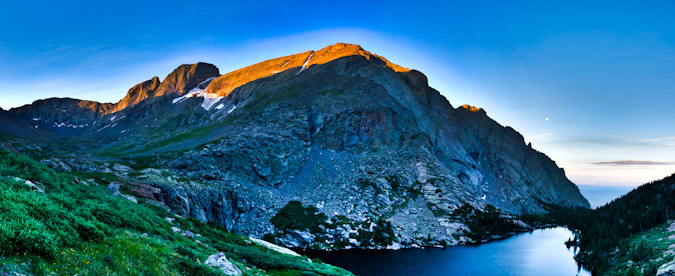
We kept on hiking up into the basin towards Mount Adams and stumbled upon a pair of really nice looking ponds. The ponds were surrounding by wildflowers and separated by a huge jutting rock feature, which made for quite a lovely subject for an HDR panoramic. Additionally, the clouds were insane, and continued to be all day long.

After a few more minutes, Mount Adams finally came into view for the first time.
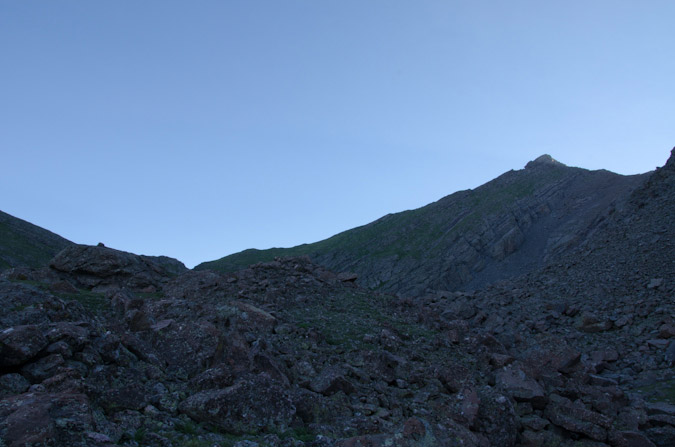
The route seemed quite straight-forward to us, so we opted to just follow a rock gully up towards the ridge, which was strewn with all sorts of wildflowers.
|
|
|
Ethan was a superb photography this day - he captured many many photos of me throughout the journey, all of which I really enjoyed his perspective and composition on.
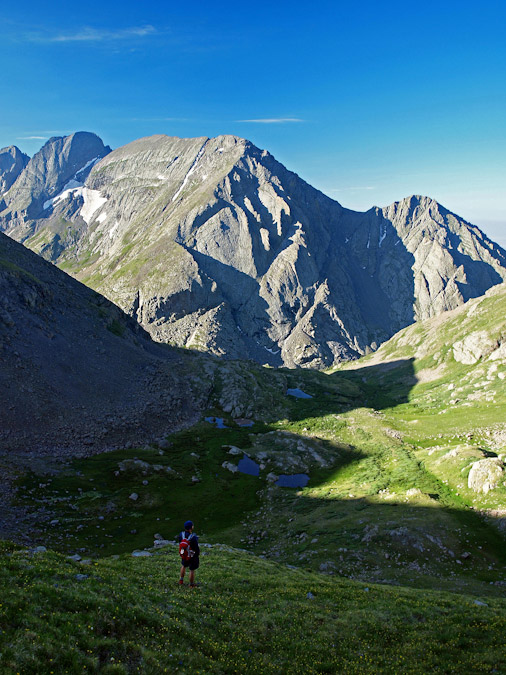
We finally gained the ridge!
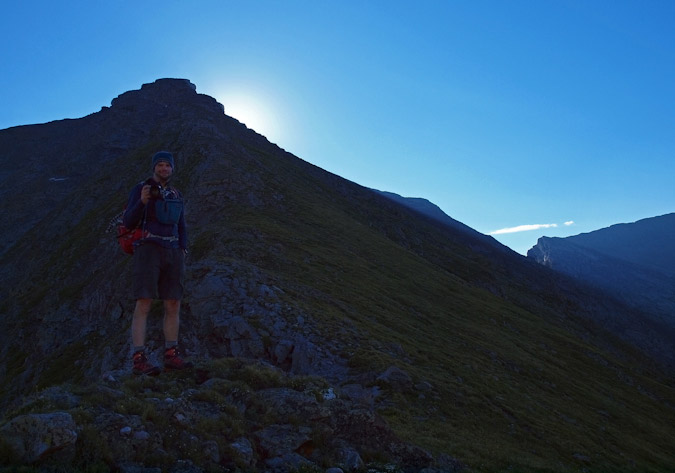
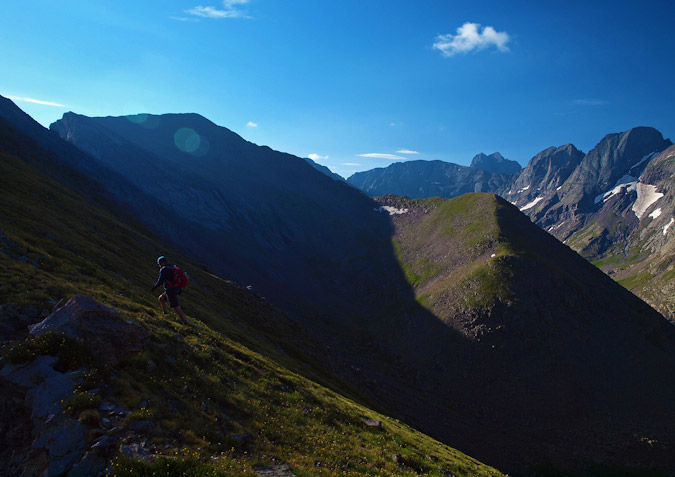
We were able to look down at South Crestone Lake and some 'miniture' Crestone Needle looking mountains.
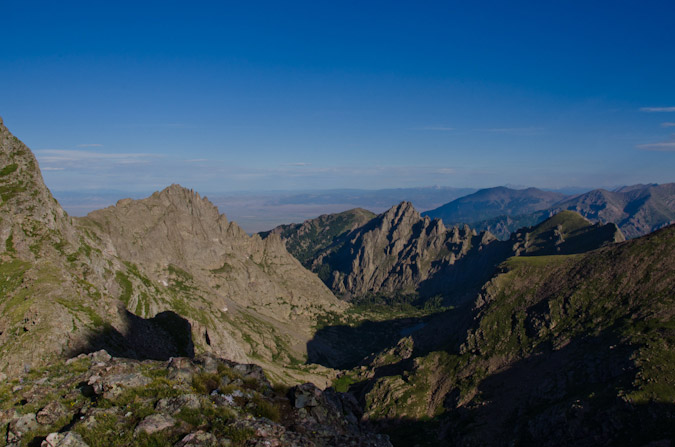
As we continued up, Crestone Peak came into view, and eventually Crestone Needle as well.
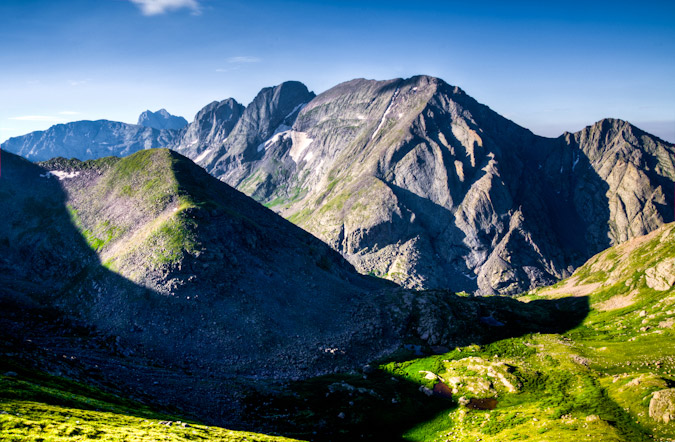
The wildflowers on Mount Adams were amazing.
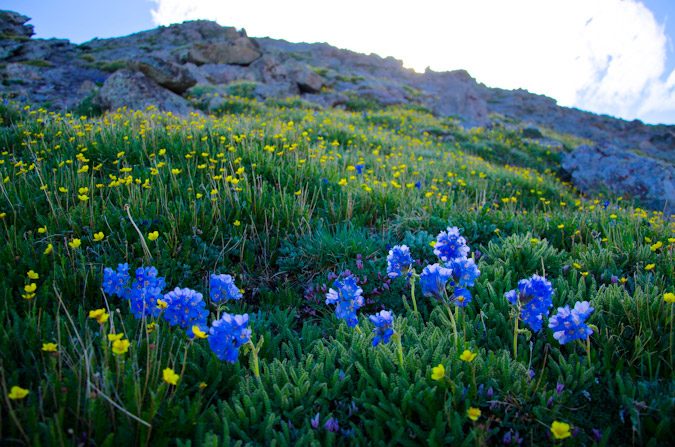
|
|
|
And the route up the west ridge was fabulous. In some sections, it really reminded me of Crestone Needle, just not as steep. The same type of rocks made for some enjoyable route-finding. I shall hereby dub Mount Adams, "Baby Crestone Needle." The similarities in the rock were remarkable.
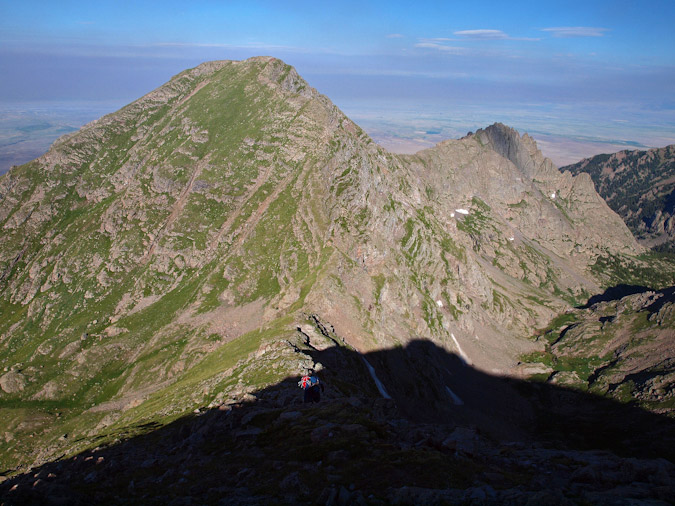
The clouds continued to look awesome, and so I was able to get this photo of Ethan gaining the ridge higher up.
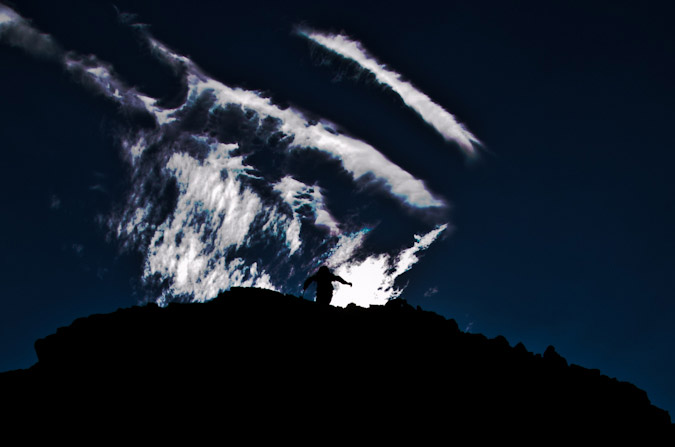
I was also able to get a really nice panoramic photo of Ethan gaining the ridge with the nutty clouds behind him. Click to see a larger version.
Check out this cloud - it looks like its going to eat my soul - thanks Ethan!
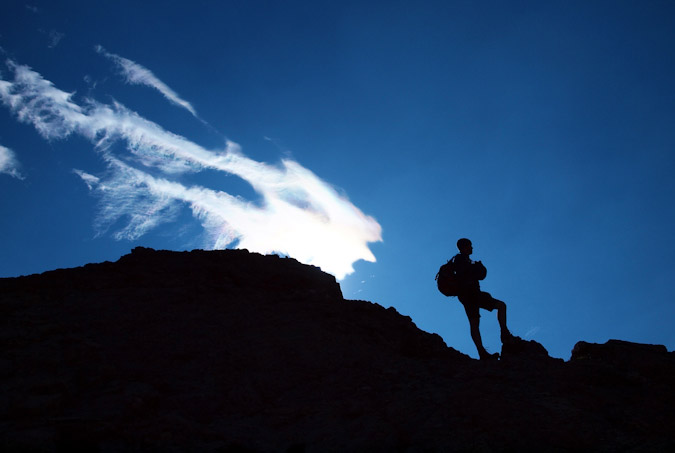
We stopped frequently to shoot photos. This is an all too familiar scene - me shooting photos of flowers. Thanks for catching me in the act, Ethan!
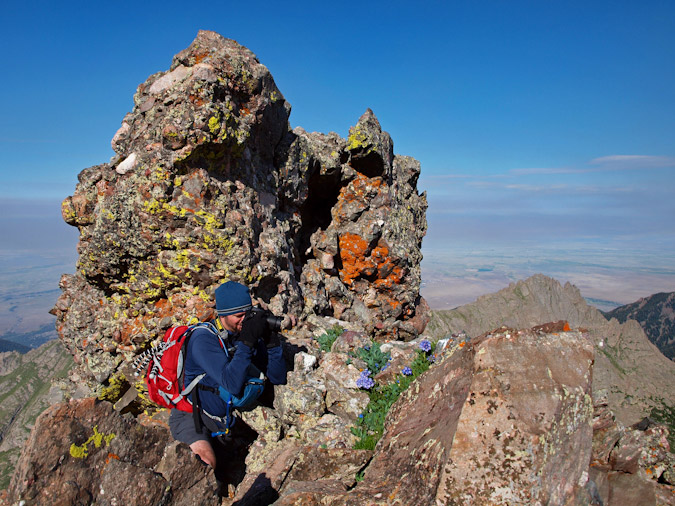
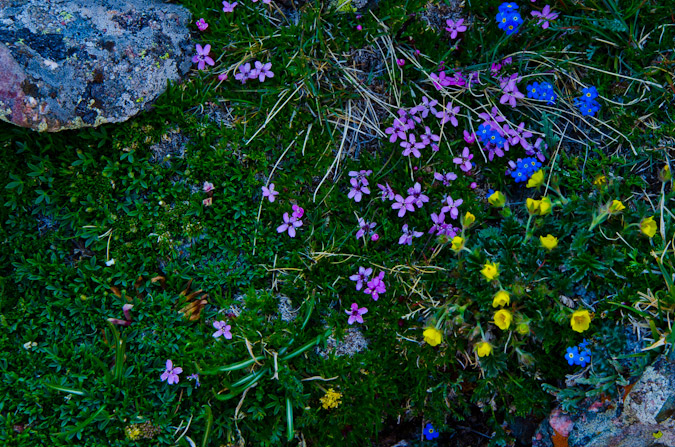
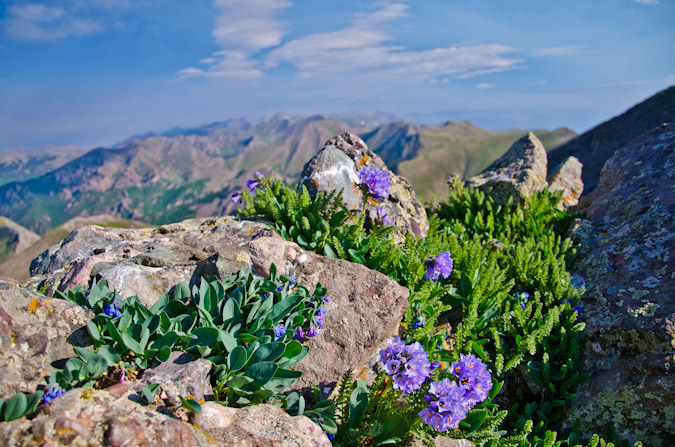
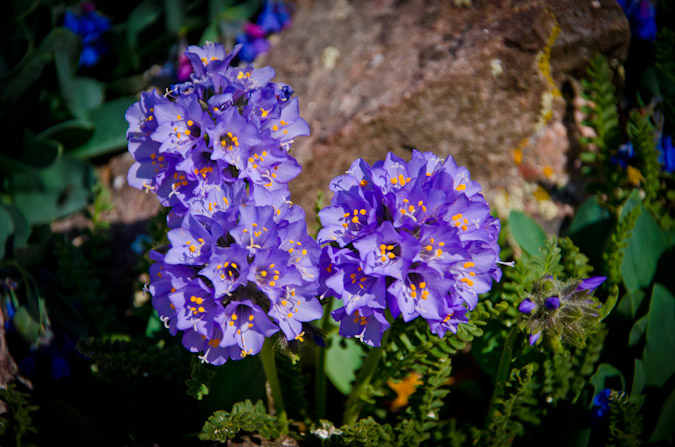
We kept on truckin' up to the summit block, which proved to have some enjoyable class 3 options if one so chose, so we did.
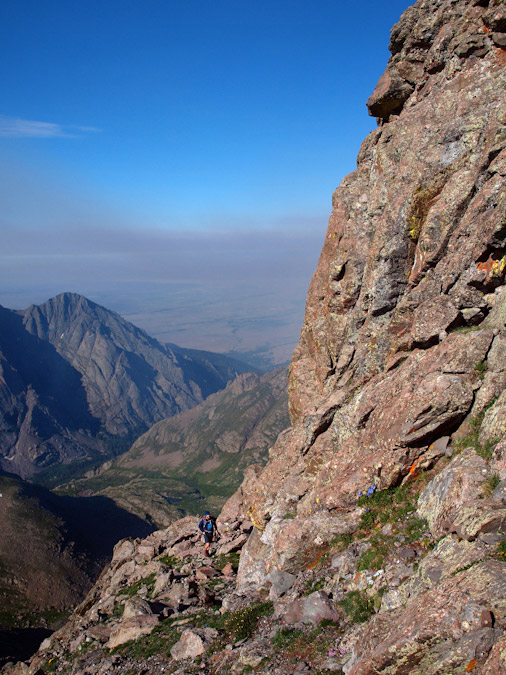
Finally, we reached the summit and took a congratulatory summit shot using Ethan's camera on self-timer.
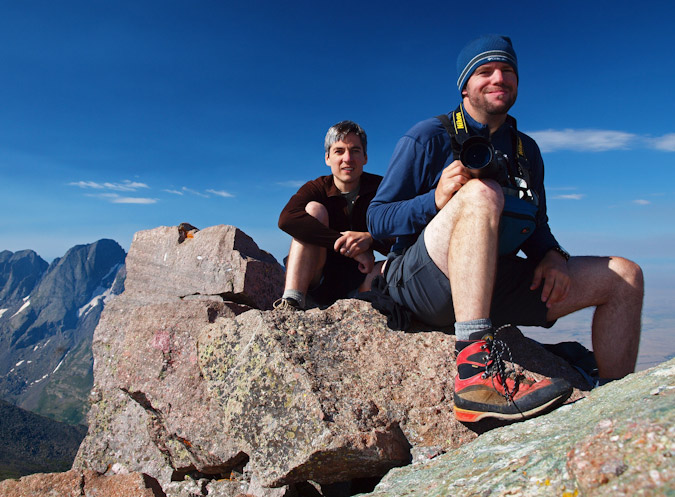
Mount Adams was a great climb, for sure. The summit was superb, with excellent views in all directions.
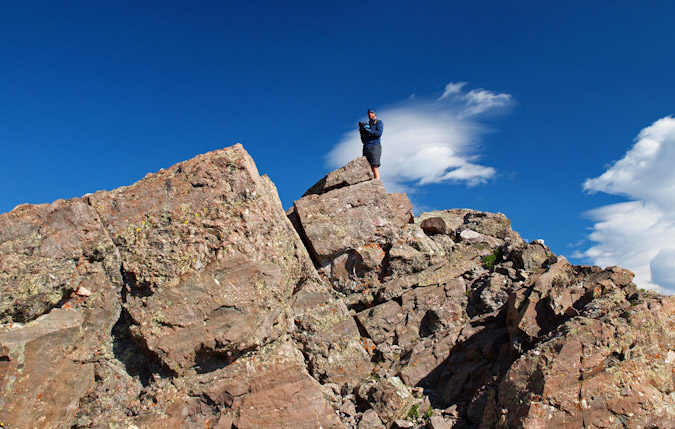
We also had some insane smoke appear out of nowhere in the valleys around us, and before we knew it, the smoke was gone. It was truly odd. It was almost as if the valley below was on fire and then put out before we knew it. A look to the north revealed some crazy looking clouds over Rito Alto, Venable and Comanche.
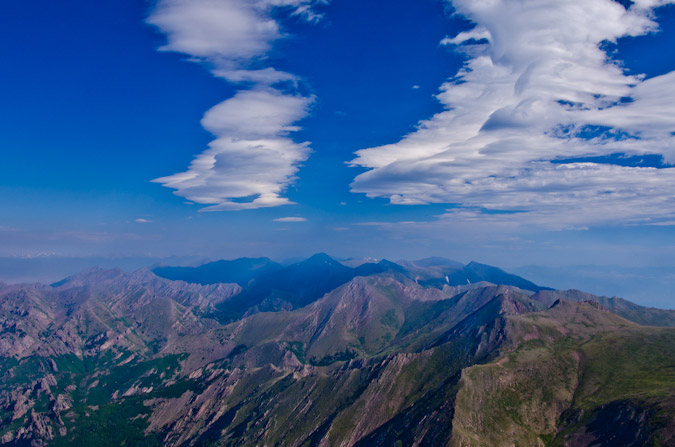
We also found an awesome spot with a great vantage point for a celebration pose. We took advantage and marvelled at the sheer depth below us from where we stood.
|
|
|
Naturally, my focus was on Crestone Needle and Crestone Peak, two of my favorite mountains in Colorado. They are so distinguishable and quite honestly some of the freakishly looking peaks there are in Colorado. In fact, Crestone Needle ranks just 4th on the "Most Impressive" list (for ranked peaks) that is based on the work of David Metzler and the ORS/RORS scales.
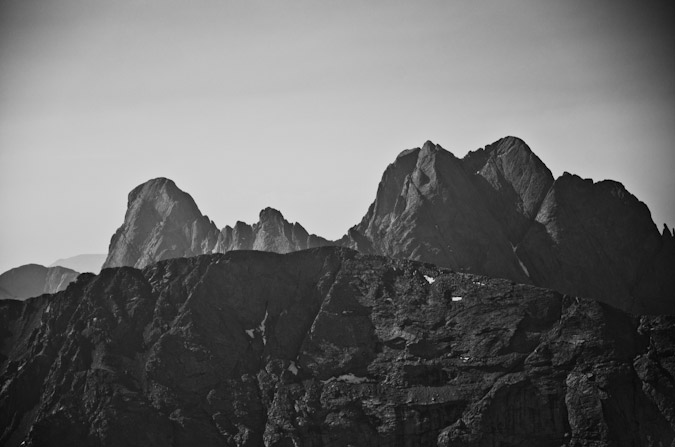
A view to the east revealed Fluted Peak (far left), Horn Peak (left, in distance) and the Horn Lakes below. UN 13,580 (ranked 201) was directly south, with UN 13,541 and Obstruction Peak and Humboldt behind. Additionally, Crestone Needle and Crestone Peak stood out like sore thumbs with Columbia Point, Kit Carson Peak and Challenger Point all towering over the basin below.

A closer look at the 14ers of the area. Left to right - Crestone Needle, Crestone Peak, Columbia Point (13er, ranked 56th), Kit Carson Peak and Challenger Point.
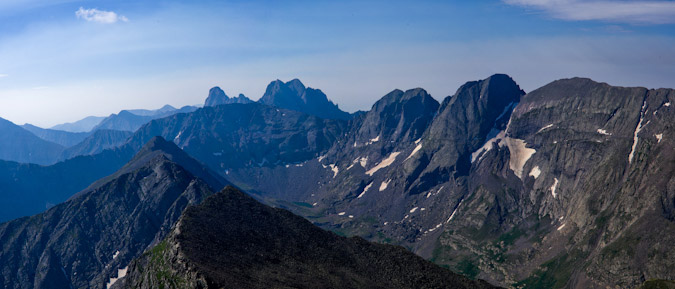
Ethan was loving the views and the clouds.
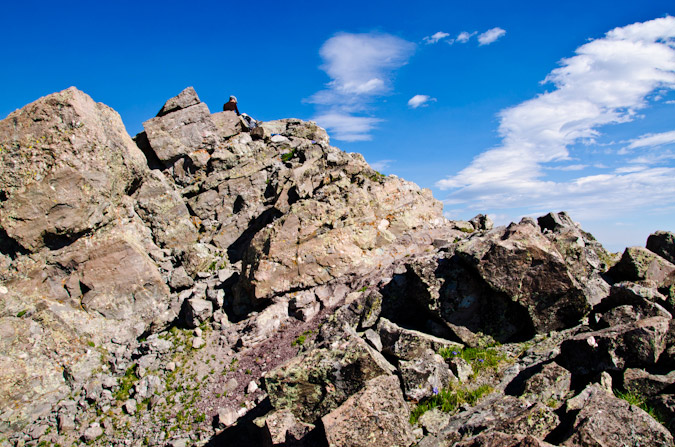
And so was I...
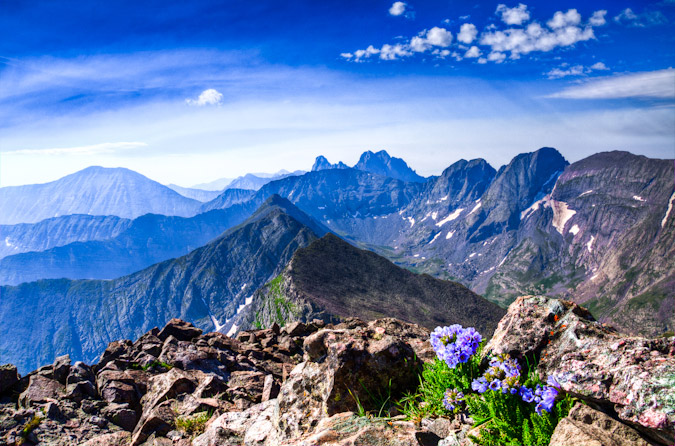
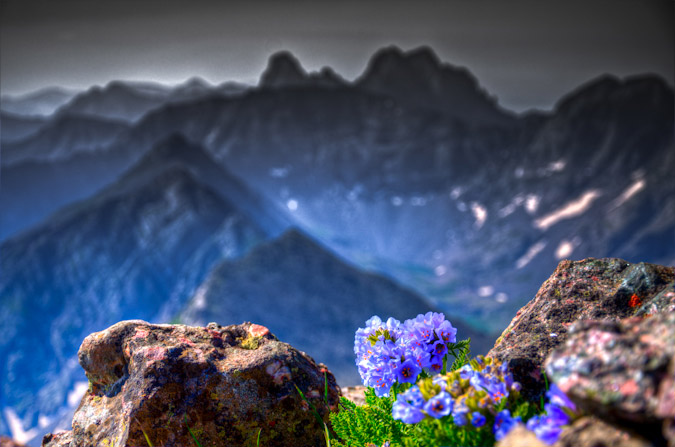
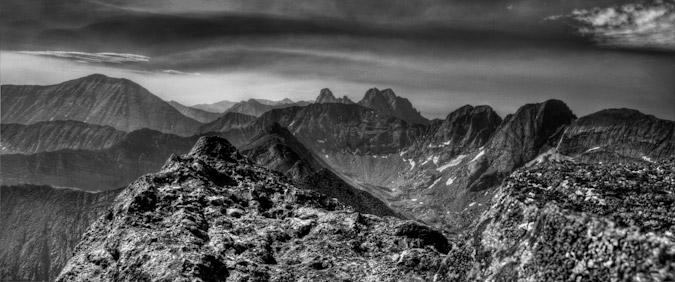
Alas - a perfect summit does not last forever, so we decided to head south towards UN 13,580 and beyond to see what we could accomplish. The dramatic nature of the cliffs to our left kept us on our toes and in amazement for quite a long distance.
|
|
|
Also, the traverse over to 13,580 proved to offer some really fun challenges, including this class 3 manuever above a hugely exposed section.
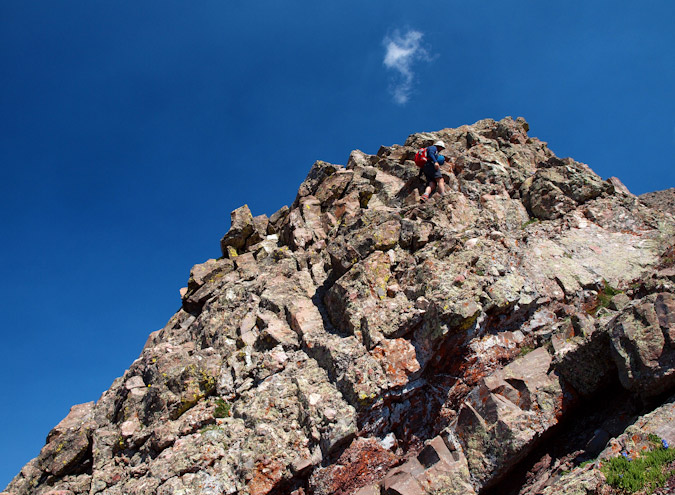
But it also offered some fun boulder scrambling on very solid rock.
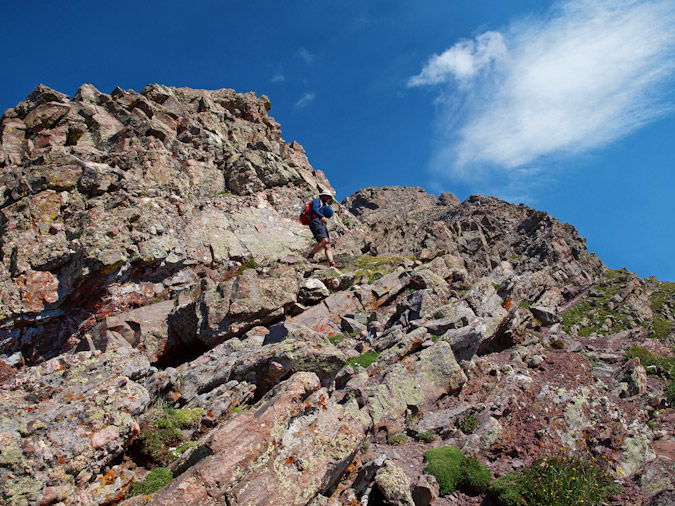
UN 13,580 was not too far from us, and the views kept us from moving too quickly.
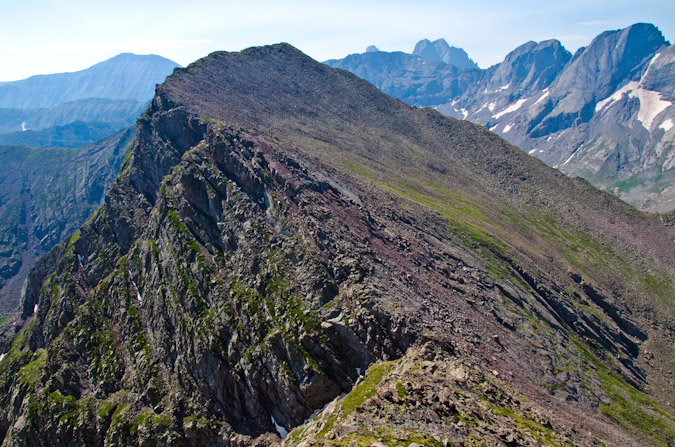
The rock was all totally solid, but in places it was awkward walking on slanted slopes of what felt like giant fissures in the earth.
|
|
|
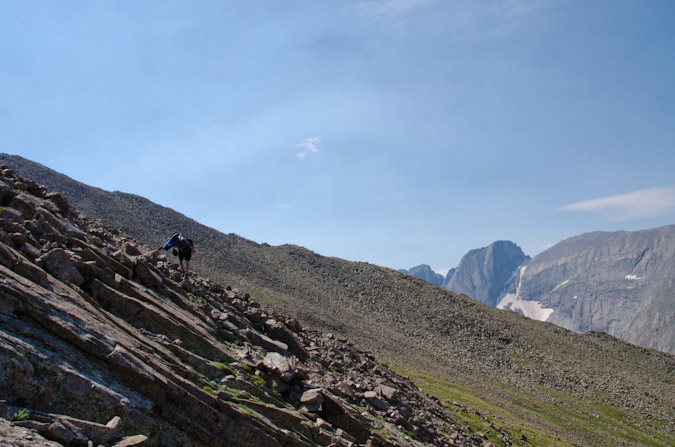
A look back at Mount Adams...
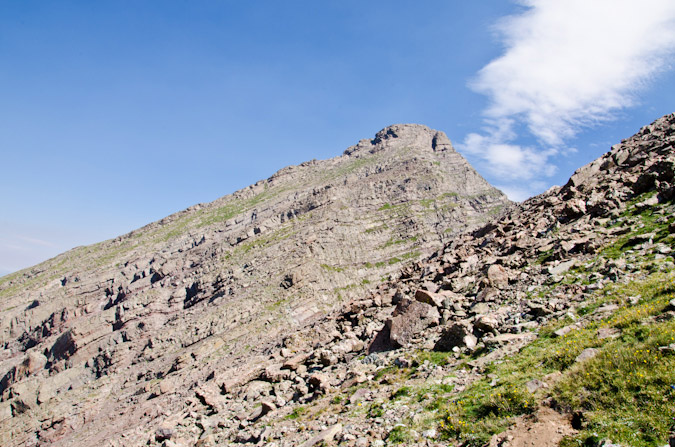
We finally reached the summit of UN 13,580 and enjoyed as what Gerry Roach describes on page 155 as "a startling view of Horn Lake." I don't disagree with Roach one bit on this detail, but what I do disagree with him on is that he describes UN 13,580 as a bi-centennial, meaning it is in the top 200 in Colorado ranked by elevation. According to my list, it is ranked 201 and just shy of that mark. When I built my database, I ranked mountains in the following order:
- By elevation
- By prominence
- By isolation
- By name
So, if two mountains had the same elevation and prominence, the mountain with more isolation is ranked higher. This seemed like the most fair way to rank mountains that had very similar characteristics. I am not sure how Roach or any others rank them.
Subsequently, according to my database, which is based almost entirely off of data compiled by John Kirk of Listsofjohn.com, Clark Peak, a 13er in the Elk Range, is also sitting at 13,580 ft. Additionally, it has the exact same prominence as UN 13,580, making them tied in most regards. The mountain with more isolation (Clark Peak) gets ranked higher.
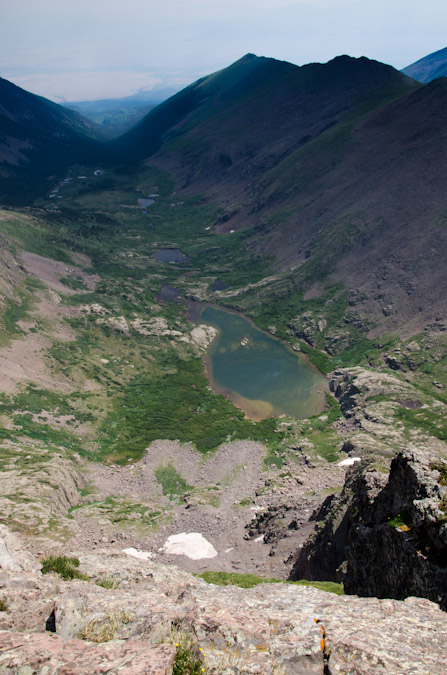
Sorry to get on that soap-box... here's a self-timer of Ethan and I on UN 13,580.
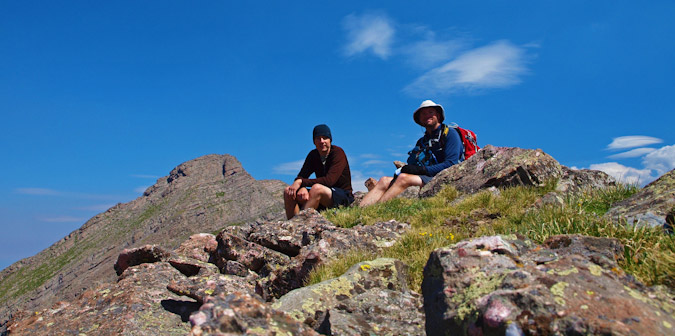
And Ethan with the Crestones in the background...
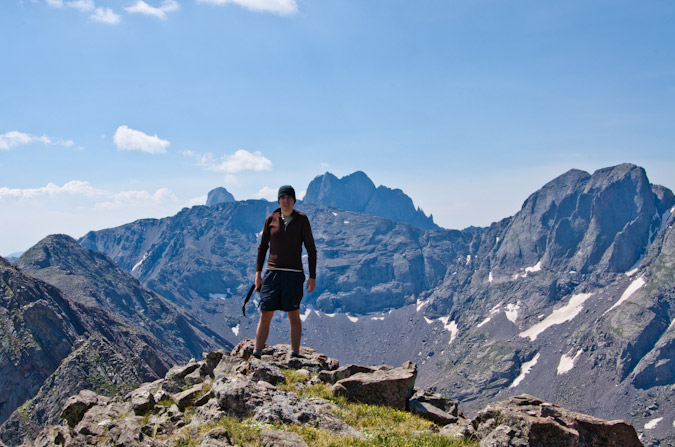
With me enjoying the "startling views."
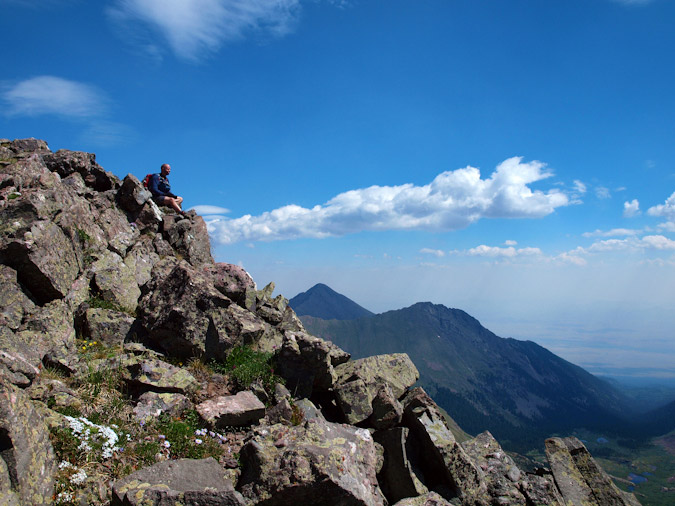
It was really cool signing the summit register for this rarely climbed peak. At the top of the register was Gerry and Jennifer Roach, followed later by John Kirk (of ListsofJohn fame), Susan Joy Paul (a regular on 14ers.com and a Facebook friend), and Doug Hatfield, another regular 14ers.com contributor who quoted on the summit register, "100/100 in Custer County," meaning, this was the last ranked peak in this county that he needed to finish. Quite an accomplishment!
Naturally, the Crestones just kept my gaze for much of our time resting on UN 13,580, so I decided to get some more HDR shots, as well as a non-HDR shot.
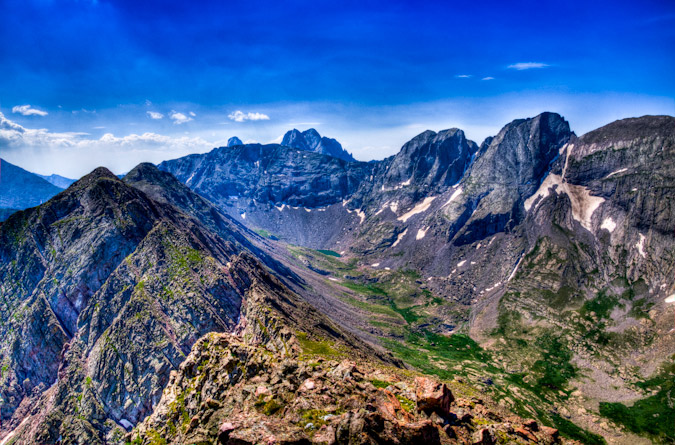
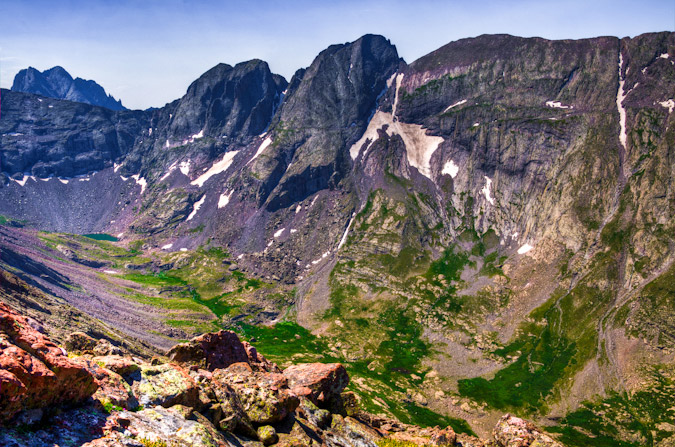
We decided to keep going along the ridge to see where it would take us. Much to our surprise, a lone goat crested the ridge to greet us below to the south.
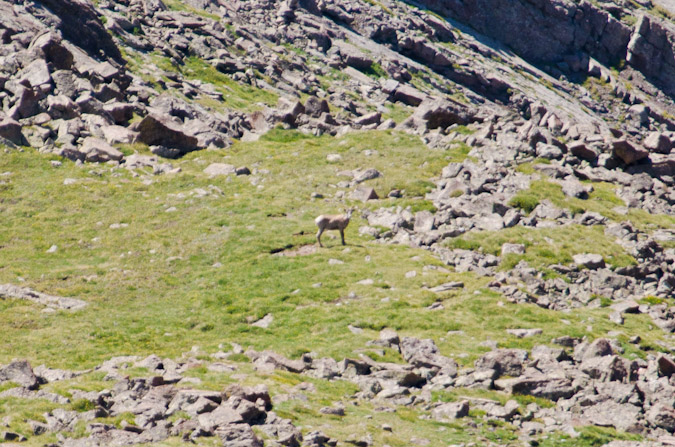
"We're gonna climb that one now?"
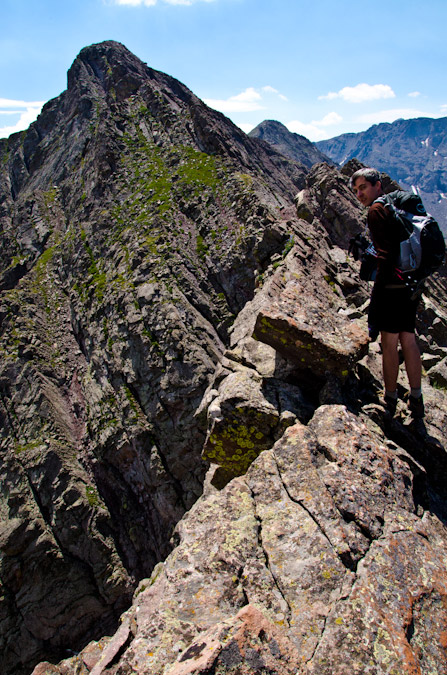
Unfortunately, the storm clouds starting building to the west, so we opted to bail at the first opportunity. Since there's no trails in this terrain, we had to do some heavy route-finding. This ended up being quite enjoyable and challenging, and afforded us with plenty of class 4 down-climbing opportunities.
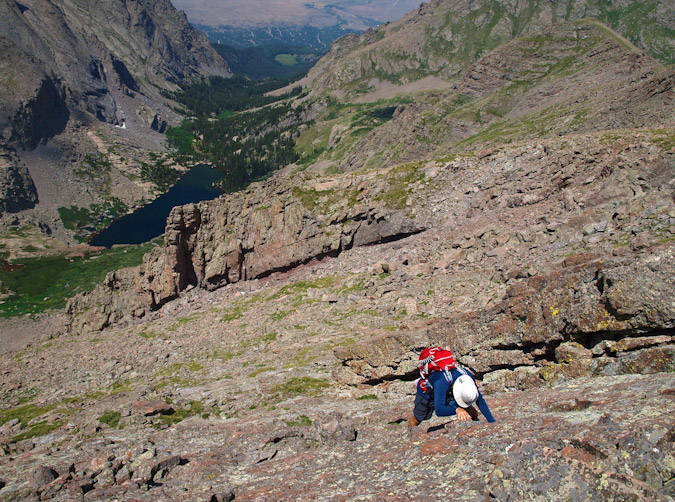
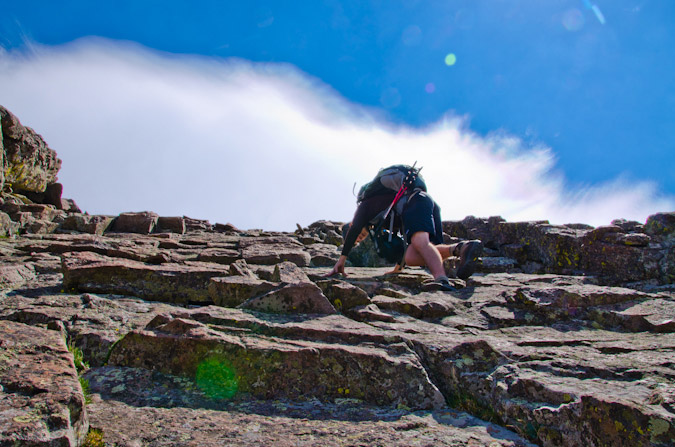
We found a crazy gully just below the first set of slabs we had down-climbed, and decided that the terrain on the other side of this mini-ridge below the gully looked much better as an exit. Unfortunately, the gully was loose and chossy, with eroded garbage and hardened mud. It was a real nightmare to downclimb. I went first, and faced-in for many sections. I kicked down tons of loose debris and tested every hold. It was quite a mess. Once I was down, I yelled up to Ethan that I was clear. Ethan had a bit more trouble, mostly because he was schlepping his trekking poles on his pack still (I opted to not bring any), and his camera bag was not of the LowePro Toploader variety that I have grown to love. His bag got into his way and he had to stop and re-pack the whole thing into his main pack. Almost down, Ethan had a few more moves left. He faced in and placed all of his weight on his feet, which were being held by what appeared to be a very solid and large boulder. Ethan shifted his weight to another rock, and as he did, the rock he was just standing on crumbled and disintegrated, causing huge blocks to go down the rest of the gully and down the mountain. Ethan was quite lucky. Here's some views of the nasty gully:
|
|
|
After the lame gully, we were greeted by a series of steep ledges that had interesting holds, probably rated at class 3 or 4.
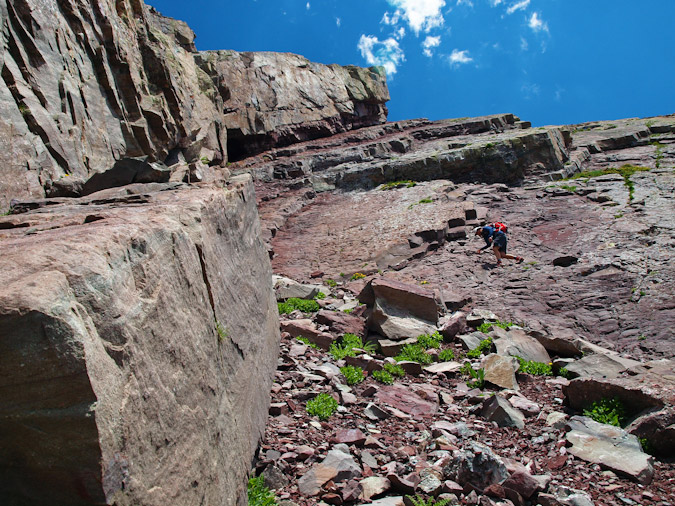
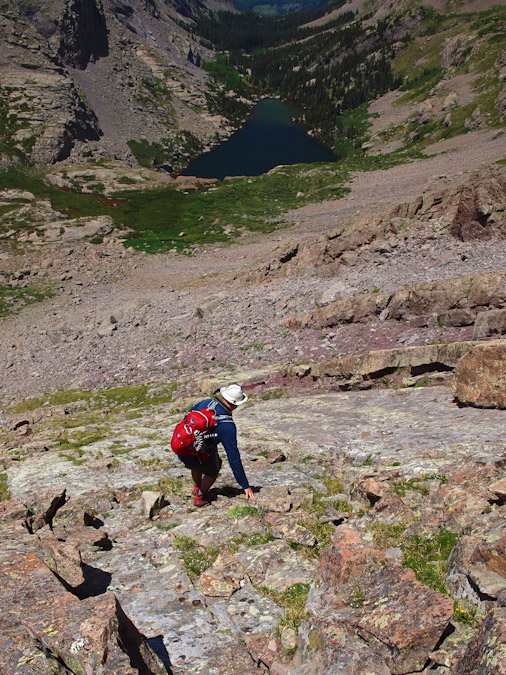
A look back up the ledges:
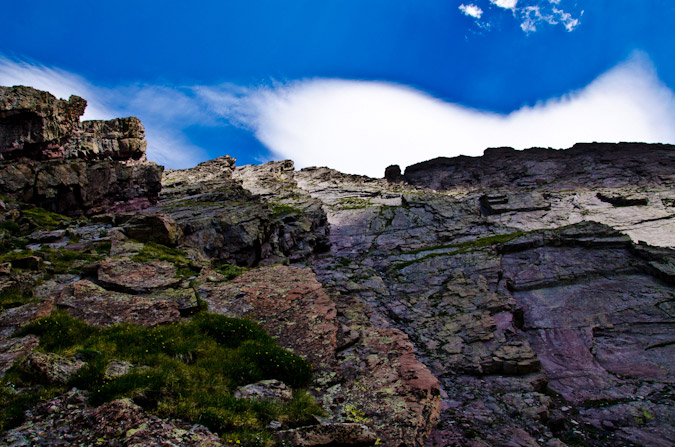
And over to Kit Carson and Challenger...
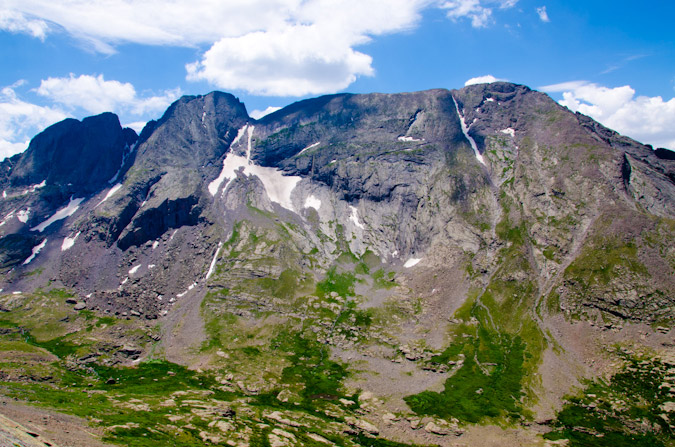
We descended this section pretty quickly, having to shift directions a few times due to the bands of ledges terminating a few times. I rested a few minutes at the base of the boulder field we came down and found a new friend.
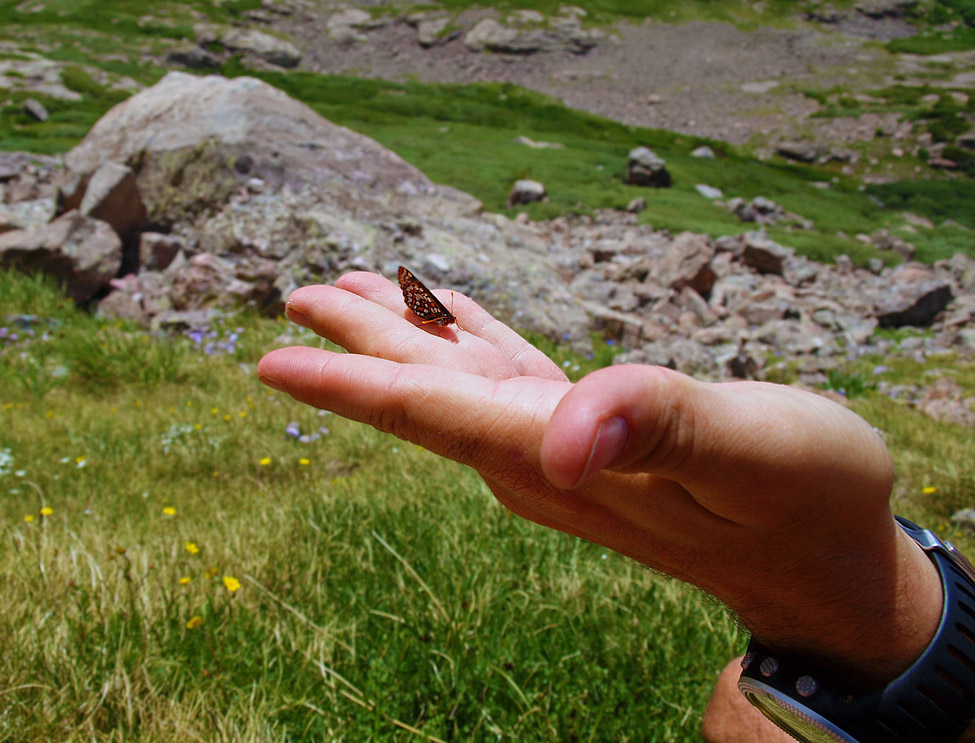
The columbine flowers were really nice too!
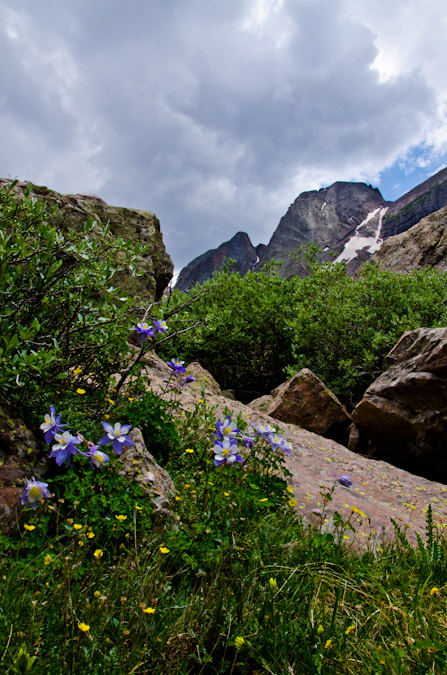
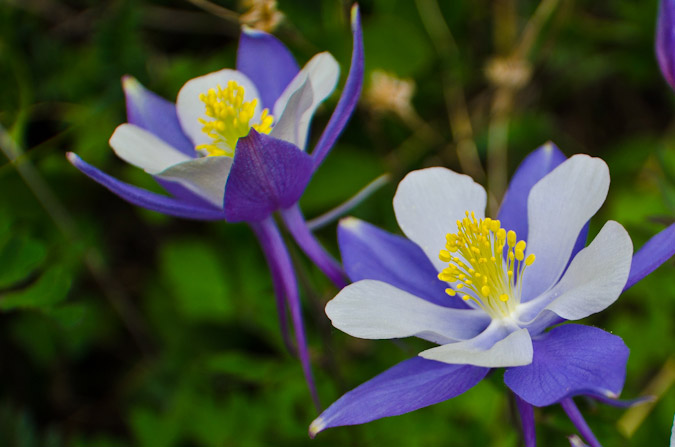
Another look back up the insanity we down-climbed...
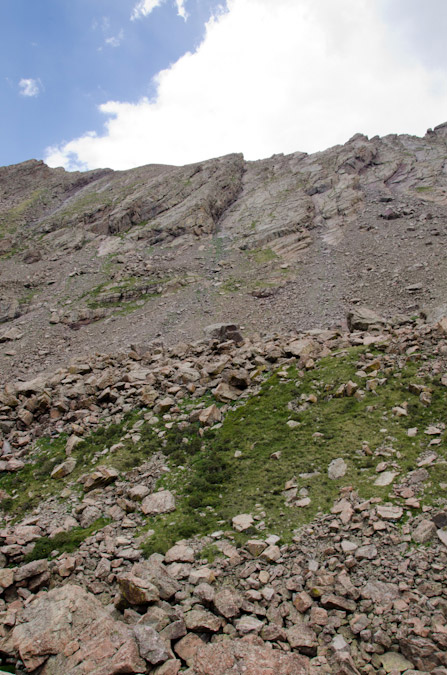
We re-joined the trail that leads up to Challenger Point and headed towards the waterfalls above Willow Lake.
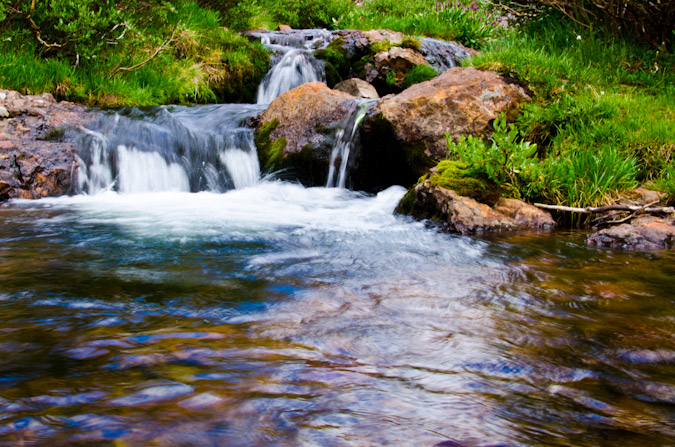
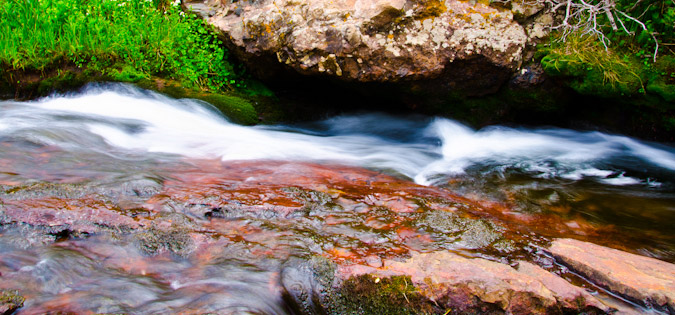
Which were quite amazing!

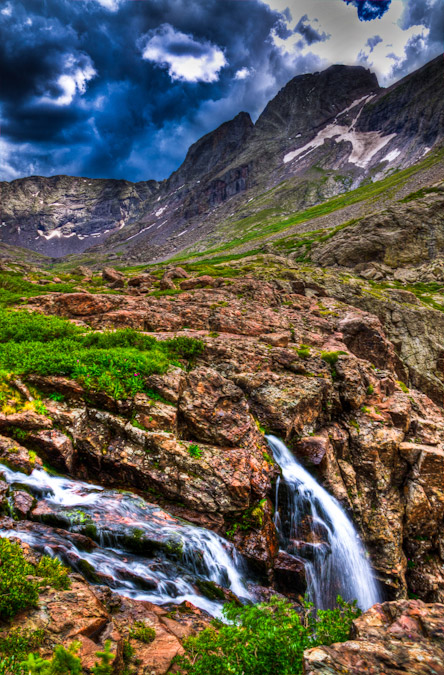
Finally, we made it back around and to the lake in short order.
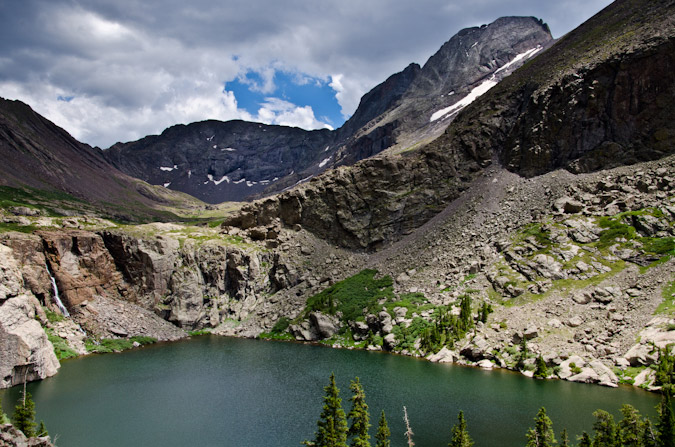
When I was here in 2009, I took a panoramic photo series from the lake, which included the waterfall and a really interesting rock in the lake. I always regretted that photo because it cut the top off of Challenger Point. Not this time!

Also, we stopped below the lake to get some amazing shots of the lower waterfall near the trail.
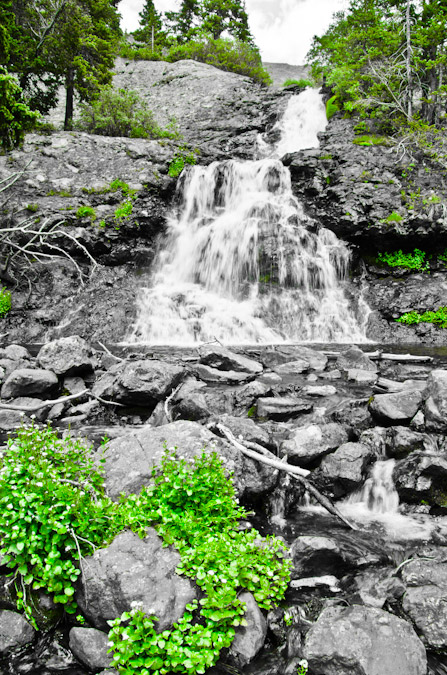
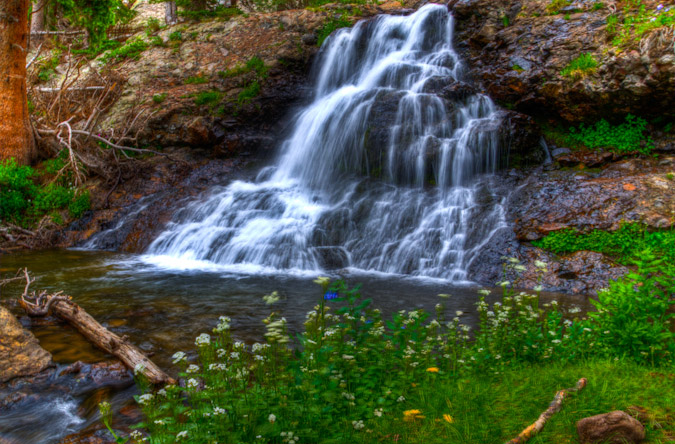
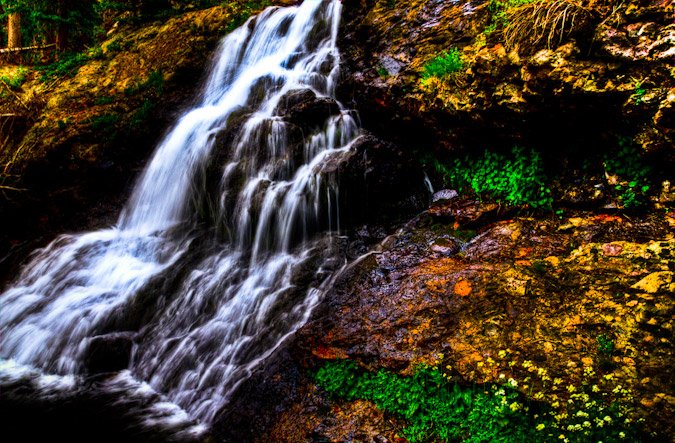
The hike out was pretty uneventful after the waterfalls, except of course for the insane amount of switchbacks on the lower trail. We made it back to the car at 4 PM on the nose, just 14 hours after we started...
|
|
|
Here's a look at the map, showing our route and elevation profile. Feel free to click on each to see larger versions.
As always, if you liked this report, please feel free to follow 100summits on Twitter or Facebook! Also, if you're planning on doing any online shopping and if you enjoyed the content, please help keep the site going by using the links on this page to help fund the site. And last but not least, if you are interested in purchasing photography from me, please take a moment to read this page for more details. Thanks for stopping by!
Sunrise from 14,015 feet: Wetterhorn Peak
The adventure of my July 4th weekend for 2011 just wouldn't end on its own. After spending the morning in Telluride sulking about our partial defeat in Navajo Basin, Regina and I decided to drive back to Colorado Springs and lick our wounds. As we drove closer and closer to Blue Mesa Reservoir, I got a wild idea in my brain. Since both Regina and I still had three days off for climbing, I figured that it would be a total shame to waste that time off and gas money on only one climb up Wilson Peak. Even though we opted to not do El Diente and Mount Wilson, I still felt that we had more gas left in the tank, so to speak, so... I suggested to Regina that we head to Lake City and climb Wetterhorn Peak instead of driving home. At first Regina was more focused on a warm shower and a soft pillow, but it did not take long for the idea to set in and Regina enthusiastically agreed. Perhaps my tactic was not fair, since I knew that Wetterhorn Peak was Regina's favorite mountain of all time. Once Regina agreed, my mood increased dramatically and we set-off for Lake City and the Wetterhorn Peak Trailhead.
To make matters even more epic, I convinced Regina that we should start from camp at 2 AM so we could watch the sunrise from the summit. Climbing up the class 3 summit block of Wetterhorn in the dark sounded pretty fun too... We arrived at the trailhead and found a perfect campsite next to Matterhorn Creek. All night long, I had visions of a most epic sunrise over Uncompahgre Peak that looked something like this:
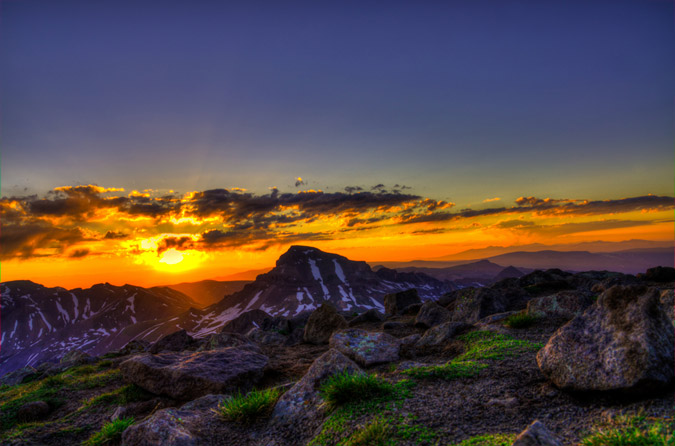
We quickly went over the game plan and Regina explained the route to me. Regina had been up this trail 3 times last year, so she knew all about it. The first time she went, she was pushed off before reaching the summit because of exhaustion. The second time, she was scared off the trail by actual mountain lions (true story), and the third time, she finally succeeded in reaching the top. She has never shut up about Wetterhorn in all of our trips together, so I figured that either she was exaggerating or that Wetterhorn was truly one of the best climbs in Colorado. 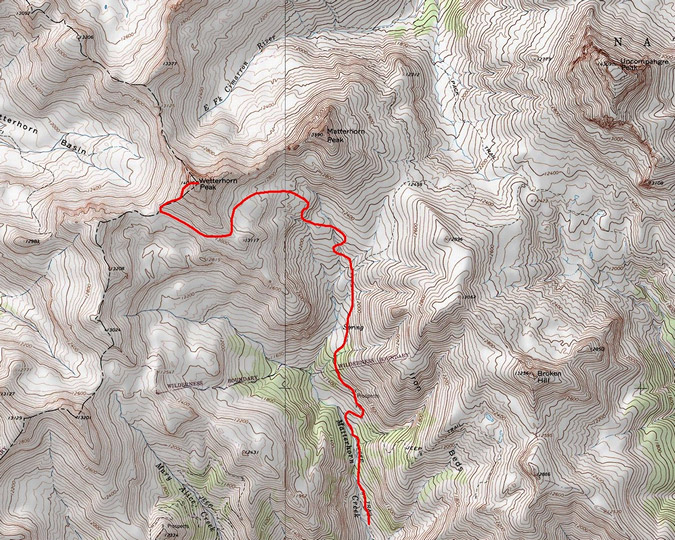
Our campsite was pretty awesome, and we were both thankful for our Mountain House meals that we had packed with us for Navajo Basin. 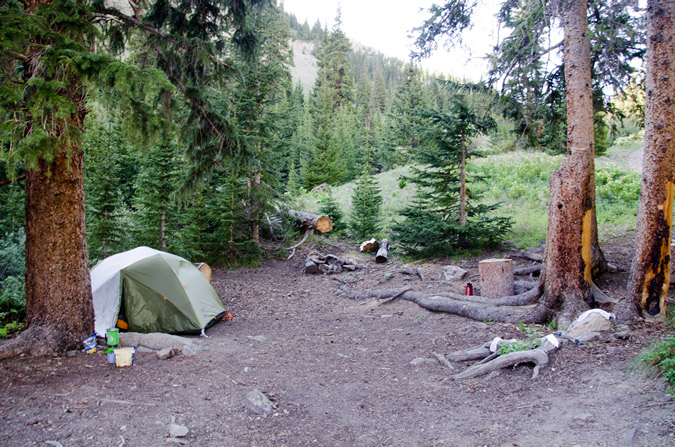
We went to bed, set the alarm for 2 AM, which arrived pretty quickly. I felt totally rested though, so we equipped our packs and opted to not pack up our tent so that we could hopefully reach the summit by sunrise. The trail was really easy to follow in the dark, but I could not help but think about the mountain lions that Regina encountered last year. Would they totally thwart our efforts? I really hoped not, and focused on the task at hand. We finally reached the area where Regina had encoutered the mountain lions last year, and wouldn't you know it, we looked down the hill to catch the gaze of three sets of eyes illuminated by our headlamps. Crap! Fortunately, we were able to realize pretty quickly that they were just deer, so we continued on up past treeline. It was not until we reached the final ridge of Wetterhorn that there as any light whatsoever in any direction, save the star light.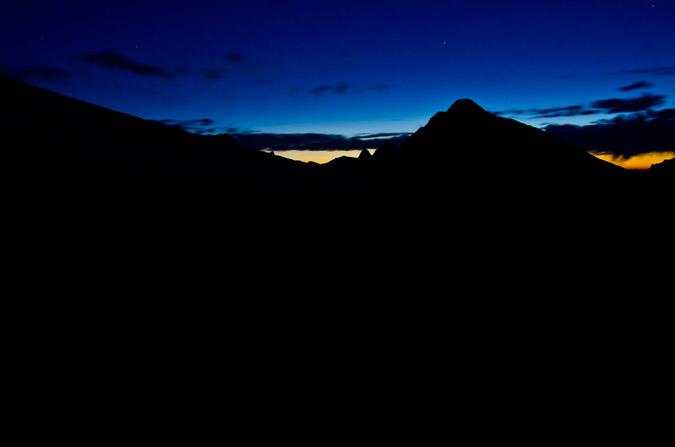
We continued on up Wetterhorn's ridge, enjoying the progressive light show that was starting to erupt to the east.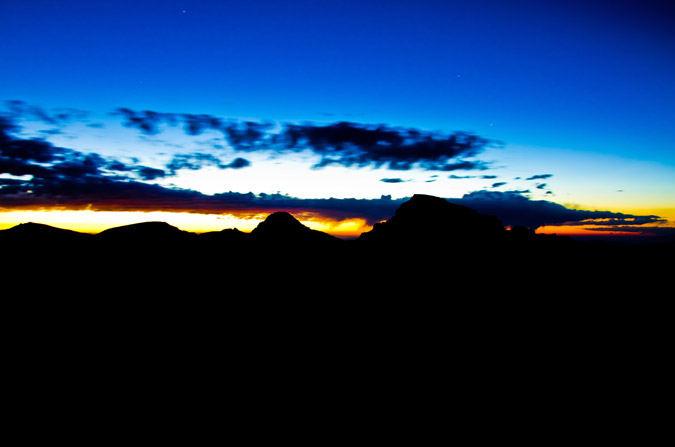
Just before we reached Wetterhorn's final section, the sun began to get closer and closer to emerging... would we make it to the top before the sunrise? I was getting nervous in anticipation.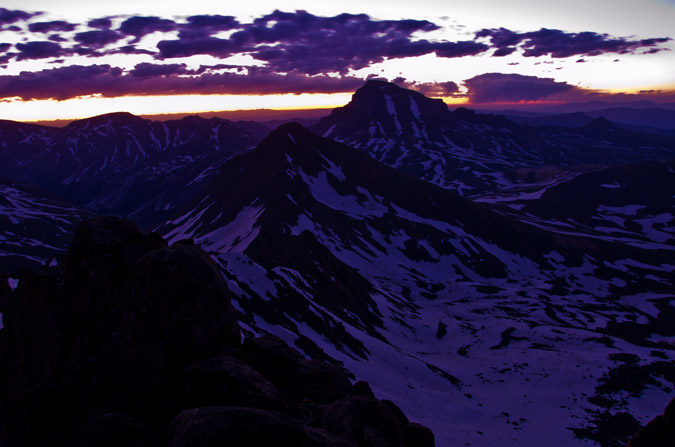
I was really having fun with my camera, firing off several bracketed shots for HDR, using rocks as a tripod and the self-timer to prevent camera shake. 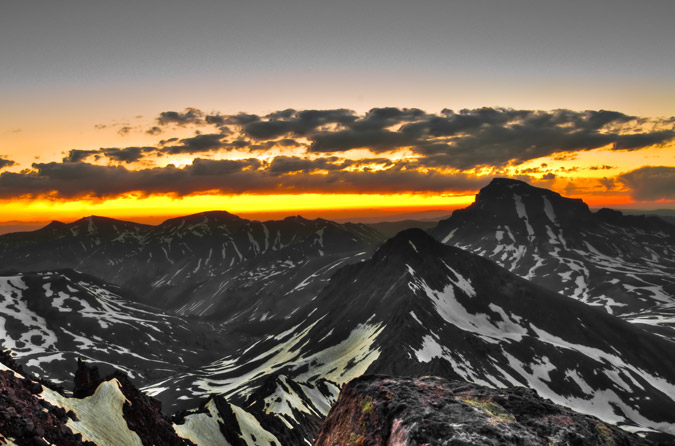
We finally reached a small snowfield that was in a small flat area before the top. The snowfield was at the base of the huge cliff walls of Wetterhorn and lead us to a notch that was a portal to the super fun Class 3 section of Wetterhorn.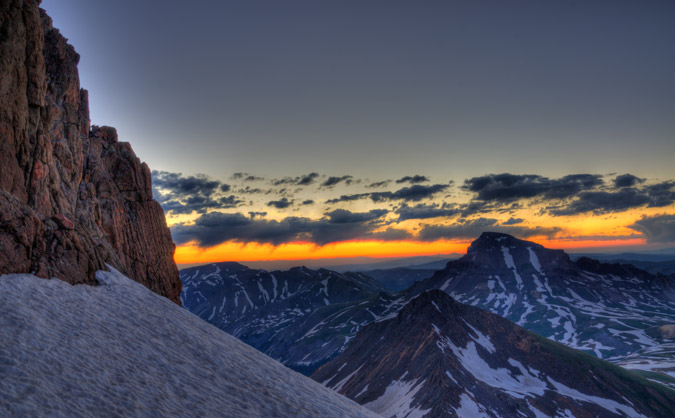
At last, we reached the final summit pitch and Regina went first. Her enthusiasm for Wetterhorn was impressive and nothing like her lack of enthusiasm two days prior on Wilson Peak.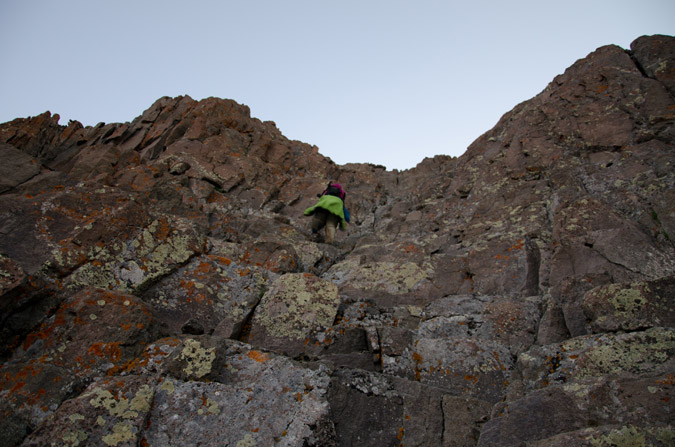
I was even able to take some video of Regina climbing up this section.
I followed Regina after she had secured herself above, and quickly made it up within a few seconds of fun climbing. We were literally about 20 seconds from the top and I told Regina that the sun would be rising in any second. I crested the summit and it was quite possibly one of the most amazing thing I've ever witnessed. The sun literally crested the horizon THE EXACT MOMENT that I crested the summit. The timing was insane. I ran as fast as I could to the other side, built a rock tripod, and began shooting. I knew that this was gold.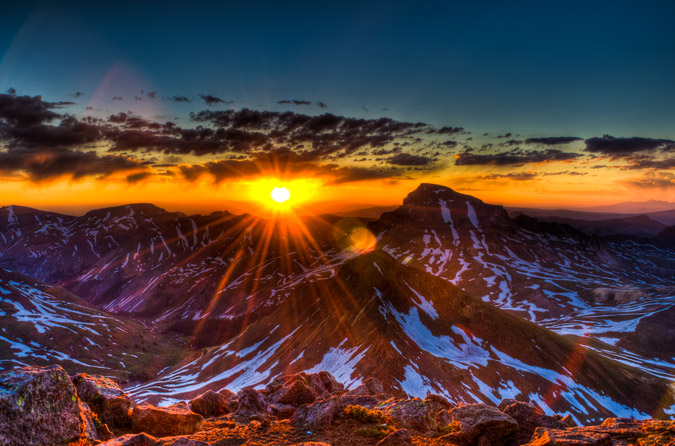
These two are HDR and almost the same except for some slightly different processing techniques.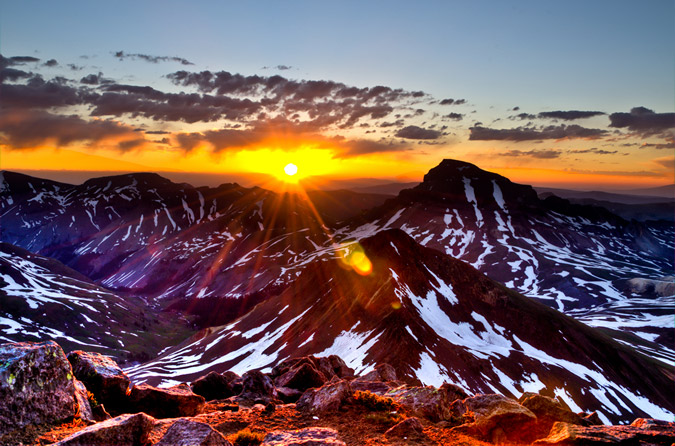
I was like a little kid on Christmas. I had no words to describe it. I didn't even realize it, but it was pretty cold up there. I think it took me a good 20 minutes to even feel it.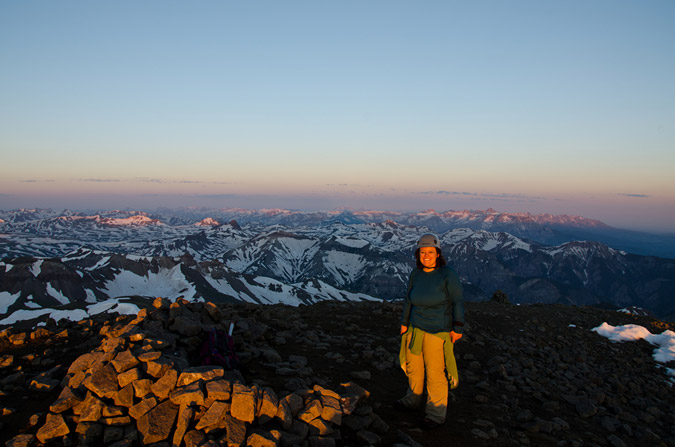
Regina was pretty excited too, being that it was the first time she had seen the sunrise from the top of the mountain.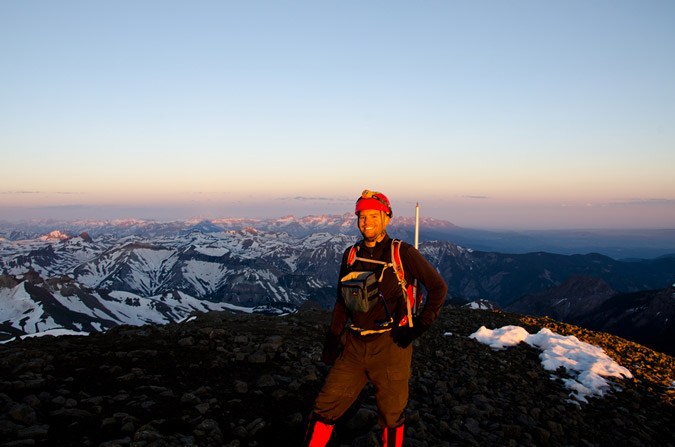
The views were simply incredible... including this 360 degree panoramic.
The lighting was perfect for High Dynamic Range (HDR). I knew that this would be the best chance I'd get in a long time to put together an HDR pano, so I gave it a shot. The results were mind-blowing. I can't wait to get one printed for my house.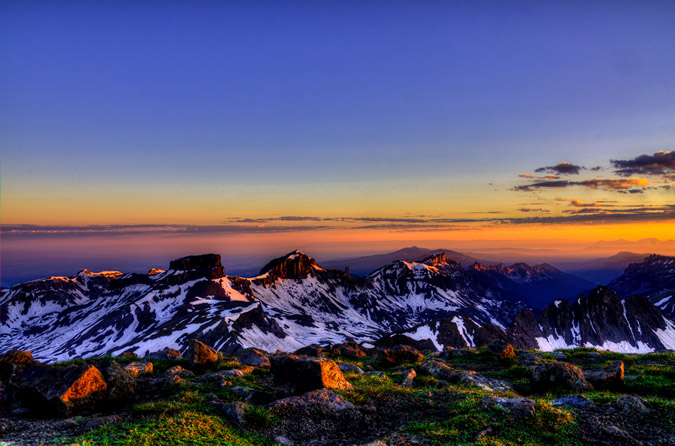
The views of Coxcomb and Redcliff were crazy!
Hey, the summit shelter even makes a good tripod in a pinch! I decided to take a few HDR shots of Sneffels and the rest of the rugged San Juan Mountains to the west.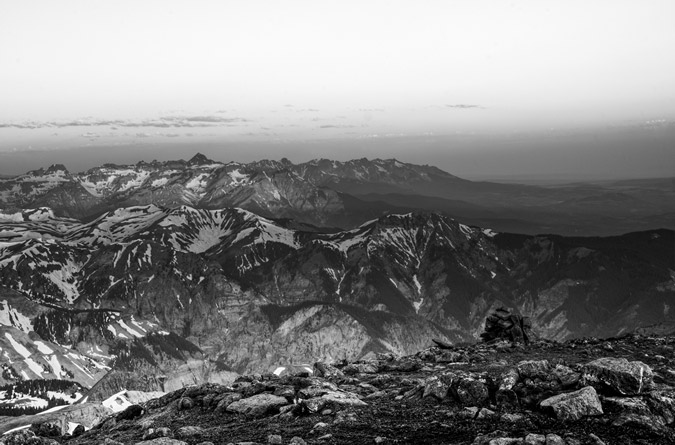
Uncompahgre Peak was truly an amazing feature to photograph from Wetterhorn.
I had always admired both Uncompahgre and Wetterhorn as a pair, especially last year from Handies Peak (Wetterhorn on the left, Uncompahgre on the right):

Is there really such a thing as too many sunrise photos?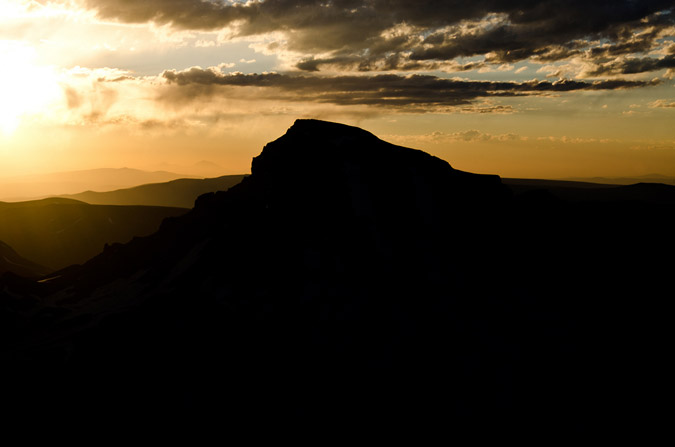
Or panoramics for that matter?

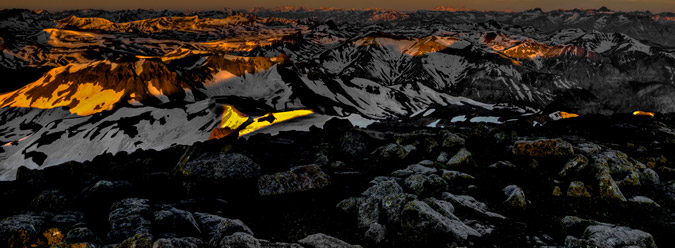
The craggy features of Redcliff to the North were quite impressive as well!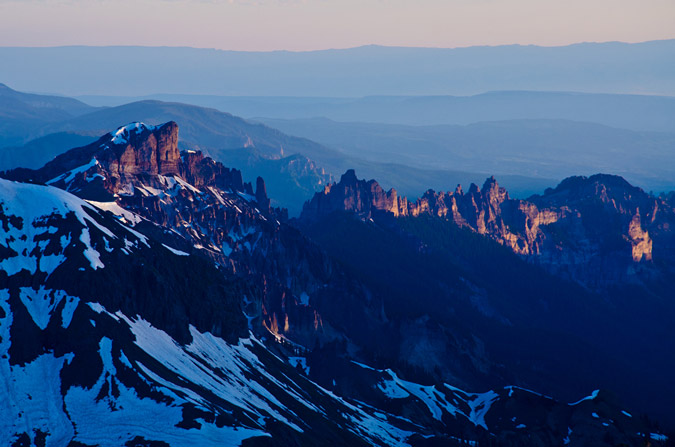
All this photography and I had almost forgotten that Regina was with me, obviously a bit chilled!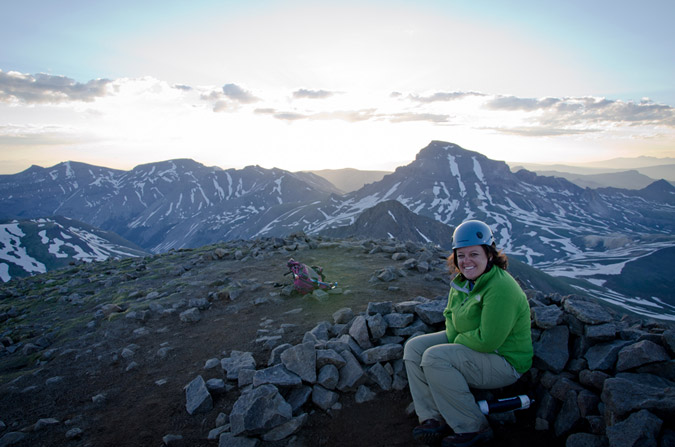

So, we decided we had enough amazing views for one morning and then departed the summit.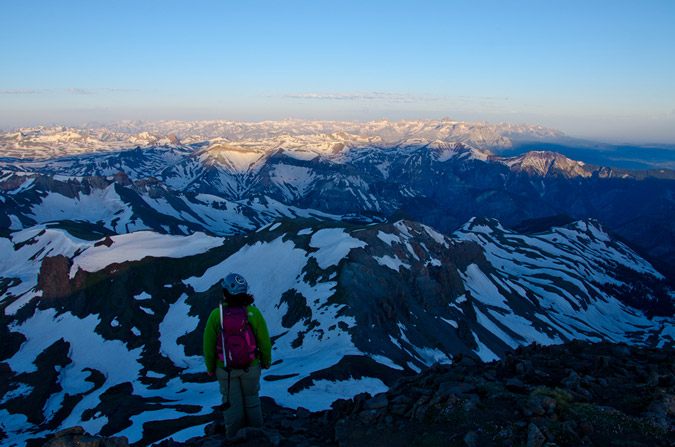
The downclimb was a little more tricky than the upclimb, but nothing worth worrying too much about. As long as you take your time and stagger your group, it is very safe.
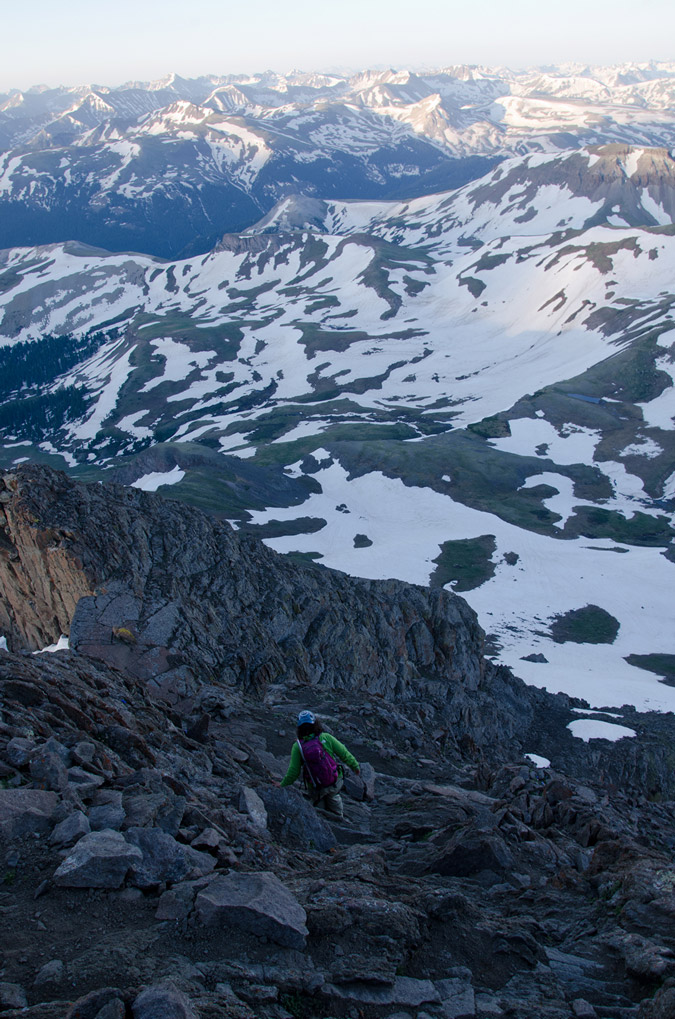 |
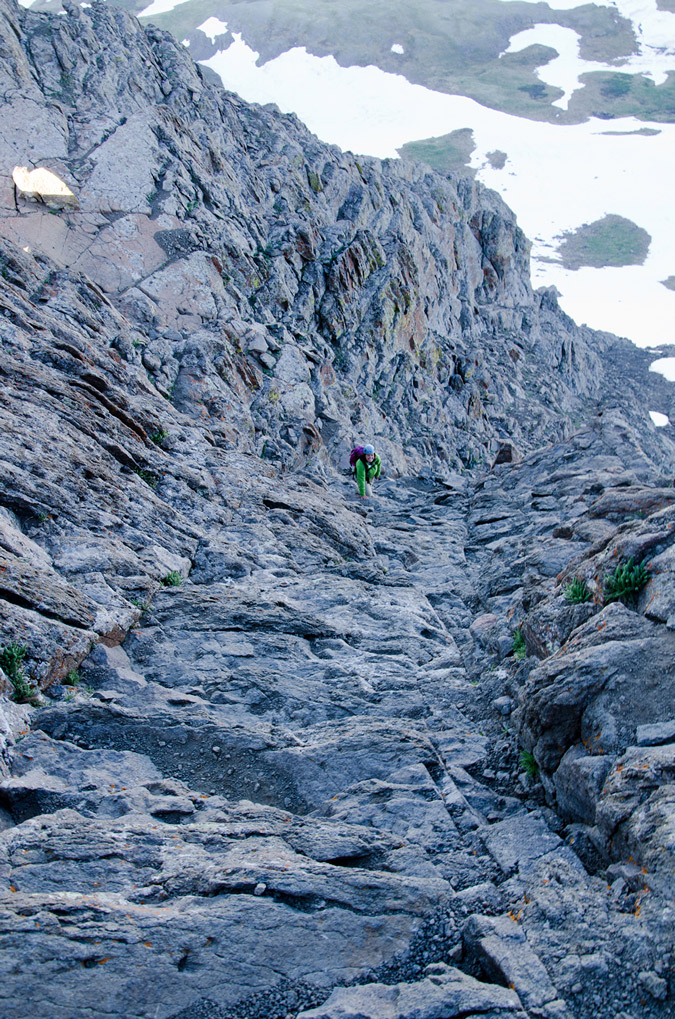 |
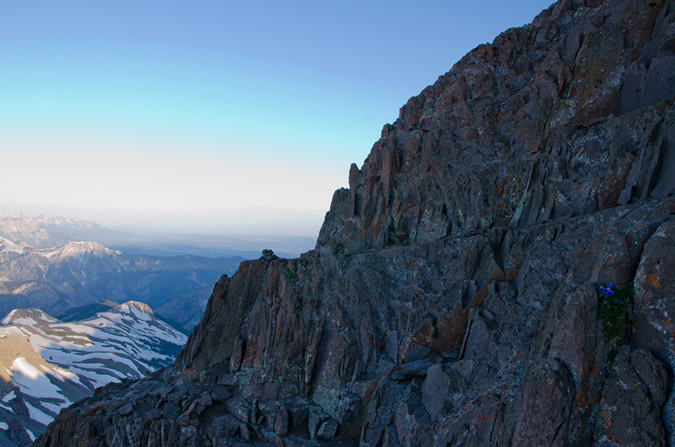
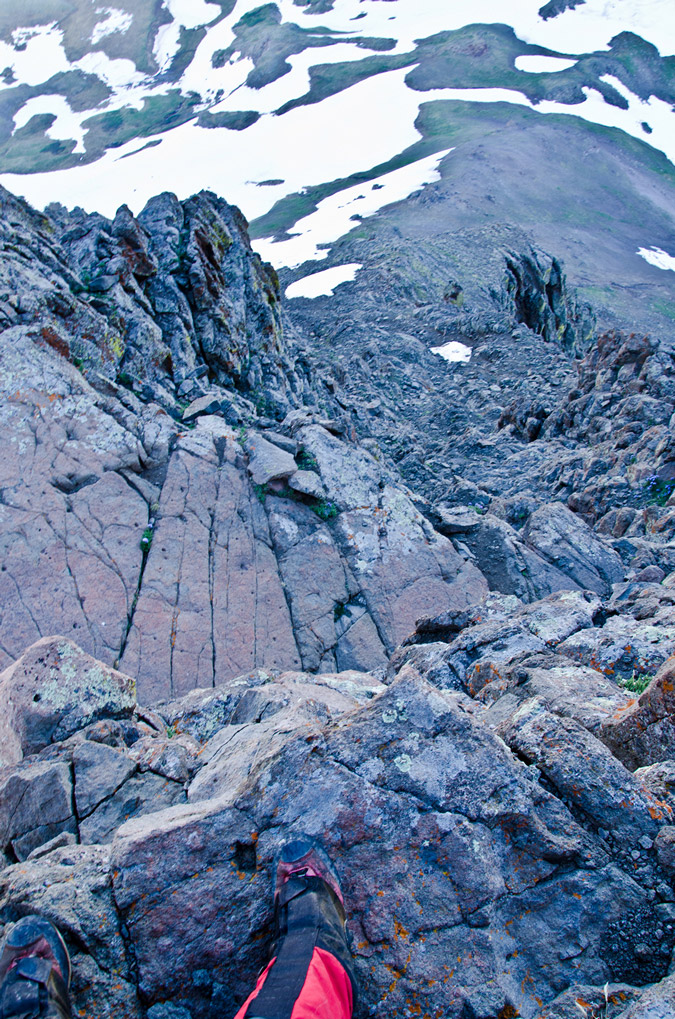 |
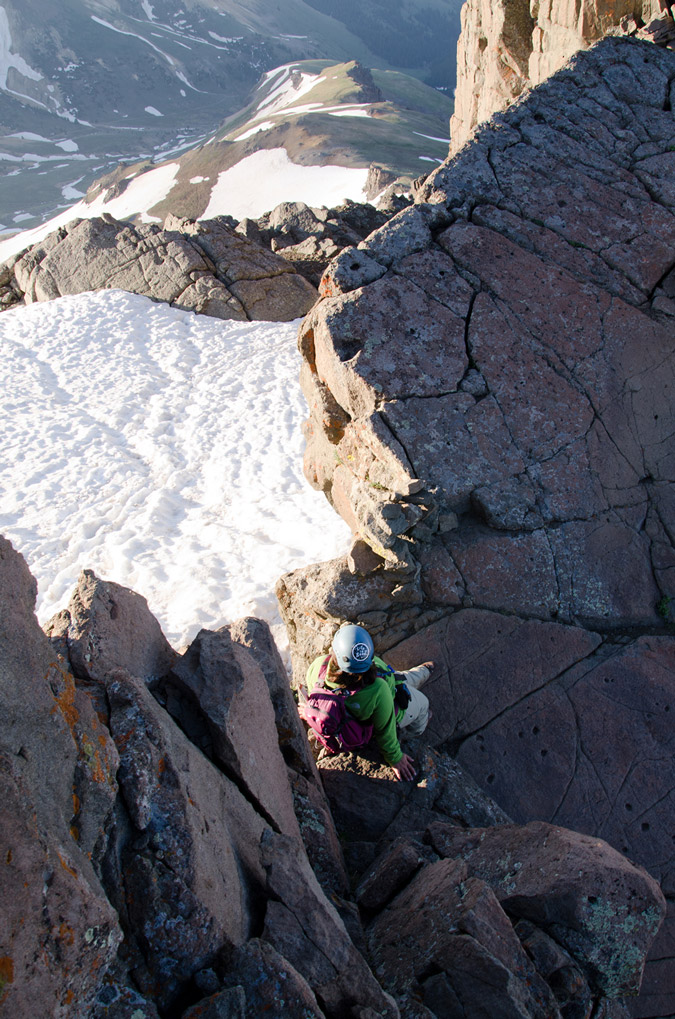 |
It never fails to amaze me what will grow on the side of a mountain...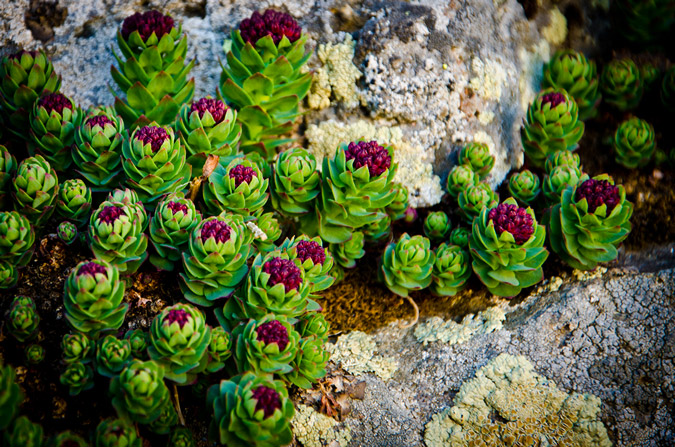
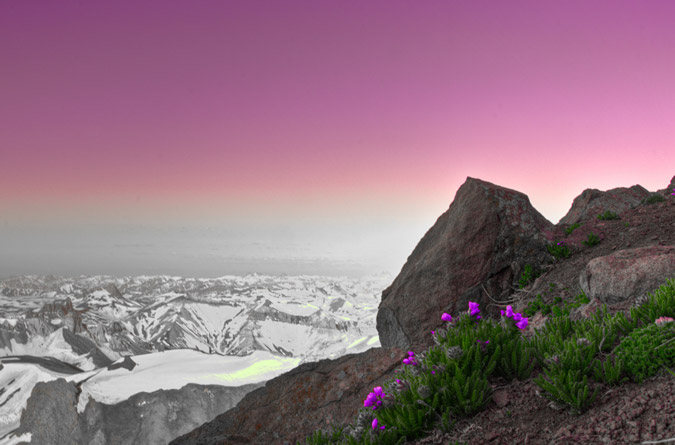
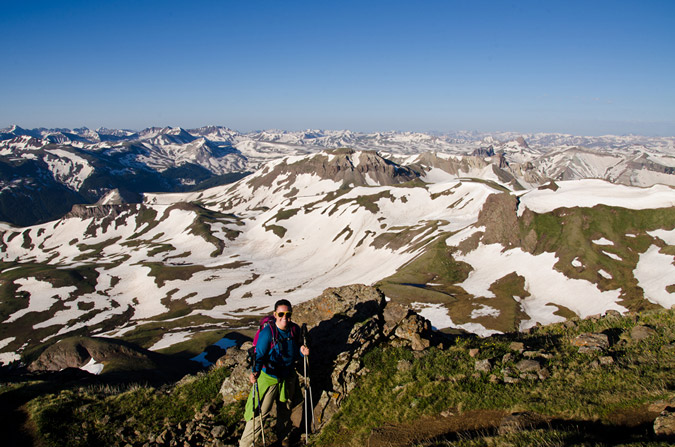
Naturally, Uncompahgre kept me in a state of wonder...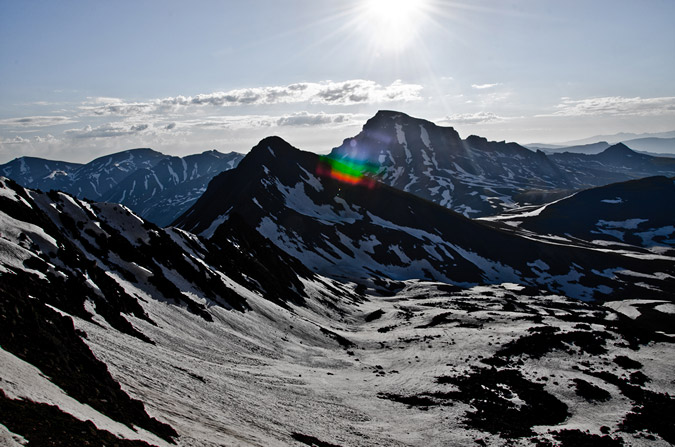
As did Sneffels...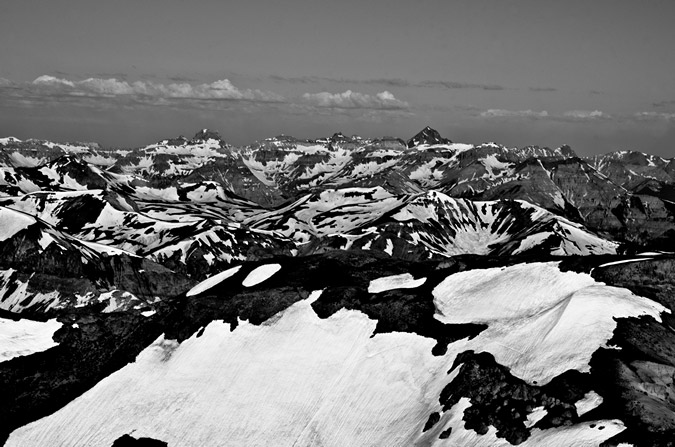
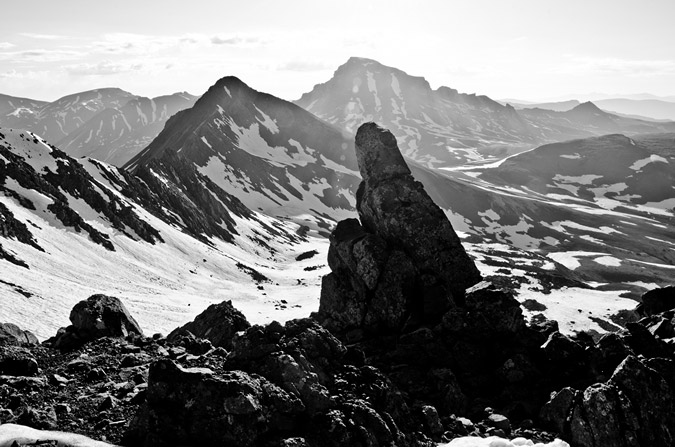
Wetterhorn was pretty awesome looking for below, which was awesome since it was completely dark when we headed up.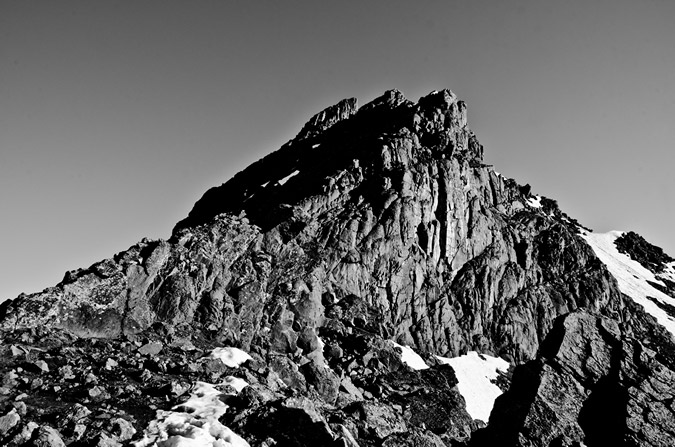
Also, a set of lower peaks kept my attention to the west, near Ouray. They were so impressive and gnarly looking! I was convinced that it could only be Bighorn Ridge, just east of Ouray. I believe I have confirmed this by looking on the Impressiveness List on my website.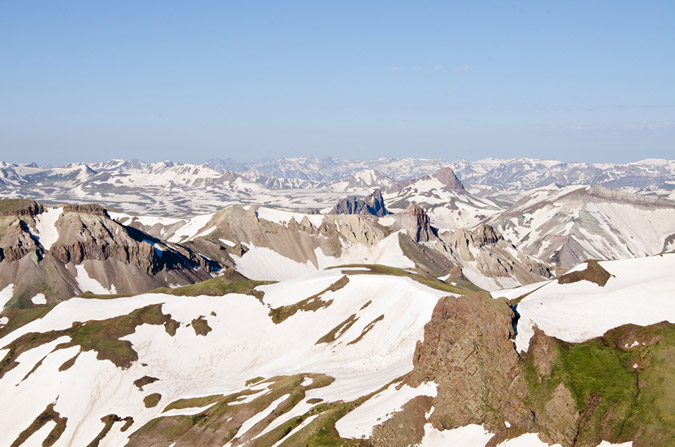
All this photography set me back from Regina quite a ways, and before I knew it, Regina had reached the Golden Saddle.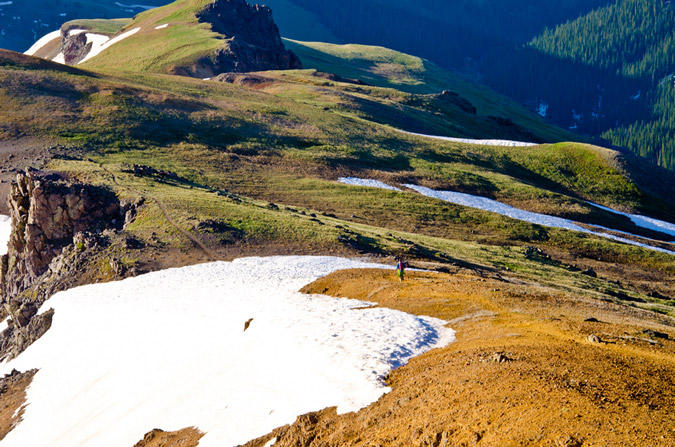
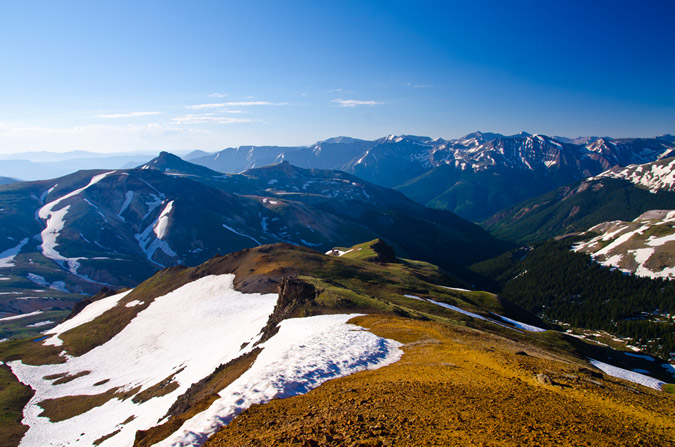
We finally ran into some early hikers just after the ridge, who turned out to be none other than "Kitten" from 14ers.com. 
Regina and I both spotted this awesome little pool below and I knew it would make for an interesting shot...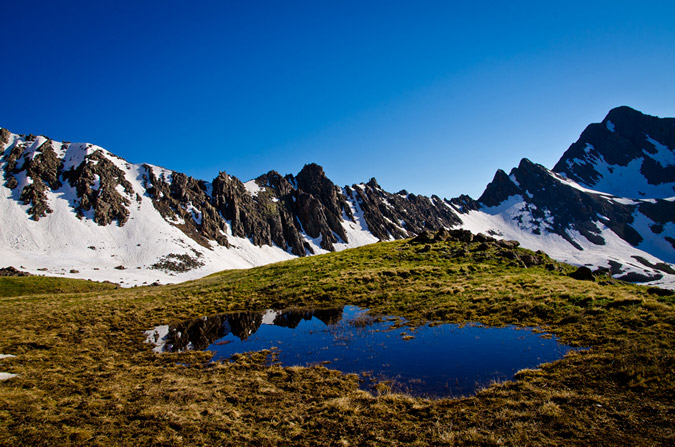
Funny thing - unknown to me at the time, "Kitten" shot a photo of me taking that photo, as I discovered it in her trip report.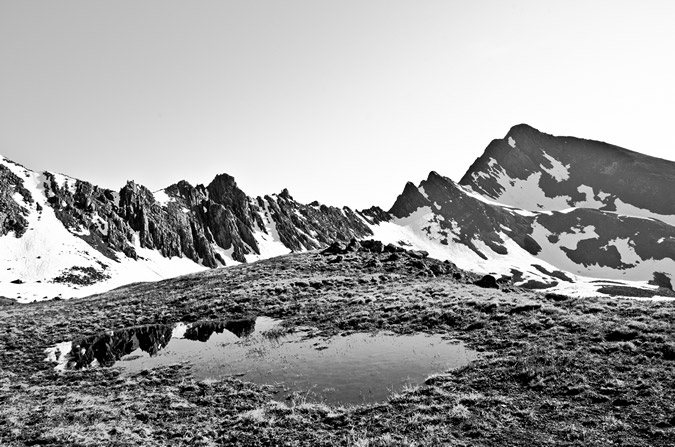
I even got a picture of Regina, and Wetterhorn, plus the pool.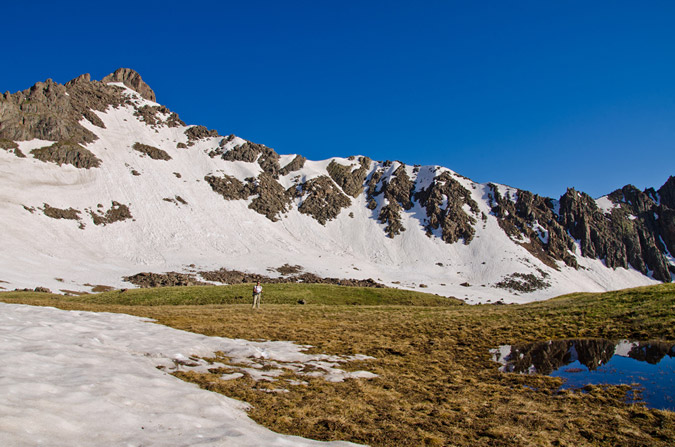
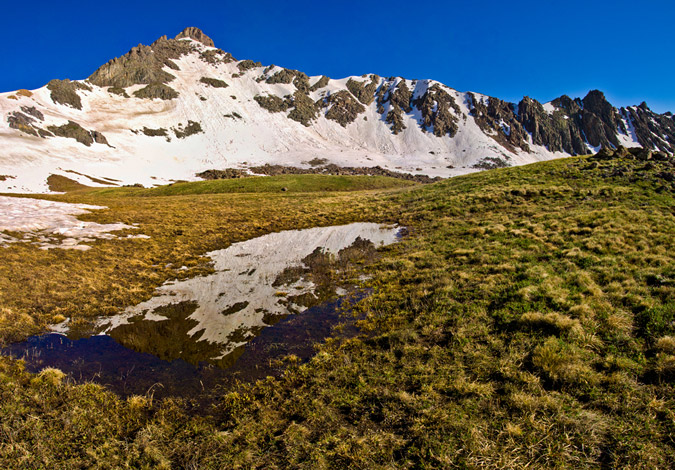
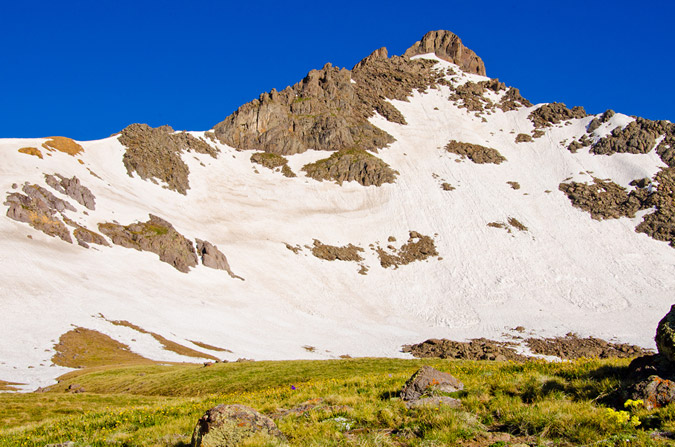
I spotted some interesting flowers off-trail and figured they might make for a cool shot with Uncompahgre behind them...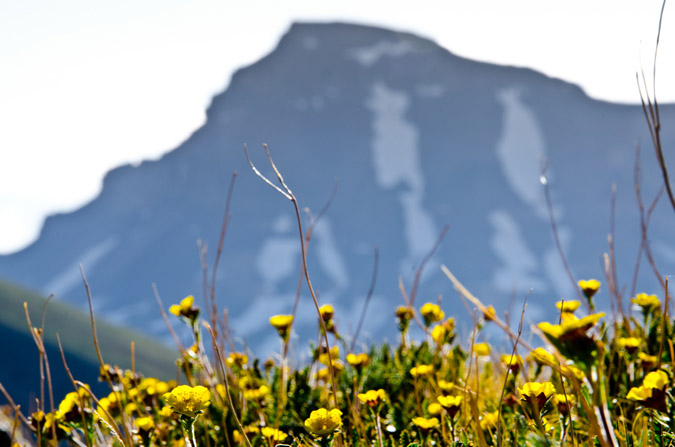
And, out of nowhere, a plane went zooming by over Wetterhorn...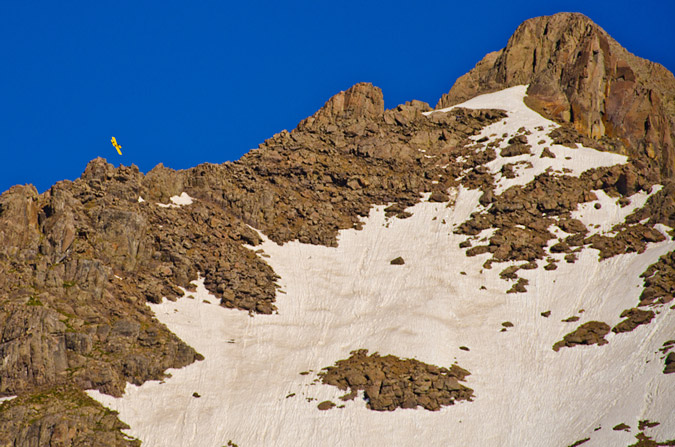
The hike out was pristine. The views never got old. Wetterhorn and Matterhorn painted such an incredible vista.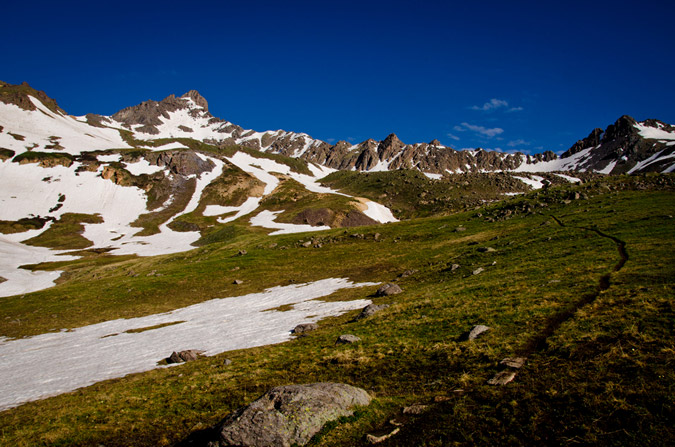
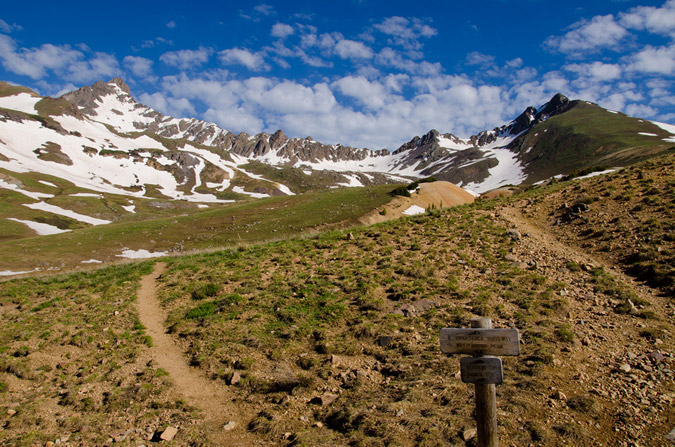
Wetterhorn looked pretty awesome from the valley below...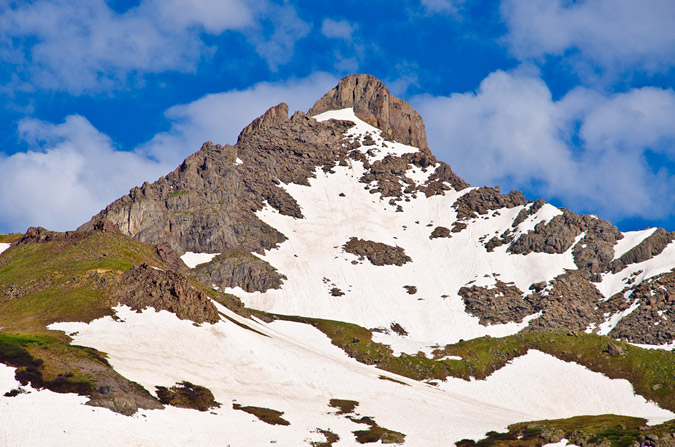
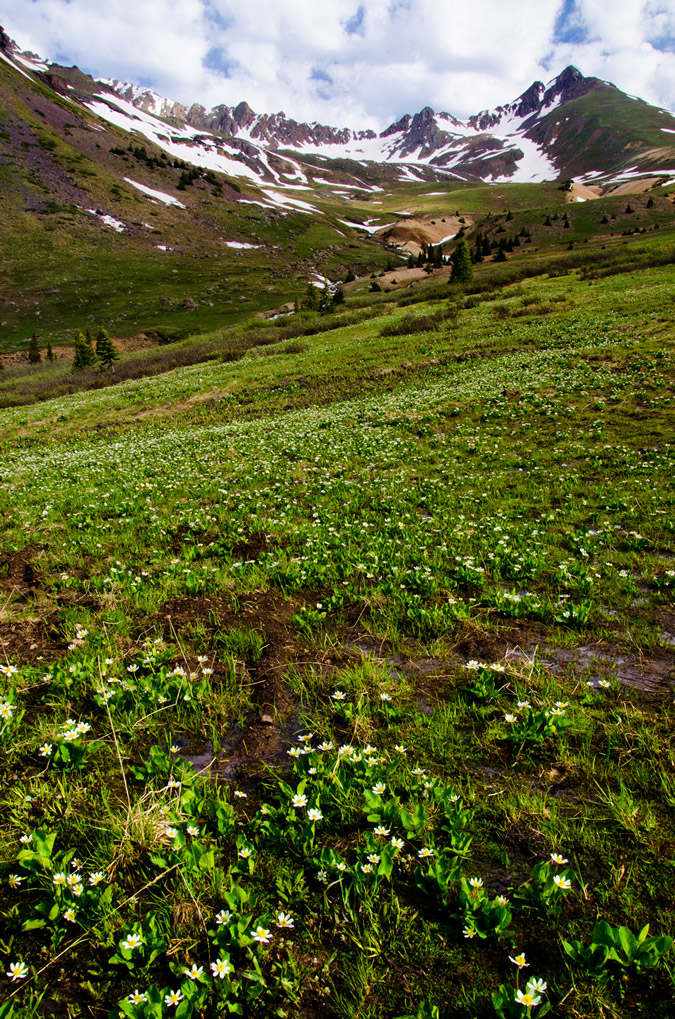
And of course, the weather started to move-in as we were heading out. The clouds were really intense, so I figured it might be fun to take some HDR shots of them.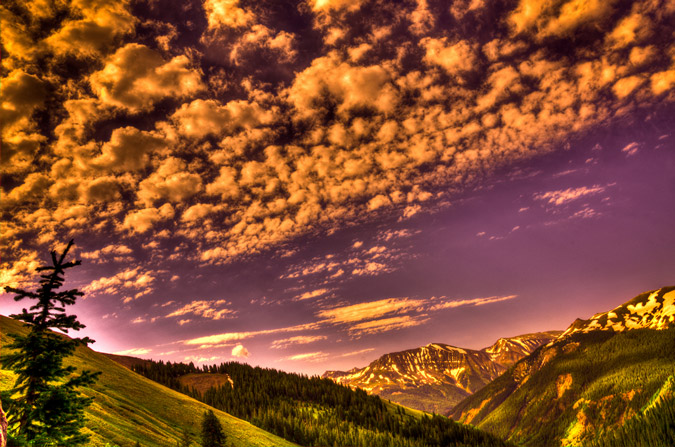
In case you were wondering, at the first trail junction, seen below... you go right. I barely noticed this one on the way up since Regina has this mountain memorized.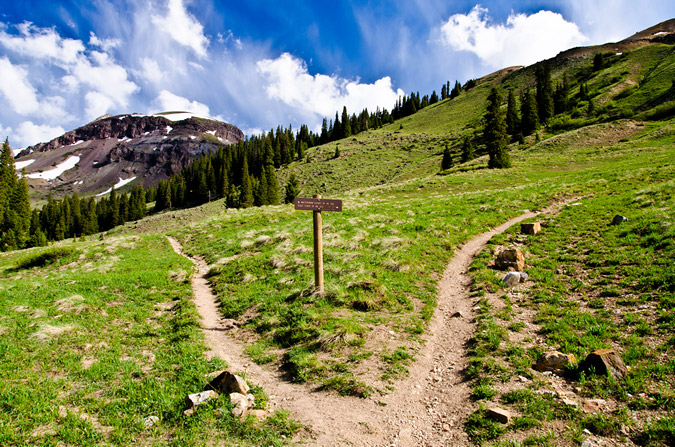
Matterhorn Creek provided some amazing opportunities for photos as well, having a ton of water in it.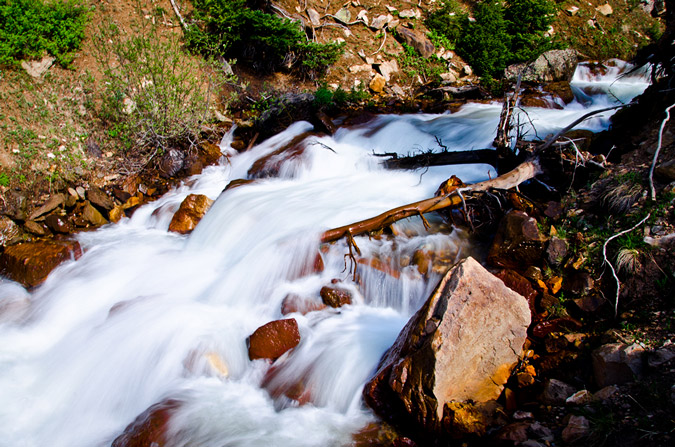
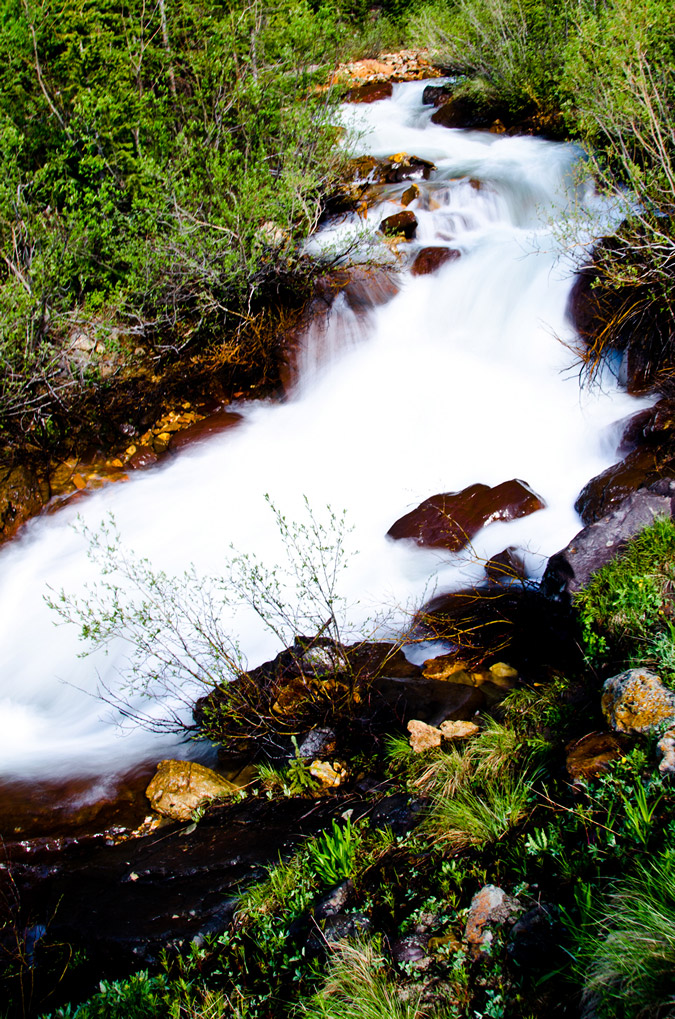
What else can be said about Wetterhorn? It is probably the perfect mountain. Here's why:
- The approach is short and easy, accesible to even the most novice of hikers.
- The route is solid - it is a terrific introduction to Class 3.
- The views are INSANE.
The only bad thing about Wetterhorn is that it is not closer to my house! I would rate it a 10/10.
I hope you enjoyed the photos! Please contact me if you would like to purchase any. See this page for more details.
{fcomment}
Backpacking to Snowmass Lake - A Photographic Gem
When Regina and I embarked from Colorado Springs, the plan was to backpack up to Snowmass Lake and climb Snowmass Mountain, putting me within 10 climbs of completing all of the 14ers in Colorado. Unfortunately, some unforeseen circumstances prevented us from reaching the summit of Snowmass Mountain, which I will go into detail about later on. Fortunately, there was ample opportunity for photography, and that opportunity was not passed on.
For those that follow my trip reports, Regina is a friend of mine that I met through 14ers.com and our relationship could best be described as one of two siblings. My wife is 100% cool with me hiking with another woman, and if another person asks me about it, I may just roll my eyes. Now that we have that out of the way, let's move on with the report! Regina and I departed Colorado Springs on Friday June 24th and reached the Snowmass Lake trailhead at around 8 PM. We were both very psyched about our first backpacking trip of the year, and had prepared for the many possible scenarios we were anticipating, including deep snow, an ice/snow climb, and wet weather. With that being said, we both packed our snowshoes, crampons and ice axes. I was also very excited to finally test out my brand new Lowepro Toploader Zoom 50 AW camera bag, as pictured below. The idea behind the bag is that it is held to your chest by this harness and makes your DSLR easily accesible. Time would tell!
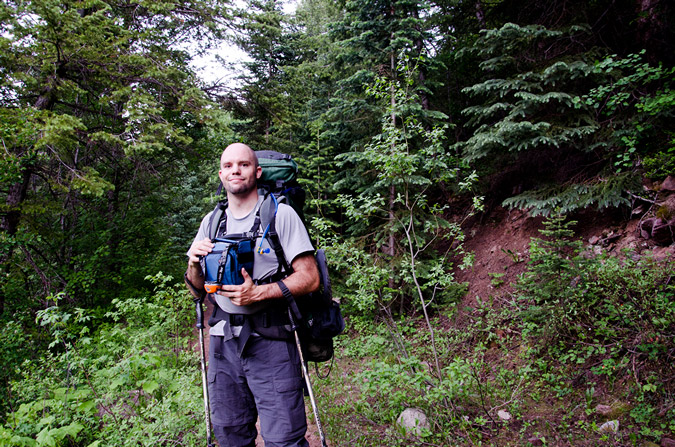
The hike up the Snowmass Lake trail (I believe it is actually referred to as the Snowmass Creek trail). takes you right into the Maroon Bells - Snowmass Wilderness Area and did not disappoint in terms of aesthetic beauty.
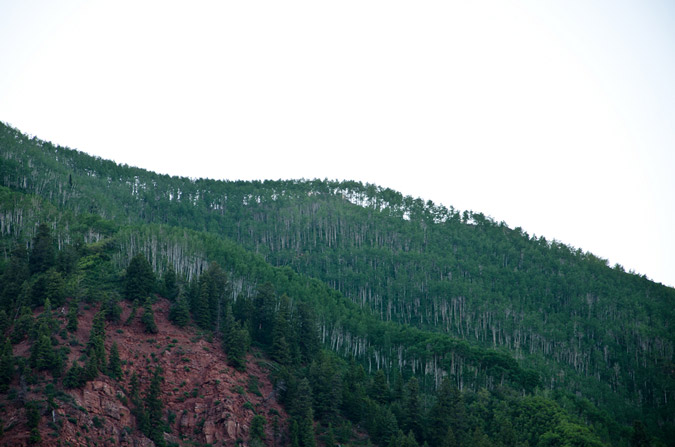
One of the things that Regina and I were concerned about was the infamous logjam crossing, where you must cross a huge stream via randomly scattered logs. This was not something we were looking forward to, given the fact that the snowmelt was particularly high this year and because we were carrying a lot of weight on our backs. About a mile into the hike, our fears of Snowmass Creek having a lot of water in it were confirmed...
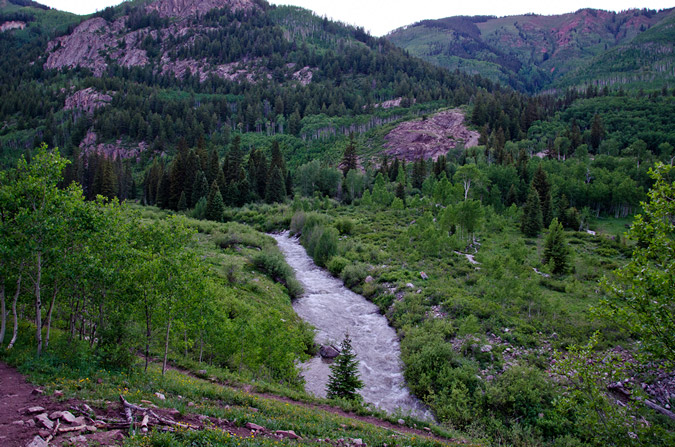
Would we be able to safely cross the logjam in the dark? The idea was quickly losing favor among the two of us; however, we kept our quick pace, which was aided by the great views of the surrounding peaks and forest.
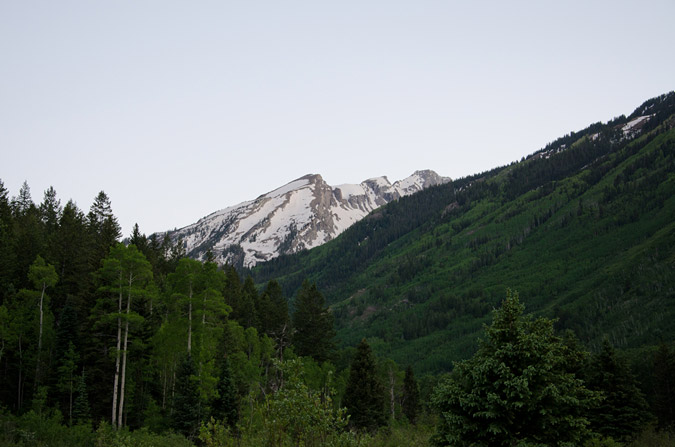
As we hiked up the trail in our heavy packs, the daylight faded quickly, and soon we were forced to employ the use of our headlamps to guide our hike.
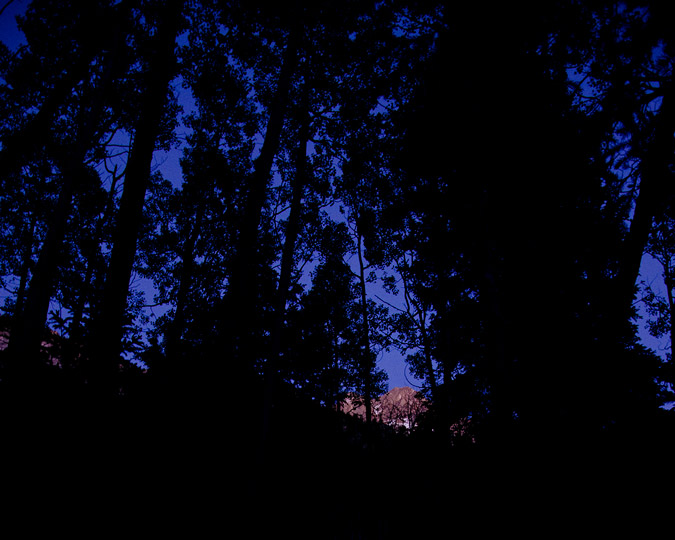
The plan was to get as far as we could in the dark before setting up camp for the night and making a go out of Snowmass Mountain the following day. From the trailhead, the lake was a good 8 miles up, which meant a good portion of our hike would be in the dark. Shortly after the sunset and the trail became dark (but before we turned on our headlamps), a dark object walked across the trail in front of Regina, which frightened us both. I quickly turned on my headlamp and discovered that it was a porcupine. We let him pass on through and continued on up the trail in the dark. Periodically, our headlamps would catch the eyes of various wildlife in the dark shadows of the night. For the most part, we identified them as deer, but given we were in the wild and it was dark, our imaginations were going in a much different direction!
After a short while, Regina began to get sick and threw up all over the trail (sorry about that to the folks that came up the next morning). Surely this would not be a portent for things to come? Regina said she felt much better, so we kept on heading up the trail in the dark. As midnight approached, we decided to stop and see where we were at. I pulled out my GPS and discovered that we were about 1/8 of a mile from the logjam - a perfect stopping spot for the night. We decided to set-up camp in one of the better campsites I've seen on any backpacking trip, right next to Snowmass Creek. Since this was her first backpacking trip, I showed Regina how to hang our food bags by nylon rope and how to setup camp.
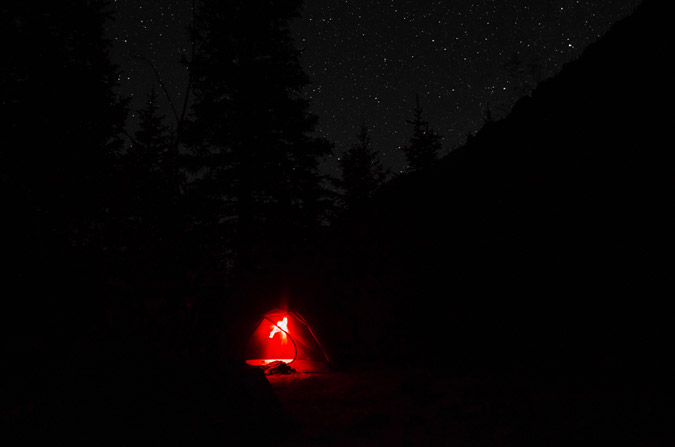
Since it was so late and because Snowmass would require crampons on hard snow, we decided the best plan would be to get plenty of rest, pack the rest of the way up to Snowmass Lake the next day, take it easy, and go to bed early for a super-early ascent of Snowmass Mountain on Sunday. We woke up the next morning at around 9 AM, listening to a group that had just came down from Snowmass Mountain talk about the logjam. They were making jokes about how the logs would sink and that people were almost falling in, etc. Was the logjam really that bad?
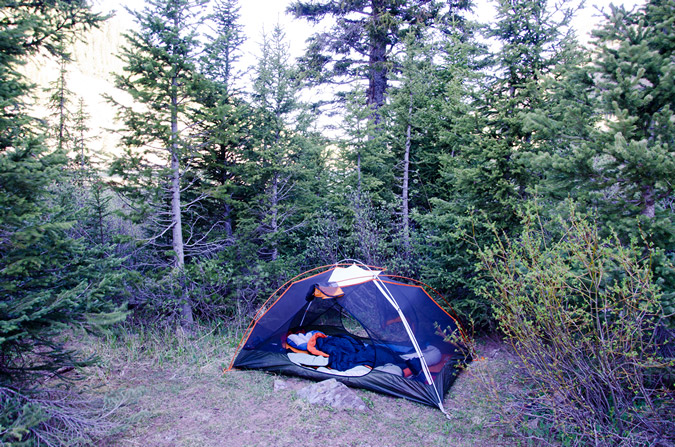
We quickly packed up and headed towards the logjam. At first sight - the logjam confirmed our worst fears - it looked incredibly daunting.
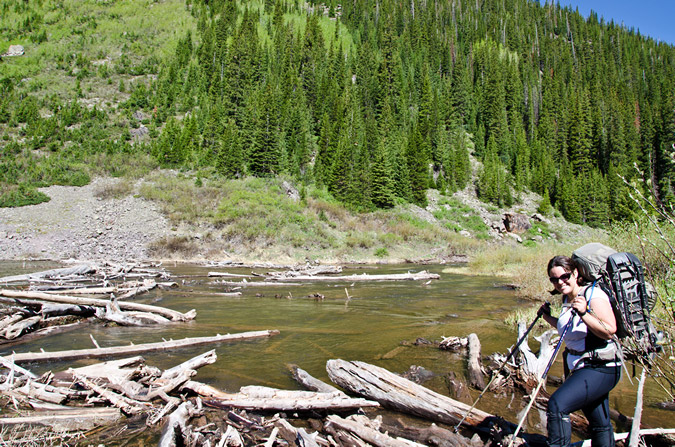
The water was about 3 or 4 feet deep in spots, and was rushing quite quickly under the logs. If the views were not so incredible, the logjam would have been a real bummer!

There was little to no consistency in the reliability of each log, and each log required a good test before we used it. Trekking poles were quite useful, but at times they gave me a false sense of security because I would put some of my weight on them when they were not secure on a log, causing me to get off balance. Care must be taken to successfully cross the logjam as it is a good 100 ft to the other side! I stopped halfway across to take a 180 degree panoramic photo to show the length of the crossing.

After successfully crossing the logjam, we quickly made our way up the trail, which followed the now wide and pristine Snowmass Creek. The whole area was like a giant beaver pond, with lakes and creeks intertwining with the beauty of the Elk Mountains at the head of the valley. The trail quickly begins to work uphill again and soon views of the pristine valley below can be made.
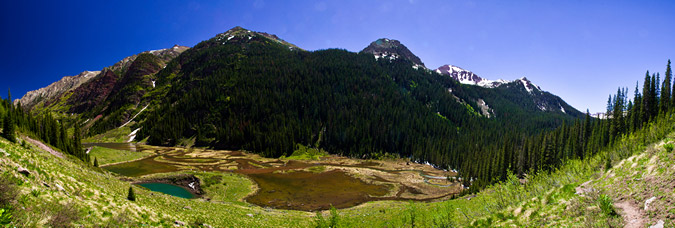
The rock in the mountainside was quite red, a clear indication that the Maroon Bells were closeby.
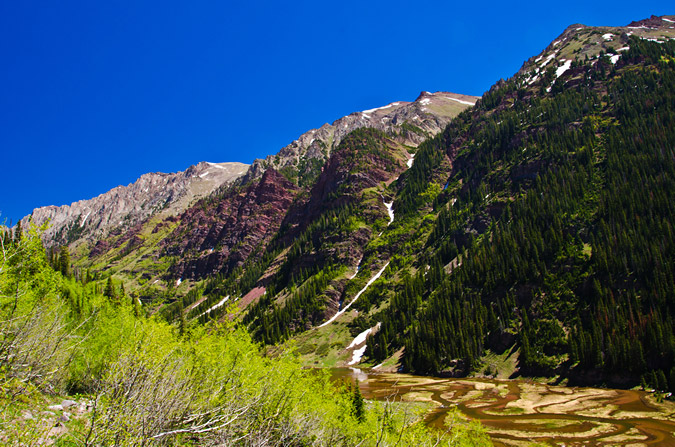
The trail quickly weaved into the trees towards Snowmass Lake above and to the east, and we were quickly reminded that there was a ton of snow in this area still. Would we finally get to use our snowshoes? Not so much - the snow as hard enough and sporadic enough that snowshoes were not required. Another trip where I packed my snowshoes for no reason! Oh well.
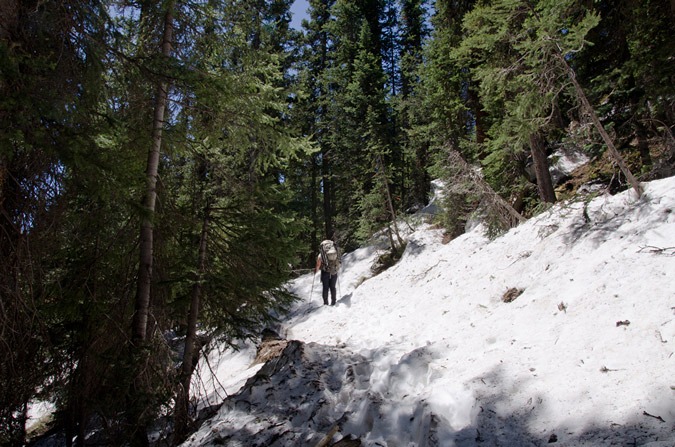
This was the hardest section of the hike, with the snow banks rising and falling throughout the trail, making travel slow and laborious with heavy packs on. Nonetheless, we arrived at the trail junction for Snowmass Lake and headed on up, following Snowmass Creek, which was quite full of water.
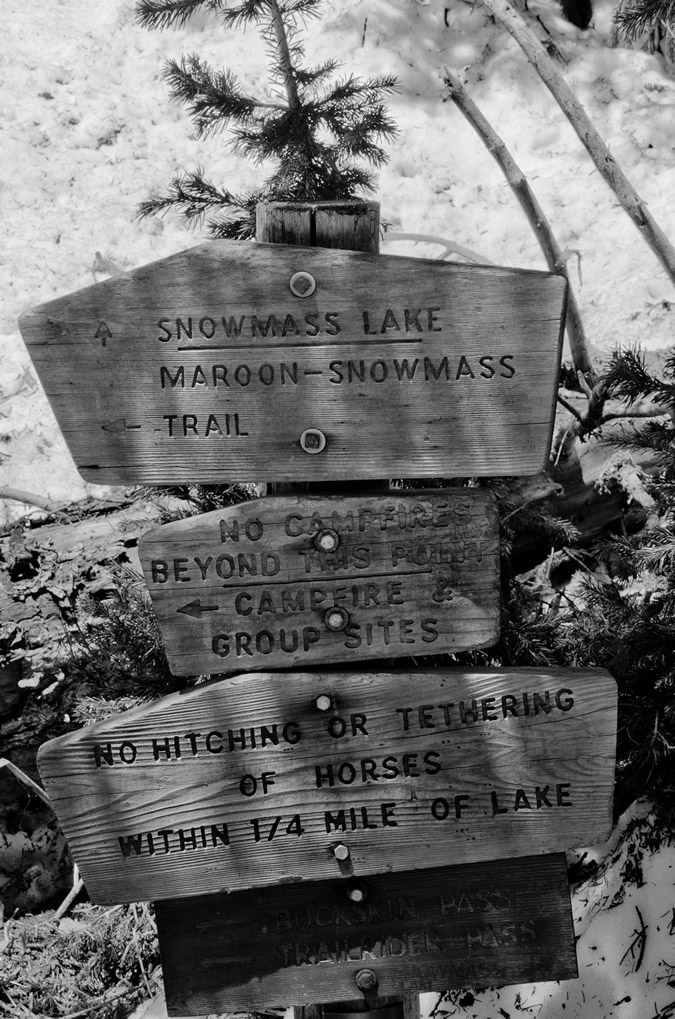
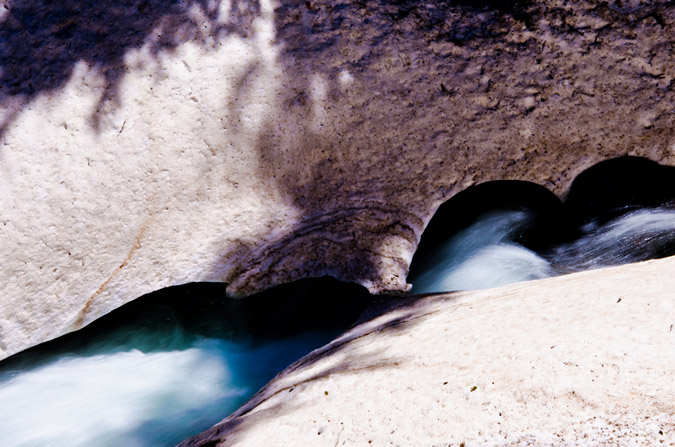
Soon, we reached a huge waterfall next to the trail, with a giant log in front of it. I decided to take a break, take my pack off, and cross onto the log to get some HDR shots of the waterfall from the middle of the log. Getting onto the log proved quite tricky, with the area around the creek full of snow and ice and dirt; however, I managed to make it onto the log without drowning or falling in. Yay for me.
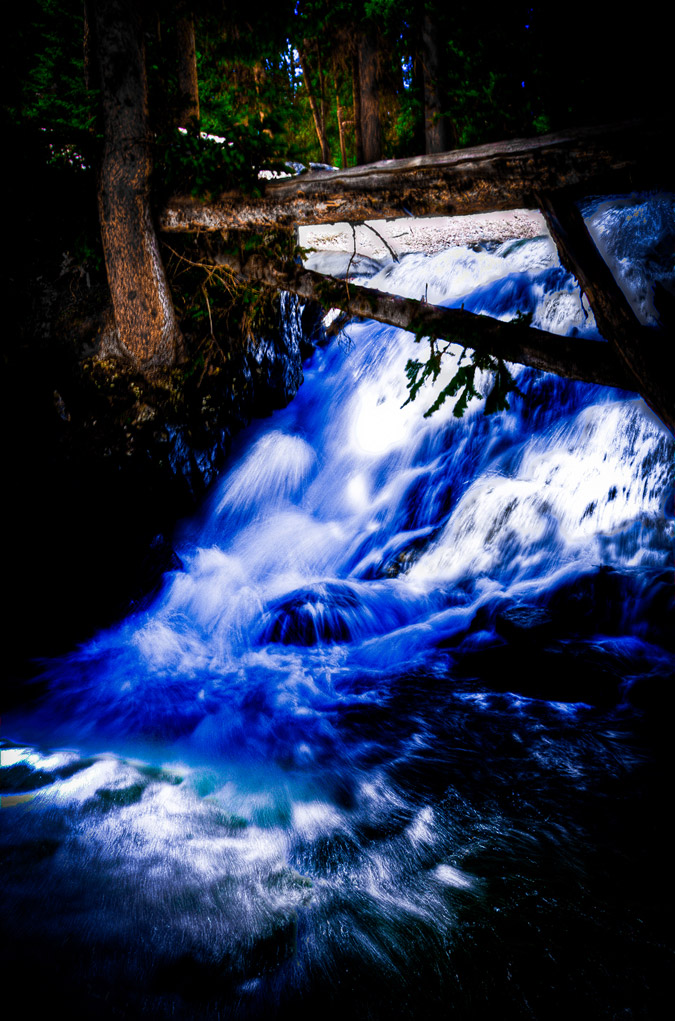
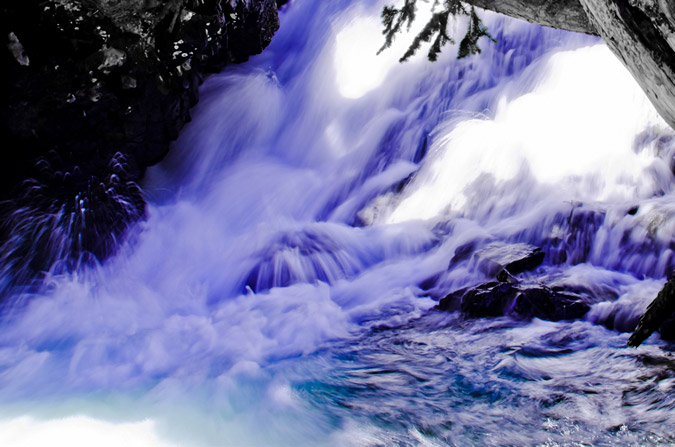
About 200 feet past this waterfall, we finally reached the head of Snowmass Creek and the first views of Snowmass Peak with Snowmass Lake in the foreground. How exciting!
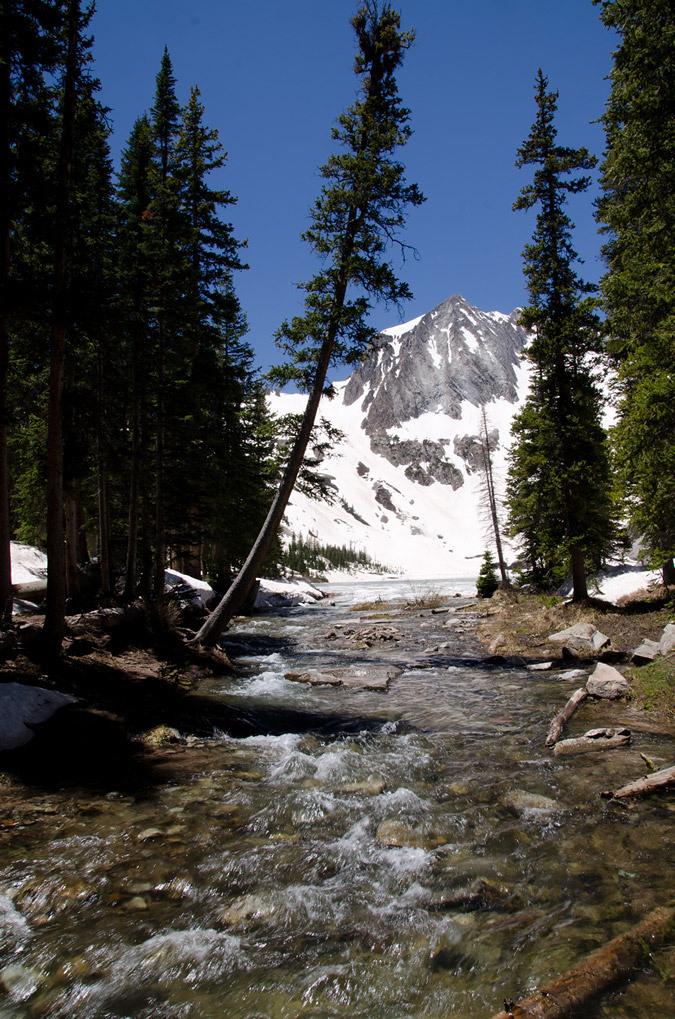
The first order of affairs was to locate a suitable campsite. Most of the area was full of deep snow, so options were quite limited. Sticking to the "100 ft away from lakes" rule proved nearly impossible due to the snow and marshy conditions. Nevertheless, we found a great spot near the lake and creek and set up for the day. It was pretty great to finally get a glimpse of Snowmass Mountain as well, which was tucked away to the right of Snowmass Peak, the lower 13er at the head of Snowmass Lake. Even better, the moon was passing just above Snowmass Mountain, making for some fun photography.
Throughout the day, the lighting shifted and the winds died down, making for better or worse photography conditions, depending on the combination of the two. For the most part, the Golden Hour proved to be the best time to shoot, which did not surprise me in the least.
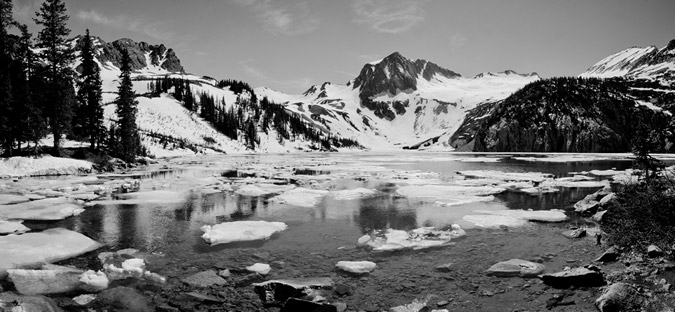
For the most part, Regina and I just kicked it at the lake for the day, watching the wildlife and the insane beauty of the lake. This also gave me the opportunity to play around with my camera and try to get some decent shots.
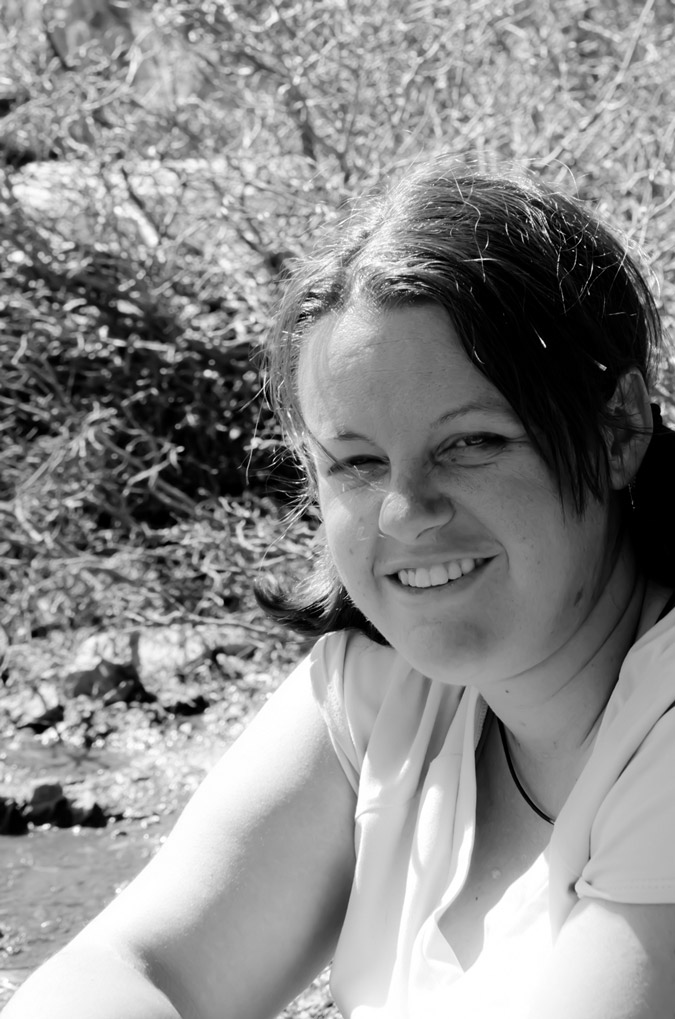
About an hour or two after we arrived at the lake, another group of gentlemen came to the lake, sporting a pistol and a Canon EOS Digital Rebel attached to a fully extended tripod. They were nice enough guys, hailing from Elizabeth, but I could not help but wonder how fun that tripod was to carry up to the lake and if they would be using the pistol for fun or for protection. I was hoping for the latter, based on my horrible experience at Huerfano Valley a couple of years ago. The two confirmed they were just hikers, not climbers, and were just there for the night.
Another hour later, two more guys came up the trail and were looking to camp nearby. One looked familiar, so I asked him if his name was Corey. He said it was - and sure enough, it was one of my Facebook friends! Corey was up at the lake with his friend Robbie as they were planning on climbing Snowmass on Sunday, the same as us. They were planning for a 4 AM start and we were planning for a 2 AM start. Regina and I talked for awhile off and on with both Corey and Robbie throughout the afternoon, getting to know each other. It is always remarkable to me how quickly people that climb 14ers can get to know each other and how, generally speaking, everyone is so friendly. It was a real pleasure sharing a campsite with them. Regina got to spend some quality time getting to know Corey:
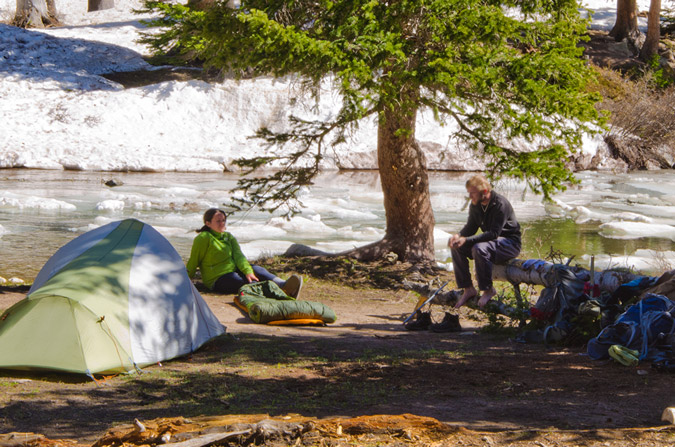
The lake was thawing out throughout the day, which was actually really fun to watch. Chunks of ice and snow would calve off of the icy glacier that was now Snowmass Lake and flow down into Snowmass Creek and out to sea. It was really fun to watch, and quite peaceful too. Soon, the sun began to get lower and lower on the horizon, which piqued my photographic instinct quickly. I was off to get as many quality shots as possible of the lake, hoping to get both HDR and standard photos. HDR has quickly become one of my more favorite photographic mediums. Its almost like opening a present at Christmas when you begin working with the files at home - you never quite know what you're going to get!
First up - the HDR version:
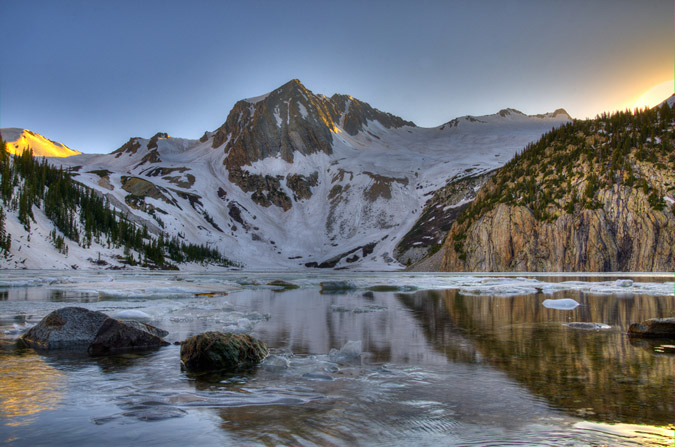
And the standard version, which won me my second Flickr Explore Award, which was quite exciting! Explore is Flickr’s Daily Artist Showcase. Every day Flickr admins choose 500 of the most interesting images determined by “interestingness”. I have placed that photo in my portfolio and for sale section if you are interested in purchasing a print.
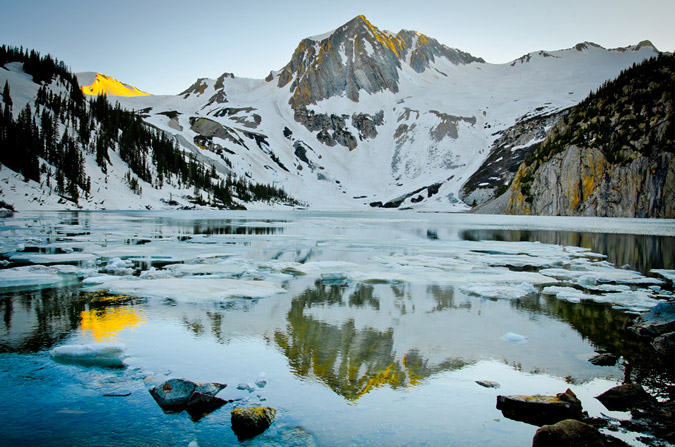
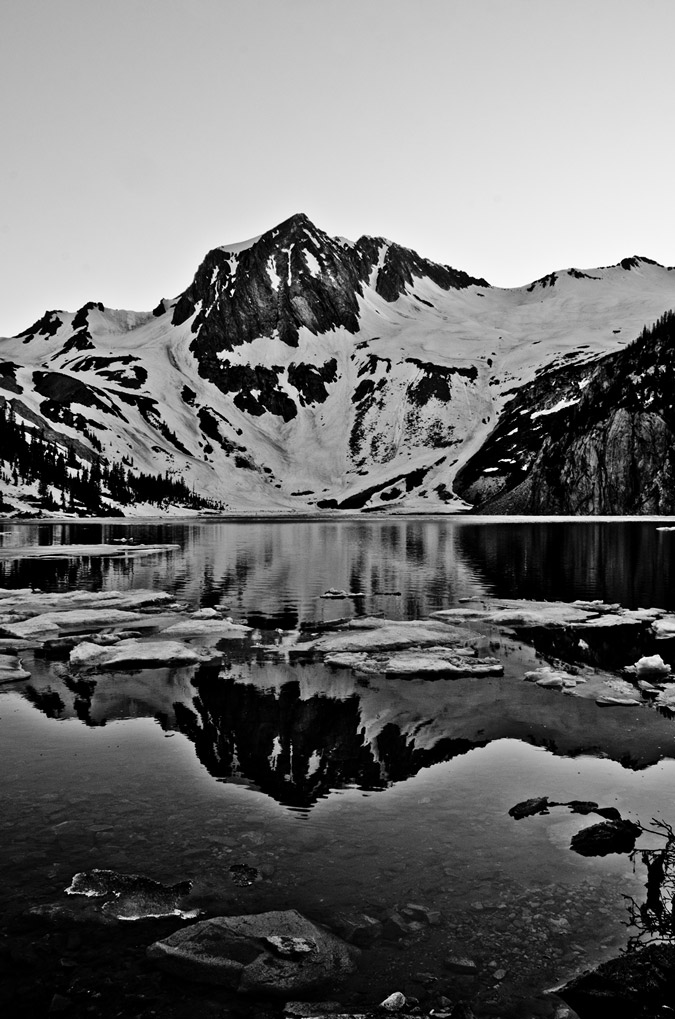 The views from the shores of the lake were outstanding. Quite possibly ranking in the top 10 views of all time for me personally. The impressive features of Snowmass Peak, paired with the crazy cliff walls below Snowmass Mountain made for quite a great spot to sit and soak it all in. To make things even more fun, close to dusk, a huge, feral, rugged looking porcupine decided he would come and hang out with us. This guy was seriously oblivious to our presence, and it was actually somewhat challenging getting him to go away without putting myself in a dangerous place.
The views from the shores of the lake were outstanding. Quite possibly ranking in the top 10 views of all time for me personally. The impressive features of Snowmass Peak, paired with the crazy cliff walls below Snowmass Mountain made for quite a great spot to sit and soak it all in. To make things even more fun, close to dusk, a huge, feral, rugged looking porcupine decided he would come and hang out with us. This guy was seriously oblivious to our presence, and it was actually somewhat challenging getting him to go away without putting myself in a dangerous place.
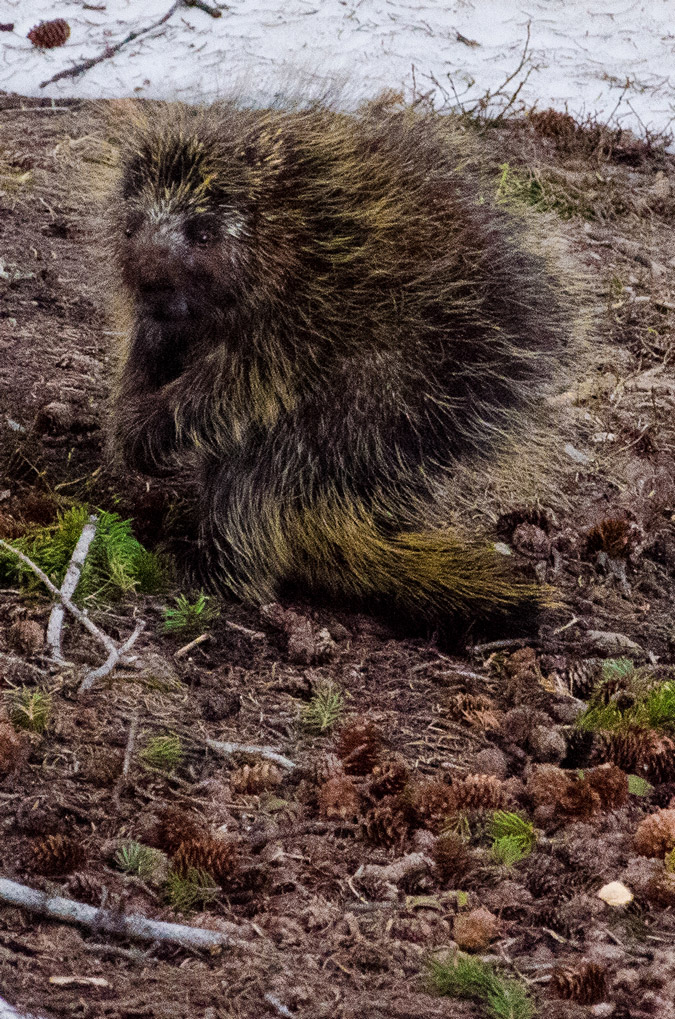
With all of the excitement over the porcupine and the heavenly sunset, I decided it was time to hit the sack. We had set our alarms for 1:45 AM, anticipating a 2 AM start. It was sadistic, I know, but we felt it was necessary given the conditions. The alarm went off and I got up fast, because I wanted to take advantage of a quick photographic opportunity to capture the Milky Way, or at least attempt it. Additionally, I was hoping that I could get some photos of the stars reflected in the lake as well. Both concepts challenged my photographic mind, and away I went to try to get some good shots. The challenge with shooting in low light, as in pitch dark, is always figuring out the best combination of aperture, ISO and shutter speed. Of course, I guess this can be said about any other form of photography, but the concepts are of particular sensitivity in low light conditions. I opted to set the camera at a slightly higher ISO (400) to increase the sensitivity of my cameras sensor. Additionally, I went for a 20 second exposure instead of a 30 second exposure since I did not want the stars to blur / move across the frame at all. Lastly, I opted to set my camera at the lowest aperture the lens would handle (f/3.5) to allow the maximum amount of light into the lens. These combinations produced fairly good results.
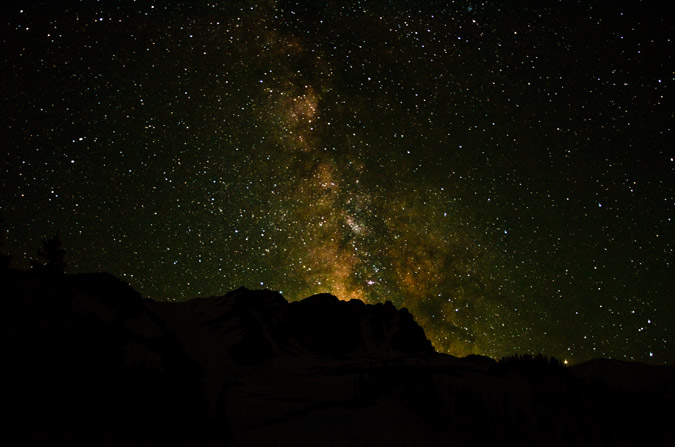
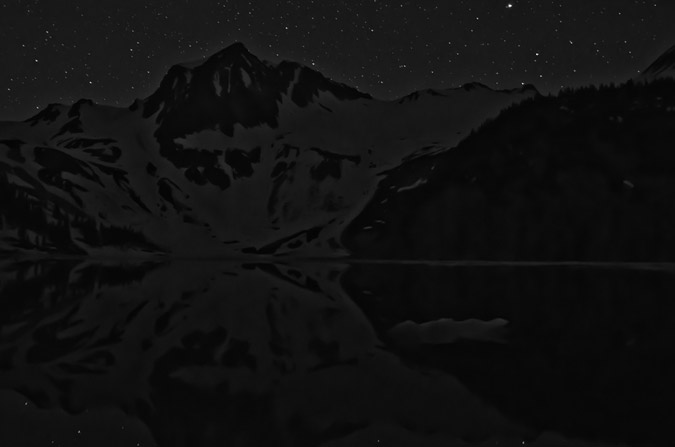
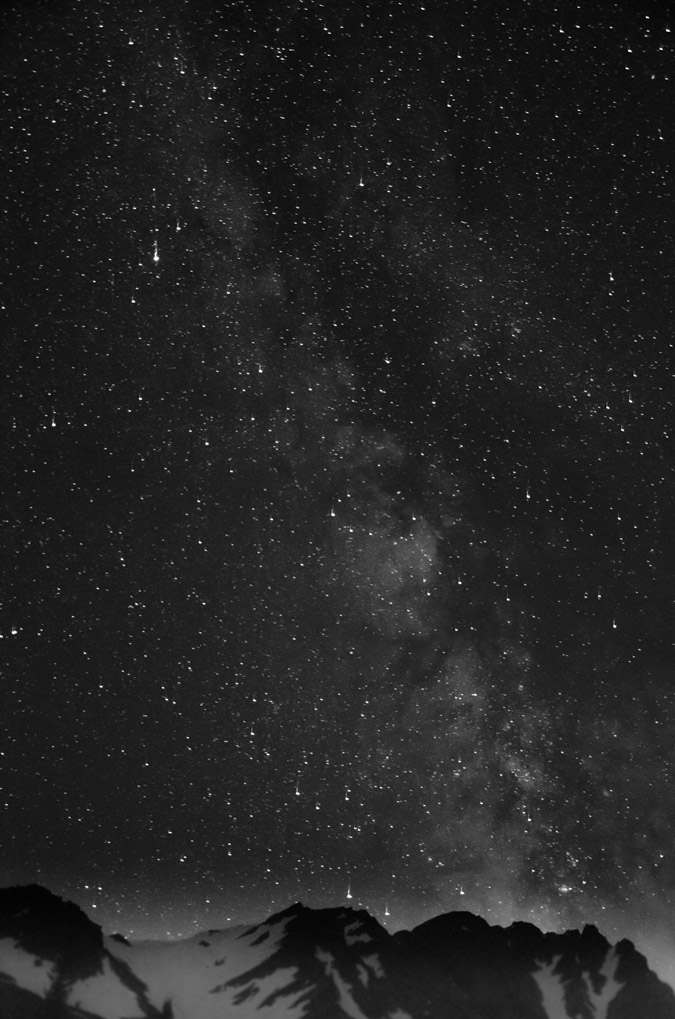 Unfortunately for me, the photographic success would not lead into climbing success. This is quite an embarrasing story for me, since I pride myself on preparation. As Regina and I wrapped around the steep snow banks to the left of Snowmass Lake, heading for Snowmass Mountain, we quickly realized that crampons would be required. No problem right!? Wrong. Shortly after putting the crampons on and continuing, my crampons would come right off my boot, necessitating frequent and long stops to get them back on. Finally, Regina and I decided that there was something wrong with my crampons and that no matter how we tried to get them to stay on my boots, they just would not stay. We decided to abort the mission at about 3:45 AM and headed back to camp. I was quite furious with myself, since I had personally tested the crampons at home, putting my boots into them, strapping them down, and making sure they fit. Apparently that effort was not as good as it could have been. It turns out, after inspection at home, that my crampons were adjusted in such a way that they were too big for my boots. Most modern crampons self-adjust their size; however, the crampons I own are hand-me-downs from my dad. Surprisingly, the same model is still manufactured by Seattle Manufacturing Corporation. Anyways - lesson learned! USE your equipment before you trust it with your life. We went back to camp, slept for a bit longer, and then packed up and headed back down to the trailhead. I was not in a great mood because this was one of the only mountains I've ever been turned back from, and it was completely my own fault. If it were weather or altitude sickness or some other uncontrollable event, that would be one thing, but to have the mountain turn us back because I was too stupid to test my crampons - not cool. It was not a total loss though, the photos turned out great, and I was able to get some fun and creative shots of wildflowers on the way out. If any of you know the names of these flowers, please, by all means let me know!
Unfortunately for me, the photographic success would not lead into climbing success. This is quite an embarrasing story for me, since I pride myself on preparation. As Regina and I wrapped around the steep snow banks to the left of Snowmass Lake, heading for Snowmass Mountain, we quickly realized that crampons would be required. No problem right!? Wrong. Shortly after putting the crampons on and continuing, my crampons would come right off my boot, necessitating frequent and long stops to get them back on. Finally, Regina and I decided that there was something wrong with my crampons and that no matter how we tried to get them to stay on my boots, they just would not stay. We decided to abort the mission at about 3:45 AM and headed back to camp. I was quite furious with myself, since I had personally tested the crampons at home, putting my boots into them, strapping them down, and making sure they fit. Apparently that effort was not as good as it could have been. It turns out, after inspection at home, that my crampons were adjusted in such a way that they were too big for my boots. Most modern crampons self-adjust their size; however, the crampons I own are hand-me-downs from my dad. Surprisingly, the same model is still manufactured by Seattle Manufacturing Corporation. Anyways - lesson learned! USE your equipment before you trust it with your life. We went back to camp, slept for a bit longer, and then packed up and headed back down to the trailhead. I was not in a great mood because this was one of the only mountains I've ever been turned back from, and it was completely my own fault. If it were weather or altitude sickness or some other uncontrollable event, that would be one thing, but to have the mountain turn us back because I was too stupid to test my crampons - not cool. It was not a total loss though, the photos turned out great, and I was able to get some fun and creative shots of wildflowers on the way out. If any of you know the names of these flowers, please, by all means let me know!
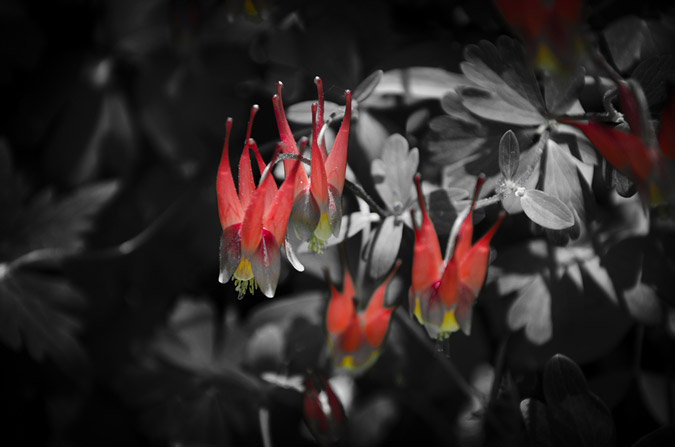
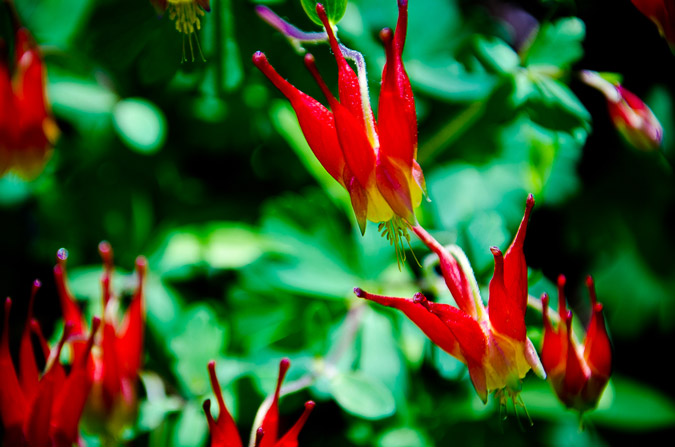
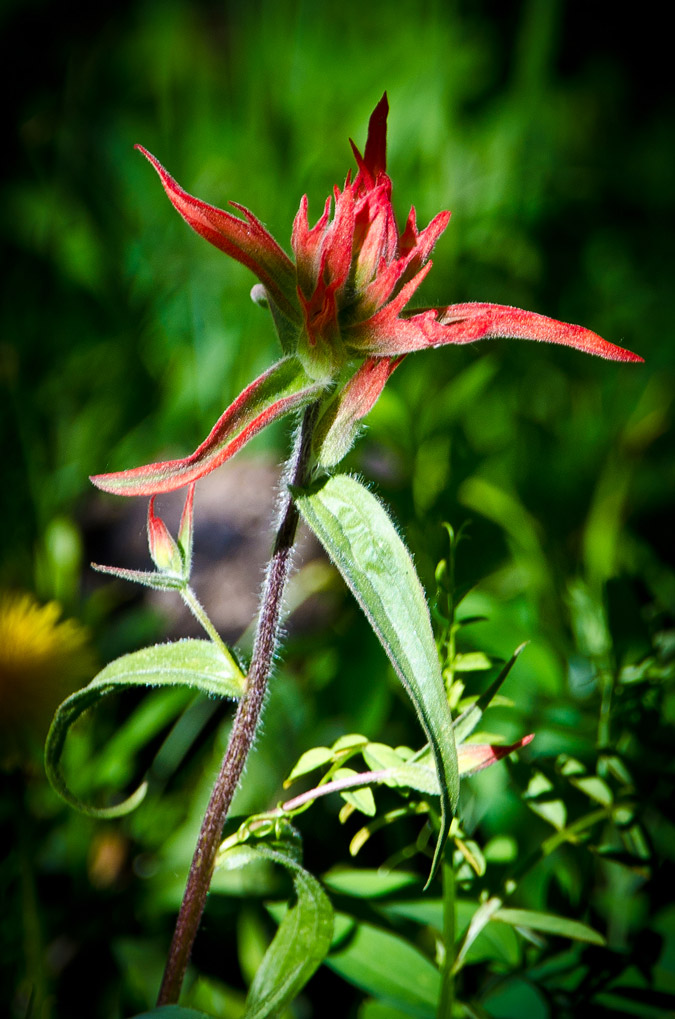
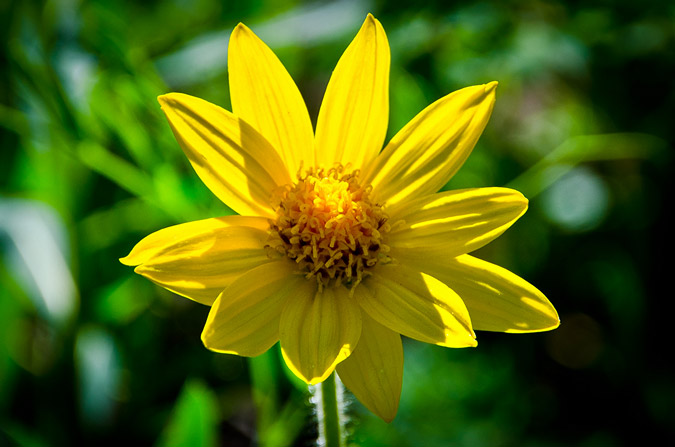
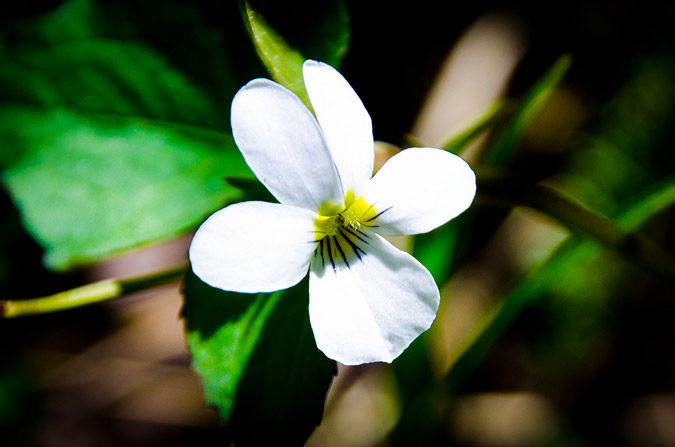
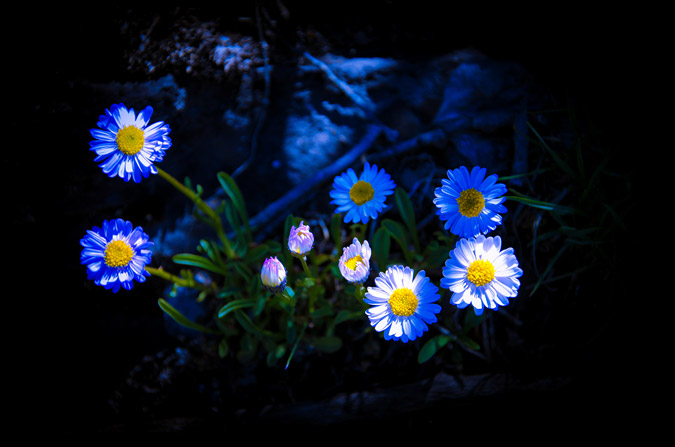
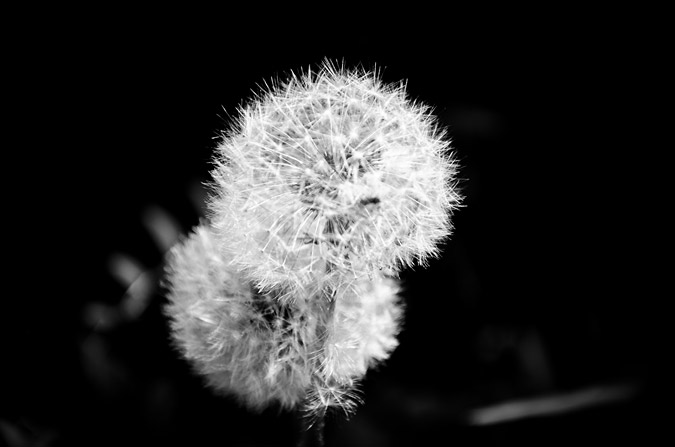
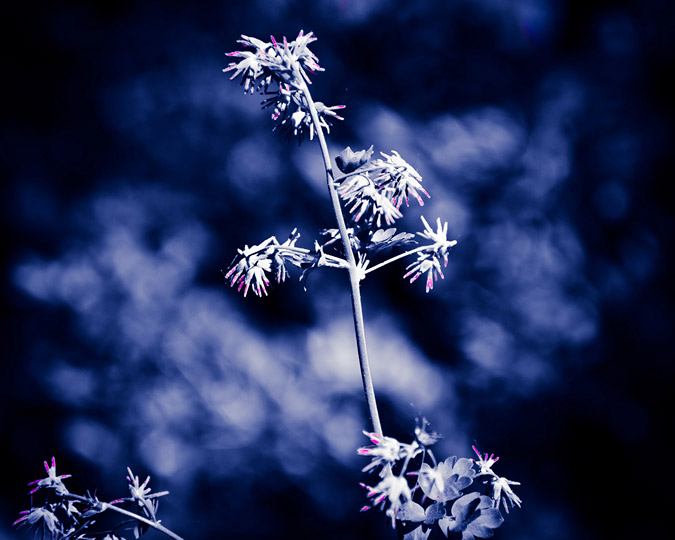
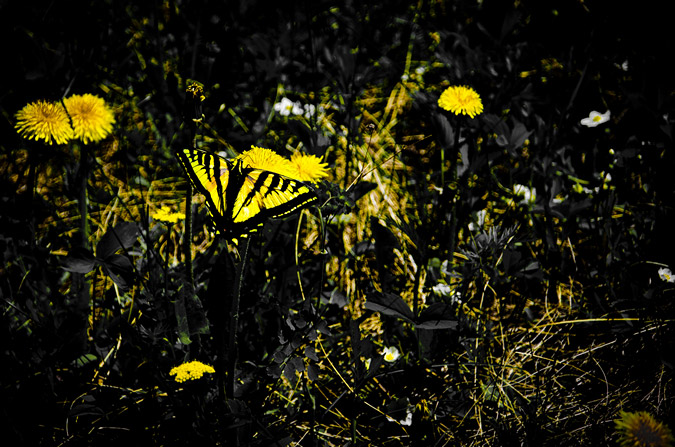
The most memorable part of the trip was yet to come though - and it certainly made up for the rest. On our way out, Regina took a nasty fall on the logjam! At first it was quite a scary experience. I was right behind her, and had to talk her through getting herself back up out of the water. She had managed to completely submerge one of her legs and was drenched. Fortunately, Regina is a good sport, and within a matter of minutes we were both laughing about it.
Lastly, we were able to get some great views of the backside of Snowmass that we did not get to see on the way up, which were quite stunning!
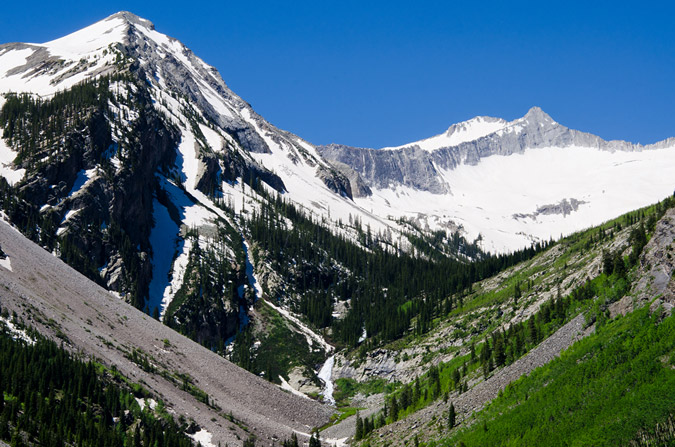
All-in-all, I would rate this hike quite highly on my list of hikes that I have done. The views from Snowmass Lake are worth it by themselves, and the logjam provides an excellent adventure.
And in case you were wondering - the new camera bag totally lived up to my expectations - I will end up writing a full-blown review of that product for sure!
Until next time Snowmass Mountain... I'll be back!
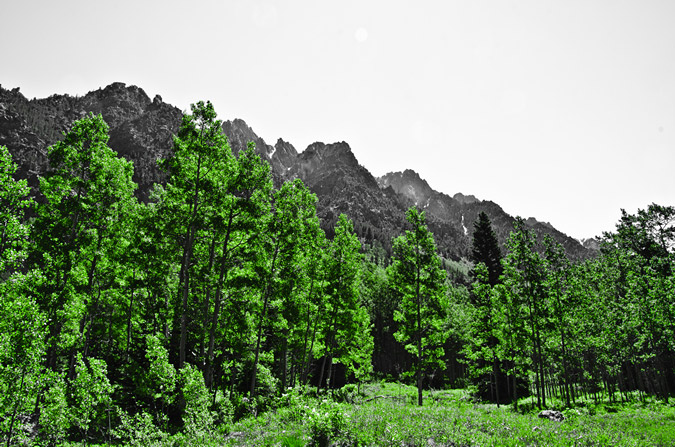
San Luis Peak - an adventure in photography and friendship
San Luis Peak is a gentle giant, rising to 14,014 feet in the middle of the La Garita Wilderness Area, which means "The Lookout" in Spanish, according to Wilderness.net. The 50th highest ranked peak in Colorado, San Luis Peak is named after the valley it towers over, the San Luis Valley. According to Hayden's 1877 Atlas of Colorado, the valley itself was named by an early unknown Spanish explorer, the patron saint of whose village was San Luis.
I've been wanting to climb San Luis for awhile now. Not a technical climb nor arduous hike, San Luis is generally considered one of the easier 14ers; however, due to its remote location, it is not climbed nearly as frequently as other 14ers. Indeed, the trail-head is located nearly 50 miles from any recognizable form of civilization. For this reason, I am quite thankful that I was able to get a ride with Regina Primavera (Yalegirl09 on 14ers.com), my friend and hiking partner. Regina and I planned out many of our hikes quite early this year and San Luis was to be the first mountain for us to tackle together. Additionally, another awesome person, Sarah Musick, found me through my website and a mutual friend, and asked if she could join us.
Regina and I picked up Sarah and departed for the San Luis trailhead on Friday evening, June 10th, 2011. Excellent conversation ensued and we were all quite acquainted with each other before we reached Salida, Colorado for dinner. We made a stop at Amica's Pizza and Microbrewery, which reminded us all of Il Vicino in Colorado Springs (and for good reason too, apparently Amica's used to be a Il Vicino and was later converted by the new owner). The food and beer were all quite fantastic. With spirits high, we continued on to the town of Saguache, Colorado (pronounced Saw-watch), refueled, and drove the beautiful yet never-ending road to the San Luis trail-head. A note about the road - it was somewhat confusing for us coming from the San Luis Valley. If you are coming from the San Luis Valley area, drive north on Colorado 114 to Dome Lakes, then turn left onto the "15-GG" road. Our mistake was that we did not drive all the way to the 15-GG road, but instead headed up the NN-14 road before reaching Dome Lakes. It still gets you there by going the way we did, but it is MUCH longer! For our trip, we opted to take the Stewart Creek trail.
Upon reaching the trail-head parking lot, we set-up our camp site quickly with the aid of headlamps. The stars were pretty incredible since we were in the middle of nowhere, and I decided it would be a great time to try out some star trails photography.
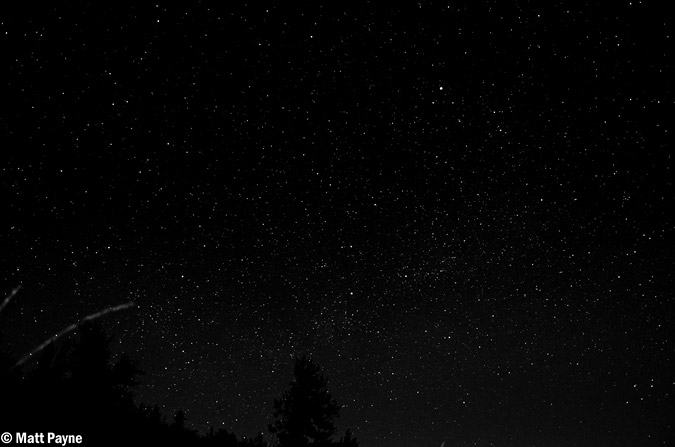
The stars were looking good... hopefully the star trails version would be just as good!
There are a couple techniques one can use to accomplish star trails in a photo. The basic method is to take one long exposure (over an hour), which captures the movement of all of the stars as trails across the photo. The drawback from this technique is that you have no room for error because of the long single exposure and, due to noise caused by heat and other factors in the camera, you need to turn on noise reduction in camera, which basically takes an equally long exposure with the shutter closed at the end of the shot and then reduces noise based on the comparison of the open and closed shutter shots. The second method, which I employed, is to take multiple shorter exposure shots (30 seconds to 4 minutes each) over a period of time, with little time between shots to ensure that no gaps exist in your trails (unless that is what you want), and then combine them later in a program like photoshop or startrails.exe. In order to get the below photo, I set-up my camera, a Nikon D7000, to take a photo every 45 seconds. The camera was set on manual focus, with the stars in focus, at aperture of 5.6; the shutter speed was set for 30 seconds because I forgot to bring my shutter release cable, otherwise I would have probably set my shutter speed at 2 minutes or so. I then imported the photos into Adobe Lightroom and adjusted the exposure and cleaned up any unwanted artifacts that streaked through the exposures (airplanes, satellites, etc). I copied the development settings of the photo I did the work on and applied it to the other 47 images for consistency purposes. Finally, I loaded all of the images into startrails.exe, which is a free program. Startrails combines all of the photos together into the one you see below. All-in-all, I was very pleased with the results.
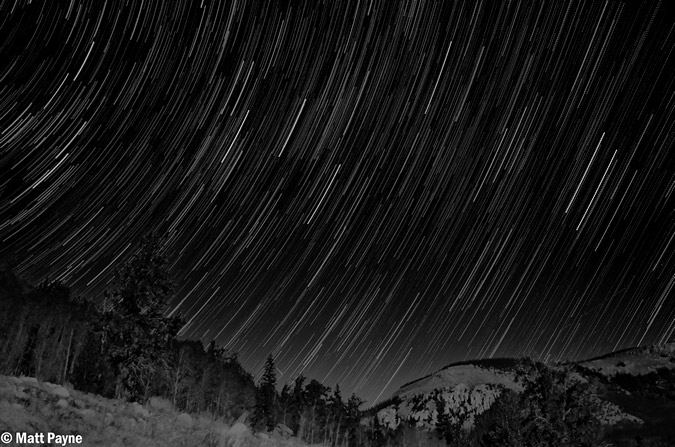
Additionally, I decided to add the photos together into a time-lapse video, showing the change in star position across the 35 minute time-span, as seen in this YouTube video:
After waiting in the cold for an hour with Regina while the camera captured the photos, we set our alarm for 4 AM and crashed in the tent. 4 AM came sooner than I liked, but I felt much more rested than I did on my last adventure up Princeton.
We packed up our tent and sleeping amenities, ate some quick trail food, and departed. Since none of us were really sure about the conditions of the mountain due to a real dearth of trip reports online for San Luis recently, Regina and I opted to pack our crampons, and we all had ice axes. Regina and Sarah were looking quite excited to begin the hike at 5 AM, despite Regina stating she felt sick.
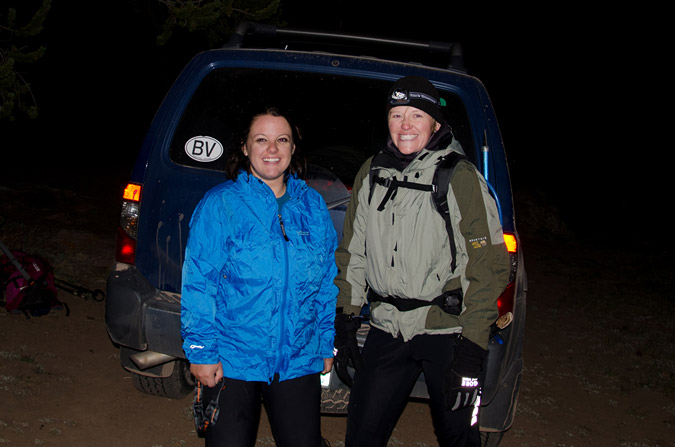
Naturally, I had to look as excited as possible, despite the fact that I am not a morning person!
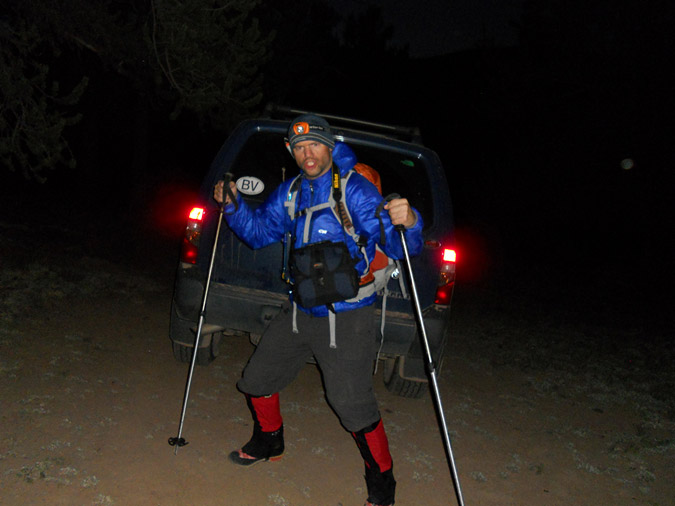
The trail heading up the Stewart Creek valley was gentle and steady. One thing that was remarkable was the beaver ponds, which were quite ubiquitous. We were even lucky enough to be greeted in the early morning by a couple of beavers, whom used their tails to loudly splash water, as if to say, "this is our house!" As we continued up the trail, we shortly glimpsed a very young moose that was grazing near one of the beaver ponds. Before we could capture any photos of it, it ran into the woods. Oh well!
Before long, the sun began to rise and the inner nerd photographer in me began to get excited. The Golden Hour is easily one of the best times to take photos, and I quickly searched for some beaver ponds or other water features to balance out my compositions.
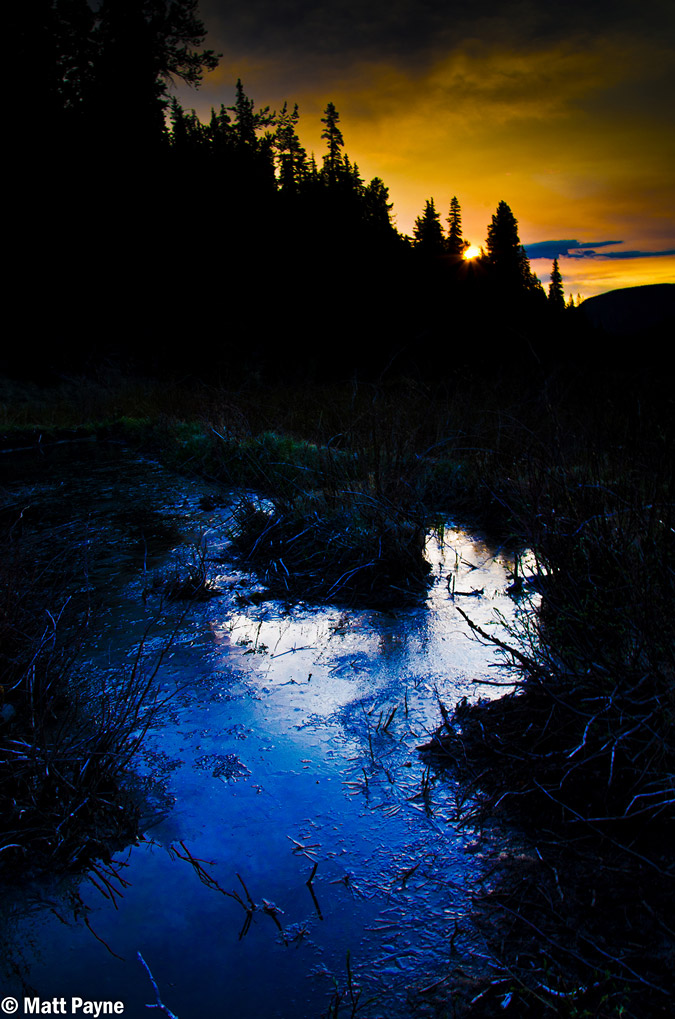 |
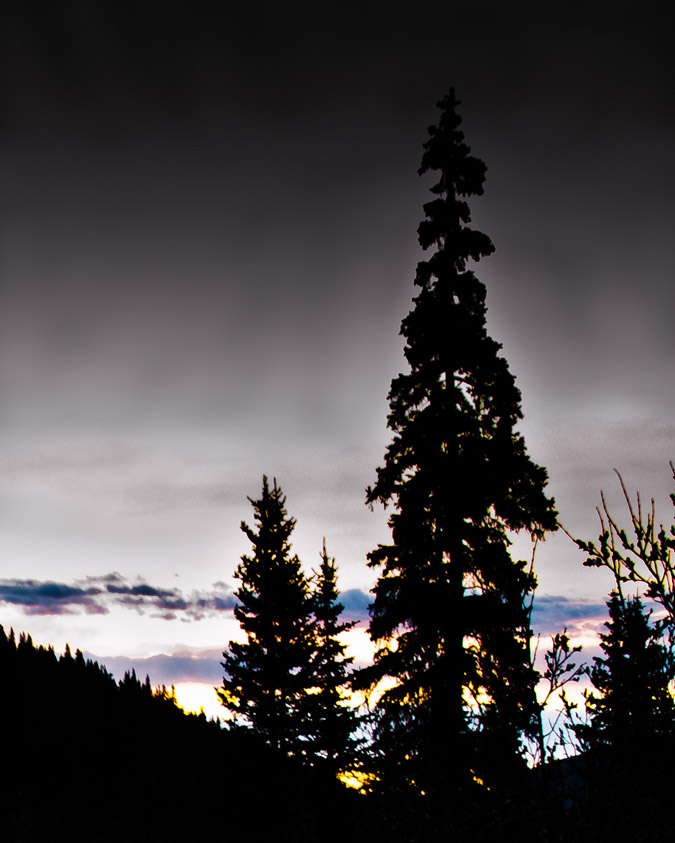 |
We stopped near a small pond and a crook in the stream and I set-up my camera.
If you are not familiar with The Golden Hour, it is well defined by Wikipedia: "In photography, the golden hour is the first and last hour of sunlight during the day, when a specific photographic effect is achieved due to the quality of the light." Today was no exception. Due to the fires on the Colorado-New Mexico border and in Arizona, the sky and the clouds had a brownish-red hue to them, making for some interesting light effects.
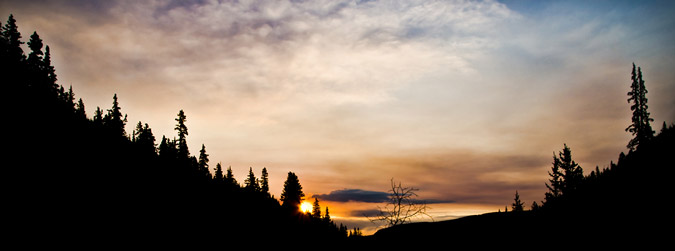
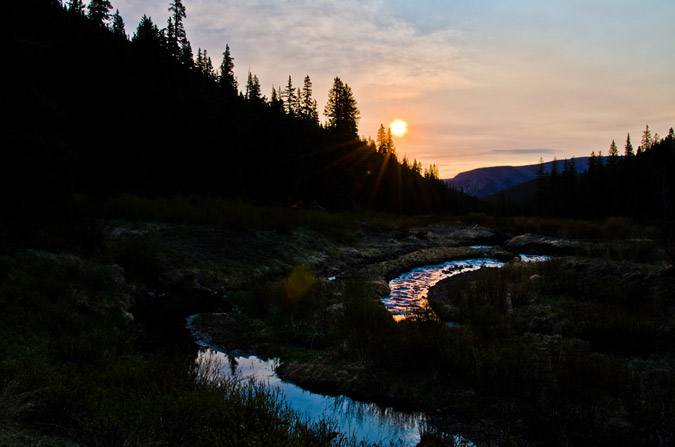
I think I may have frustrated Regina and Sarah with the amount of time I spent shooting photos at this point, but I think the time was well worth it, personally. I have been trying to focus a little more on composition in my photographs lately, including thinking about the rule of thirds and incorporating lines into the photo in order to draw the viewer into the photo. I've also been using Lightroom to do most of my editing. Let me know what you think about my efforts!
While I was playing in the woods with my camera, Regina decided it would be fun to take a picture of me, taking pictures.
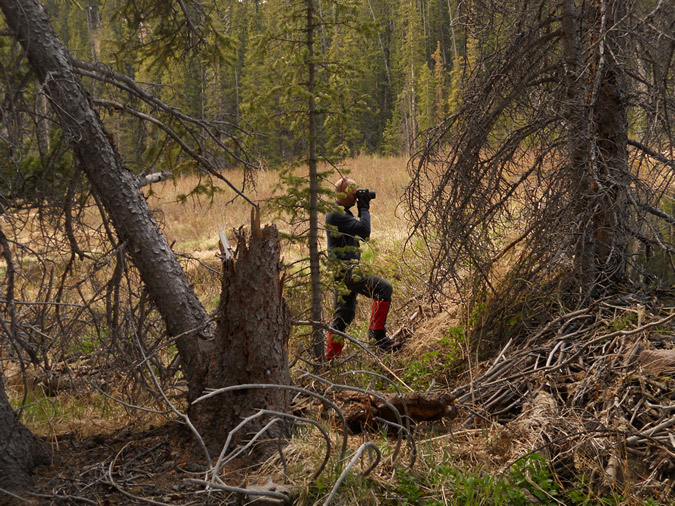
Something about me being rich and famous someday (yeah right)! Additionally, Regina and Sarah teamed-up and came up with the brilliant plan of putting Regina's crampons in my pack as punishment for the long wait I had caused (and more importantly, because Regina did not feel well).
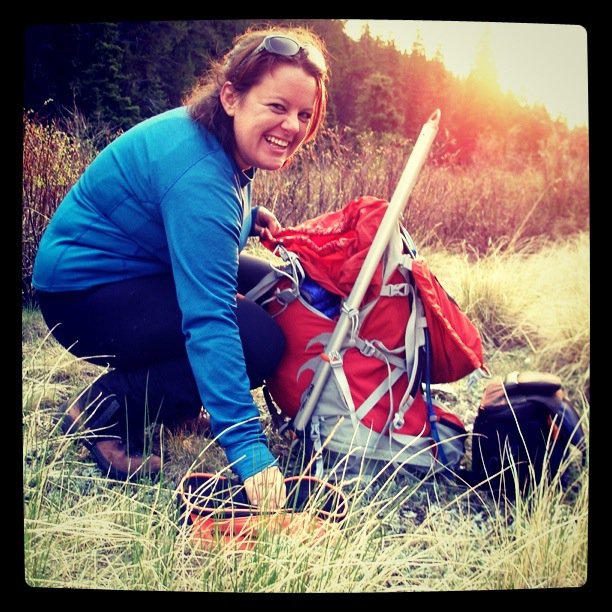
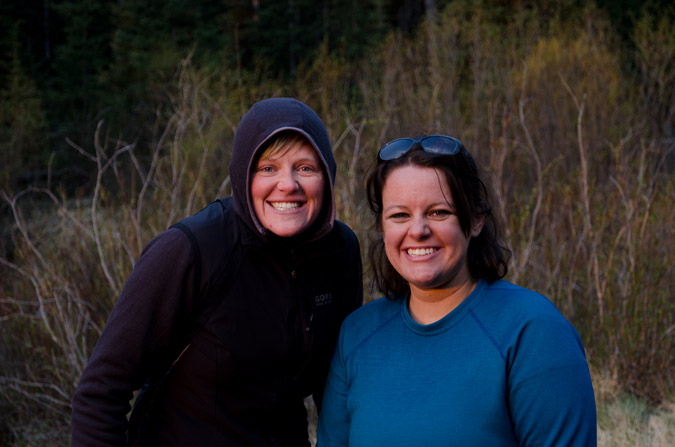
On we continued up the trail, with Sarah playing videographer to our adventures.
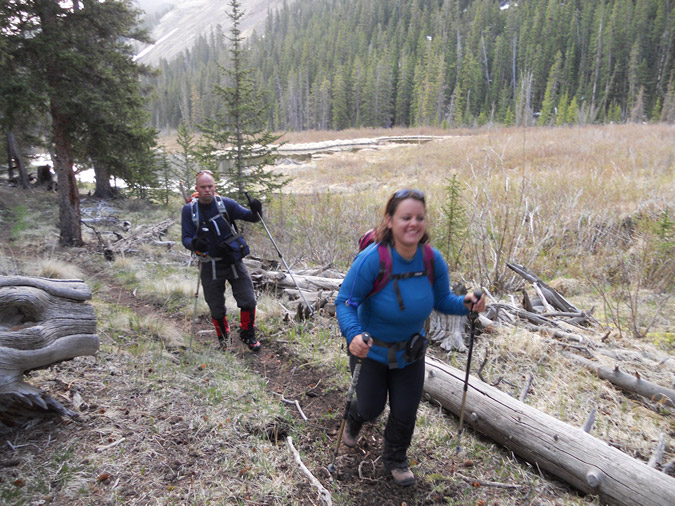
Sarah and Regina made for great companions, it was amazing how well we all got along and how closely aligned our political, religious and philosophical views were.
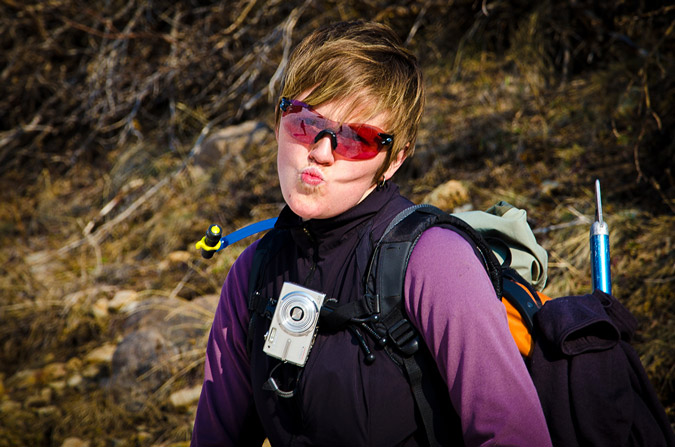
We rested for a little bit to eat and drink, and Sarah shared some amazing little snacks her friend made. Apparently, her friend is beta-testing these snacks to be sold to cyclists, hikers, climbers, triathalets, etc. I must say, they were delicious! They were little balls of goodness!
We spent a little time at a huge set of beaver ponds, admiring the clear water and great morning air.

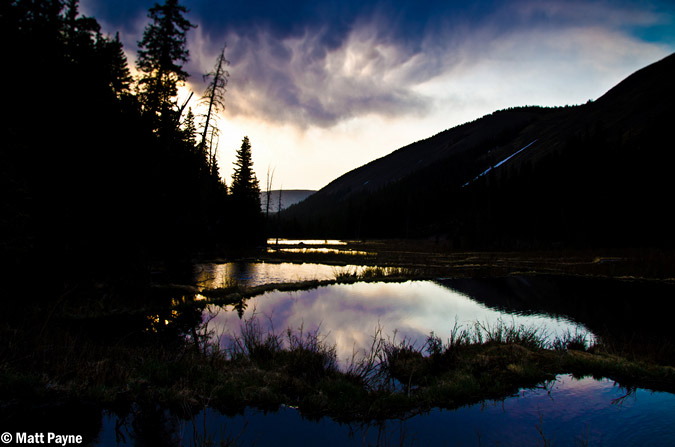
Before we knew it, we were at treeline after a few simple creek crossings.
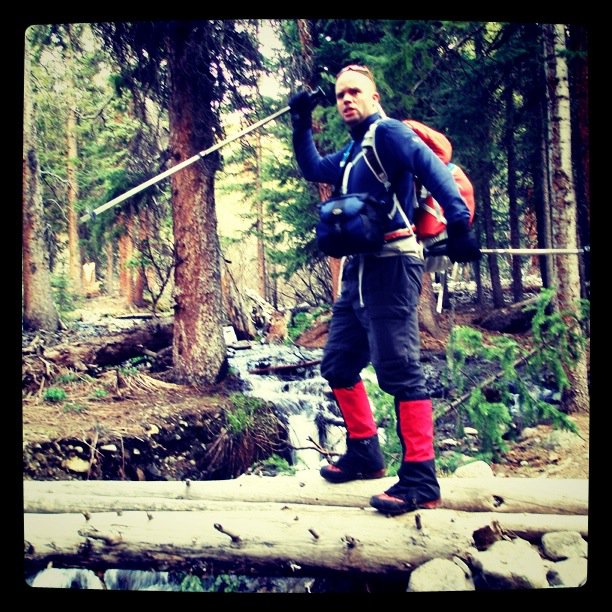
Once we hit treeline, the trail ran right into a huge snowfield that presumably went over where Stewart Creek is supposed to be.
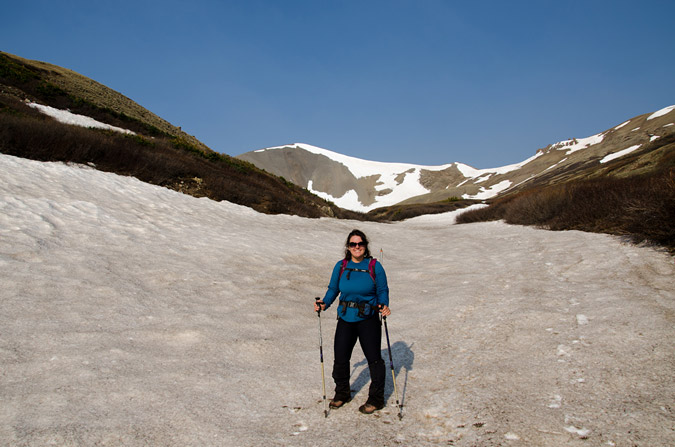
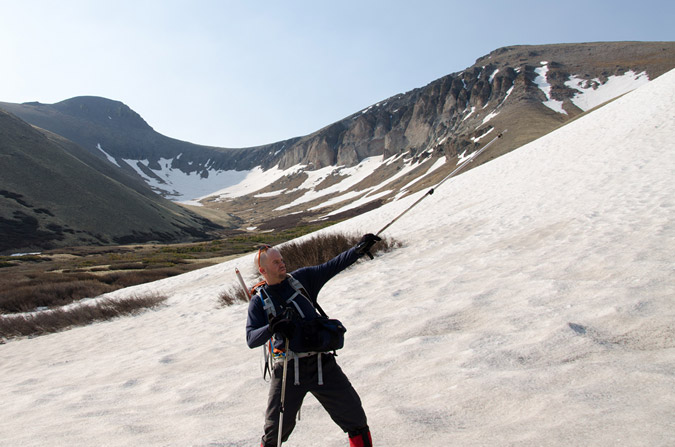
From here, the goal was to gain the saddle between Organ Mountain and San Luis. The trail was hit or miss through the snow, but never felt difficult. The snow was not a problem at all, and I think Regina was a little bummed that she didn't get to use her crampons.
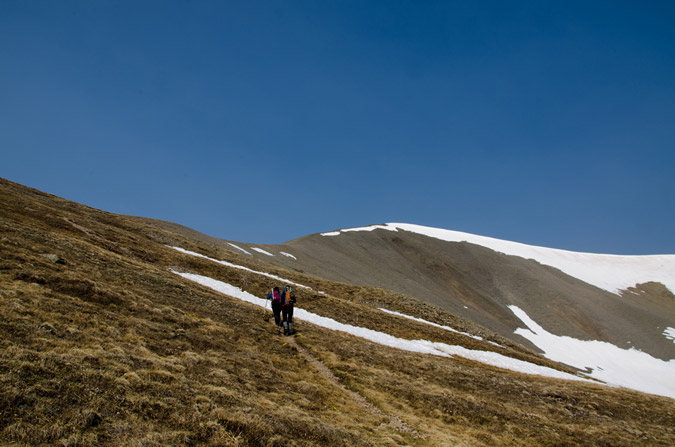
There was a group of 5 guys that were behind us pretty much the whole way up. In total we counted 15 people including ourselves the whole day. I was able to get a large pano from most of the way up to the saddle, which included the guys behind us.

We quickly gained the saddle and enjoyed views of both Organ Mountain and San Luis, which was pretty close!
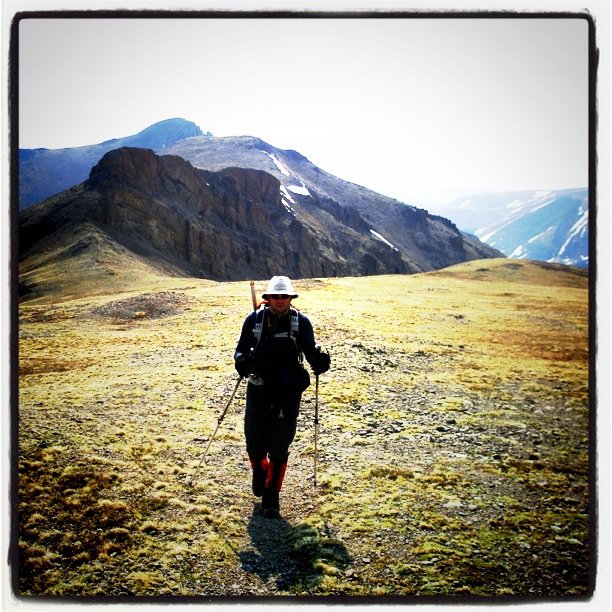
Organ Mountain behind Matt.
After the saddle, the trail leads you up towards a bump that Regina kept saying was Baldy Alto, but is in fact just a bump on the way up San Luis. The trail bypasses this bump to the left and then heads right up below San Luis' ridge.
A 360 view from the ridge between Organ and San Luis. Click for a higher resolution version.
Organ Mountain was impressive. I had originally thought we might have time and energy to hit it as well, but with Regina not feeling well, I decided to just do San Luis Peak. Anyways, I really liked the imposing feel that Organ Mountain imparted upon me here, so I had fun editing this photo to really convey that feeling.
We opted to follow the trail and stay low instead of going up to the top of the ridge.
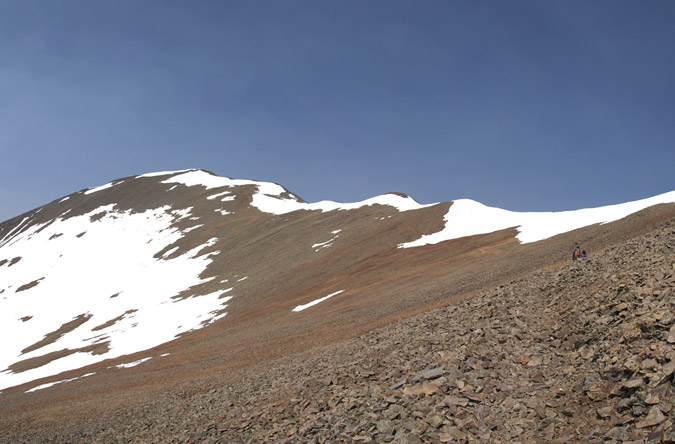
Subsequently, the trail led us into some nasty snowfields, which we had to downclimb to go around. We later lost the trail due to the snow and ended up going straight up some relatively unpleasant scree to the ridge.
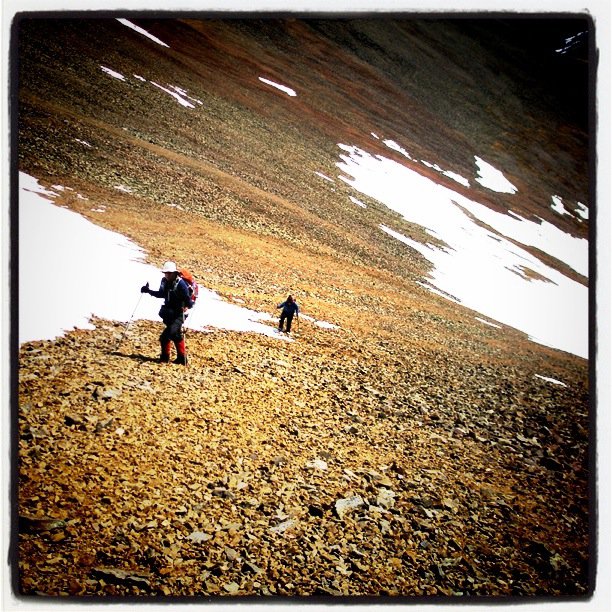
We reached the summit at 10:45 AM, a modest 6 hours since we left the car. Surely if Regina wasn't sick and if I didn't own a camera we could have shaved a good 2 hours off the time!
The smoke was very evident from the top, by sight and smell. It really degraded the view and photography. Regardless, I was able to get some good shots from the top, including this near-360 view (click for higher resolution).
I was also contemplating knocking out Stewart Peak (center) and Baldy Alto (right of center), as seen below, but opted not to due to Regina not feeling well. I did not want to split the group up if someone was not feeling good.
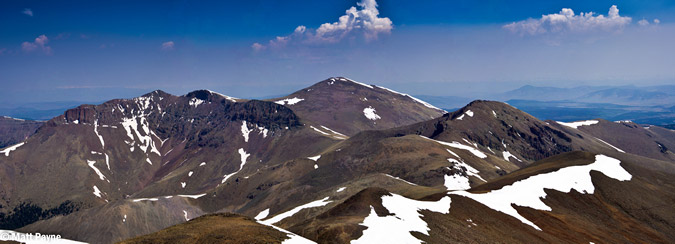
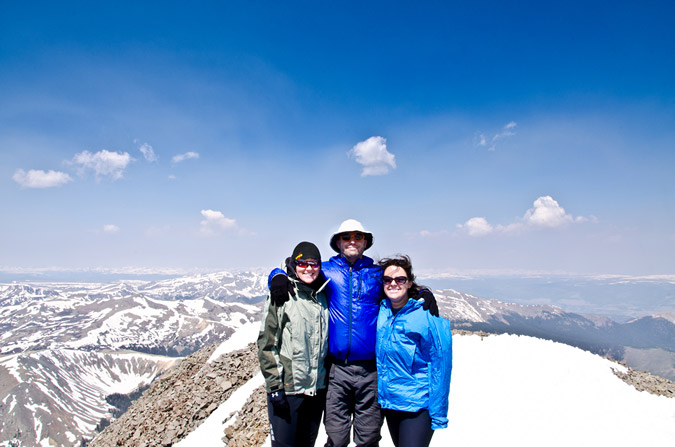
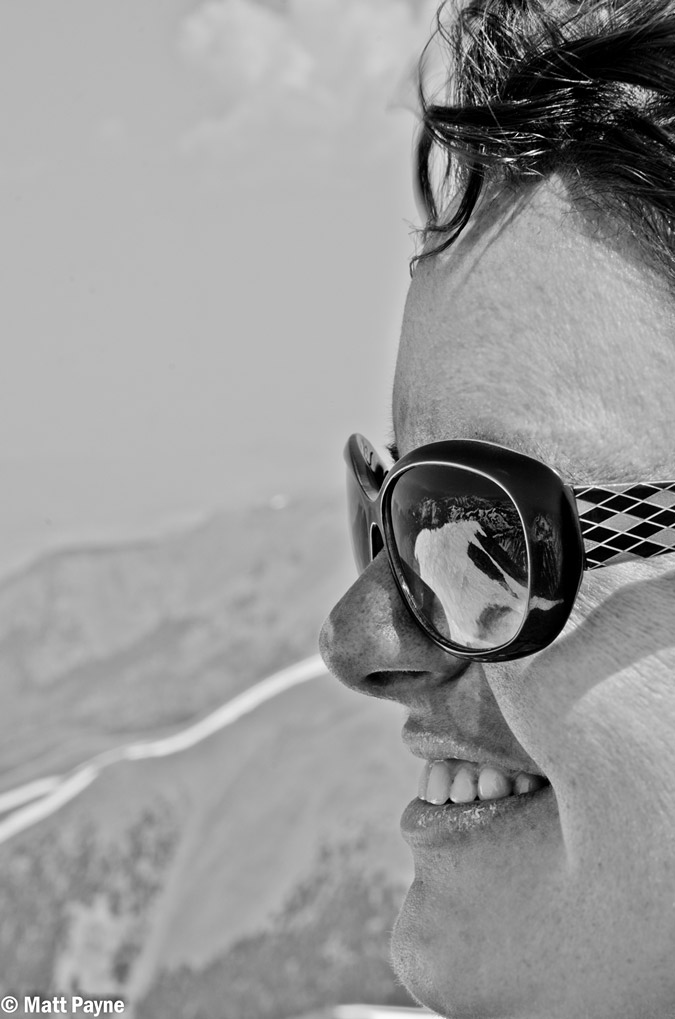 I had fun shooting this photo of Regina - the mountains to the west were reflected nicely in her sunglasses, plus she was quite a cooperative model! All in all, it felt great to climb my first mountain with both Regina and Sarah, and I think everyone was quite proud of their accomplishment!
I had fun shooting this photo of Regina - the mountains to the west were reflected nicely in her sunglasses, plus she was quite a cooperative model! All in all, it felt great to climb my first mountain with both Regina and Sarah, and I think everyone was quite proud of their accomplishment!
After enjoying some cliff bars on top, we all decided to head back down. The hike down was quite easy, and before we knew it, we were all back at the first snowfield we had encountered before. Regina cracked some jokes about falling into the snow, which was hard enough to prevent post-holing, thankfully.
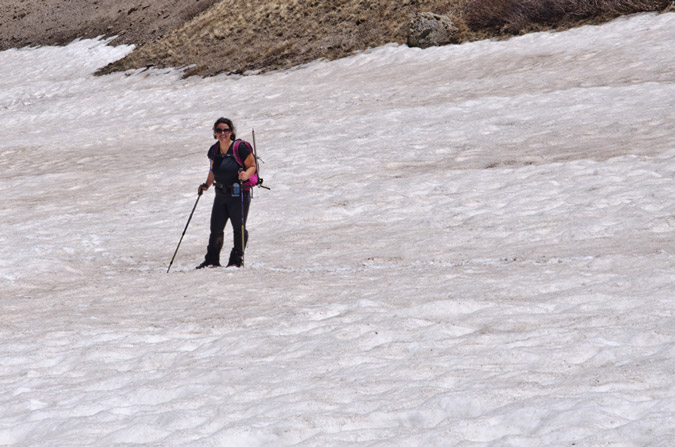
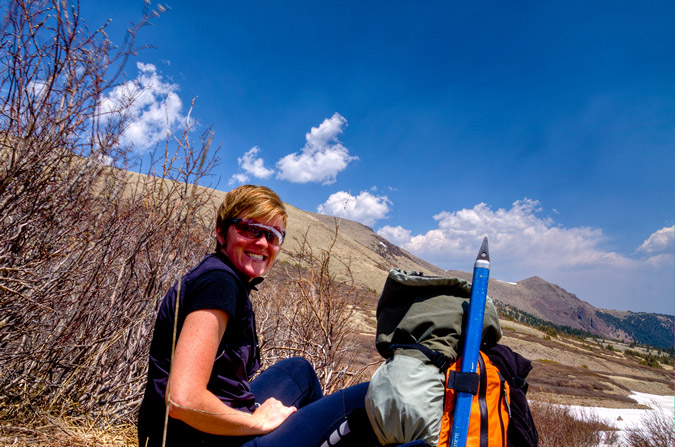
On the way back down, I caught something moving out of the corner of my eye. Much to my surprise, a huge moose was moving slowly through the beaver ponds below. That was probably the highlight of the trip!
The Stewart Creek valley is a very beautiful place. I am glad I need to return to do other climbs nearby!

We finally reached the trailhead again, and I took some fun bracketed photos to run through Photomatix. If only I had a tripod...
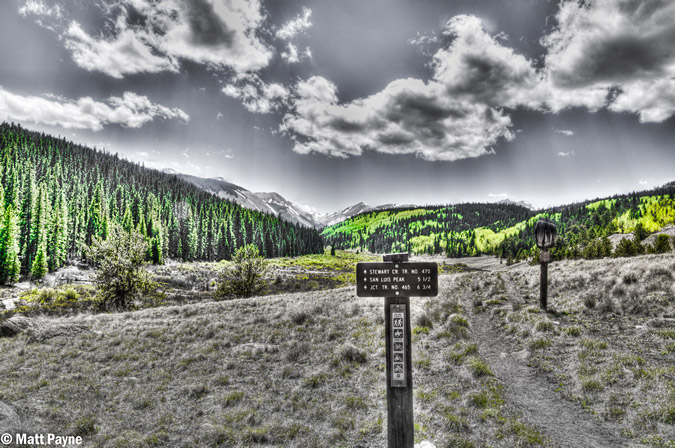
The total hike was 11 miles round-trip, including 3,500 feet in elevation gain. I would rate this hike as moderate to easy in comparison to other 14ers I've climbed.
The drive home was fairly uneventful until I was able to discover the moon rising above the Sangre de Cristo Mountains, including Crestone Peak (right) and Kit Carson Mountain (center).
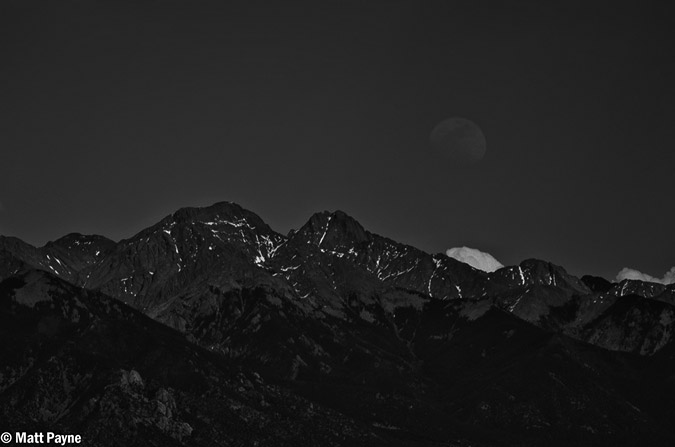
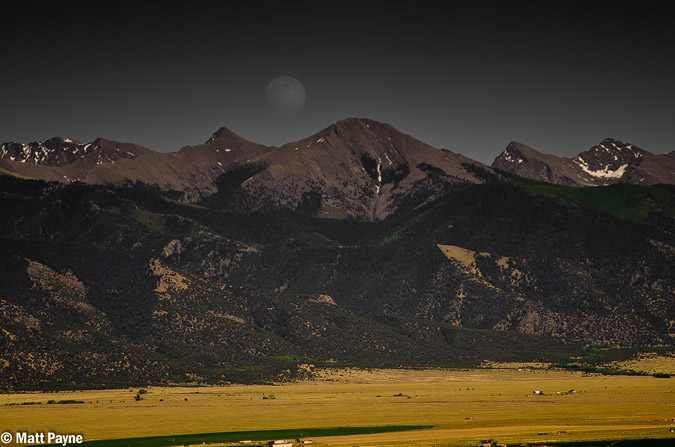
As soon as I returned home, I made sure to check-off another box on my 100summits t-shirt. Thirty-eight of the highest 100 to go and ten 14ers to go!
I look forward to more exciting hikes with Regina and hopefully Sarah too!
If you would like to stay up-to-date on all of my articles, photography musings, trip reports and other mountaineering related news, please feel free to follow 100summits on Twitter or Facebook! Also, if you're planning on doing any online shopping and if you enjoyed the content, please help keep the site going by using the links on this page to help fund the site.
California Peak - a Sangre de Cristo warm-up
California Peak has long eluded me. Being one of the highest 100 mountains in Colorado (a Centennial), it has been in my sights for awhile. California Peak rises to 13,849 ft. and is ranked 84th highest in Colorado based on my list of the highest 100 mountains in Colorado. Over the past two years, I've set eyes on it numerous times, first from the summit of Lindsey, Iron Nipple and "Huerfano," and later from the summits of Ellingwood Point and Blanca Peak, all close neighbors of California Peak. I had hoped to climb it back in 2009 with my wife, but those plans were foiled by some hoodlums shooting guns at me and my family. I also wanted to climb it in 2010, but those plans were foiled by a seriously bad weather outlook that forced me to stay home. So, a few weeks ago, my long-time hiking partner, Ethan Beute and I made plans to climb California Peak. Our plans to climb it two weeks ago were completely thwarted by forecasted 100 MPH winds and again the following weekend due to snow. Alas, this weekend came and we pulled the trigger, with highs forecasted in the 40's for California Peak and wind gusts of up to 40 MPH. Not knowing how much snow was on the trail itself, we both packed our MSR Lightning Ascent snowshoes and a great deal of winter gear. We both also brought our Outdoor Research gaiters, expecting to encounter a fair depth of snow. I scoured the internet for trip reports for California Peak in April and found none, so we really had no idea how much snow would be on the trail or the road. I met Ethan at his house at 3:45 AM and we left for the beautiful yet dangerous Huerfano Valley. We were not sure what the road would be like, so we were very concerned with how far we could get his vehicle, given the last report stated the road had significant snow drifts fairly far from the trailhead. At 6 AM, we were able to make it to within about 2 miles from the trailhead just as the first views of Blanca Peak came into view.
Ethan snapped a great photo of California Peak and Blanca Peak (right to left respectively):
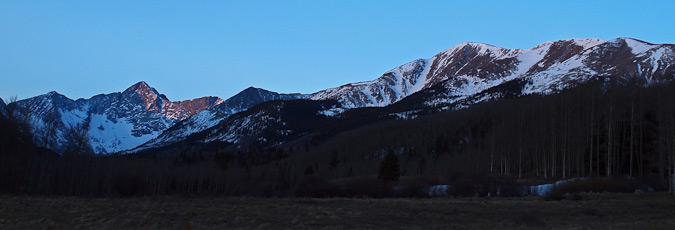
I was very pleased with this starting point and start time. I was also very pleased by the apparent lack of snow on the road and in the trees, as well as the relatively warm temperature. After evaluating the snow levels from afar, we opted to bring our snowshoes because we were unsure if we would need them or not, and since the MSR Lightning Ascents only weigh 3 pounds, it was a sacrifice we were both willing to make to ensure peace of mind. After properly securing our gear and donning our hiking boots, we were off to the races.
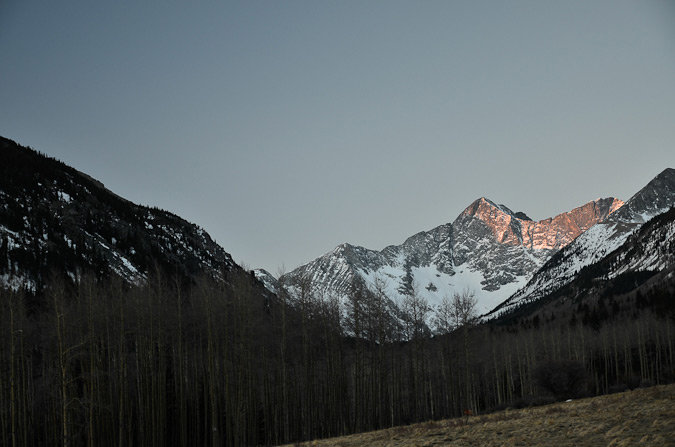
One thing you should know about both Ethan and I is that our first passion is hiking but a close second for both of us is photography. Last year, Ethan purchased a very nice Olympus camera on a deal that was too good to pass-up. I became increasingly jealous of the great images he'd been producing, so I set my sights on upgrading my old Sony DSC-F828 that I purchased in 2001. I was able to purchase a Nikon D7000 a couple of months ago and so I was really excited to finally put it to the test on a proper mountain ascent. Given our mutual love for photography, Ethan and I tend to take several breaks on our climbs to capture some photos along the way, and this trip was no different. In retrospect, I feel that I have a lot to learn about my new camera even though I felt really good about all of the settings after familiarizing myself with its features for the past couple of months. Many of my photos from this trip were blurry, under or over-exposed, and just plain not what I expected. I need a ton more practice!
Right away after setting off on the trail, Ethan and I were greeted by the sunrise kissing the top of Blanca Peak, one of the most magnificent mountains in Colorado. The vantage of Blanca Peak from the Huerfano Valley is one to behold, and I can't produce a much higher recommendation for a scenic location.
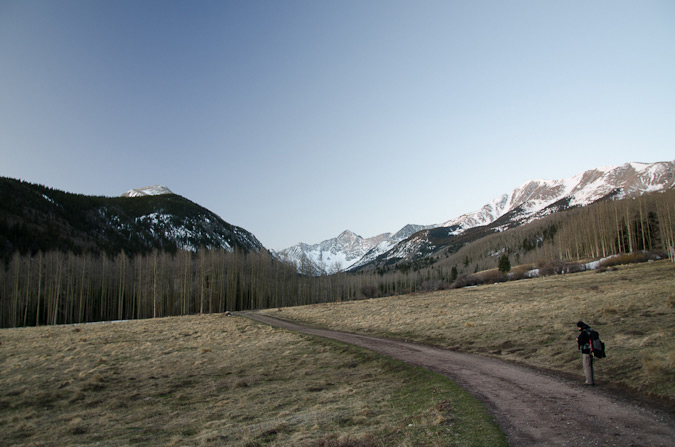
The road was almost completely clear of snow, minus a few large drifts that were in the shadows of trees. A large dead aspen tree had fallen to block the road about 1/8 of a mile from where we parked, so we were glad we parked where we did. Someone's going to have some fun with a chainsaw to get that tree out of the way.
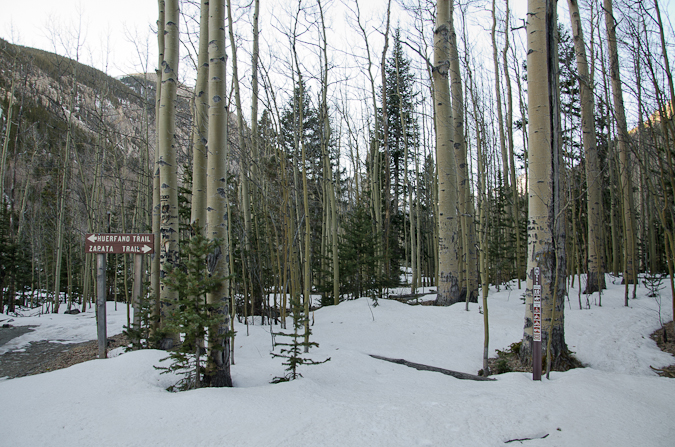
The standard route for California Peak takes you from the road up the Zapata Trail that weaves through the trees and intersects with a high meadow.
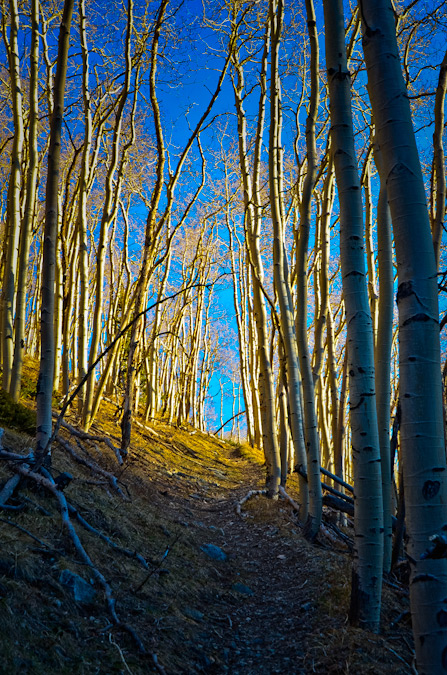
From there, the trail heads even higher on the eastern slopes of California Peak until dropping you onto a gentle ridge at 11,800 ft. From here, the idea is to follow the very long south ridge of California Peak all the way to the top, a ridge walk consisting of about 2,000 ft. in elevation gain over three miles. Our plan was to stick to the standard route as much as possible, taking detours when the trail was lost. As it turned out, the trail was quite visible for most of the hike, until we lost it just after the meadow. From here, we opted to head where we thought the trail went and then straight up a steep gully towards the ridge.
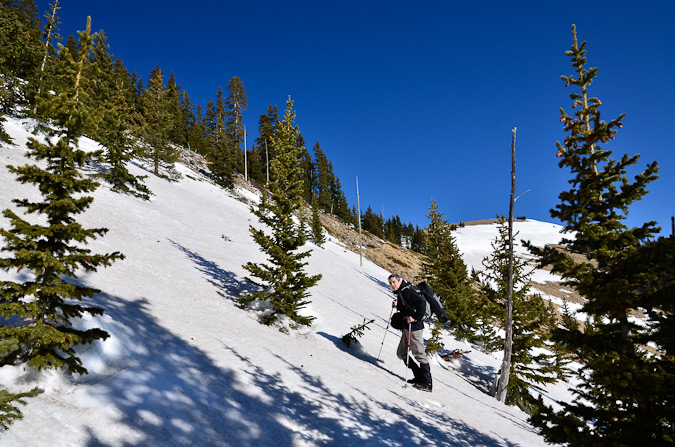
This gully ended up intersecting the actual trail eventually, and so we re-gained the trail and followed it to just below the ridge, where we trodded up a steep snow slop and over a small cornice to reach the ridge and the crazy wind that accompanied it.
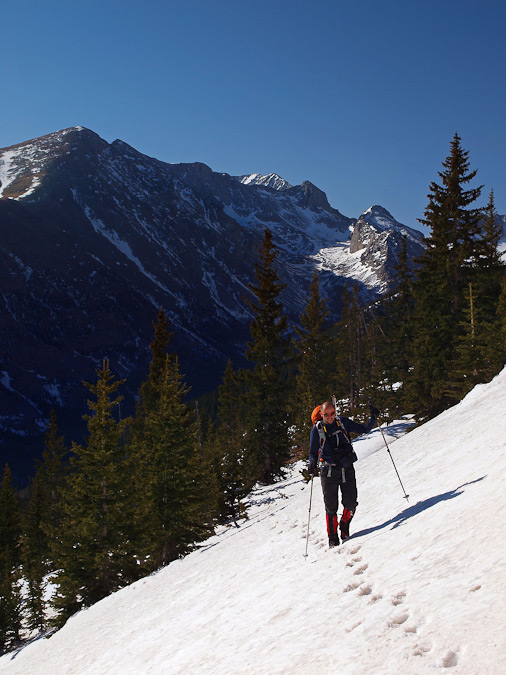
Here is an outline of the route we took for California Peak (click for higher resolution):
The trail offers some pretty nice views of the Huerfano Valley below, including a nice vantage of the Iron Nipple.
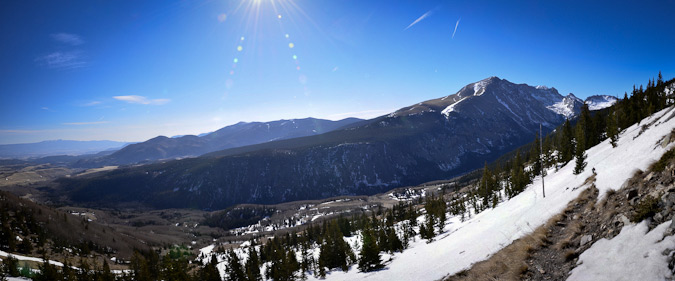
The wind on the ridge was pretty intense. It was not gusty, rather a constant ripping wind that had a biting chill to it. The wind was blowing across the ridge from the west, which explained the relatively little amount of snow on the ridge minus the drifted cornices on the very eastern edges of the ridge.
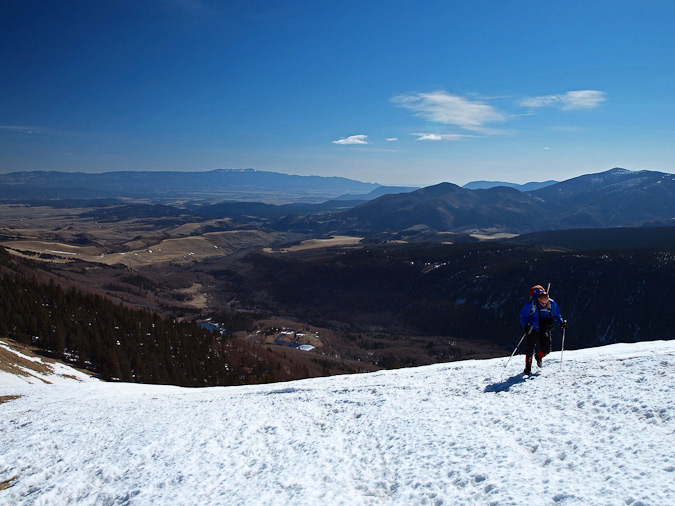
Ethan and I began hiking up the gentle ridge towards what we thought was the summit of Unnamed 13,476. Once we crested it, we realized it was merely one of several false summits leading up to California Peak. While these false summits were constantly demoralizing us, we were pleased and surprised by the breathtaking views of Crestone Peak, Crestone Needle, Mount Herard and the Great Sand Dunes National Park to the north.
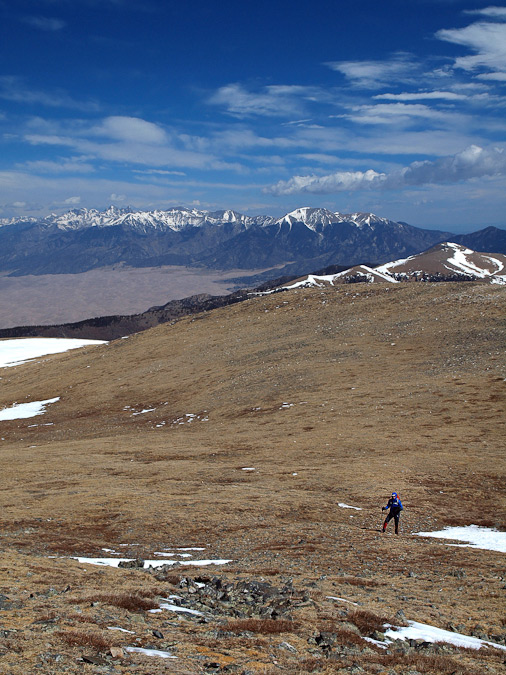

We reached the summit of another false summit and realized that California Peak was a long ways off yet. This ridge was quite a long approach indeed!
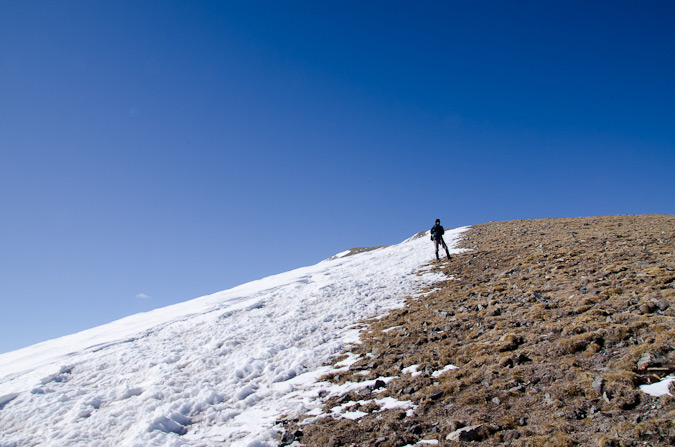
Once we reached the summit of Unnamed 13,476, we needed to stop because Ethan's hands had gone numb. This was surprising to both of us because he was wearing his brand new Marmot Windstopper gloves. Apparently they did not stop the mighty wind of the Sangre de Cristo Mountains. I went into my first aid kit and produced two Hand Warmer kits, one of which I had looted from a geocache find near Mount Shavano in 2009. The kits seemed to help Ethan, so we continued on up towards the next false summit.
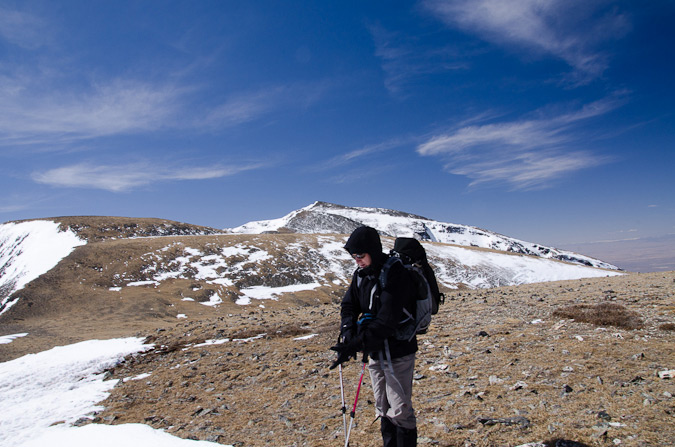
The summit block of California Peak was fairly steep, although nothing too crazy, and we were able to boulder hop our way through the shallow snow and to the summit by noon. Needless to say, the views of Blanca Peak, Ellingwood Point, Mount Lindsey, Iron Nipple and "Huerfano Peak" were outstanding.

It had appeared that no one else had signed the summit register since October, so it was cool being the first to sign it in 2011. We took several picutres and refueled for the descent. Despite the strong and chilly winds, the summit was great. It was awesome to be on my first top 100 mountain of 2011.
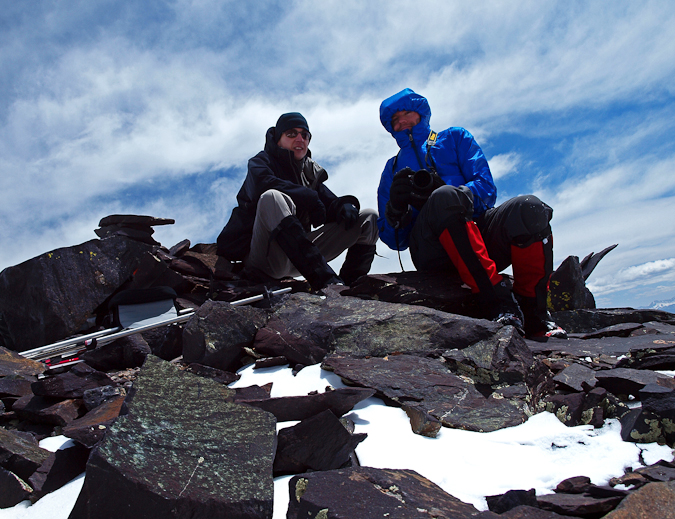
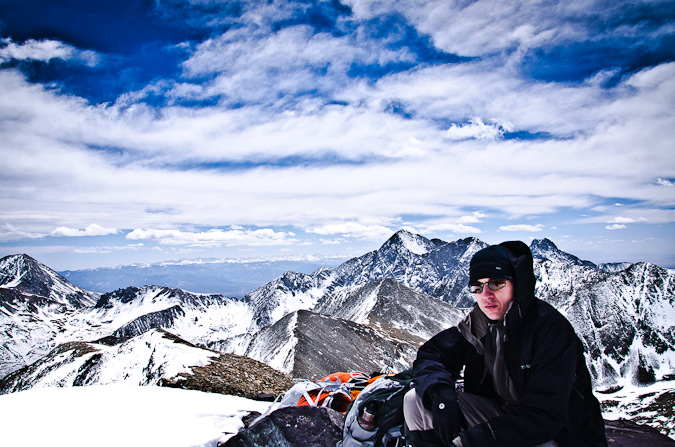
It was also really great to make the realization that I had just completed my 60th highest 100 summit of my life.
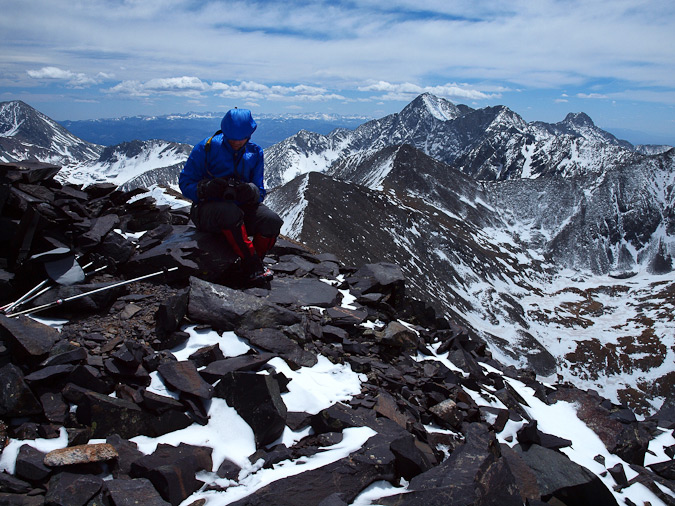
If all goes according to plan, by the end of 2011, I'll have only 15 of the highest 100 left to climb. My life-long dream is coming closer to completion. After soaking in the amazing views from the summit of California Peak, Ethan and I headed back down the ridge, but not before taking a 360 degree panoramic photo set:

Click HERE to view an interactive version of this photo (SMALLER FILE - 1.8 MB).
Click HERE to view an interactive version of this photo (LARGER FILE - 27.1 MB).
I was able to take two more sets of parting shots before we left the ridge, and I was quite pleased with the way in which they both turned out (one is the first photo in this trip report and the other is below).
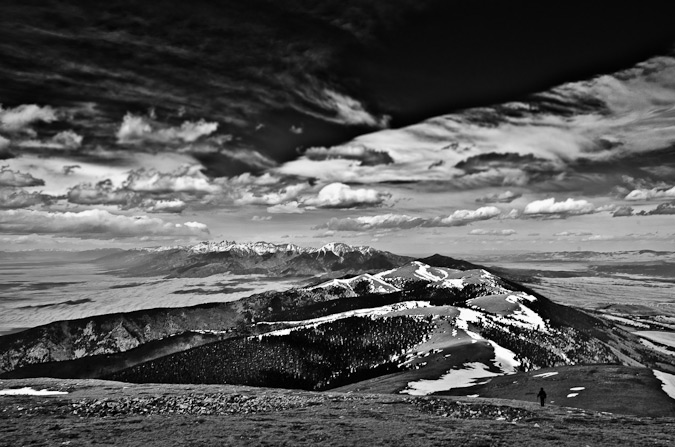
We found our trail in the snow without too much trouble and made quick time back to the road, and eventually, Ethan's car. Here is my favorite shot of Ethan's from the trip:
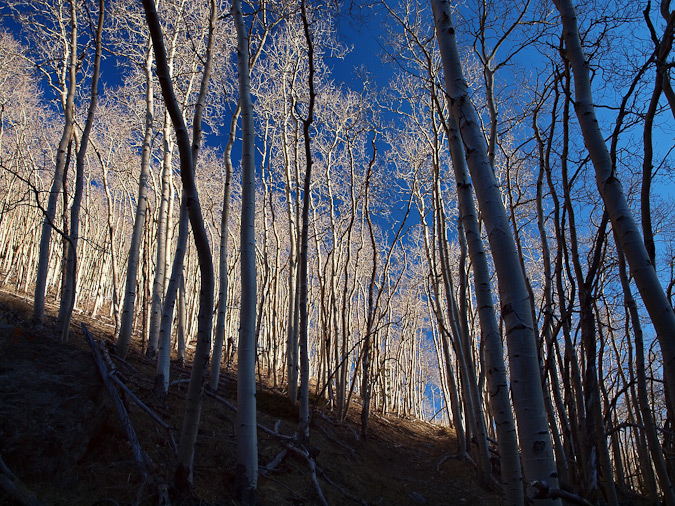
Here are some fun statistics from our hike:
Miles hiked: 11.5 round-trip
Total time: 10 hours
Total photos taken: 190 (far less than usual, despite having the new camera - shooting photos in the wind sucks)
I hope you enjoyed this adventure or that the information was useful for your planned hike of California Peak. As always, you can follow me on Twitter and Facebook. Please also remember, if you're planning on making any camera-related or outdoor-related purchases, use the links found HERE to support this site.
I look forward to your comments or questions regarding the hike or the methods used in any of the photos!
Little Bear Peak: A Slippery Proposition
What an action-packed trip this was! From off-roading one of Colorado's most difficult 4x4 trails to witnessing a full-scale Search and Rescue operation! As if climbing one of Colorado's most challenging 14ers wasn't enough!
To start off, here is a break-down of relevant numbers from this adventure up Little Bear Peak:
Peak summited:
Little Bear Peak: 14,037 ft. (ranked 44th in Colorado)
Total elevation gain: 2,360 ft.
Total distance hiked: 2.54 miles
Total time hiking: Approx. 5 hours
Photos taken: 252
Search and Rescue operations witnessed: 1
Little Bear Peak sits impressively next to Blanca Peak in the Sangre de Cristo Mountains of Colorado and is considered one of the most dangerous and perilous mountains in Colorado due to a section near the top called the Hourglass and the Bowling Alley. In fact, just this year, a climber named Kevin Hayne perished on Little Bear from falling at the Hourglass section. A full report of those events can be found here. For a semi-comprehensive (not regularly updated) list of all accidents on Little Bear, check out John Kirk's site.
Having backpacked the long, steep road from the base of Blanca Peak last year to climb Blanca Peak and Ellingwood Point, I was not looking forward to another slog up the road to climb Little Bear. Fortunately, my college roommate and great friend, David Deramo, was back in the state from his long 2 year stay in Japan. Dave owns one of the most awesome Jeep Cherokees I've ever seen. Dave purchased the Jeep when we were in college in 1999 and has put work into it each year since. It went from a stock 1989 Jeep to an awesome rock-crawling machine over the course of many years. Dave has put a lot of work and time into his Jeep, and I was eager to see what it could do. Dave agreed early in the year to drive up the road with me and attempt to climb Little Bear.
Dave drove down from his home in Winter Park with his Jeep on a borrowed trailer, towed by a borrowed Ford half-ton pickup on Friday, August 6th and stayed the night at my place in Colorado Springs. We woke up at a reasonable time and made the drive over La Veta pass and met up with his friend from Durango, Lance. Lance owns 4x4 & More in Durango, Colorado and specializes in custom 4x4 jobs. His own Jeep, another older Jeep Cherokee, does not look like it belongs on the insane Blanca Peak trail; however, Lance keeps his Jeep looking stock but has some nasty tricks up his sleeve, including air suspension that adjusts using switches in his cab. Lance knows his stuff!
When we arrived at the start of the road and began unloading Dave's Jeep from the trailer, a couple of Search and Rescue (SAR) team-members began to assemble. Apparently someone had an accident on Ellingwood Point earlier in the day. Learning about a SAR mission did not do much to instill confidence in me for our trip up Little Bear.
The drive up the road was fun. Dave's Jeep really performed well. He runs a 5.5 inch lift with 35" ProComp XTerrain tires with ARB lockers and tons of other upgrades. For those not familiar with the road, it is truly one of the most insane roads I've seen. The road itself consists of really rocky terrain with several rock crawling obstacles known as Jaws 1, 2, and 3. Dave made Jaws 1 look like a bump in the road.
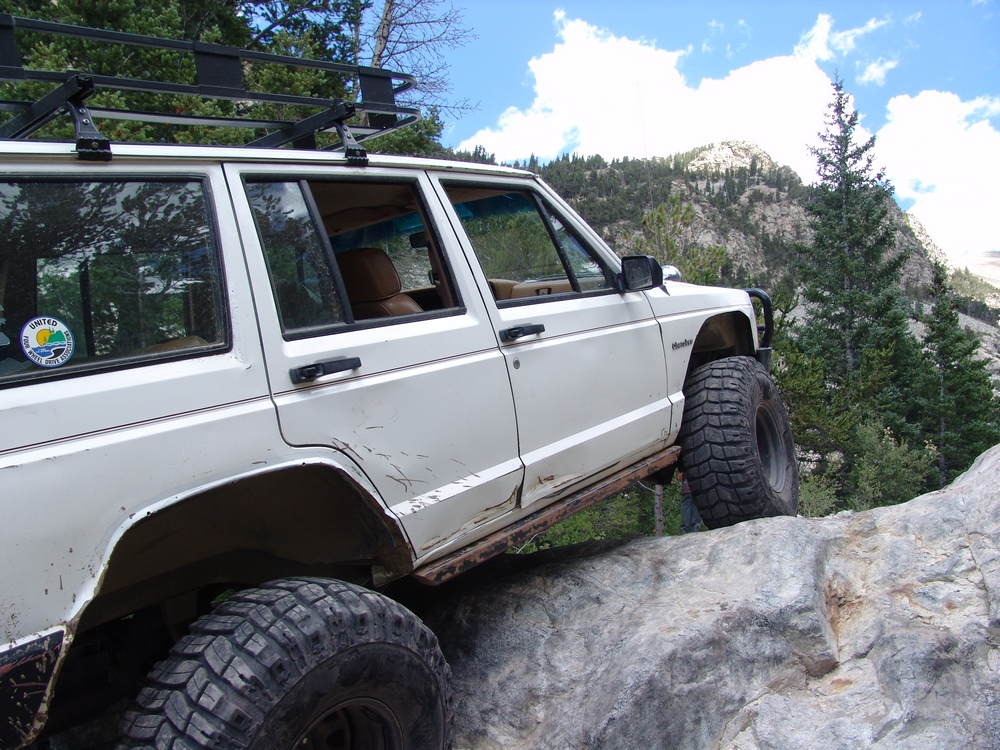
Jaws 1.
Jaws 2 is somewhat scarier, due to its off-camber feel and the considerable risk for tumbling off the side of the mountain. Dave needed a couple of attempts, but also made Jaws 2 look pretty easy. Lance's seemingly unfit Jeep also did great over Jaws 2, much to my surprise. Lance's Jeep is such a sleeper - it looks completely incapable of doing these obstacles, but the tricks he can pull make him just able to make it over the problems.
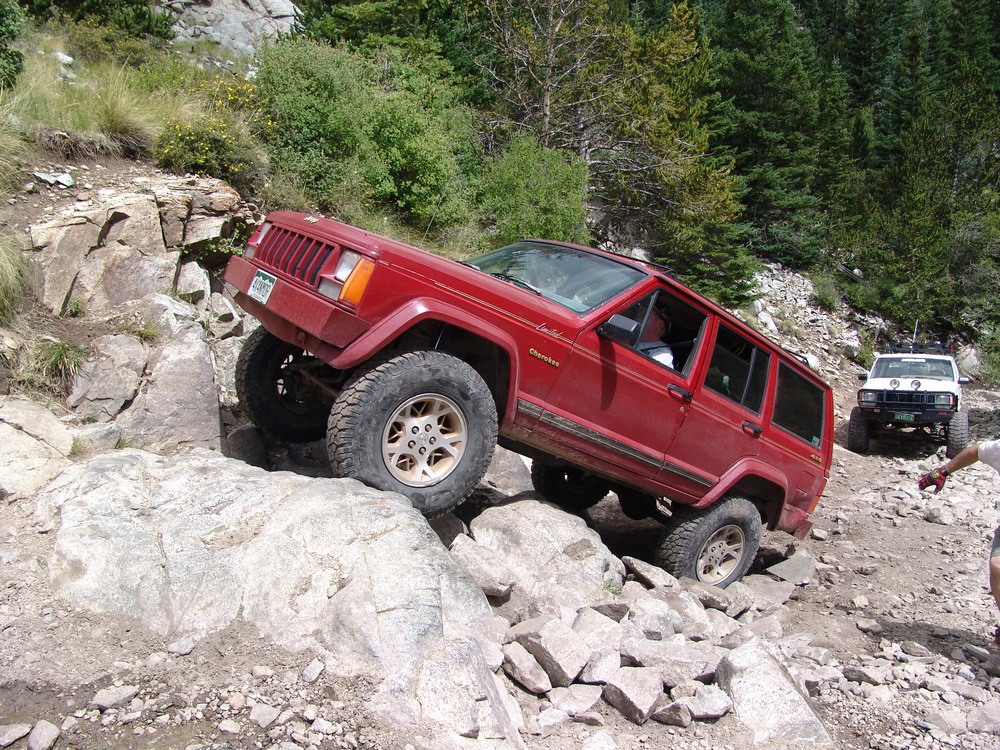
Lance makes it over Jaws 2 in his stock-looking Jeep Cherokee. Lance is a total off-roading master.
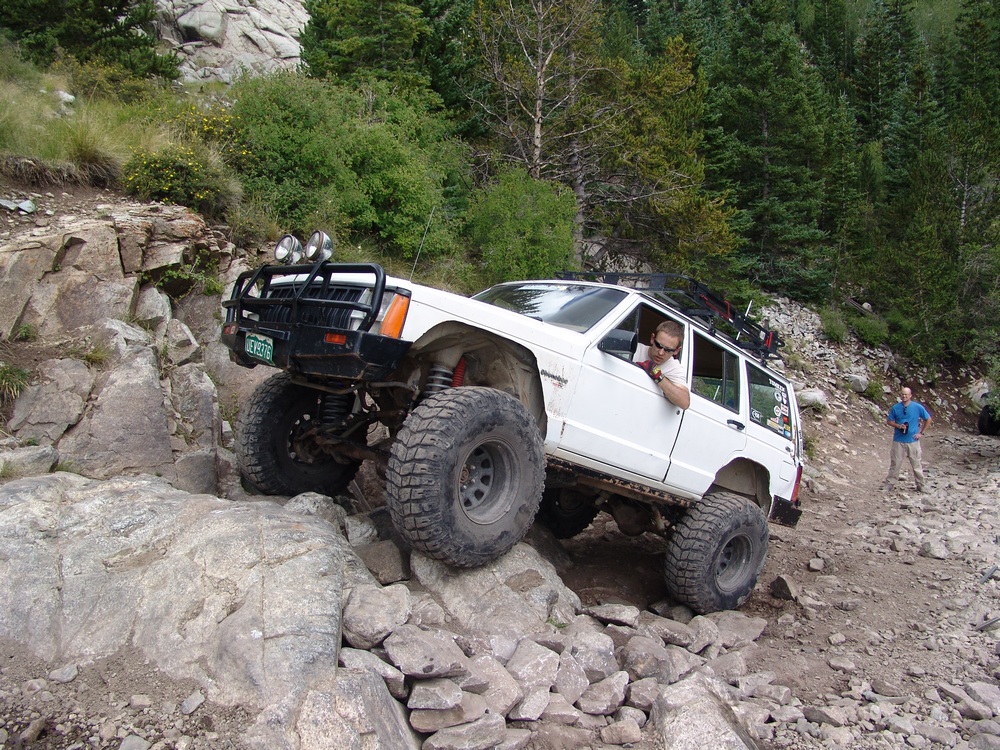
Dave heads up Jaws 2.
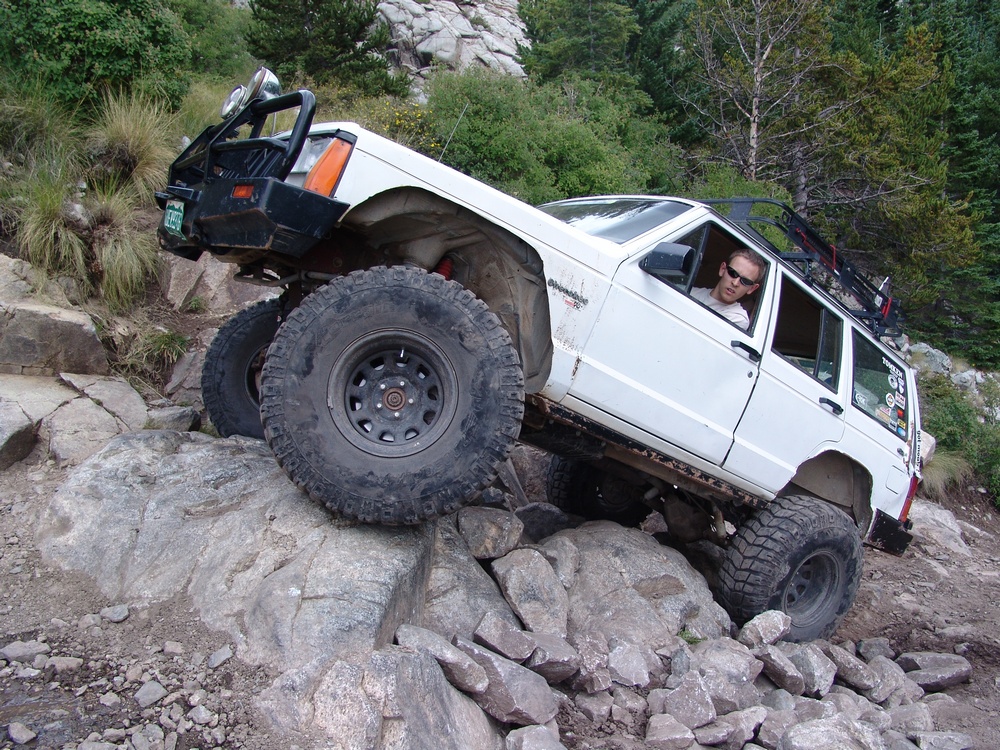
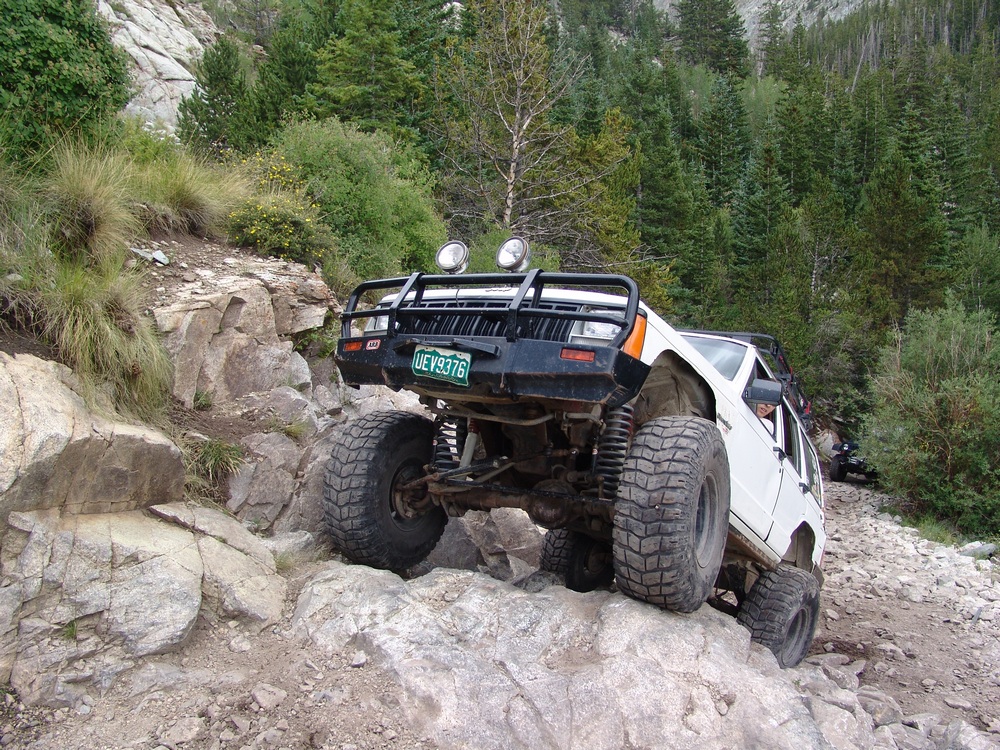
Jaws 3 is a little different than the other two obstacles, having a trickier line than the other two. Most consider Jaws 3 to be the hardest obstacle.
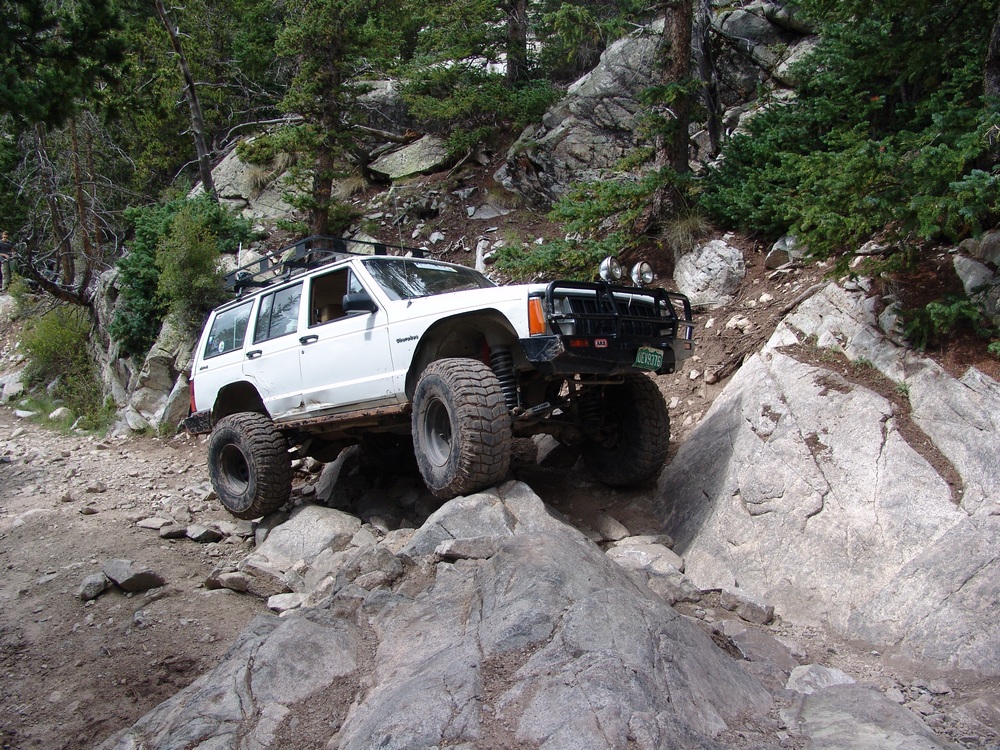
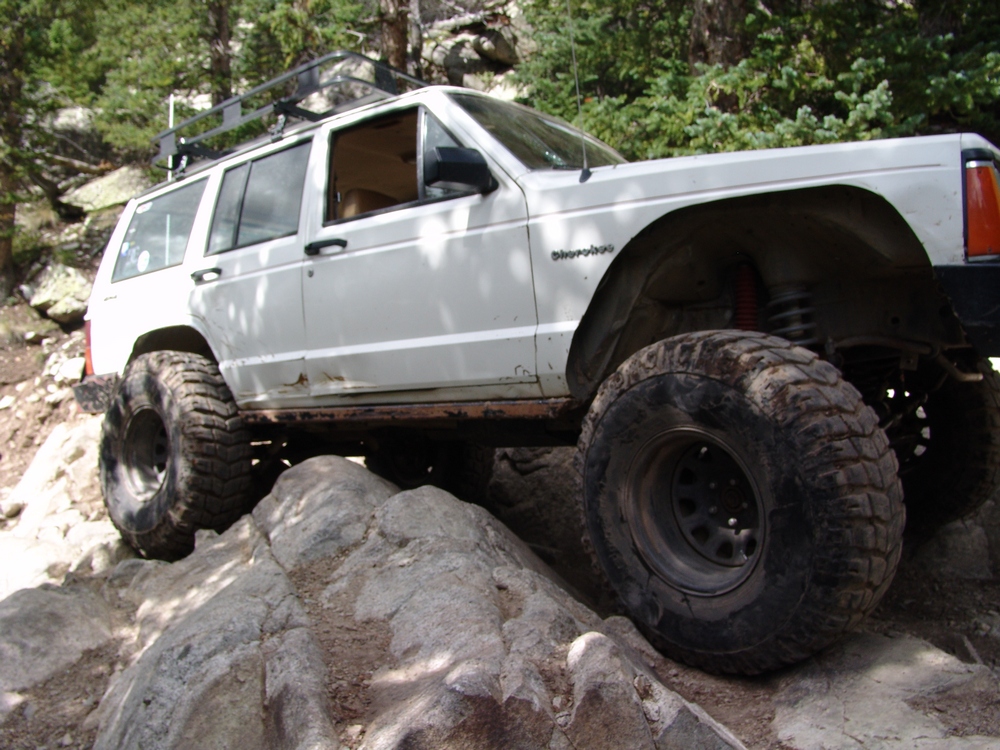
Once over Jaws 3, we were at Lake Como. Lake Como had many 4x4 vehicles parked at it and many campers lined its shores. We aimed for the south-eastern shore to look for camping and enjoyed the views of Little Bear Peak.
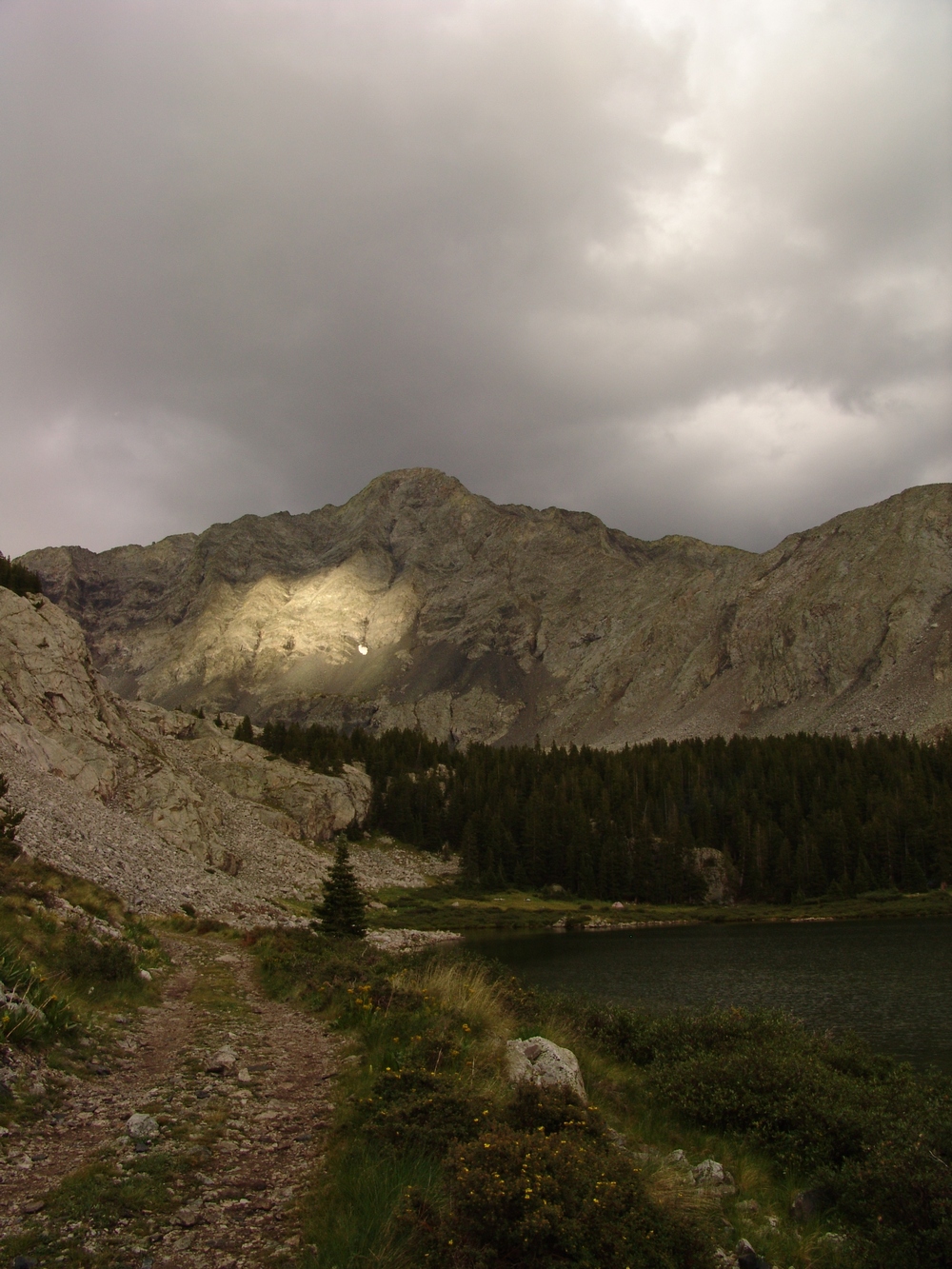
A spotlight shines on Little Bear Peak
We found a great campsite at the far end of the lake and unpacked our gear and made camp. A couple of guys in a Jeep Rubicon also joined us at our camp site. They were also planning on climbing Little Bear Peak, so it was a natural fit. Once our camp was made, we all drove up the road to see if we could complete the final obstacle. It was no problem for our group and we easily made it to the end of the road past Blue Lake. As soon as we arrived, the weather turned nasty, with hail and rain pounding the area. A couple of SAR team members, George and Stefan, approached Dave and I and asked us if we could give them a ride down to Lake Como. George and Stefan were really friendly guys and conveyed the SAR situation to us. A woman with Epilepsy had suffered a seizure and later dislocated her shoulder from a fall. Her injuries were severe enough to merit SAR extraction due to her pain. The entire story can be found on the link above or in the trip report posted by someone involved. It really is a fascinating tale that many mountaineers can learn from.
Here are the lessons I personally learned from the SAR incident: 1) Be sure to find out if your hiking partner(s) have a medical condition. If they do, learn about how it afflicts them and how to treat it. Additionally, make sure your group agrees on the rules of engagement - how you will handle an emergency. These are important things to consider before hiking with others, especially strangers. 2) If you have a medical condition - please disclose it to your fellow hikers before they agree to hike with you. Fully disclosing this to your partners is only fair and offers them the opportunity to learn more and to decide if they want to take on the risk of accompanying you on the hike. If your medical condition worsens while climbing, please turn-around and head back to camp before the situation worsens and SAR is called.
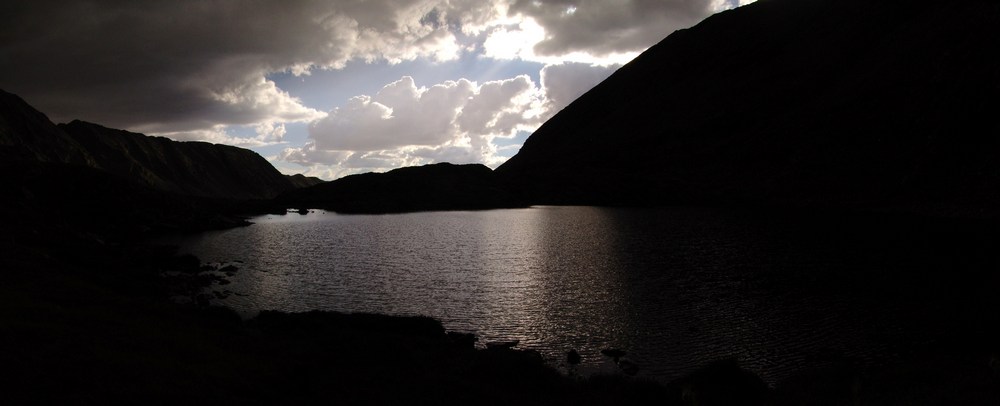
Blue Lake before the storm

Blue Lake during the storm
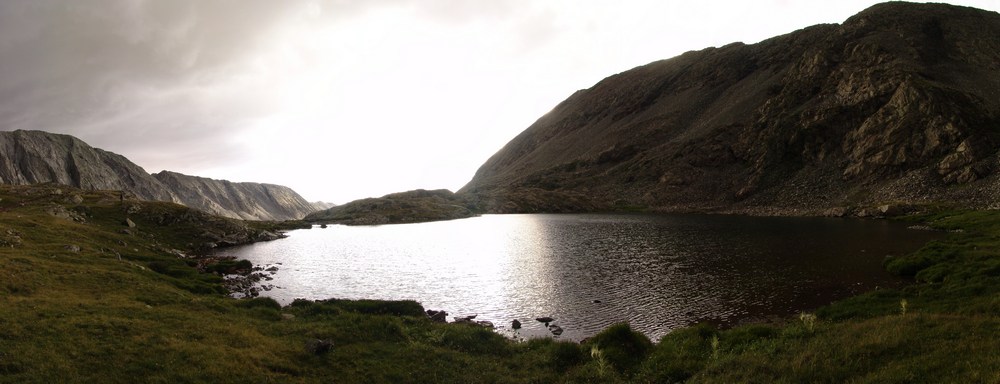
Blue Lake after the storm

The waterfall seen above Blue Lake, just before the headwall of Blanca Peak.
Dave and I returned to camp and ate dinner. Our group spent some time around a camp-fire, exchanging stories with some hikers that had came down from helping the SAR team. Dave and I eventually crashed and set the alarm for 4 AM. Given that there was a lot of lightning and rain that night, we wanted to get an early start on Little Bear.
We woke up at 4:30 after mashing the snooze button a few times and set away for the Little Bear turn-off at the top of the hill above Lake Como. We scrambled the boulders and made our way up the very steep gully leading to Little Bear's ridge. Caution should be taken in this gully, as the rock is loose. We made quick work of the gully and stopped to take some photos.
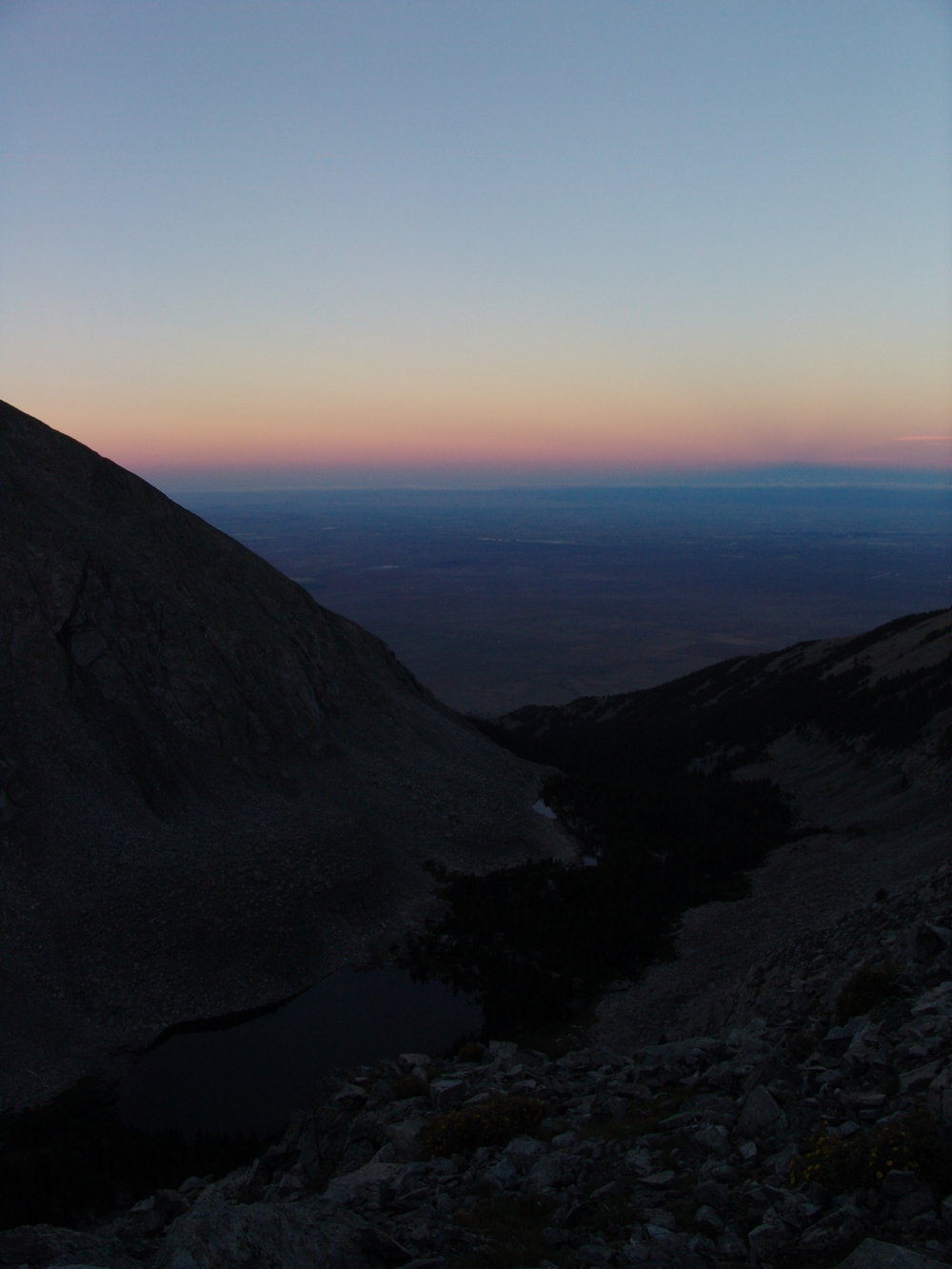
Looking west towards Alamosa.
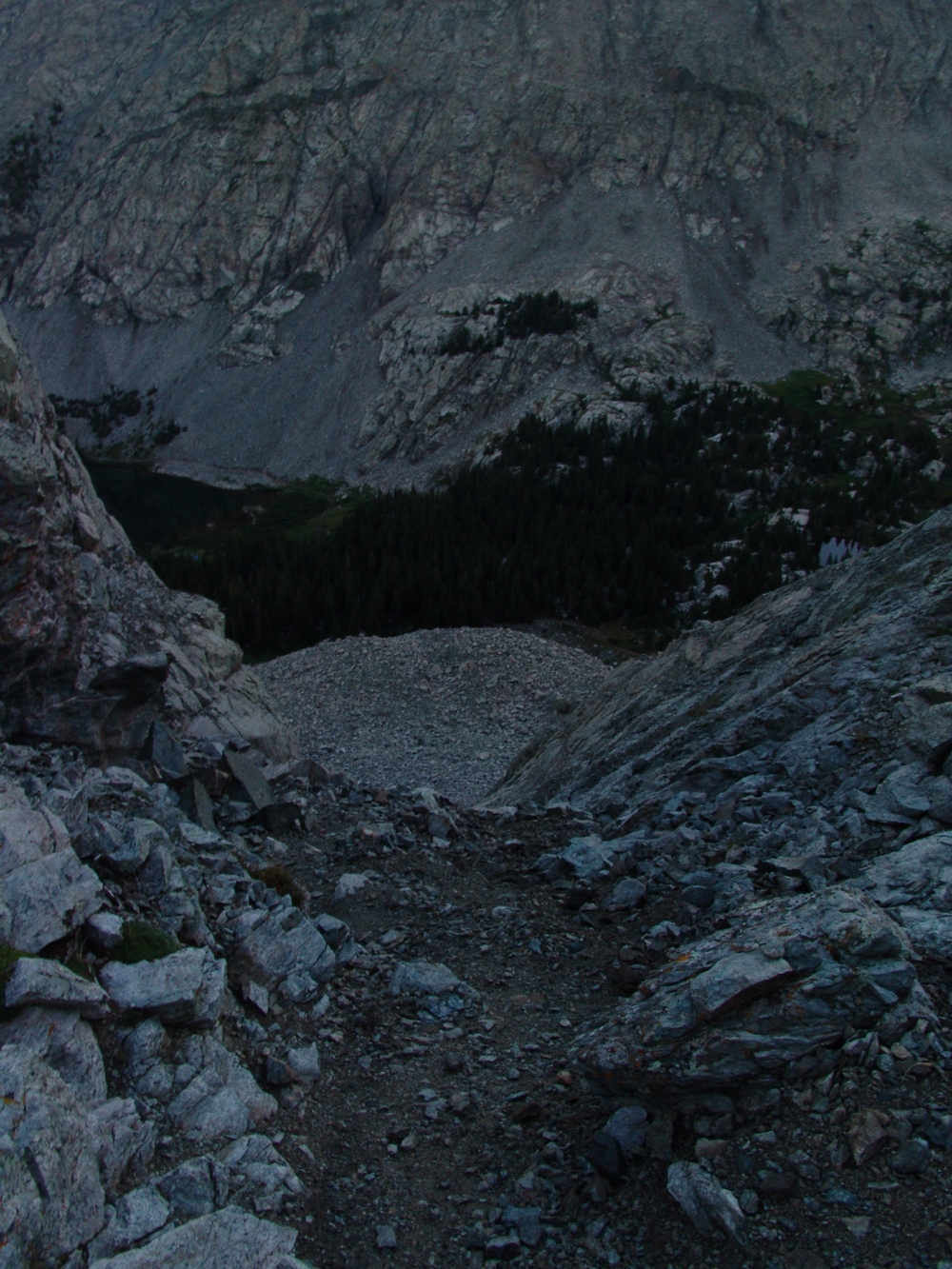
The steep gully leading to Little Bear's ridge.
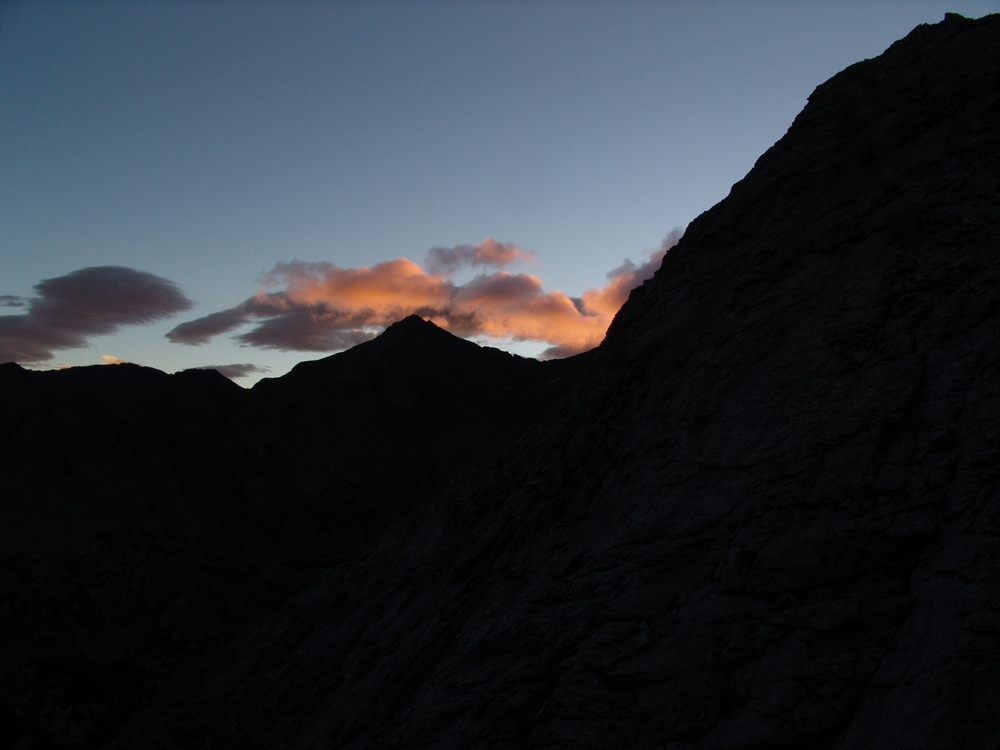
Ellingwood Point at sunrise
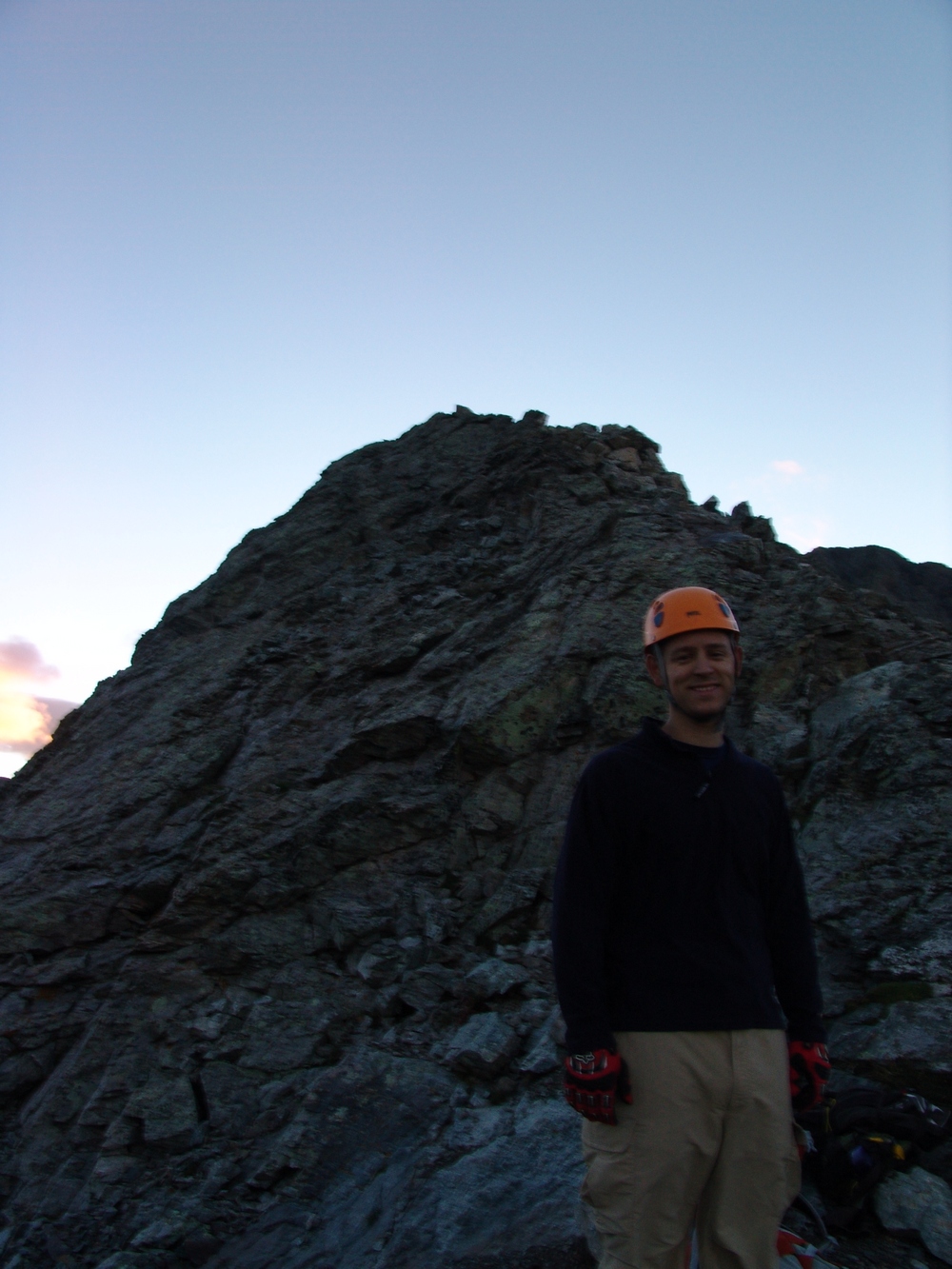
Dave at the top of the gully.
We made our way across the mountainside, just below the ridge towards Little Bear. The trail is faint but well-marked by cairns and is easy terrain. We reached about the half-way mark from the gully and Little Bear and gained our first great views of Little Bear.
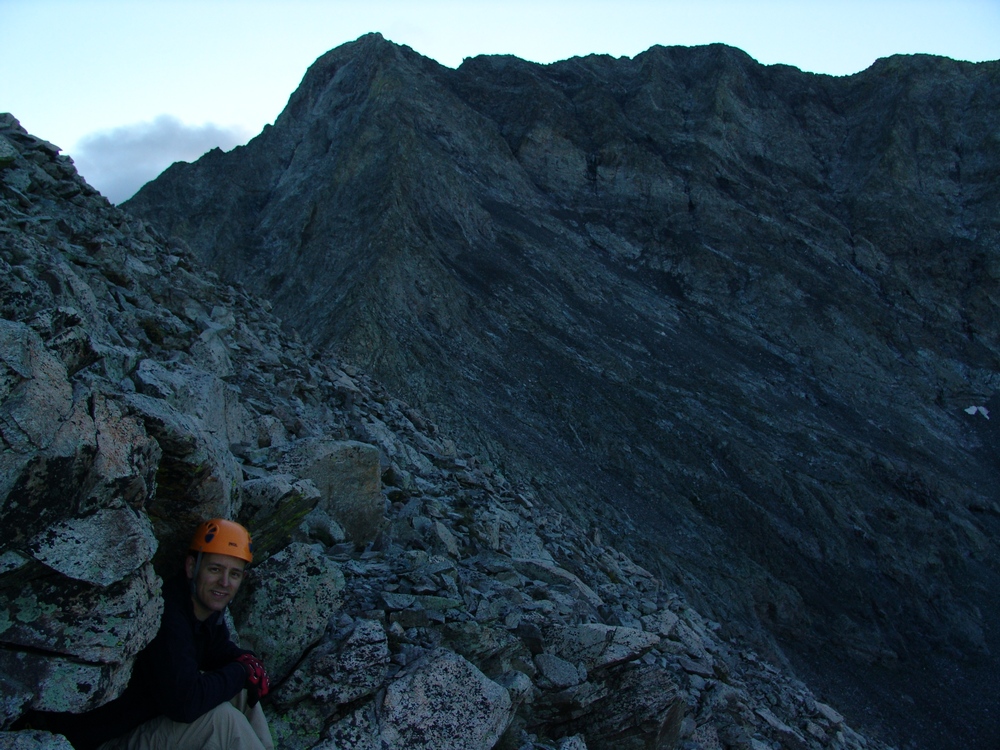
Dave takes shelter with Little Bear's impressive face behind him.
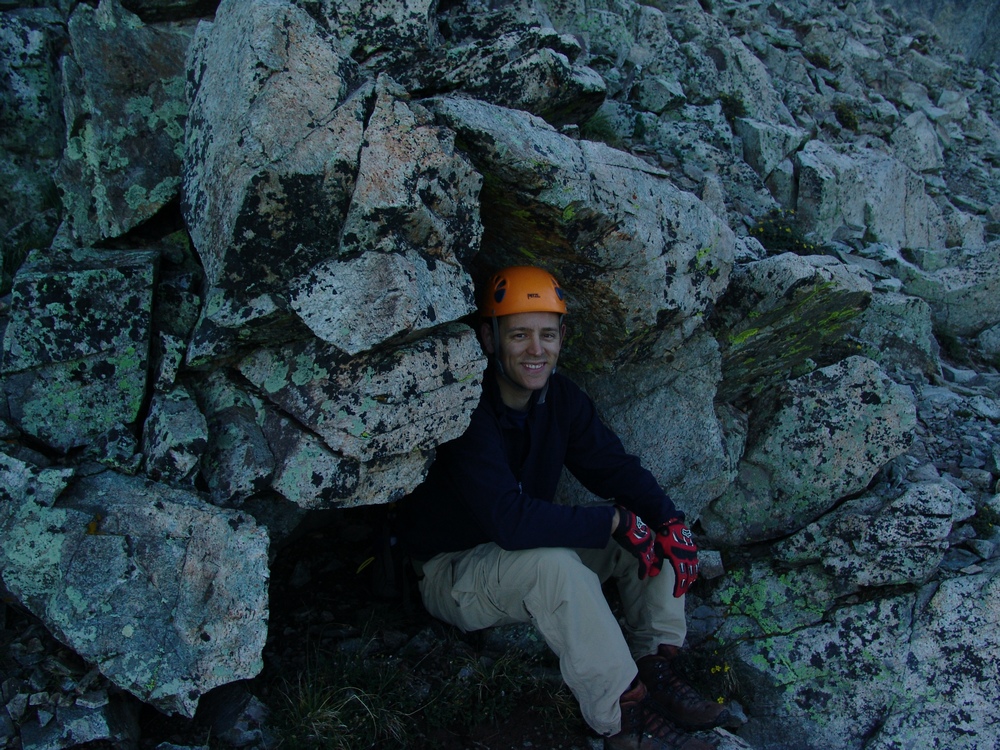
Dave's Cave.
We quickly made our way to the base of Little Bear and were greeted by the famous Hourglass. The Hourglass is the deadliest section of this climb, for obvious reasons. Water runs down the center of this narrow and steep gully, forcing climbers higher to the left in order to get past the start of the gully. The whole section above the Hourglass is referred to as "The Bowling Alley," since rocks kicked down from above are all funnelled inwards, creating a dangerous situation for those climbing up. Since we wanted to avoid rockfall from above, we were glad we got up early and were the first to reach the Hourglass. Since it had rained a lot the night before, the rocks everywhere in the Hourglass were wet. We were able to find some patches of dry rock and slowly and meticulously made our way up the gully.
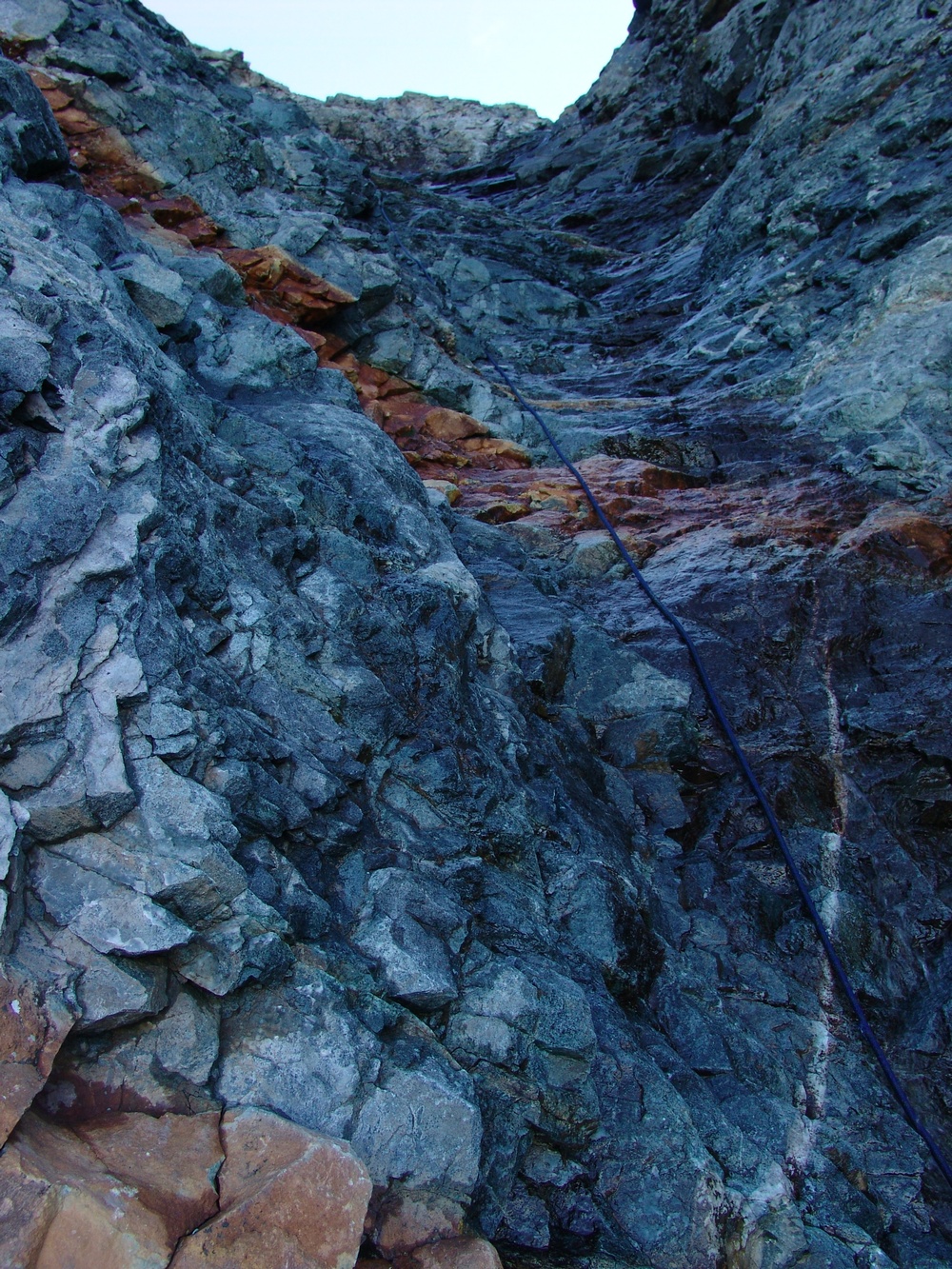
The Hourglass.
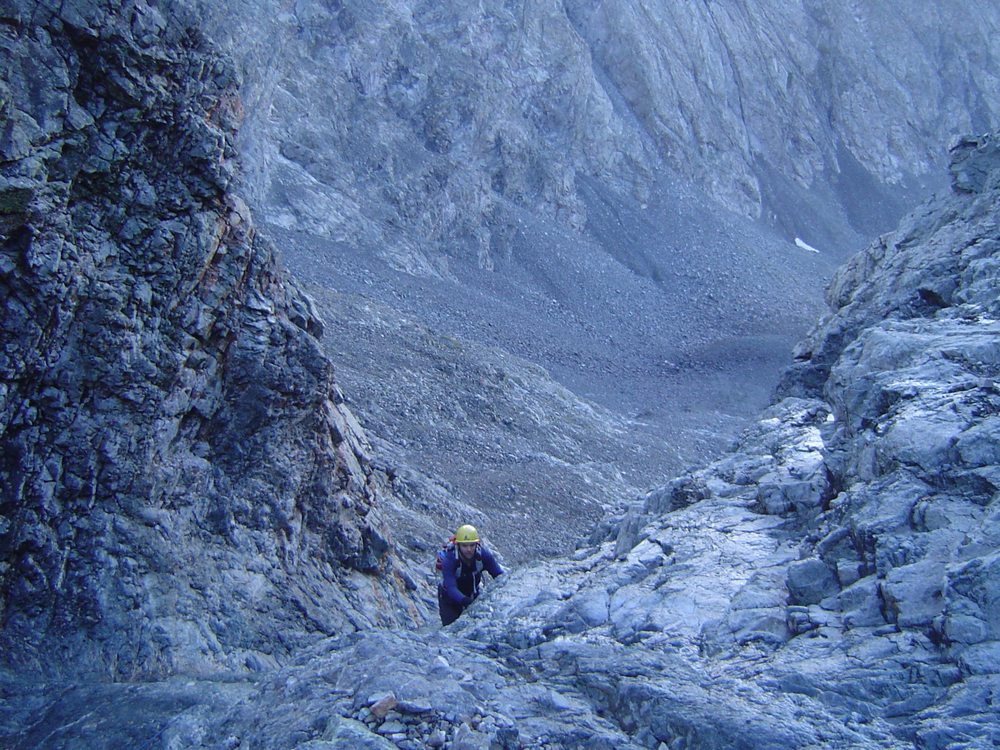
Matt Payne ascends the Hourglass. Note the steepness and wetness of the rock. Handhold and foothold selection was paramount to success.
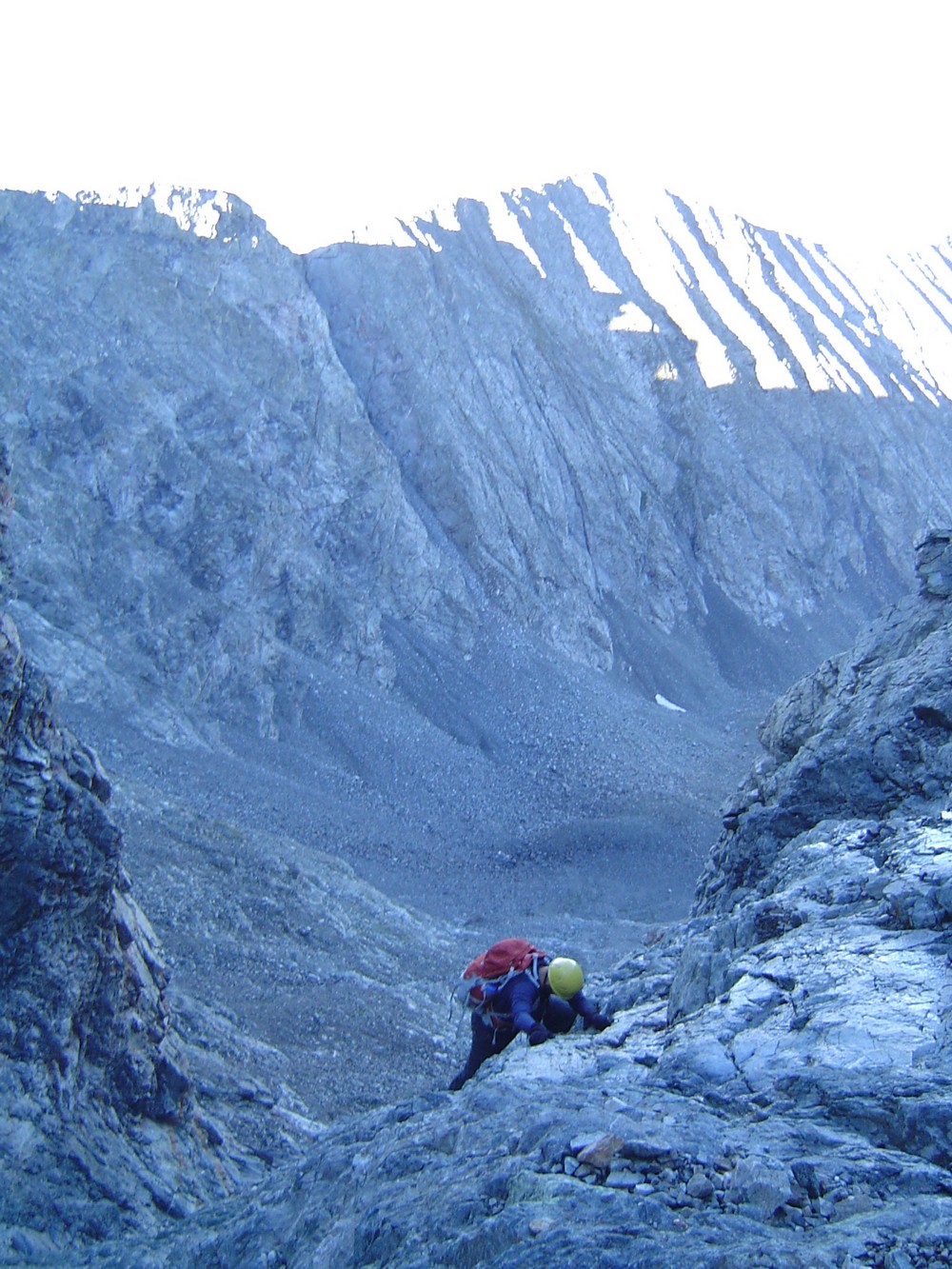
A fall here would have been fatal. Take caution!
The first 10 - 20 feet of the Hourglass are scary. Holds are minimal and the rock is wet. Extra special caution should be taken here and only those comfortable climbing class 4 and class 5 terrain should continue. If you're afraid of heights, this is not for you. Routefinding in the Hourglass was fairly difficult. The rocks were all wet and dirt was loose, making our climb upwards a slow and calculated process. We were eventually able to find some cairns to the left of the Hourglass and make our way up to the summit. The summit itself provided insane views of Blanca Peak, Ellingwood Point, the Spanish Peaks, Mount Lindsey, and the rest of the Sangre de Cristo Mountains.
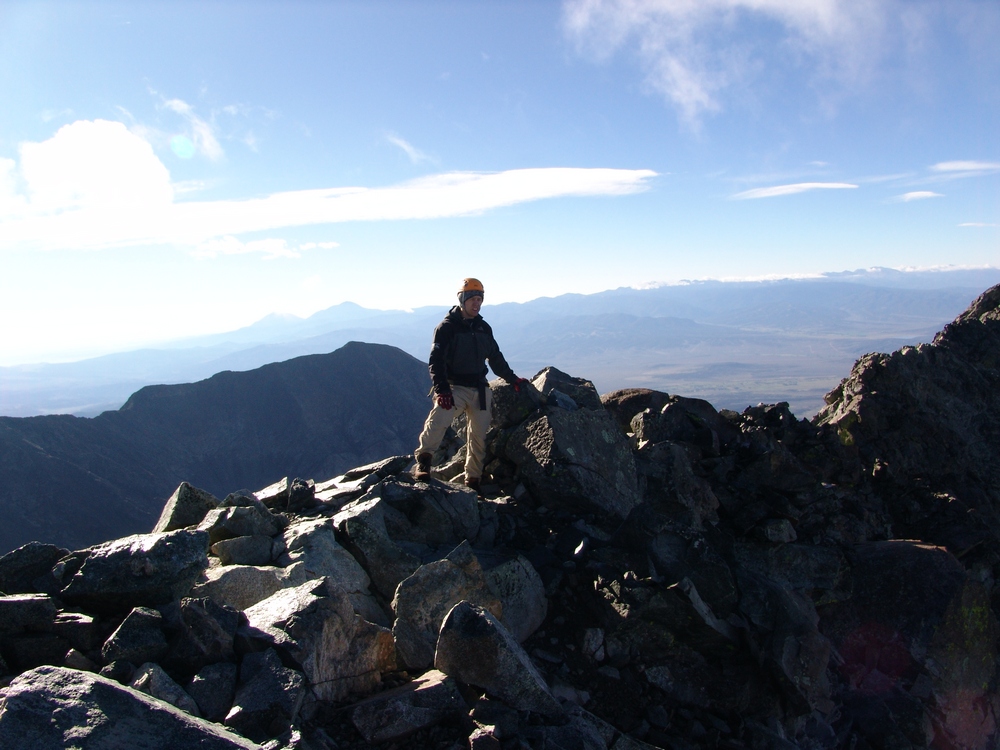
Dave tops out on Little Bear's summit.
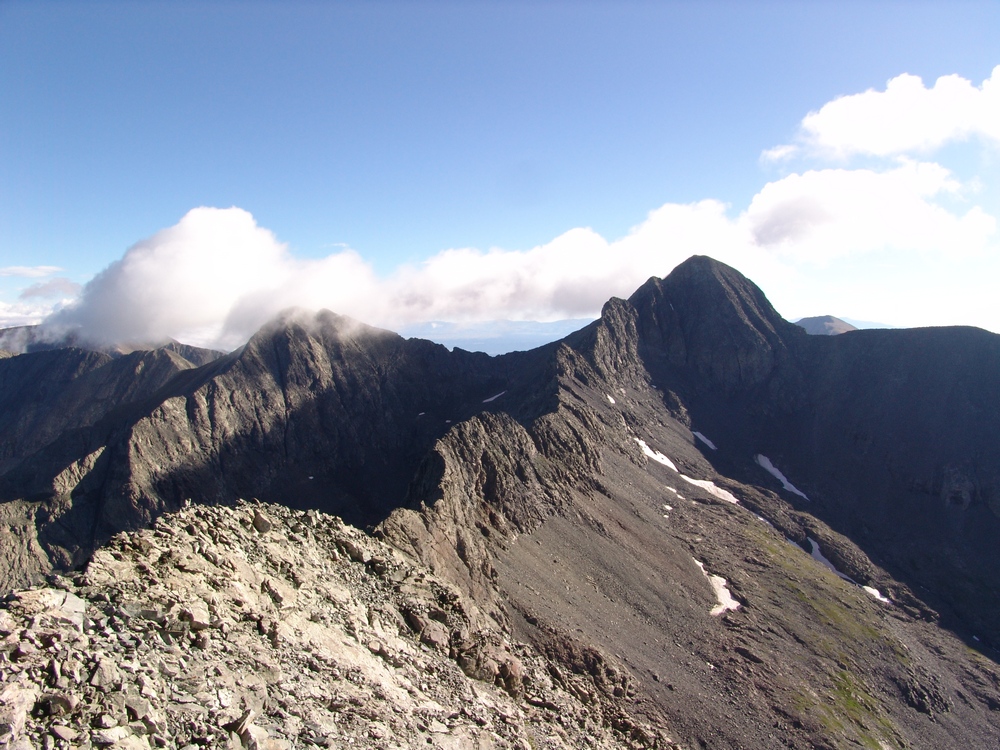
A great view of the connecting ridge between Little Bear and Blanca Peak. The traverse between Blanca and Little Bear is considered one of the most difficult in the State of Colorado.
A 3600 panoramic photo from the summit of Little Bear Peak - click on photo for full resolution version.
We also got to witness the SAR extraction of the injured climber.
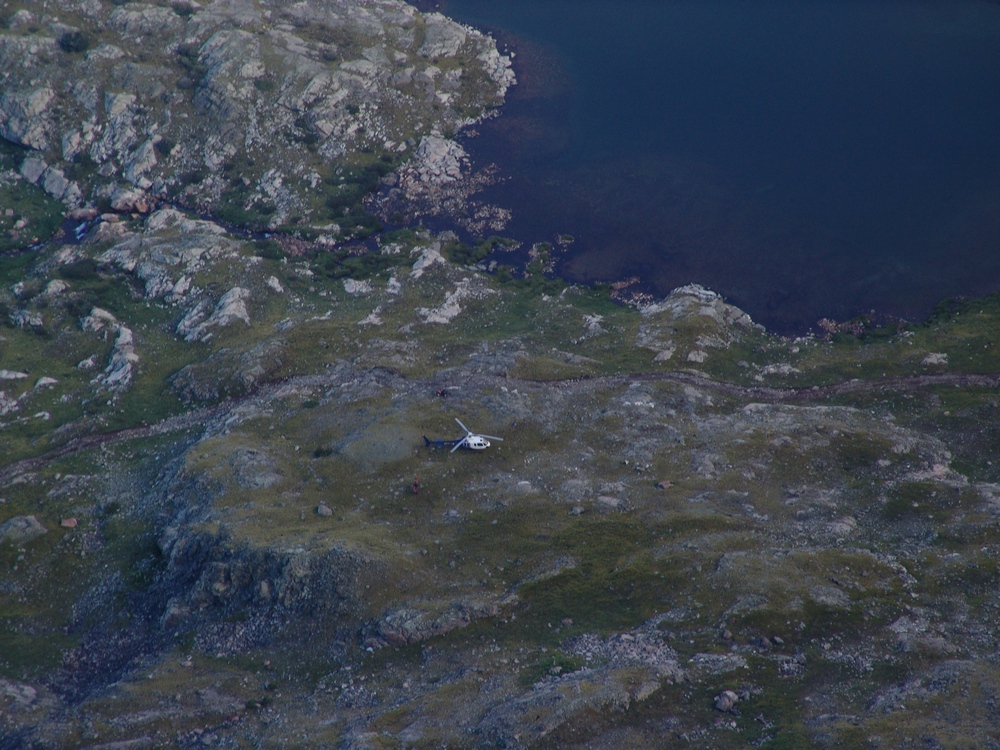
Flight for Life rescues an injured climber.
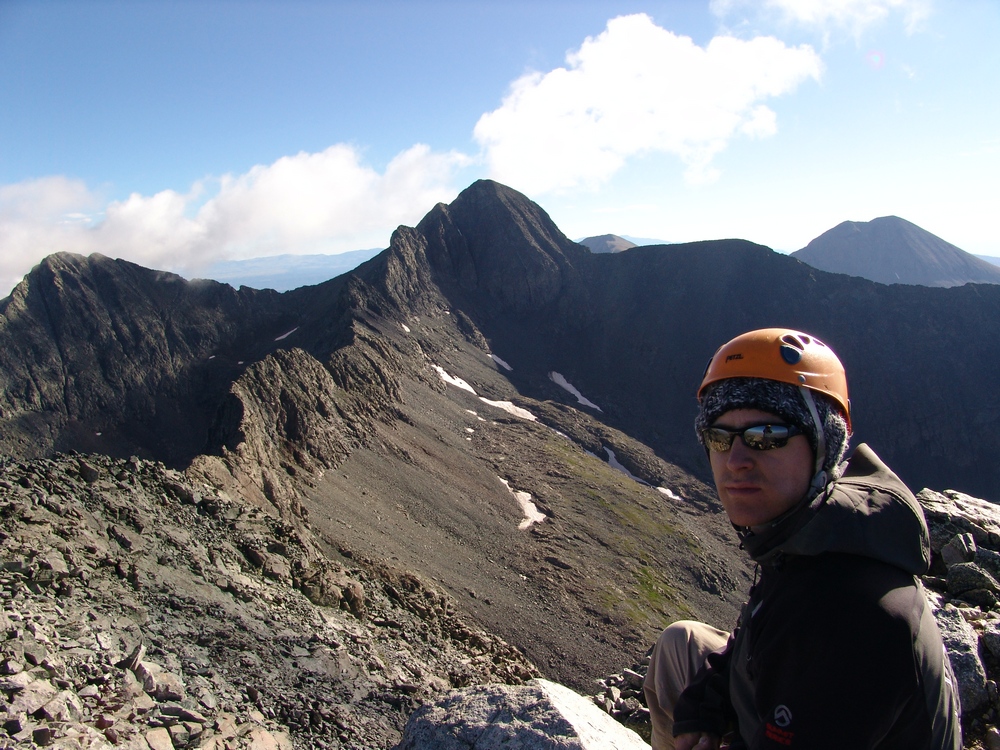
Dave on the summit of Little Bear.
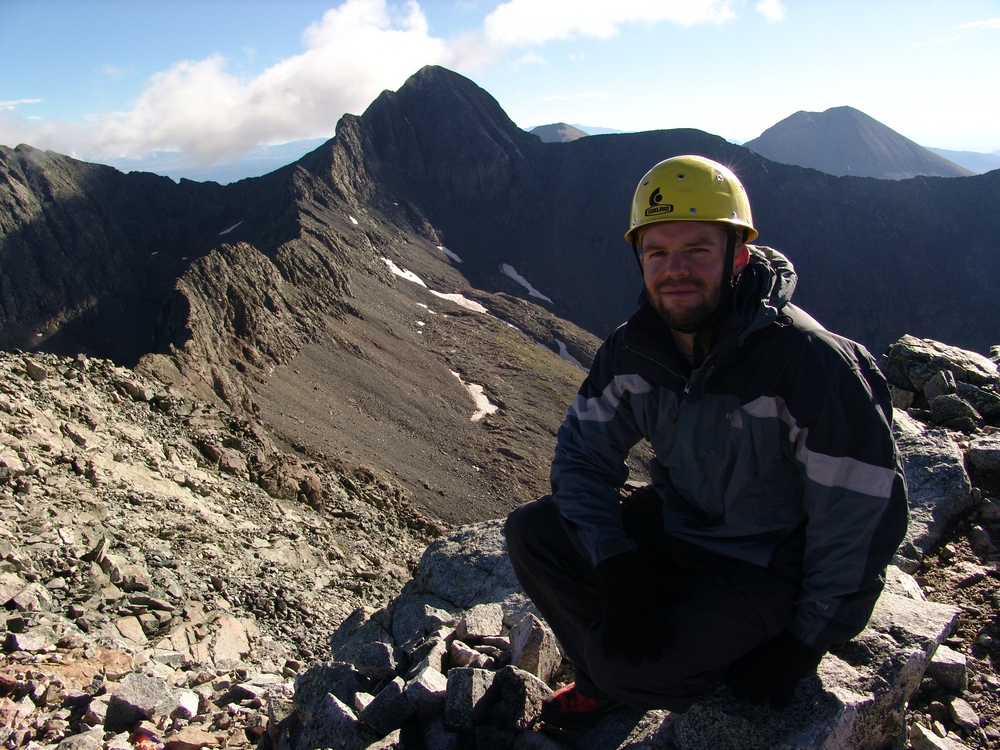
Matt Payne on the summit of Little Bear.
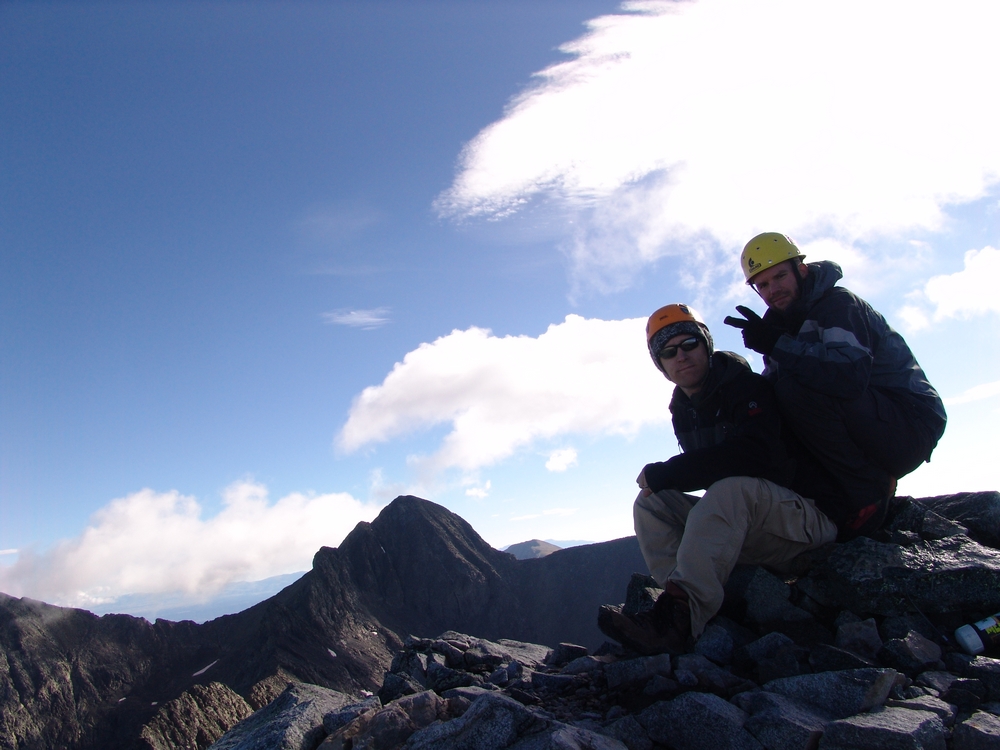
Matt and Dave on the summit - using a self-timer.
One of the neat things you can see from the summit of Little Bear is the crop circles down in the San Luis Valley.
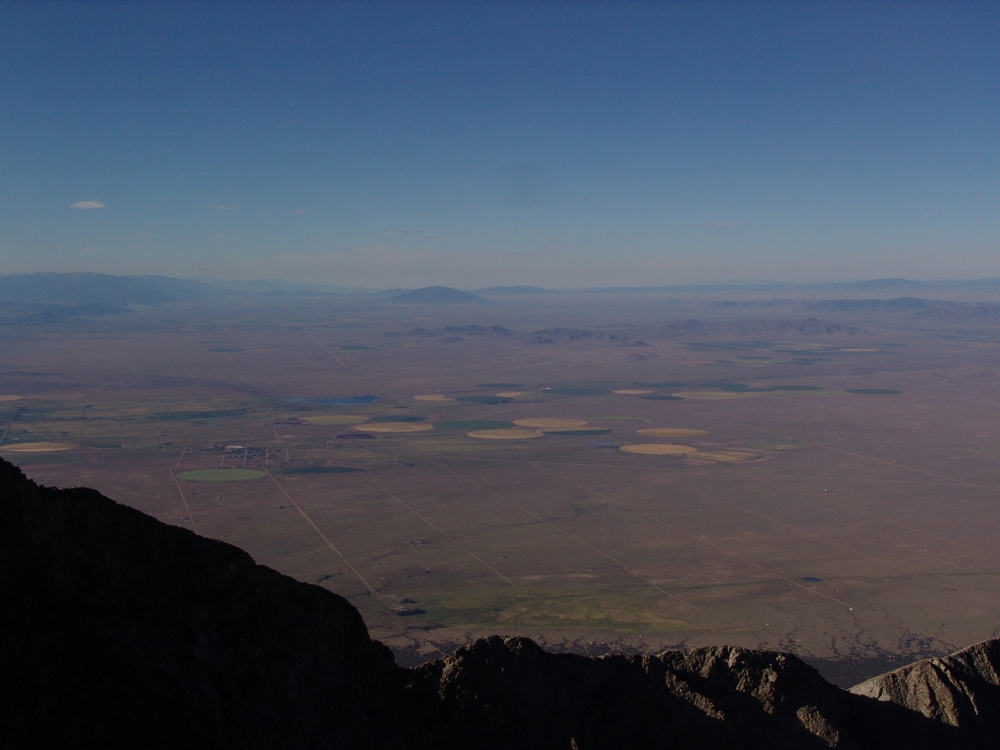
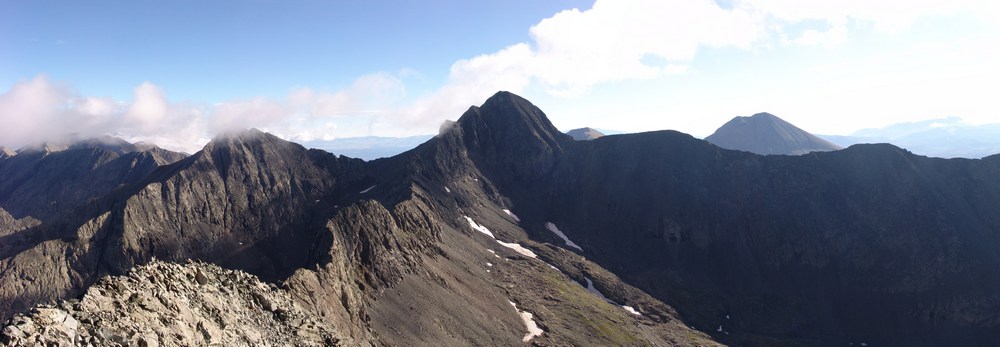
Clouds roll over Ellingwood Point and Blanca Peak.
A group of two climbers joined us on top for a short time and we all agreed to down climb together, as to avoid rockfall.
The wind was quite chilly on the summit, so we departed after spending no more than 30 minutes on top. The four of us made our way down to the start of the roped section of the Hourglass. I was concerned with how this was going to work, given the steepness and wetness of the rock here. Our plan was to use the rope as a handhold and slowly descend while facing the rock, one at a time. The process turned out to be quite the success, as none of us slipped or had difficulty making our way down the roped and scary section.
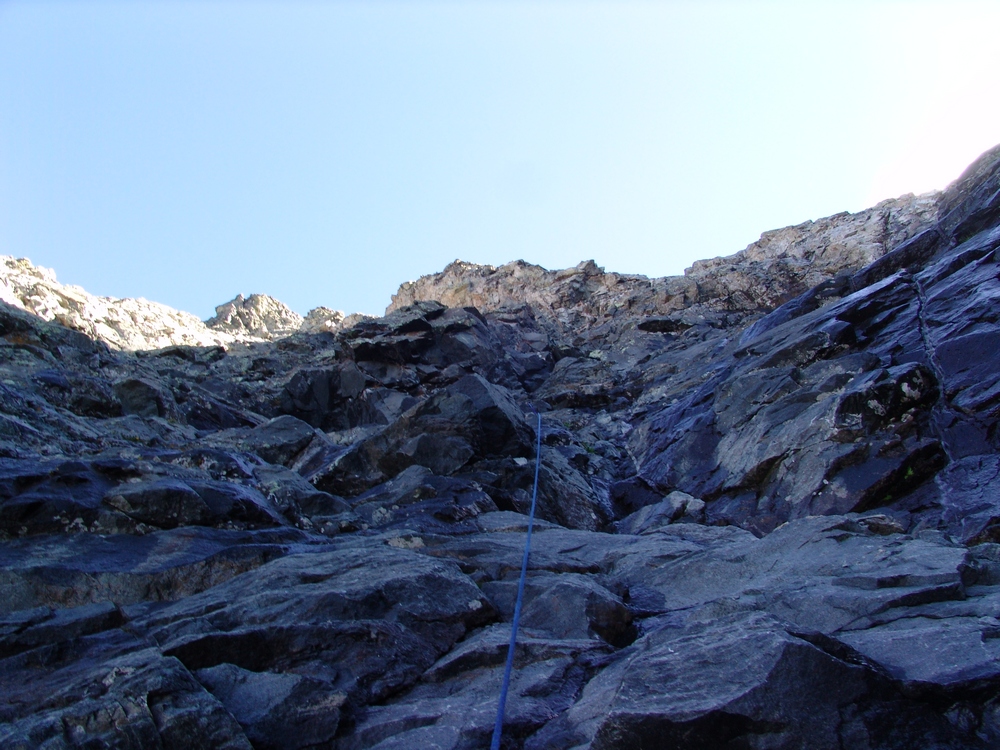
Looking up at the fixed rope in the Hourglass
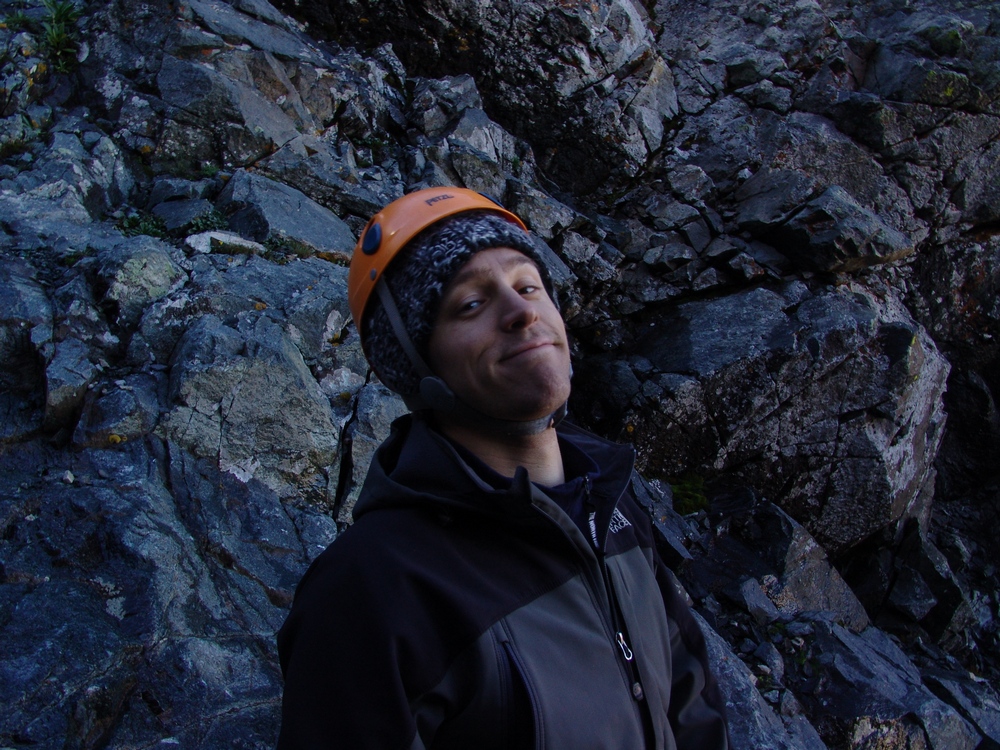
Dave is ready to downclimb the Hourglass.
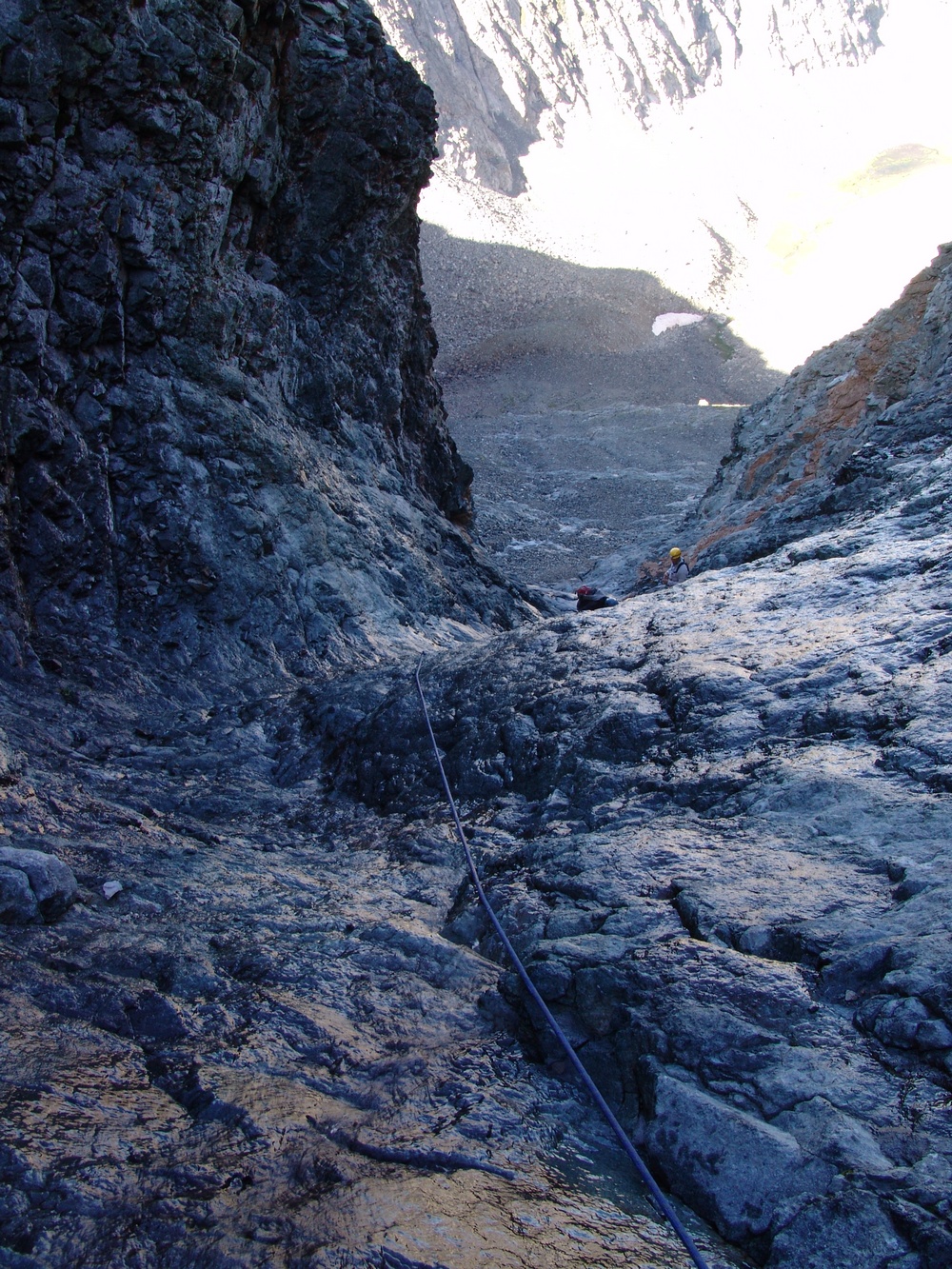
Looking down the Hourglass and the wet terrain.
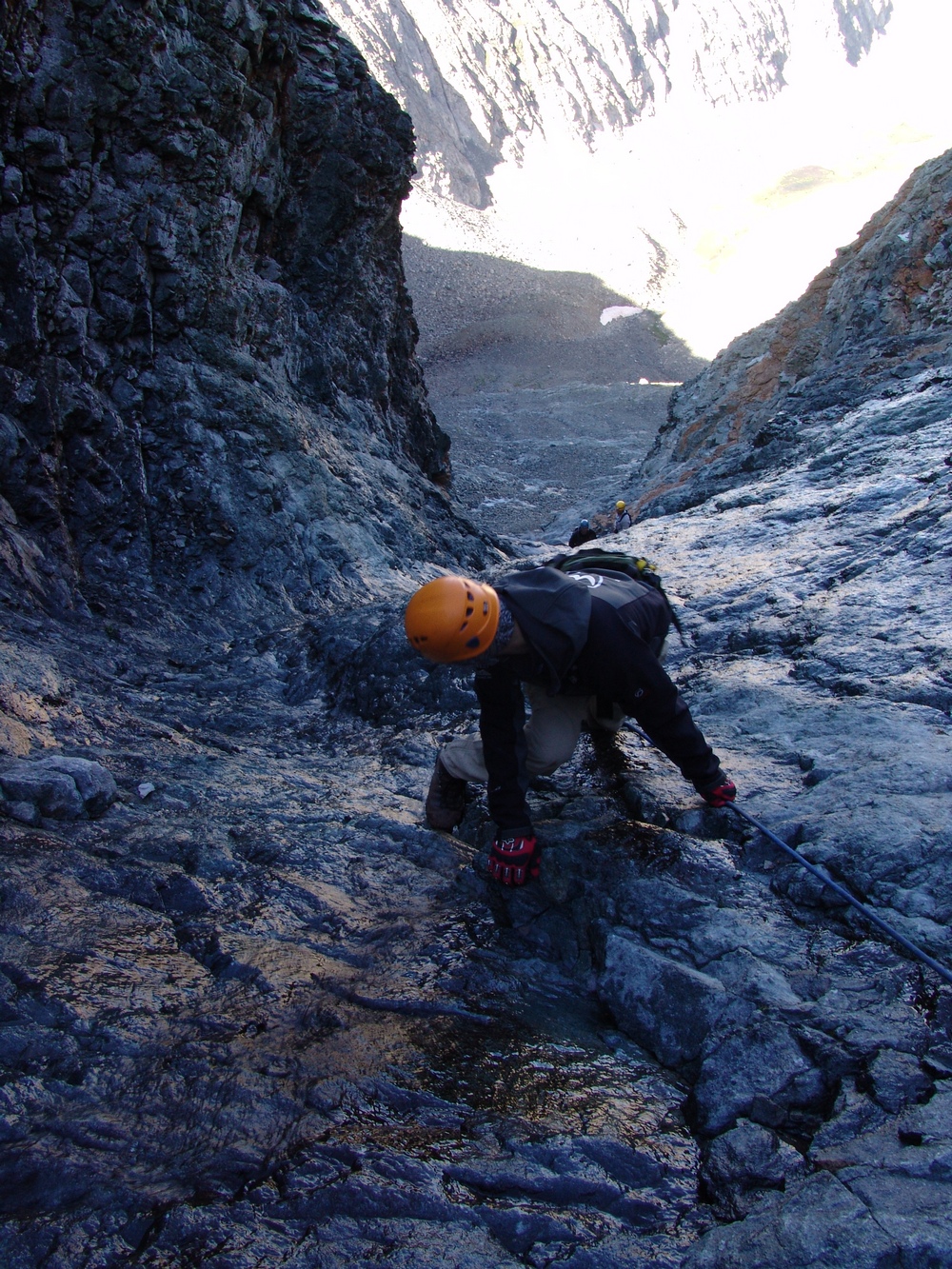
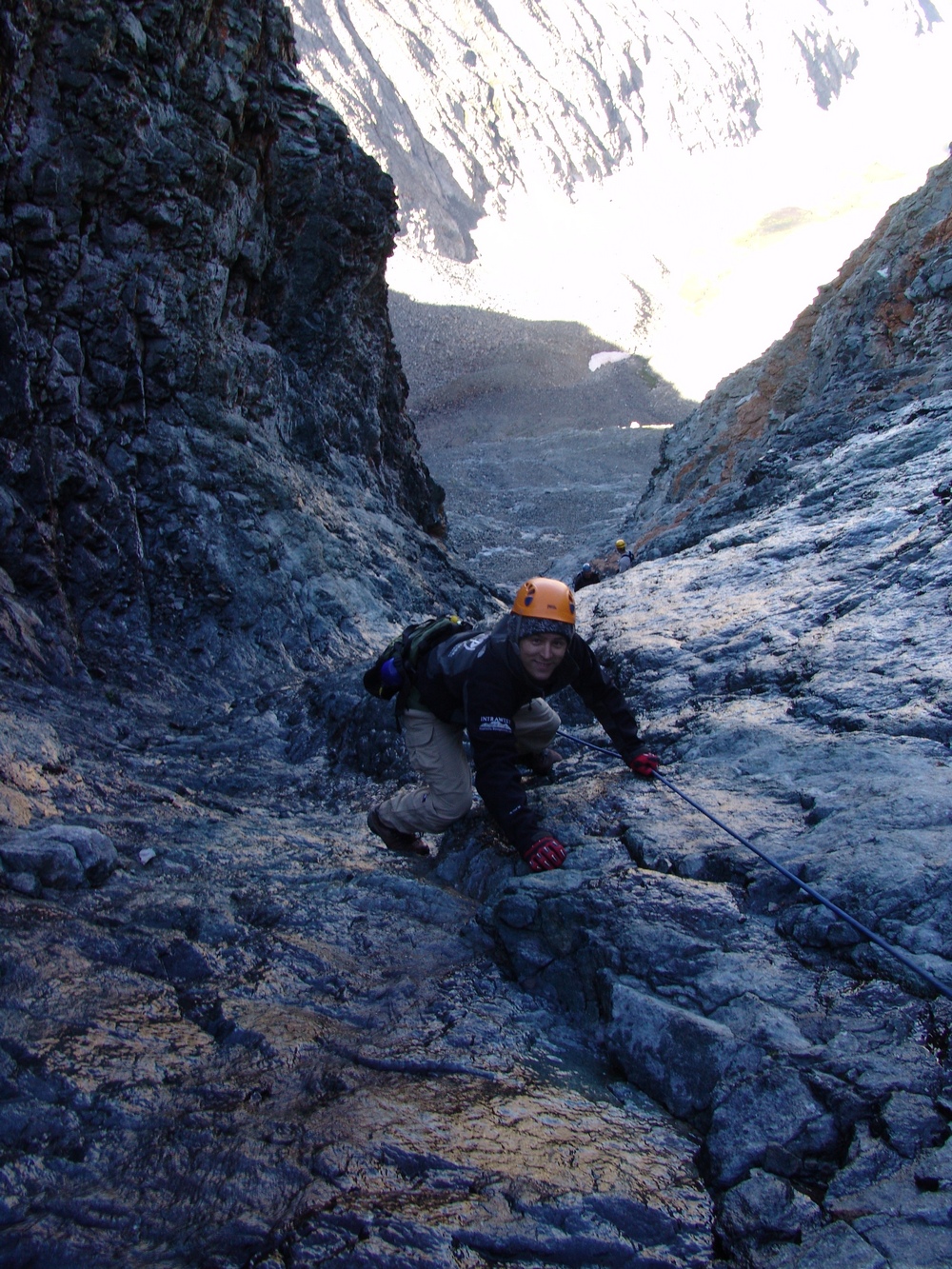
Dave starts down the Hourglass.
After successfully making it down through the Hourglass, the four of us headed back over below the ridge of Little Bear. We all decided to go up and over the ridge instead of below, which enabled us to get some great views of Lake Como and the surrounding area, including Ellingwood Point.
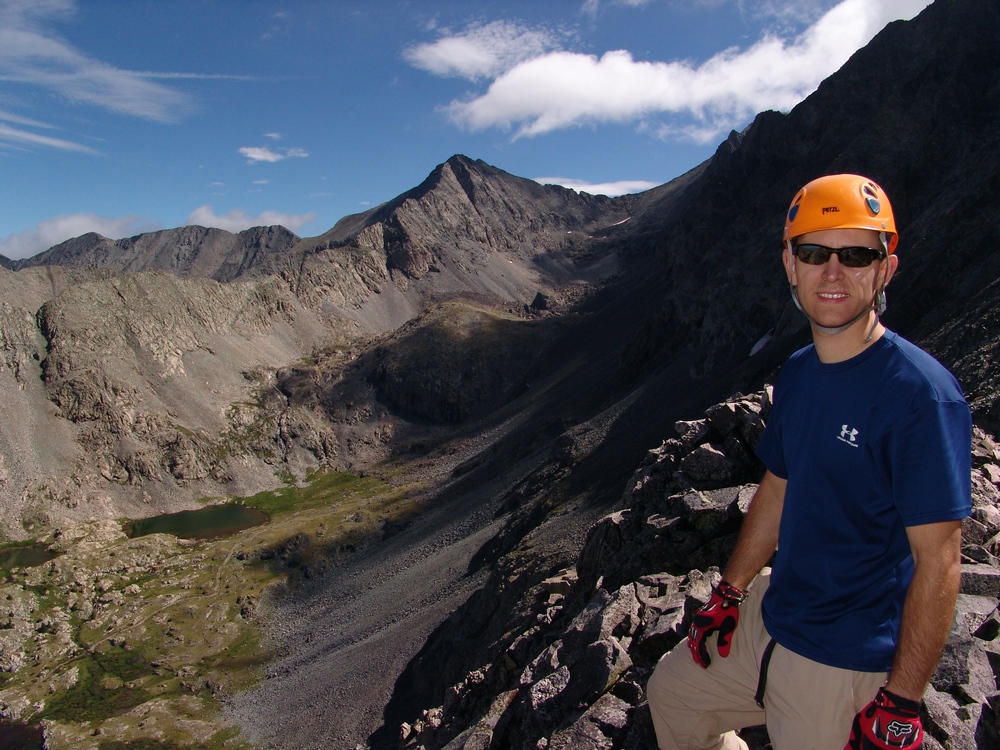
Ellingwood Point sits at the top of the Lake Como basin.
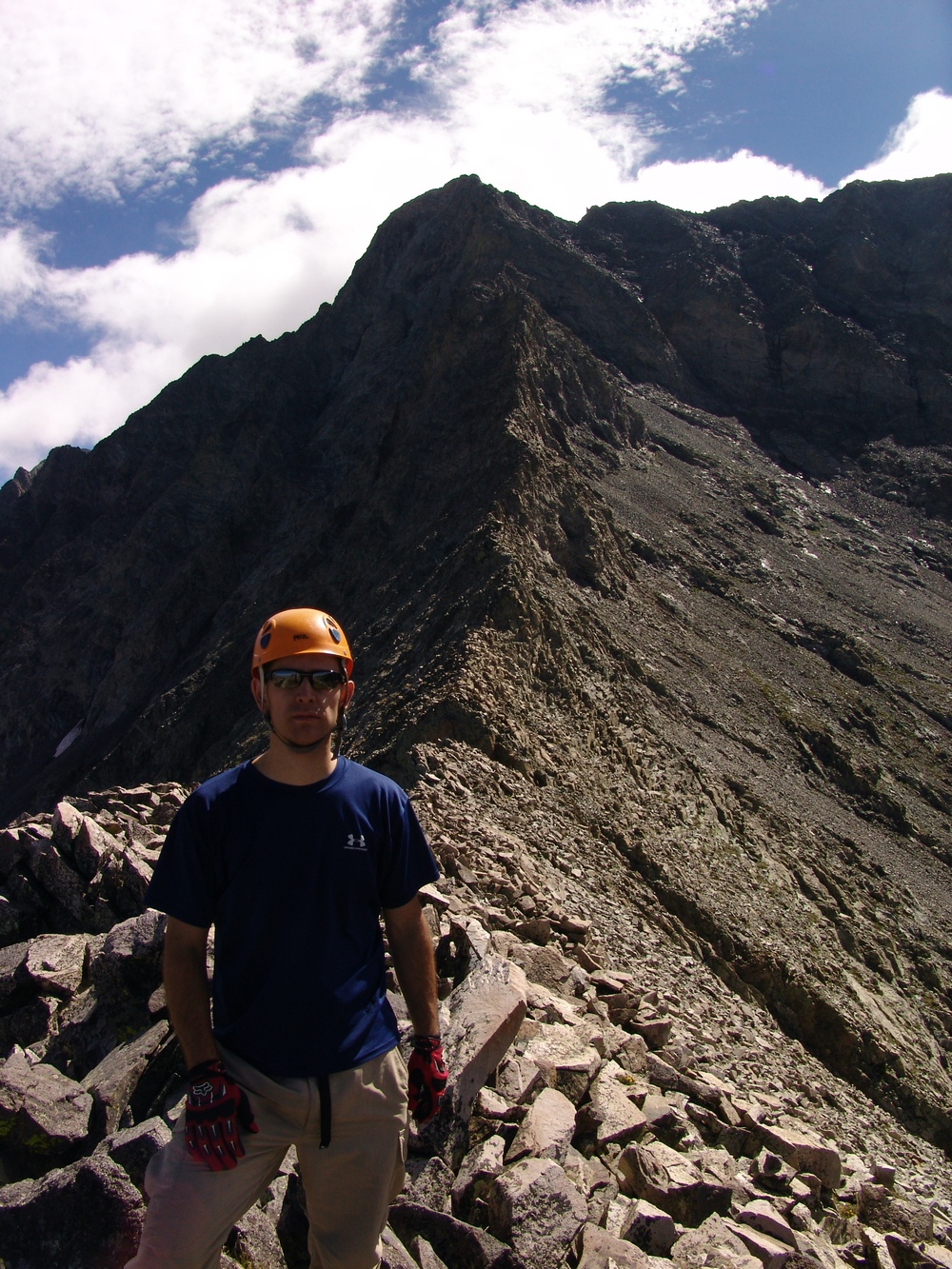
Dave with Little Bear in the background.
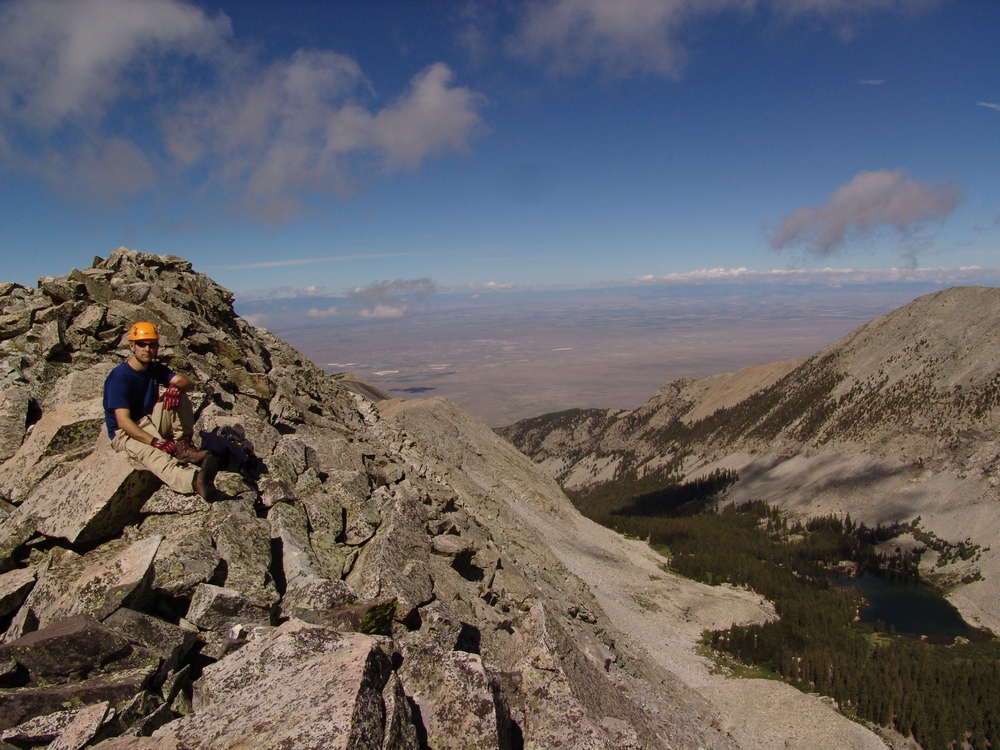
Dave and Lake Como.

Little Bear and the Lake Como basin.

Little Bear splits two valleys.
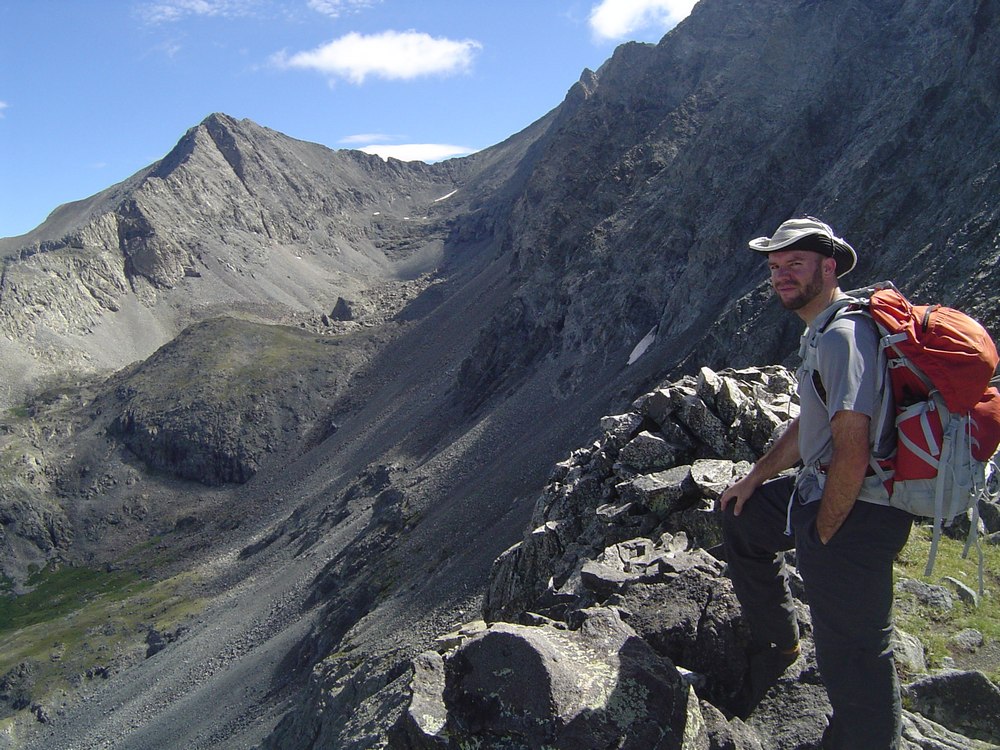
Matt on the Little Bear ridge.
We made it back safely to our campsite and quickly packed up and drove down. Dave's Jeep once again performed quite well over the obstacles going down.
Overall, I would rate Little Bear as one of the most difficult 14ers. The exposure and risk at the Hourglass, coupled with the rockfall potential, make Little Bear very dangerous and not for the beginner climber. I would highly recommend climbing helmets and would even advocate the use of rope and a harness with belay devices for the down-climb. If you're in need of a good climbing helmet, this one from Backcountry.com looks go be a nice buy.
Update on the injured climber we saw on Ellingwood Point: I posted what we had witnessed and discussed with the SAR team on a thread on 14ers.com, which erupted into a lively discussion about hiking with people that have pre-existing medical conditions. The consensus from that discussion was that it is very much the responsibility of someone with a pre-existing medical condition to disclose that condition to their fellow hikers before embarking on a hike, especially if that medical condition may place you or your partners in serious danger, such as what happened in this case. Unfortunately, Elisabeth did not respond well to that discussion on 14ers.com and basically called the whole forum a bunch of expletives. Later on, she sent me a private message requesting that I delete that thread because of the stress it had caused her and because she was unable to obtain employment because of the content of the thread. She claimed that she was being singled out becuase of her condition; however, my guess is that employers saw how immature her response to the whole situation was and did not want to hire someone with such a way of interacting with others. Anyways, I refused to delete the thread and she threatened to sue me for libel and slander because I had implied that her injury was a direct result of her pre-existing medical condition (which of course is not what I had typed at all). I had suggested that it was possible that her epilepsy could cause her to be weaker physically and that would cause you to have a higher probability of falling and hurting yourself. Anyways, I eventually had Bill at 14ers.com delete the thread but I still have the discussion saved as a .pdf if anyone is interested in reading it. Bottom line, I believe a lot can be learned from the mistakes of others, and we should embrace the opportunity to learn at all times.


